Museum Catalog
The Vermont Historical Society houses over 25,000 objects relating to our State's history. Over the next five years all of these items will be digitally documented and placed in this catalog for public use. Items are presented in topical exhibits as well as categorical groupings. Please check back regularly as items will be added monthly. This catalog also houses the Vermont Women's History Database and the Vermont Black History Database.
Search All Categories
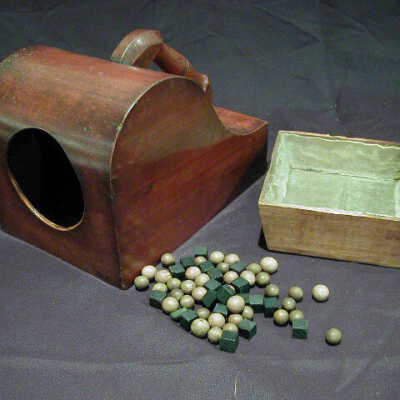
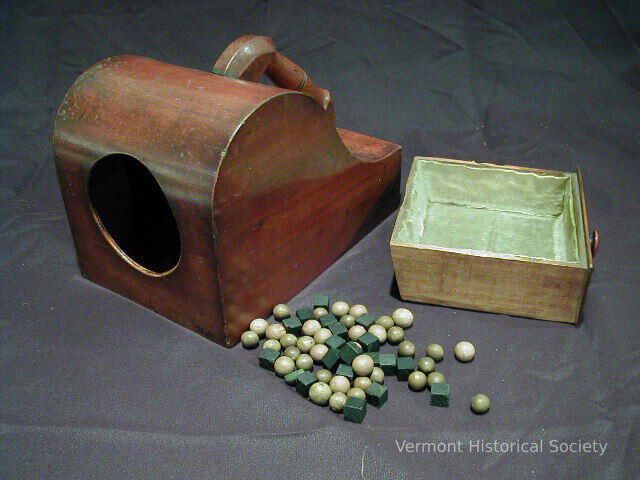
Ballot Box
Name/Title
Ballot Box
Lexicon
Description
Wooden ballot box and voting chits. The box has a curved top with a carved handle. The front of the box has a large, circular hole. There is a drawer that sits in the base of the box and can be pulled out from the back. It is accompanied by several small white wooden balls and black wooden cubes.
Acquisition
Accession
1973.51
Relationships
Related Person or Organization
Apollo Club
Person or Organization
Related Places
Place
Montpelier
City
Washington County
County
Vermont
State/Province
United States of America
Country
North America
Dimensions
Dimension Description
Overall
Materials
Material
Wood
Entry/Object ID
1973.51
Context
Used by the Apollo Club of Montpelier, Vermont.
Web Links and URLs


Baseball
Interpretative Labels
Label
Very little survives from Vermont's earliest baseball teams except for their colorful names, such as the Essex Junction Edmonds, the Cambridge Lone Stars, the Jericho Muffs, and the Ridley Sunflowers.
This baseball's just barely legible written label reads- "July 4, 1867/score 75-52/…. Champlains vs. …sp BBC." Vergennes fielded both the First Champlains and Second Champlains in the late 1860s. The other team name isn't clear enough to decipher. Does BBC indicate a Burlington Baseball Club? High scoring games like this one, often with over fifty runs, reflected earlier playing styles such as underhanded pitching and barehanded fielding. Connections by railroads and trolleys between towns and on Lake Champlain by ferries made it possible for the players and a growing number of spectators to enjoy what would become a favorite summer pastime, especially on the Fourth of July.
Name/Title
Baseball
Lexicon
Description
Leather baseball with a pasted-on paper label that reads, "July 14th 1867 score 75-52 / [illeg] Champlain vs [illeg] BBC". The outermost layer of the ball is formed from three wedge-shaped pieces of dark leather stitched together with a whipstitch. A split in one of the seams reveals undyed canvas and red and blue yarn on the interior.
Acquisition
Accession
1967.33
Made/Created
Date made
1867
Materials
Material
Leather
Entry/Object ID
1967.33
Context
Used during an unidentified baseball game in Vergennes, Vermont, in 1867.
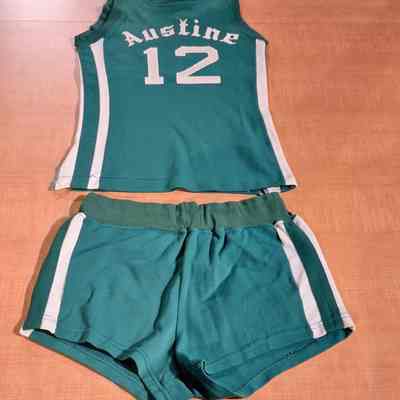
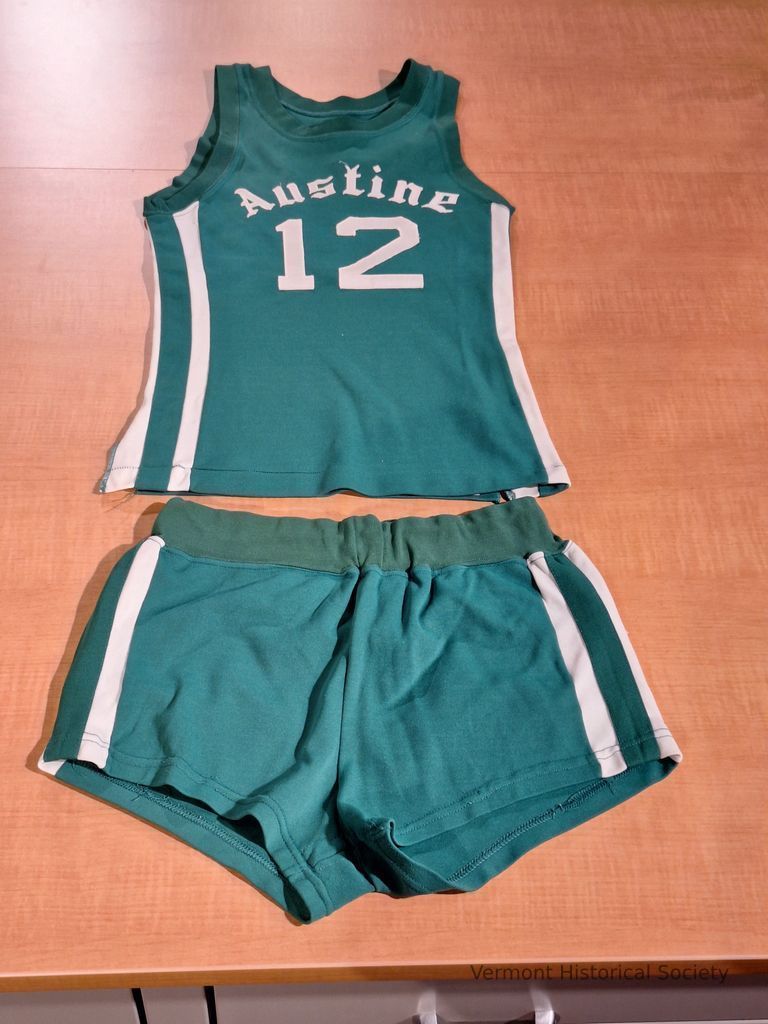
Basketball Uniform
Name/Title
Basketball Uniform
Clothing/Dress/Costume Details
Textile Details
Nylon
Fabric
Description
Green and white basketball uniform. The green tank top (a) has two white stripes down each side of the jersey and "Austine" in stylized lettering in an arc across the chest. The number "12" is stitched below the school name in white block numbers. A larger number 12 is stitched in white on the back.
The shorts (b) are the same shade of green as the top with a jersey waistband and matching pair of white vertical strips down the sides of the legs.
Daryl Wetzel wore the number 12 jersey throughout his basketball career at Austine, including when he earned his place in the 1,000 points club in January of 1978 during his junior year.
The shorts (b) are the same shade of green as the top with a jersey waistband and matching pair of white vertical strips down the sides of the legs.
Daryl Wetzel wore the number 12 jersey throughout his basketball career at Austine, including when he earned his place in the 1,000 points club in January of 1978 during his junior year.
Acquisition
Accession
2024.16
Dimensions
Entry/Object ID
2024.16.53a-b
Context
Austine School for the Deaf Brattleboro, VT
12 was the number of Daryl Wetzel who was a graduate of the Austine School for the Deaf in 1979 was inducted into the 1,000 points club in his junior year in Spring, 1978. (see photo in archives) He continued to play ay Gallaudet University and enjoyed a career with the AAAD (American Athletic Association for the Deaf) and with the USADB (United States American Deaf Basketball). In 2003 Wetzel was inducted as the first ever deaf male player in the New England Basketball Hall of Fame (R.I.).
12 was the number of Daryl Wetzel who was a graduate of the Austine School for the Deaf in 1979 was inducted into the 1,000 points club in his junior year in Spring, 1978. (see photo in archives) He continued to play ay Gallaudet University and enjoyed a career with the AAAD (American Athletic Association for the Deaf) and with the USADB (United States American Deaf Basketball). In 2003 Wetzel was inducted as the first ever deaf male player in the New England Basketball Hall of Fame (R.I.).
Web Links and URLs

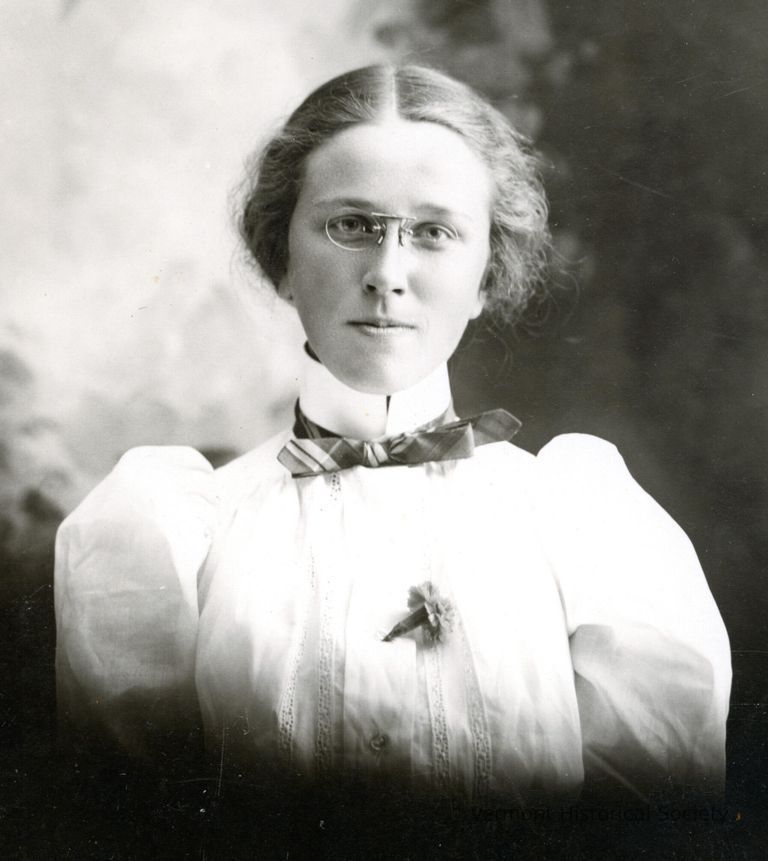
Batchelder, Ann Maria (1881-1955)
Name/Title
Batchelder, Ann Maria (1881-1955)
Description
Born: March 21, 1881 in Windsor, Vermont
Died: June 18, 1955 in Woodstock, Vermont
Primary Residences: Woodstock, Vermont and New York, New York
A writer, journalist, and advocate of woman suffrage, Batchelder served as corresponding secretary of the Vermont Equal Suffrage Association during Vermont’s campaign to ratify the 19th Amendment in 1919-20. She became most notable for her popular food articles in the "Ladies Home Journal" from 1934 to 1955.
Died: June 18, 1955 in Woodstock, Vermont
Primary Residences: Woodstock, Vermont and New York, New York
A writer, journalist, and advocate of woman suffrage, Batchelder served as corresponding secretary of the Vermont Equal Suffrage Association during Vermont’s campaign to ratify the 19th Amendment in 1919-20. She became most notable for her popular food articles in the "Ladies Home Journal" from 1934 to 1955.
Biographical Information
Education
Honorary Degree, Bowling Green University (1950)
Biography
The daughter of lawyer William Batchelder and Elizabeth Kennedy, Ann was tutored as a child before attending Bishop Hopkins Hall in Burlington at the age of 10. By 1900 her family had moved to Woodstock, where she explored career options as a teacher, a bank clerk, and a legal assistant. For several years she lived in Springfield working as a reporter for the Springfield Reporter and subsequently took various jobs in journalism, including police reporter for the Boston Herald and Boston Globe. During this period, she also expanded her legal training by “reading the law.”
Batchelder became involved in the suffrage movement in 1917 as publicity chair for the Woodstock Suffrage Study Club. Following the achievement of municipal suffrage for women in Vermont, Batchelder became the first woman in the state to be elected as town grand juror in 1918. She used her legal training to prosecute her first case the next year. During the final campaign to ratify the 19th amendment in Vermont, Batchelder worked closely with organizer Lillian Olzendam of Woodstock. They gathered petitions statewide, educated the public through the press, lobbied legislators, and sought to persuade anti-suffrage Governor Percival W. Clement to call the legislature into special session to approve the amendment, which he refused to do.
Batchelder’s fascination with food and cooking stemmed from her early childhood when she caught and cooked a trout on a fishing trip with her father. She began marketing jams through “Ann’s Jam Kitchen,” in a project launched with Lillian Olzendam in 1917. For several years during the 1920s she operated an inn in Hatfield, MA. before she was hired as a food editor at "The Delineator" magazine in 1928. When the publication ceased operation in 1934, the Curtis Publishing Co. hired Batchelder as associate editor of the "Ladies Home Journal."
Ann, also known as Anna, Batchelder became a household name in the 1930s and 1940s when her popular food articles, recipes, and “Line a Day” tips sparked her celebrity as an American journalist. Writing with considerable spunk and humor about food and daily life, she received an outpouring of mail from Americans eager to share their domestic frustrations while seeking her culinary advice. A spritely writer and lover of poetry, she published several popular books including: "East of Bridgewater and Other Poems" (1943), "Ann Batchelder’s Own Cookbook" (1941), and "Start to Finish" (1954). In 1950, Bowling Green State University awarded Batchelder an honorary degree in recognition of her journalistic career.
During this period, Batchelder wintered in New York City near her office at Rockefeller Center, where her staff multiplied quickly to handle her voluminous correspondence. She returned to her home in Woodstock Village in summer, often speaking locally about her career and her love of Vermont. In 1942 Batchelder broke her hip, which hardly interrupted her career but confined her to a wheelchair for the remainder of her life.
After World War II, Batchelder met and befriended Italian refugee Lisa Sergio, a former interpreter for Mussolini. One of the first women to become a European news commentator, Sergio had joined the National Broadcasting Co.; eventually, she taught international affairs at Columbia University. Her status as an enemy alien prompted Batchelder to adopt Sergio as her daughter. After Sergio was accused of being a “Red Sympathizer” and blacklisted during the McCarthy Era, Batchelder spent the next few years attempting to clear her name. The two women returned permanently to Woodstock in 1952, three years before her death at age 74.
Occupation
Suffragist, Author
Entry/Object ID
1.1.148
Web Links and URLs
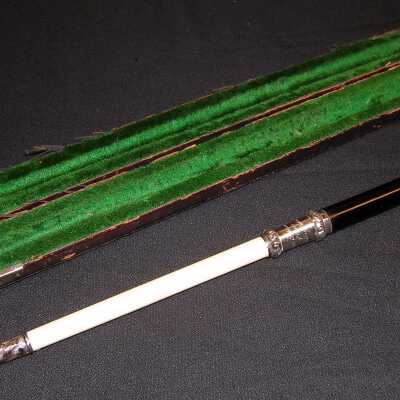
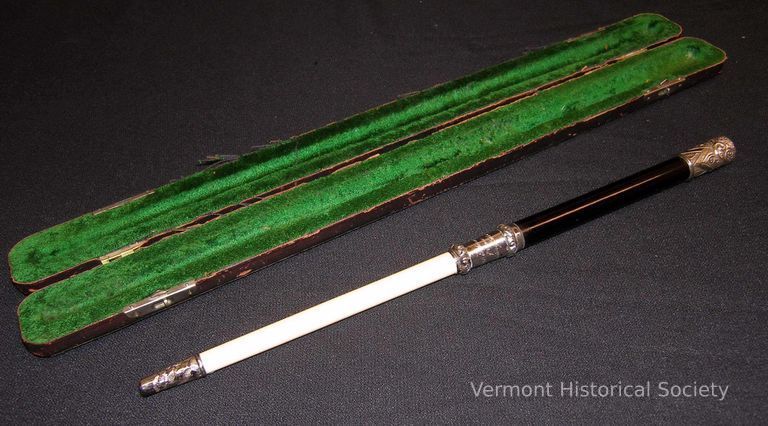
Baton
Name/Title
Baton
Lexicon
Description
Black-and-white baton and carrying case. The baton is made of ivory and ebony. Both ends and the connection point between the two materials are mounted with ornately engraved silver. The center mount is engraved, "Josephine Edna Hovey from Spaulding Glee Club". The case is covered in black leather and lined in green velvet.
Acquisition
Accession
2007.12
Relationships
Related Person or Organization
Perry, Josephine Hovey (1885-1952), Spaulding High School
Related Places
Place
Barre City
City
Washington County
County
Vermont
State/Province
United States of America
Country
North America
Made/Created
Date made
1910
Materials
Material
Ebony, Silver, Ivory, Artificial Leather, Fabric
Entry/Object ID
2007.12a-b
Context
Presented to Josephine Edna Hovey Perry by the Spaulding Glee Club of Spaulding High School in Barre, Vermont

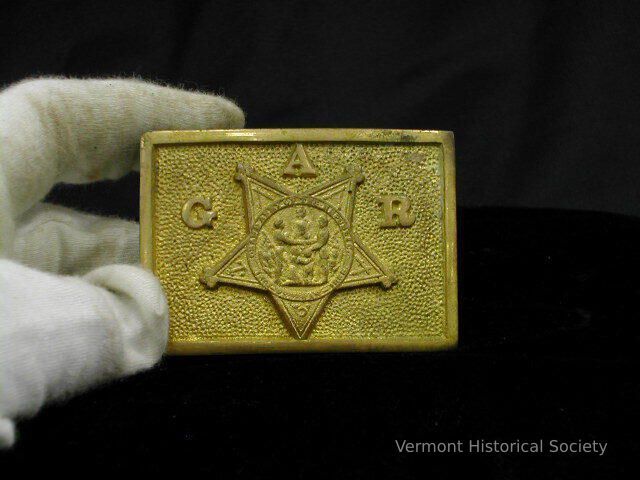
Belt Buckle
Name/Title
Belt Buckle
Lexicon
Description
Rectangular brass belt buckle molded with initials "GAR" and a 6-pointed star with human figures in the center.
Acquisition
Accession
1986.18
Relationships
Related Person or Organization
Branch, Charles Francis, Sr. (1845-1910), Grand Army of the Republic
Related Places
Place
Orwell
Town
Addison County
County
Vermont
State/Province
United States of America
Country
North America
Dimensions
Dimension Description
Overall
Materials
Material
Brass
Entry/Object ID
1986.18.41
Context
Owned by Charles F. Branch of Orwell, Vermont, as a member of the Grand Army of the Republic, a social club for Civil War veterans of the Union Army.
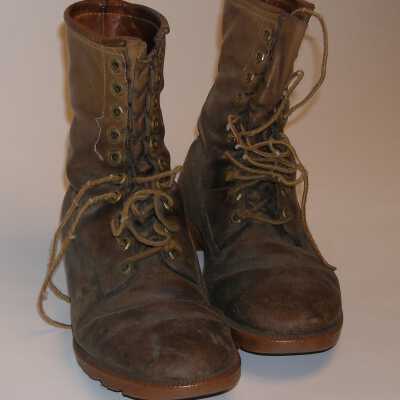
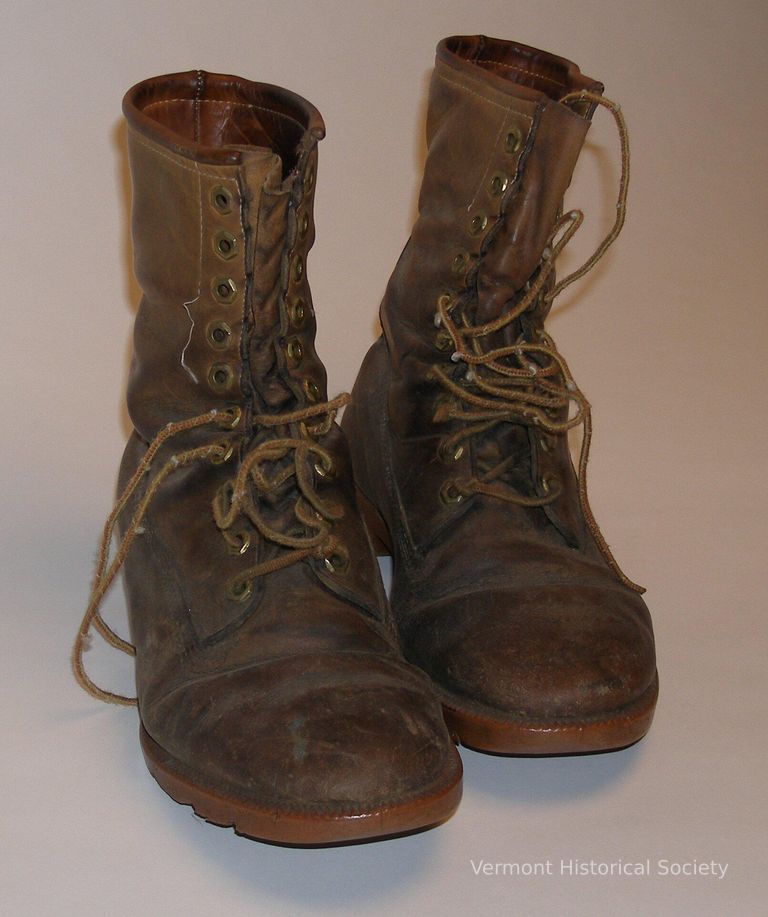
Boots
Name/Title
Boots
Lexicon
Description
Brown leather hiking boots with rubber soles. The boots reach above the wearer's ankle and lace up the center front over a fully attached tongue.
Acquisition
Accession
1977.28
Relationships
Related Person or Organization
Hagerman, Robert, Green Mountain Club
Related Places
Place
Morrisville
Village
Morristown
Town
Lamoille County
County
Vermont
State/Province
United States of America
Country
North America
Made/Created
Date made
1974
Manufacturer
Dunham's Duraflex
Dimensions
Dimension Description
Overall
Materials
Material
Leather
Entry/Object ID
1977.28a-b
Context
Owned by Robert Hagerman in Morrisville, Vermont
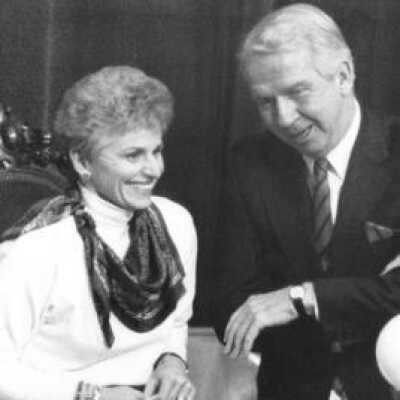
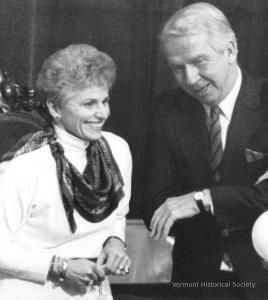
Boyd, Sara Gear (1941-2008)
Name/Title
Boyd, Sara Gear (1941-2008)
Also Known As
Description
Born: April 20, 1941 in Colchester, Vermont
Died: June 10, 2008 in Williston, Vermont
Primary Residence: Burlington
First woman in the United States to be elected Majority Leader in both chambers of a state legislature. Secretary of the Republican National Committee, Republican National Committeewoman for Vermont from 1992-2008 and Vice Chairman of the 1996 Republican National Convention. Founder of the Vermont Opportunity Scholarship Fund and two Vermont businesses: Impeccable Interiors and Gear Country Designs.
Died: June 10, 2008 in Williston, Vermont
Primary Residence: Burlington
First woman in the United States to be elected Majority Leader in both chambers of a state legislature. Secretary of the Republican National Committee, Republican National Committeewoman for Vermont from 1992-2008 and Vice Chairman of the 1996 Republican National Convention. Founder of the Vermont Opportunity Scholarship Fund and two Vermont businesses: Impeccable Interiors and Gear Country Designs.
Biographical Information
Education
University of Vermont (1963)
Biography
Sara Gear Boyd was a Republican leader in the Vermont State Legislature and secretary of the Republican National Committee. She was a graduate of the University of Vermont and taught junior high school and nursery school. Boyd was also the founder of two businesses: Impeccable Interiors in 1977 and Gear Country Designs in 1982. In 1984, Boyd entered Vermont state politics and was elected to the Vermont House of Representatives. She served as both the Minority and Majority Leader in the House before being elected to the Vermont State Senate in 1992, where she served as Assistant Majority Leader. In 1994, she became the Senate Majority Leader, making her the first woman in the United States to be elected Majority Leader in both chambers of a state legislature. She did not run for re-election in 1996. Boyd was a member of the Executive Committee of the Vermont State Republican Party and served on the Colchester Town, Chittenden County, and Vermont State Republican Committees. In 2000, Boyd was appointed to the Vermont Hearing Panel for Professional Responsibility of the Vermont Bar Association.
Boyd also played important roles in national politics. She was elected Republican National Committeewoman for Vermont in 1992 and served on the Executive, Budget, and Rules Committees. She was re-elected for this position in the years since then, but did not seek re-election in 2008. Boyd served as the Vice Chairman of the 1996 Republican National Convention, Co-chairman of the 1996 Republican Platform Committee and was a delegate to the 1992, 1996, 2000, and 2004 Conventions. In 2003, Boyd was appointed Commissioner of the White House Fellows by President George W. Bush and was elected Secretary of the Republican National Committee. She also served as the Secretary of the 2004 Republican National Convention.
In addition to serving Vermont and the United States politically, Boyd remained committed to education and community development. Boyd founded the Vermont Opportunity Scholarship Fund in 1998, which is "the first privately funded scholarship in the country offering public and private school choice to income eligible children." She was a trustee of Covenant Health Systems and the Fanny Allen Foundation. She was a former Director of the following organizations: Vermont Federal Bank, Fanny Allen Hospital, Fletcher Allen Health Care, Vermont Association of Hospitals and Health Systems, Vermont Adult Learning, Vermont Association of Business, Industry and Rehabilitation, Saint Michael's College President's Advisory Council, The Senate Presidents Forum, the National Council of Insurance Legislators, and the Council of State Government: Eastern Region. Boyd served six years as Burlington Police Commissioner and was a member of the Rotary Club and the University of Vermont Alumni Council.
Boyd's first husband, Allen F. Gear, died in 1991. She was re-married in 1999 to Joseph Boyd. Sara Gear Boyd died on June 10, 2008 after a struggle with cancer. She is survived by her husband and three daughters.
Occupation
Nursery School and Junior High School teacher
Business owner - Impeccable Interiors and Gear Country Designs
Vermont House of Representatives
Vermont State Senate
Entry/Object ID
1.1.18
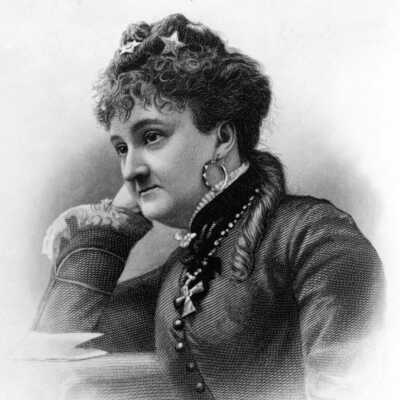
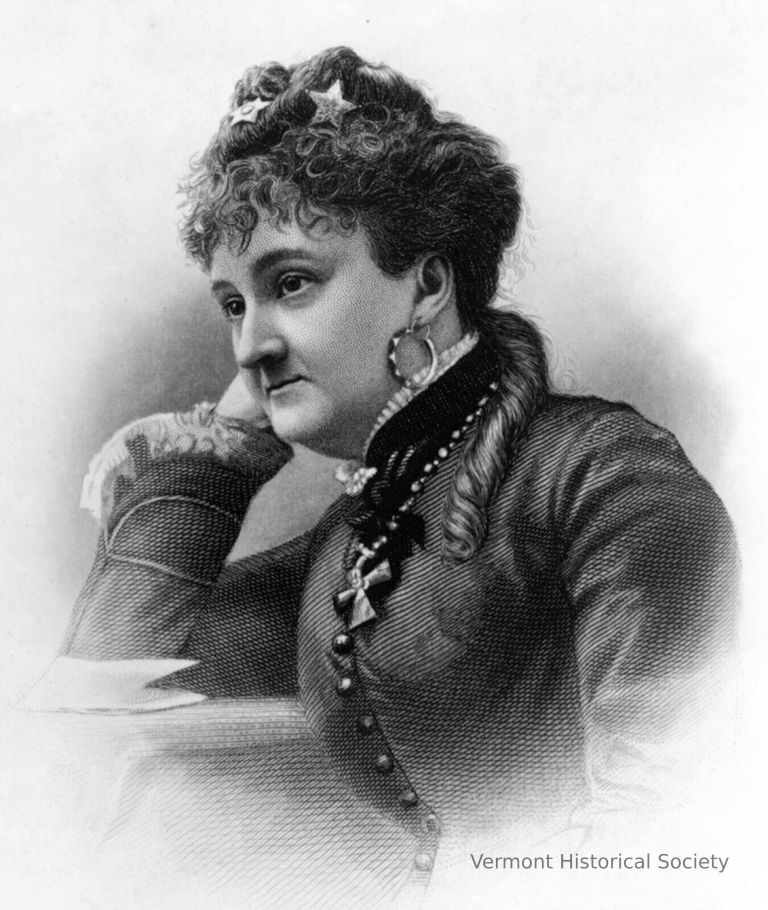
Bradwell, Myra Colby (1831-1894)
Name/Title
Bradwell, Myra Colby (1831-1894)
Description
Born: February 12, 1831 in Manchester, Vermont
Died: February 14, 1894 in Chicago, Illinois
First woman born in Vermont to become a lawyer admitted to a state bar. Had to take her battle to the United States Supreme Court, but the original ruling against her was upheld. Finally admitted to the Illinois State Bar in 1890. Founder of the Chicago Legal News, the first paper in Illinois devoted solely to legal news.
Died: February 14, 1894 in Chicago, Illinois
First woman born in Vermont to become a lawyer admitted to a state bar. Had to take her battle to the United States Supreme Court, but the original ruling against her was upheld. Finally admitted to the Illinois State Bar in 1890. Founder of the Chicago Legal News, the first paper in Illinois devoted solely to legal news.
Biographical Information
Education
Elgin Female Seminary
Biography
Myra Colby Bradwell was the first woman born in Vermont to become a lawyer after a long battle. Starting in 1869 she took her fight from the Superior Court of Chicago to the United States Supreme Court, where the original ruling against her was upheld in 1873. In 1890, the Supreme Court reversed itself and she was finally admitted to the Illinois State Bar. Bradwell was also the founder of the Chicago Legal News, the first paper in Illinois devoted solely to legal news.
Myra Colby was born in Manchester, Vermont to Eben and Abigail Colby. Shortly after her birth, the family moved to Portage, New York and then headed west to Chicago. She attended school in Kenosha, Wisconsin and the Elgin Female Seminary in Elgin, Illinois where she obtained a teaching job after graduation. In 1852, she married James Bolesworth Bradwell, and moved with him to Nashville, Tennessee, where the couple taught at their own school. James Bradwell was admitted to the Tennessee Bar and Myra started studying with him before they returned to Chicago, where James was admitted to the Illinois Bar, appointed a county probate judge and elected as a state legislator.
Bradwell launched her own career in 1868 with the weekly Chicago Legal News, the first paper in Illinois devoted solely to legal news. She served as editorial and business manager of the paper and it quickly "became the most important legal publication in the western United States." The Chicago Fire of October 1871 destroyed the Bradwell's home, their law library, and the Chicago Legal News. However, her daughter had saved the subcription book, and within a few weeks, Bradwell had the Chicago Legal News up and running again.
Bradwell had been studying the law for years with her husband, and in 1869 she passed the qualifying exam and applied to the Illinois Supreme Court for admission to the state bar, but was refused because she was a married woman. She appealed the case and took it to the United States Supreme Court, but in Bradwell v. Illinois (1873), the Court upheld the original ruling. In the meantime, the state of Illinois opened up all professions to women in 1872. Bradwell did not reapply for admission to the bar, but the Illinois Supreme Court took up her application again in 1890, admitted her to the bar and two years later she was given permission to practice before the U.S. Supreme Court.
An advocate of women's rights, Bradwell helped organize Chicago's first woman suffrage convention. At this convention she argued for suffrage, women's right to own property, sit on juries, and be admitted to law school. She was also active in the founding of the American Woman Suffrage Association and was a representative of Illinois at the Centennial Exposition in Philadelphia in 1876. Bradwell was a member of the Soldiers' Home Board, the Chicago Women's Club, the Illinois Women's Press Association, served as treasurer of the South Evanston Industrial School and was a delegate to the Prison Reform Congress in St. Louis. Bradwell died in 1894.
Occupation
Teacher
Lawyer
Entry/Object ID
1.1.106
Web Links and URLs
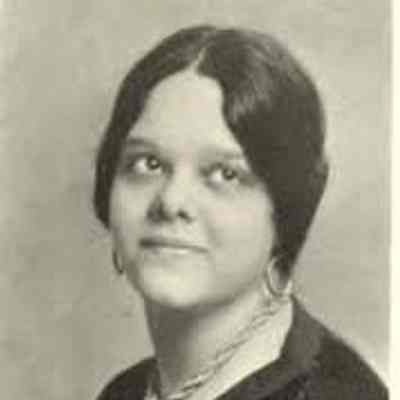
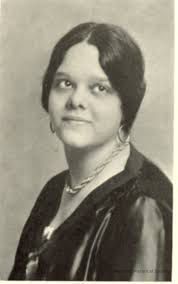
Brown, Edna Hall (1909-2000)
Name/Title
Brown, Edna Hall (1909-2000)
Also Known As
Edna Hall
Description
Born: 1909 in Baltimore, Maryland
Died: 2000 in Baltimore, Maryland
Primary Residence: Baltimore, Maryland
First Black woman to graduate from the University of Vermont in 1931. Scientist, mathematician, educator, and community leader in Baltimore.
Died: 2000 in Baltimore, Maryland
Primary Residence: Baltimore, Maryland
First Black woman to graduate from the University of Vermont in 1931. Scientist, mathematician, educator, and community leader in Baltimore.
Relationships
Related Person or Organization
University of Vermont
Person or Organization
Biographical Information
Education
Bachelor of the Arts, University of Vermont (1931)
Master's in Education, Columbia University
Biography
Edna Hall Brown was born in 1909 in Baltimore, Maryland, to her father, Daniel Brown, who was a widely known and respected dentist, and her mother, Kate Hall. She attended Frederick Douglass High School in Baltimore, which is the second oldest high school created for African Americans. Edna then spent a year at Saint Johnsbury Academy in Vermont, graduating in 1926.
After attending high school, Edna went on to attend college at UVM, becoming the first known African-American woman to do so. While in college, Edna excelled in the subjects of math and science, as noted in the UVM publication “The Ariel.” She graduated in 1931, earning her Bachelor’s of Science in Education. After graduating from UVM, she went on to attend a masters program in teaching at Columbia University.
After graduating from Columbia, Edna returned to Baltimore and taught math and science in the local public schools. Edna also became involved in many local organizations, serving as president of the DuBois circle, an African-American women’s club, and as the treasurer of the Cooperative Women’s Civic League. She was also involved in the Madison Avenue Presbyterian Church, the first church to be organized for slaves in the United States. She died in 2000, leaving behind a large portion of her estate to help fund minority students’ education. Half of this money was given to the United Negro College Fund, and half to the University of Vermont.
Occupation
Educator
Community Leader


Brown, Marilyn Cochran (b. 1950)
Name/Title
Brown, Marilyn Cochran (b. 1950)
Description
Born: February 5, 1950 in Richmond, Vermont
Primary Residence: Richmond
Professional skier on the United States Ski Team from 1965-1974 and the 1972 United States Olympic Ski Team. First American woman to win both the World Cup Giant Slalom title (1969) and to medal in the combined at the World Championships in Val Gardena, Italy (1970).
Primary Residence: Richmond
Professional skier on the United States Ski Team from 1965-1974 and the 1972 United States Olympic Ski Team. First American woman to win both the World Cup Giant Slalom title (1969) and to medal in the combined at the World Championships in Val Gardena, Italy (1970).
Biographical Information
Education
University of Vermont (1979)
Biography
Marilyn Cochran Brown is the eldest of three sisters who were spectacular alpine skiers in the 1960's and 1970's. She was on the U.S. Ski Team from 1967-1974, the International Ski Federation Team from 1970-1974, and the 1972 U.S. Olympic Team. She was the US Giant Slalom Champion in 1986 and 1974, World Cup Grand Slalom Champion in 1969, the International Ski Federation World Champion Combined Bronze Medalist in 1970, the French National Champion in 1971 (the first year they allowed international entries), and the US Slalom Champion in 1972. As the Combined Bronze Medalist in 1970, she was the first US woman to finish on the podium since the race began in 1954. In 1978 she was inducted into the U.S. National Ski and Snowboard Hall of Fame.
She graduated from the University of Vermont in 1979, and is now a member of the UVM Hall of Fame. She has coached skiing at the University of New Hampshire, the Queechee Ski Club, and Hanover, New Hampshire High School. She currently resides in Norwich, Vermont, with her husband, Chris Brown, with whom she has two sons, Roger and Douglas. Roger won the NCAA Slalom title competing for Dartmouth College in 2003 and was named to the United States Ski Team in 2005. Cochran serves as general manager of the Cochran Ski Area in Richmond, Vermont.
Occupation
Professional Skier
Ski Coach
Entry/Object ID
1.1.108
Web Links and URLs
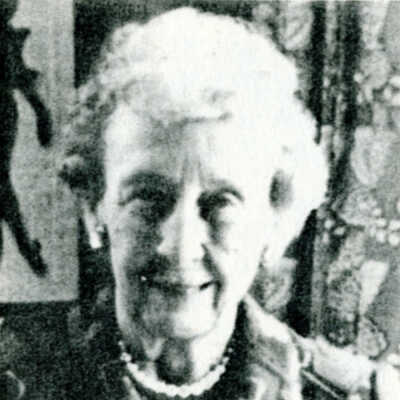
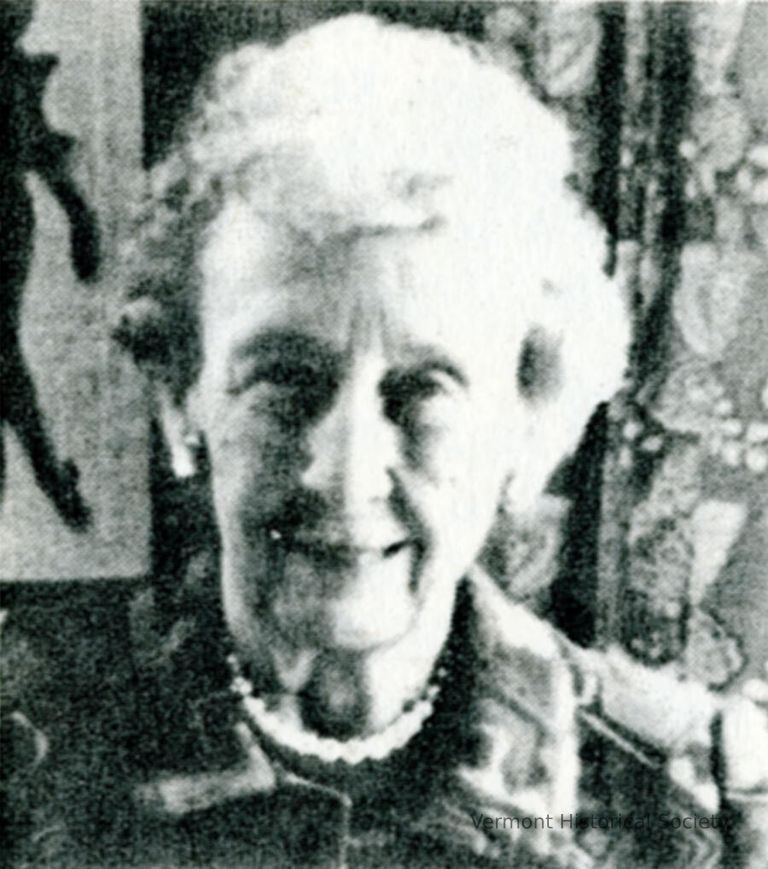
Bugbee, Lucy Mallory (1887-1984)
Name/Title
Bugbee, Lucy Mallory (1887-1984)
Description
Born: February 13, 1887 in Lennox, Massachusetts
Died: July 13, 1984 in Bradford, Vermont
Primary Residence: Bradford
Pioneer in Vermont wild flower conservation; saved both the Stoddard Swamp in Peacham (now called the Lucy Mallary Bugbee Wild Flower Sanctuary and Natural Area) and the Victory Bog Basin from destruction. Was a charter member of the Vermont Natural Resources Council. Also known for taking over 400 photos of Vermont flora and nature.
Died: July 13, 1984 in Bradford, Vermont
Primary Residence: Bradford
Pioneer in Vermont wild flower conservation; saved both the Stoddard Swamp in Peacham (now called the Lucy Mallary Bugbee Wild Flower Sanctuary and Natural Area) and the Victory Bog Basin from destruction. Was a charter member of the Vermont Natural Resources Council. Also known for taking over 400 photos of Vermont flora and nature.
Biographical Information
Education
Mount Holyoke College, 1908
Biography
Lucy Mallary Bugbee was a pioneer in Vermont conservation. She worked to preserve bogs, wildflowers, and ferns in Vermont. She grew up in Massachusetts, graduating in 1908 from Mount Holyoke College, where she went to school along with her three sisters. She was a teacher in Massachusetts, and published a book for junior high school students entitled, "Exploratory and General Language". She married Lloyd Bugbee and lived in Connecticut before retiring in Vermont.
Bugbee became interested in Vermont ecology and nature. She was the chair of conservation for the Federation of Women's Clubs for a decade. She kept a large garden and wildflower trail. Bugbee frequently gave lectures on Vermont wild flora. Throughout her life, she took over 400 nature photographs which are available at the State Library in Montpelier, the Fairbanks Museum, and at schools throughout the state.
Lucy Bugbee is best known for her conservation work. She saved the Stoddard Swamp in Peacham from destruction during the building of Interstate 91. When the New England Wild Flower Society gave the land to the state, the area was renamed, the "Lucy Mallary Bugbee Wild Flower Sanctuary and Natural Area". The New England Wild Flower Society honored Bugbee in 1968 with a conservation award.
Bugbee continued to do conservation work, also saving the Victory Bog Basin in Essex County, VT from being destroyed by new dams. This 1500 acre forest and wetlands area has been designated as an Important Bird Area by the Audubon Society, and is also home to rare native plant species.
Occupation
Conservationist
Photographer
Teacher
Writer
Entry/Object ID
1.1.14
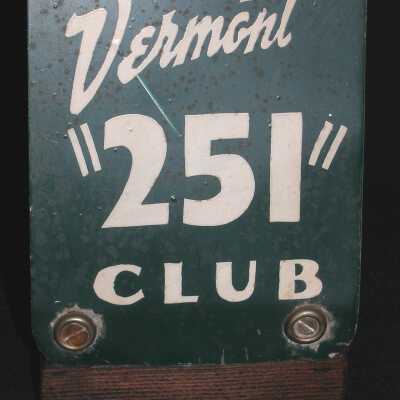
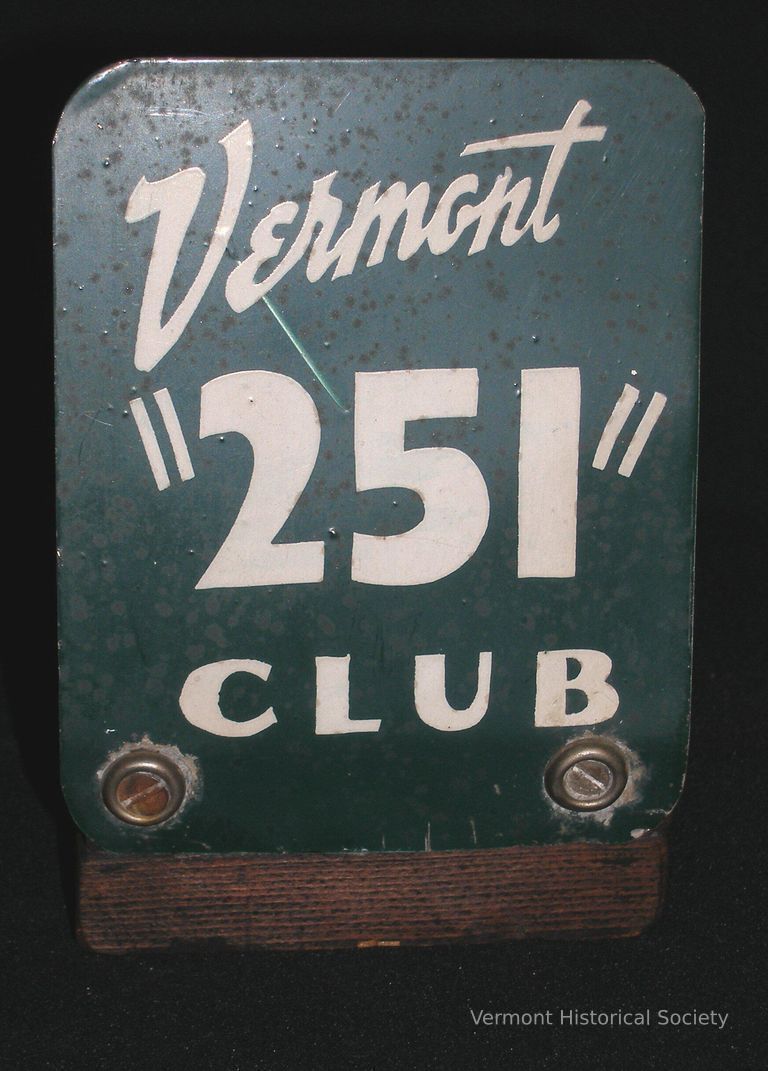
Bumper Plaque
Name/Title
Bumper Plaque
Lexicon
Description
251 Club car bumper plaque. The piece is is made up of a 5"h. x 4"w. piece of enameled metal that is screwed to a wooden base at the bottom two corners. The metal is green with white lettering: "Vermont / "251" / CLUB" The corners of the metal are rounded. The wooden base is made up of two stained (dark brown) pieces of wood (3 7/8" l. x 1 7/8"d. x 7/8"thick) nailed together. The lower edge of the metal is slightly bent and screwed to the edge of the top board with a flat head screw and a washer behind it. There residue paper on the bottom where it had been glued. The back right edge has a white brush mark from painting white.
Use
by donor's father
Acquisition
Accession
2011.41
Relationships
Related Person or Organization
Lindner, Erwin Schaffer (1915-1980)
Person or Organization
Made/Created
Date made
1960-1965
Dimensions
Materials
Material
Metal, Wood
Entry/Object ID
2011.41.5

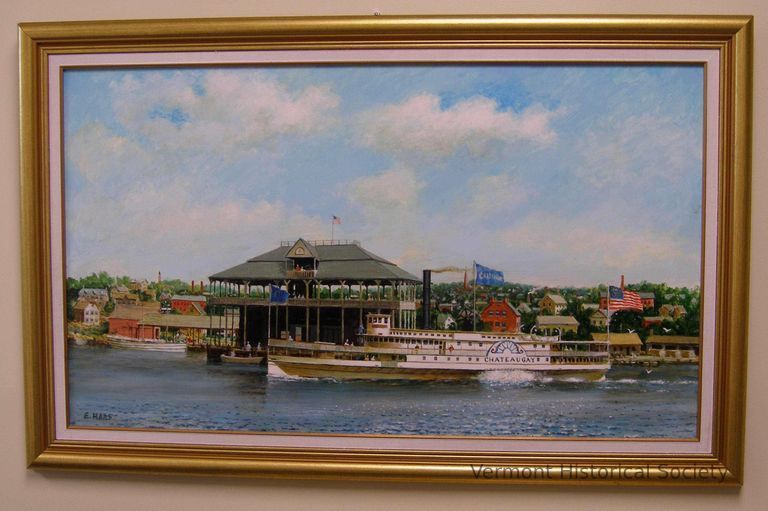
Burlington Harbor, ca. 1895
Name/Title
Burlington Harbor, ca. 1895
Lexicon
Description
This painting portrays a white steamboat positioned in the water, situated near the shore adjacent to a large two-story building that extends into the water. The scene is depicted from a viewpoint on the water, looking towards the shore. The land is represented as a flat strip positioned below the center line of the composition, adorned with numerous trees and buildings painted in shades of tan, red, and white. The steamboat itself features distinctive elements, including a black smokestack and a water wheel positioned on its side. It has two deck levels. The wheel cover of the water wheel bears the label "Chateaugay," while a blue flag with the same label is seen flying from the boat. At the stern, an American flag is displayed, while the bow exhibits the Vermont flag. The sky above is depicted as a blue expanse, embellished with scattered white clouds.
Acquisition
Accession
2006.45
Relationships
Related Publications
Celebrating Ernest Haas
Publication
Artwork Details
Medium
Acrylic
Subject
Steamboat Chateaugay
Made/Created
Artist Information
Haas, Ernest J. (b. 1927)
Artist
Date made
2006
Dimensions
Dimension Description
Overall
Entry/Object ID
2006.45.1
Context
Born in Albany, New York in 1927, Ernie Haas showed an early aptitude for drawing. After serving in the Navy at the end of WWII he enrolled at Paul Smith College for a year before transferring to the School of Practical Art in Boston. He was called back into service during the Korean War and was assigned to the Naval Photo Center where he produced art for training materials.
He worked for a time as an artist agent in New York before going back to school at Southern Connecticut College for a degree in history. He taught in Connecticut schools until retirement in 1984. At that time he and his wife relocated to South Burlington, Vermont.
Haas became involved as a volunteer with the Lake Champlain Maritime Museum and was encouraged to rediscover his love of painting by then director Art Cohn. Haas created original artwork for museum exhibitions and publications as well as stand-alone works of early sidewheelers and historical events.
The steamboat Chateaugay was built in 1887 at Shelburne Harbor and launched by the Champlain Transportation Company as a state-of-the-art excursion vessel. It operated for 37 years as an excursion boat before being stripped down and converted into a car ferry in 1925. The boat is depicted in its heyday departing the Lake Champlain Yacht Club in Burlington Harbor.
He worked for a time as an artist agent in New York before going back to school at Southern Connecticut College for a degree in history. He taught in Connecticut schools until retirement in 1984. At that time he and his wife relocated to South Burlington, Vermont.
Haas became involved as a volunteer with the Lake Champlain Maritime Museum and was encouraged to rediscover his love of painting by then director Art Cohn. Haas created original artwork for museum exhibitions and publications as well as stand-alone works of early sidewheelers and historical events.
The steamboat Chateaugay was built in 1887 at Shelburne Harbor and launched by the Champlain Transportation Company as a state-of-the-art excursion vessel. It operated for 37 years as an excursion boat before being stripped down and converted into a car ferry in 1925. The boat is depicted in its heyday departing the Lake Champlain Yacht Club in Burlington Harbor.


Burrell, Joseph Henry "Big Joe" (1924-2005)
Name/Title
Burrell, Joseph Henry "Big Joe" (1924-2005)
Description
Born: February 9, 1924 in Port Huron, Michigan
Died: February 2, 2005 in Burlington, Vermont
Primary Residence: Burlington
"Big Joe" Burrell was an iconic fixture in the Burlington music scene from the late 1970s to his death in 2005. He inspired an entire generation of Vermont musicians, received two keys to the city of Burlington, and is memorialized by a life-sized statue on the Church Street Marketplace.
Died: February 2, 2005 in Burlington, Vermont
Primary Residence: Burlington
"Big Joe" Burrell was an iconic fixture in the Burlington music scene from the late 1970s to his death in 2005. He inspired an entire generation of Vermont musicians, received two keys to the city of Burlington, and is memorialized by a life-sized statue on the Church Street Marketplace.
Biographical Information
Biography
One of seven children, "Big Joe" Burrell spent his early years in his hometown of Port Huron, Michigan, surrounded by his musical family. At age 10, his mother borrowed $5 to buy him a saxophone which he taught himself to play. When he reached his teens he dropped out of high school to focus exclusively on music.
In 1943 he joined the army and played in the military show band. He saw service in Africa, Italy, and the Philippines. Later in life he remarked on the overt racism he experience while serving in the U.S. Army. After a two year struggle with tuberculosis that ended his military career, he moved to Toledo, Ohio, and formed the Red Tops Organ Trio.
At a gig in Akron, he met B.B. King and was invited to join the legendary guitarist's band. Burrell spent two years with King before joining Count Basie's Orchestra and then as a musician with the Miller Sisters. From the late 1960s to 1970s Burrell lived in Toronto where he played in Big John Little's jazz band. On his way to New York in 1976 he stopped in Burlington where his nephew taught at UVM and fell in love with the city and its music scene. He decided to stay.
For the next three decades Big Joe became a fixture in the Burlington music scene. He formed the Unknown Blues Band and performed in clubs and festivals throughout New England. Their regular gig at Hunt's Club drew standing-room-only audiences and resulted in the album "Live at Hunt's." After Hunt's closed, Big Joe played a gig every Thursday night at Halvorson's Upstreet Cafe until his death in 2005.
Big Joe received two keys to the City of Burlington and is honored by the Discover Jazz Festival with the annual Big Joe Burrell Day. In 2010, a life-sized statue of Big Joe by Burlington sculptor Chris Sharp was unveiled on the Church Marketplace.
Occupation
Musician
Entry/Object ID
1.2.17
Web Links and URLs
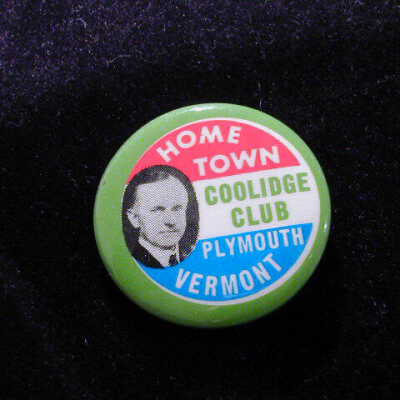
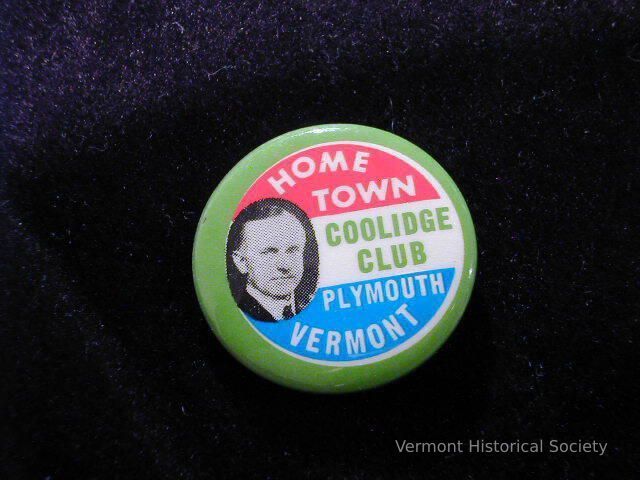
Campaign Button
Name/Title
Campaign Button
Lexicon
Description
Round metal button with a green border around a red-white-and-blue striped center printed with the words, "HOME TOWN COOLIDGE CLUB PLYMOUTH VERMONT" and a photograph of Calvin Coolidge.
Acquisition
Accession
1981.42
Relationships
Related Person or Organization
Home Town Coolidge Club, Coolidge, Calvin (1872-1933)
Related Places
Place
Plymouth
Town
Windsor County
County
Vermont
State/Province
United States of America
Country
North America
Made/Created
Manufacturer
The Whitehead & Hoag Co.
Dimensions
Entry/Object ID
1981.42
Context
Coolidge, a Republican, became President of the United States in 1923 at the death of Warren Harding and was elected to a four-year-term the following year.

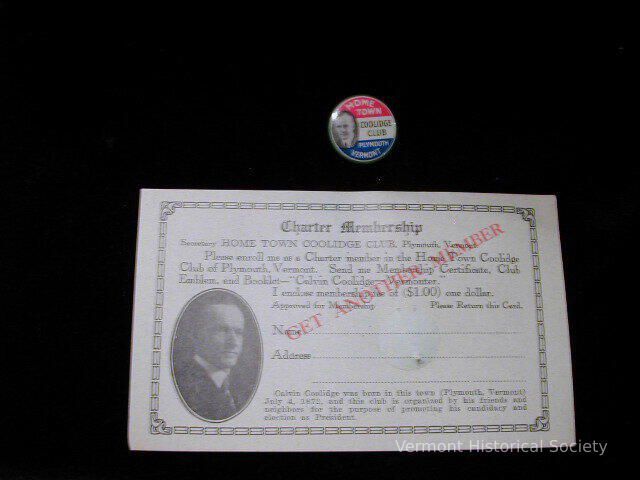
Campaign Button
Name/Title
Campaign Button
Lexicon
Description
Button and Membership card. Pin has an image of Calvin Coolidge on the left, the words "Home Town" at the top in white in a red background, the words, "Coolidge Club" in green in a white background in the center right, and the words, "Plymouth, Vermont" in white on a blue background at the bottom. The pin has a green rim. The pin is accompanied by a card that said it was for a charter member of the Home Town Coolidge Club.
Acquisition
Accession
1989.32
Relationships
Related Person or Organization
Coolidge, Calvin (1872-1933), Home Town Coolidge Club
Related Places
Place
Plymouth
Town
Windsor County
County
Vermont
State/Province
United States of America
Country
North America
Materials
Material
Metal, Paper
Entry/Object ID
1989.32.1a-b
Context
Coolidge, a Republican, became President of the United States in 1923 at the death of Warren Harding and was elected to a four-year-term the following year.
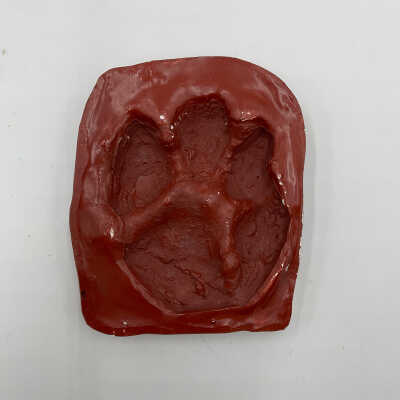
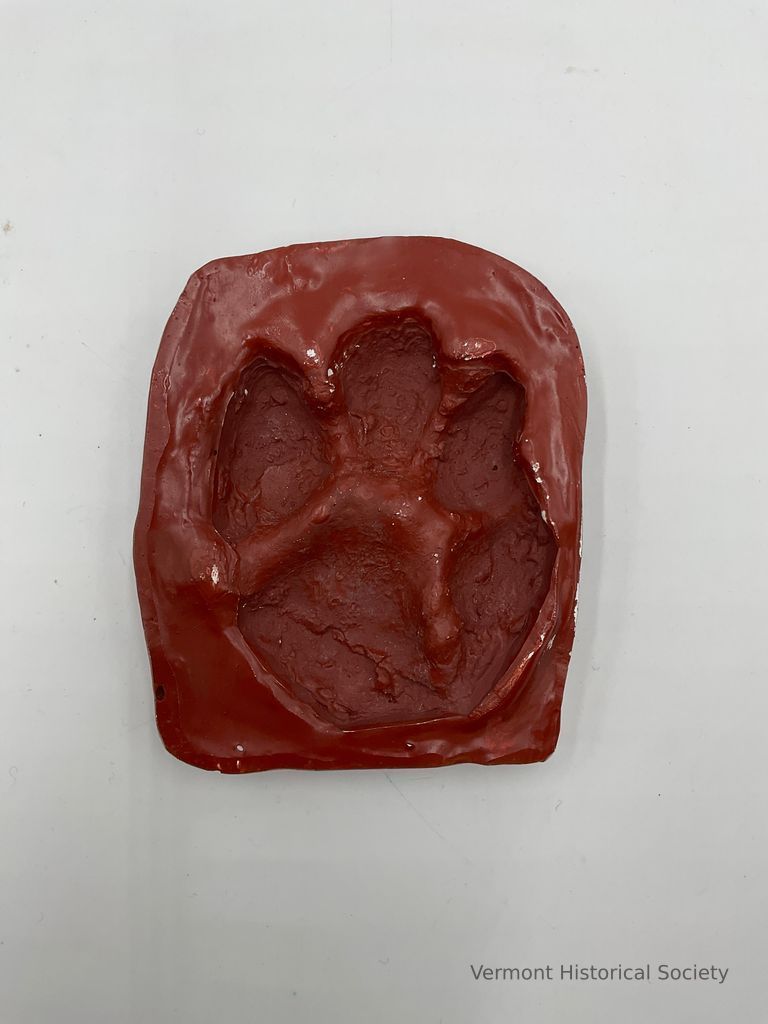
Casting
Name/Title
Casting
Lexicon
Description
Plaster cast of a panther print, painted dark red. On the back of the casting is a piece of masking tape with the inscription, "1934 Chester, Vt. - original is in the Bennington, Vt. museum."
Acquisition
Accession
1995.44
Relationships
Related Person or Organization
Ballou, William J.
Person or Organization
Related Places
Place
Grafton
Town
Windham County
County
Vermont
State/Province
United States of America
Country
North America
Made/Created
Manufacturer
Bennington Museum
Dimensions
Dimension Description
Overall
Materials
Material
Plaster, Paint
Entry/Object ID
1995.44.2
Context
Duplicate of plaster cast made from footprints at Grafton Gulf, December 1934, by Rev. William J. Ballou. The original is held in the Bennington Museum.
Web Links and URLs

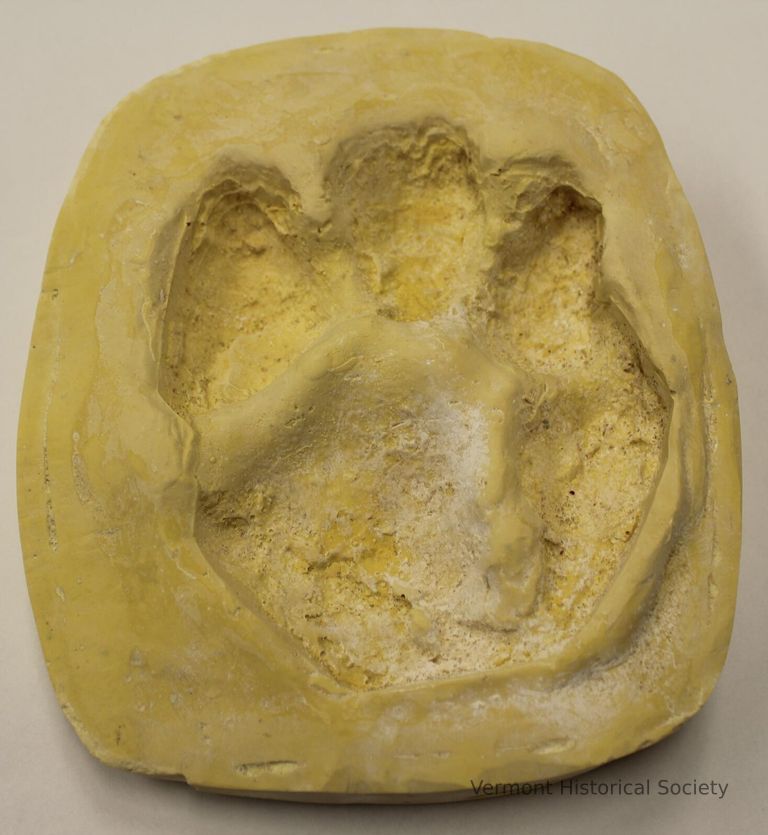
Casting
Name/Title
Casting
Lexicon
Description
White plaster casting of panther print, from the original in the Bennington Museum.
Acquisition
Accession
1995.44
Relationships
Related Person or Organization
Ballou, William J.
Person or Organization
Related Places
Place
Grafton
Town
Windham County
County
Vermont
State/Province
United States of America
Country
North America
Made/Created
Time Period
20th Century
Manufacturer
Bennington Museum
Dimensions
Dimension Description
Overall
Materials
Material
Plaster
Entry/Object ID
1995.44.3
Context
Duplicate of plaster cast made from footprints at Grafton Gulf, December 1934, by Rev. William J. Ballou. The original is held in the Bennington Museum.
Web Links and URLs
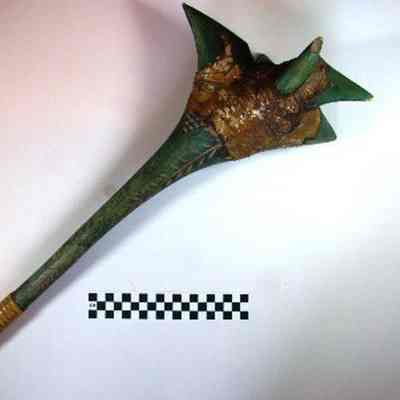

Club
Name/Title
Club
Lexicon
Description
Club made from a tree root. Painted green with a rattan handle. Floral and geometric designs etched into paint on handle.
Acquisition
Source (if not Accessioned)
Abenaki Cultural Conservancy
Relationships
Related Person or Organization
Gravel, Benjamin Frederick (1895-1988)
Person or Organization
Made/Created
Date made
circa 1910
Materials
Material
Wood
Entry/Object ID
L2024.3.71
Context
This aggressive looking green painted root club once belonged to Swanton Historian Ben Gravel and reappeared many years after his death at the 2010 Abenaki “Heritage Days” Powwow in Swanton, where Frederick Wiseman was able to purchase it.
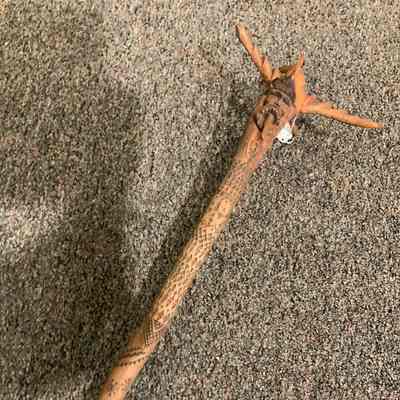
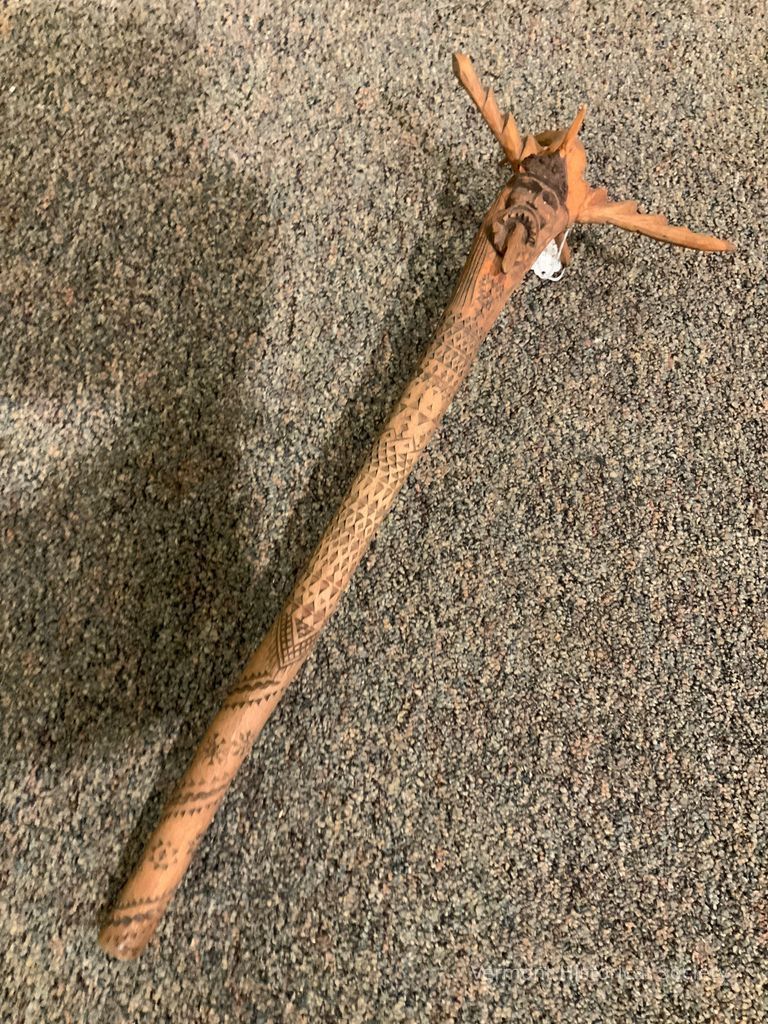
Club
Name/Title
Club
Lexicon
Description
Carved root club in form of man with antlers and extended tongue.
Acquisition
Source (if not Accessioned)
Abenaki Cultural Conservancy
Ethnography
Made/Created
Artist Information
York, Aaron (b. 1973)
Artist
Entry/Object ID
L2024.3.168
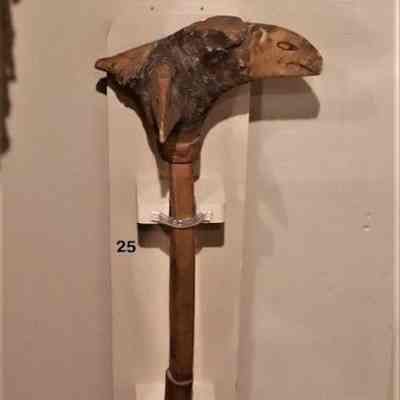

Club
Name/Title
Club
Lexicon
Description
Club made from a tree root carved as a bird beak.
Acquisition
Source (if not Accessioned)
Abenaki Cultural Conservancy
Made/Created
Date made
circa 1900
Materials
Material
Wood
Entry/Object ID
L2024.3.70
Context
Oral history evidence exists of a root club of this “bird-beak” style being used by a Nulhegan Abenaki family as a healing wand to keep away disease in the sickroom. We were lucky to find this larger, stylistically identical example in nearby Northern New Hampshire (provenance says Essex?).

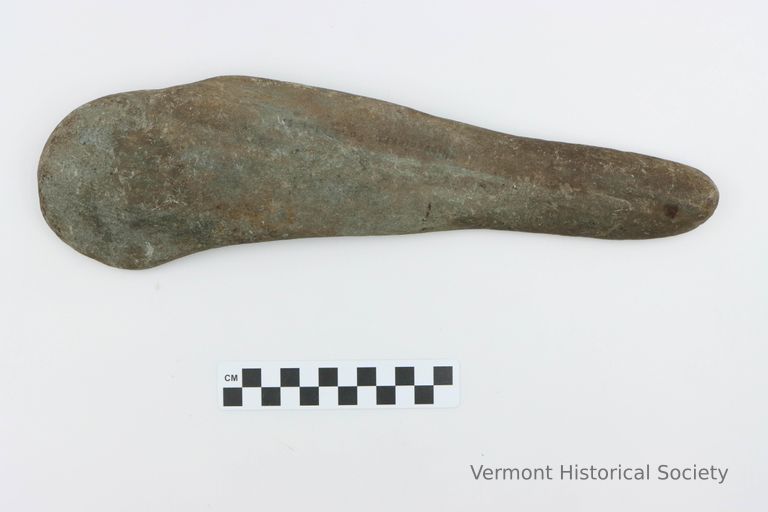
Club
Name/Title
Club
Lexicon
Description
Ground stone club. The butt end is flat and rounded while the other end is flat and broad.
Acquisition
Accession
1954.283
Ethnography
Relationships
Related Person or Organization
Sampson, Emma P. Merrill (1865-1953)
Person or Organization
Related Places
Place
Minnesota
State/Province
United States of America
Country
North America
Materials
Material
Stone
Entry/Object ID
1954.283.58
Context
Collected by Emma P. Sampson from Pezihutazizi (the Upper Sioux Indian Reservation) in Minnesota
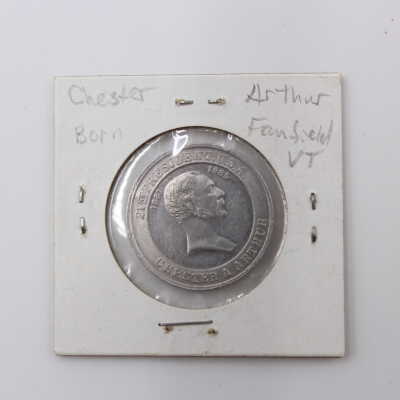
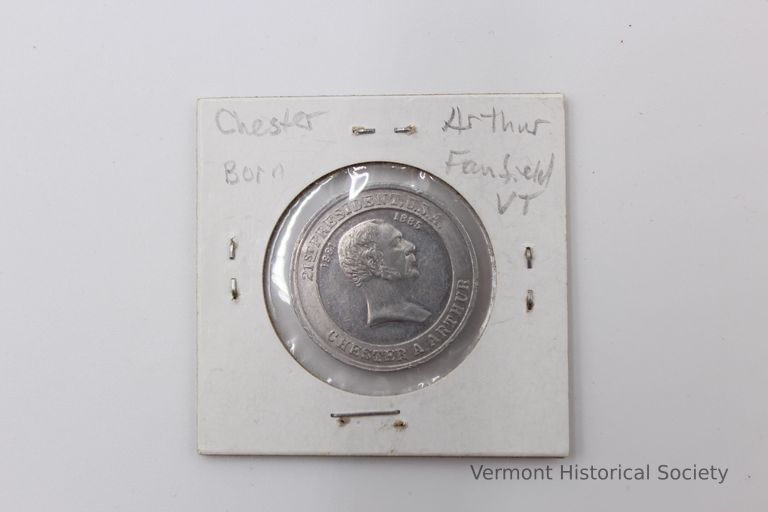
Commemorative Medal
Name/Title
Commemorative Medal
Lexicon
Description
Silver-toned medal commemorating the two terms of Chester A. Arthur as President of the United States. The face shows a profile image of Arthur with the words, "21ST PRESIDENT, U.S.A./1881 1885/CHESTER A. ARTHUR." The reverse shows the words '"OUR CHET"/"FIRST GENTLEMAN OF THE LAND"' around the outer edge and "JOIN/CRACKER JACK/MYSTERY CLUB/SAVE THIS COIN/THE CRACKER JACK CO./CHICAGO./U.S.A." in the center.
Acquisition
Accession
2020.18
Relationships
Related Person or Organization
Arthur, Chester Alan (1830-1886)
Person or Organization
Made/Created
Date made
circa 1933
Manufacturer
Cracker Jack Co.
Materials
Material
Metal
Entry/Object ID
2020.18.2
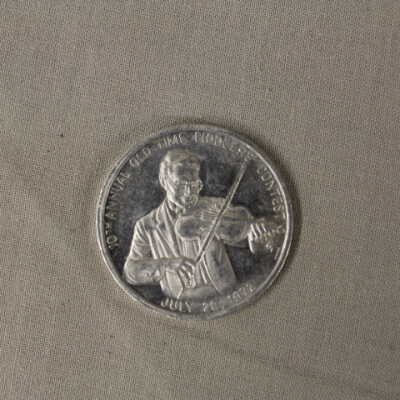
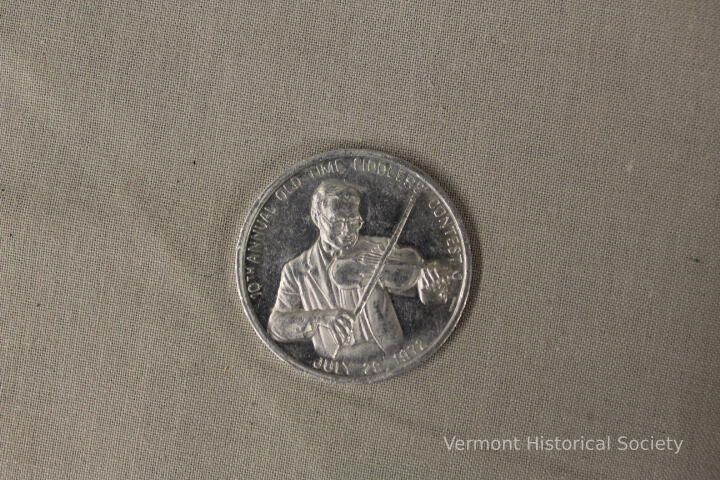
Commemorative Medal
Name/Title
Commemorative Medal
Lexicon
Description
Round silver medal. The face shows a man playing the fiddle with the words, "10TH ANNUAL OLD TIME FIDDLER'S CONTEST / JULY 28, 1972", around the edge. The reverse shows a church with a high steeple set among trees with the words, "CRAFTSBURY COMMON, VERMONT / HORSE AND BUGGY CLUB", around the edge.
Acquisition
Accession
1998.39
Relationships
Related Person or Organization
Gray, Forrest (1884-1987)
Person or Organization
Related Places
,
Made/Created
Date made
1972
Dimensions
Dimension Description
Overall
Materials
Material
Aluminum
Entry/Object ID
1998.39.32
Context
Owned by Forrest "Strad" Gray of East Calais, Vermont.
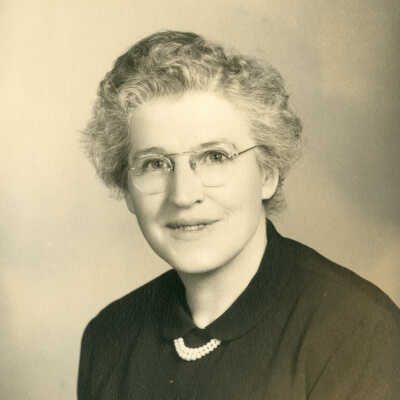
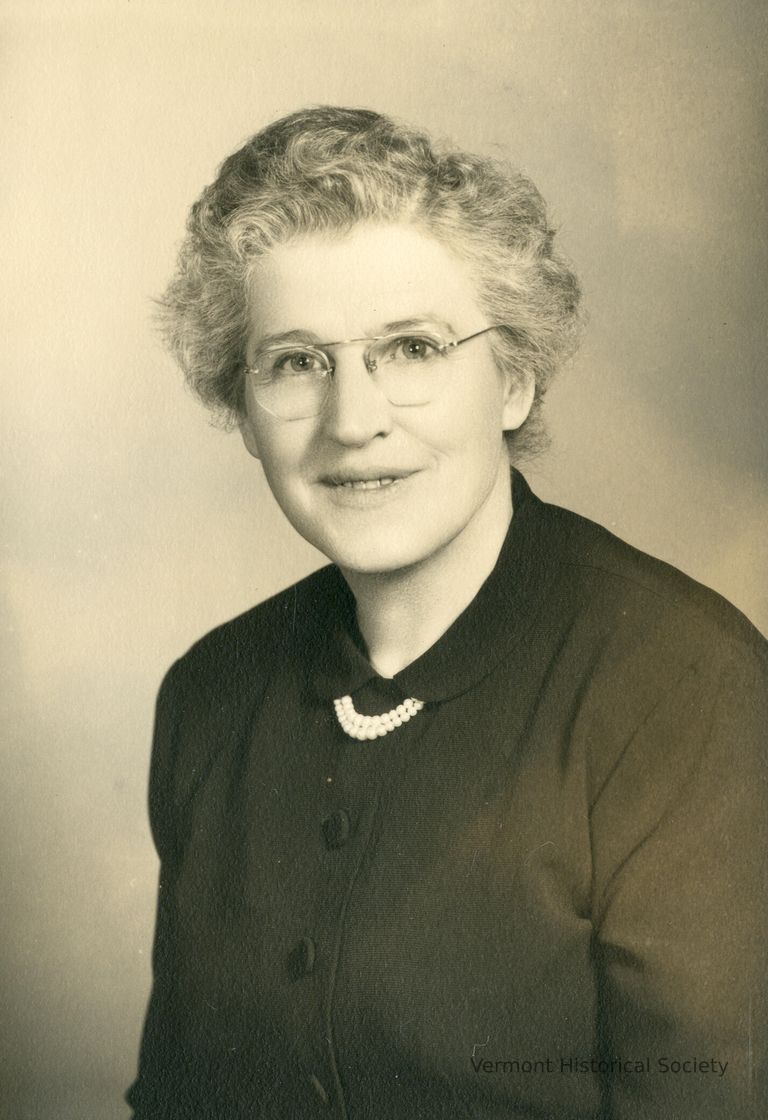
Coutts, Flora Jane (1897-1983)
Name/Title
Coutts, Flora Jane (1897-1983)
Description
Born: September 25, 1897 in West Charleston, Vermont
Died: March 13, 1983 in Newport, Vermont
Primary Residence: West Charleston
Taught in Vermont and Korea. Served as a Vermont State Representative and Vermont State Senator. Volunteered with the American Red Cross in India and China during WWII. Worked with the Vermont Extension Service and was the first Executive Secretary of the Northeastern Vermont Development Association. Extensive collection of diaries, letters, postcards and photographs is located at the Vermont Historical Society.
Died: March 13, 1983 in Newport, Vermont
Primary Residence: West Charleston
Taught in Vermont and Korea. Served as a Vermont State Representative and Vermont State Senator. Volunteered with the American Red Cross in India and China during WWII. Worked with the Vermont Extension Service and was the first Executive Secretary of the Northeastern Vermont Development Association. Extensive collection of diaries, letters, postcards and photographs is located at the Vermont Historical Society.
Biographical Information
Education
Johnson Normal School (1917)
Biography
Flora Coutts was the oldest daughter, (and one of eight children) of Flora Mable Longeway and Robert M. Coutts. Her father emigrated from Scotland and worked as a granite cutter in Hardwick. He died early from "stone cutters' disease", leaving his wife to support all eight children by taking in washing.
Born in West Charleston, Vermont, Flora graduated from Hardwick Academy and went on to receive a teaching certificate from Johnson Normal School in 1917. (All of her brothers and sisters also went on to higher education.)
She began her career teaching in Vermont and Cleveland, Ohio, but moved to Korea from 1922 to 1925 to teach at the Pyengyang Foreign School, sponsored by the Presbyterian Church of the USA.
Coutts returned to Vermont in 1925 where she worked for the Vermont Extension Service as a Club Agent from 1925-1936. She also ran her own business from 1936-37.
Coutts was elected to the Vermont Senate from Orleans County for two terms (1937-8, 1939-40). After that, Coutts was the Executive Secretary of the Orleans County Development Association and the Vermont Association for the Crippled.
During WWII, Coutts worked for the American Red Cross in India and China (1943-45). This time, when she returned from being abroad, she became the first Executive Secretary of the Northeastern Vermont Development Association. She also served six terms in the Vermont House of Representatives from 1961-72.
Coutts held office in many groups including: President of the Vermont Business and Professional Women's Club; Assistant Director of the 350th Champlain Valley Festival; Vice Chair of the Vermont Republican Party Executive Committee, and a delegate to the 1940 Republican Convention in Philadelphia.
Coutts maintained a substantial collection of photographs, postcards, and letters from both her trips abroad and her life in Vermont. She also collected many pieces of Vermont memorabilia related to the special occasions and celebrations she participated in as a legislator and civic leader. This collection, which also includes diaries, letters and notebooks, is housed at the Vermont Historical Society.
Occupation
Teacher
American Red Cross
Vermont State Representative and Senator
Executive Secretary of the Northeastern Vermont Development Association
Entry/Object ID
1.1.20
Web Links and URLs
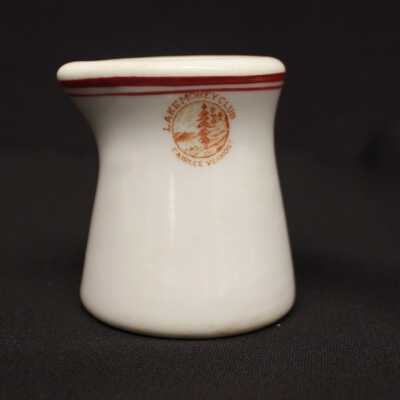
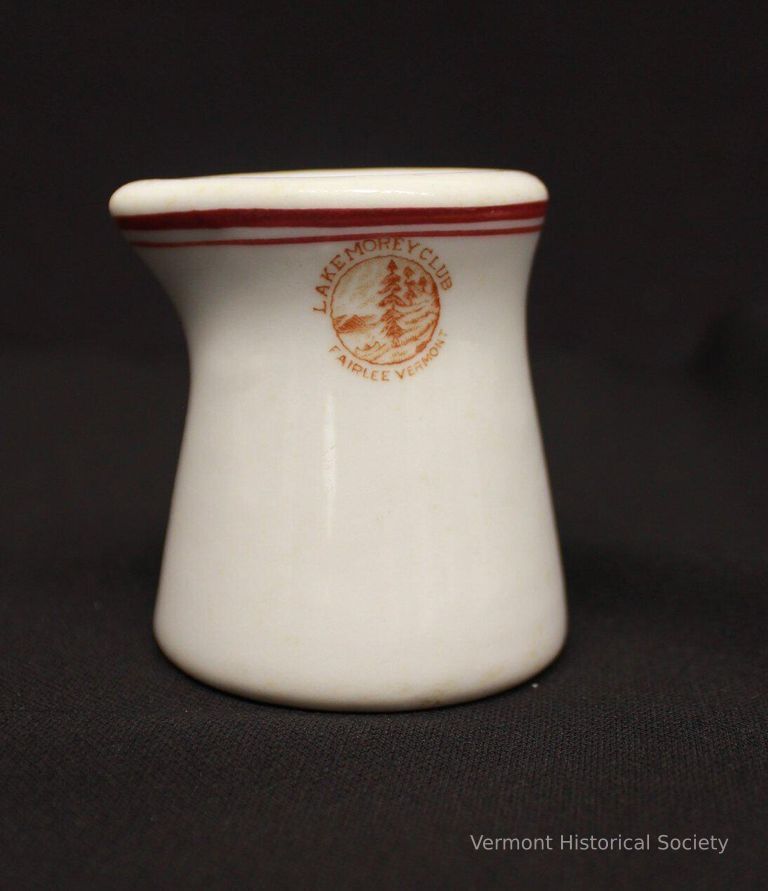
Cream Pitcher
Name/Title
Cream Pitcher
Lexicon
Description
Heavy white ceramic cream (or syrup) pitcher with red striping around the top edge. Just below the striping is the logo of the Lake Morey Club, which consists of a small, circular lake scene with tall evergreens and the inscription, "LAKE MOREY CLUB FAIRLEE VERMONT".
Acquisition
Accession
2016.51
Relationships
Related Person or Organization
Lake Morey Resort
Person or Organization
Related Places
,
Dimensions
Dimension Description
Overall
Materials
Material
Ceramic
Entry/Object ID
2016.51.8
Context
Used at the Lake Morey Resort in Fairlee, Vermont
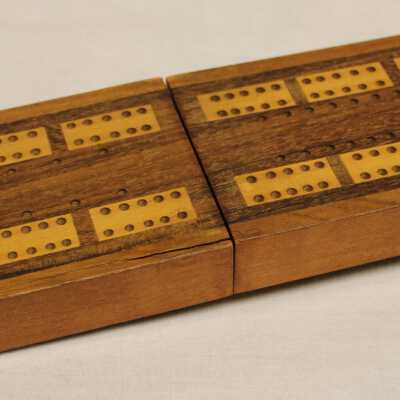
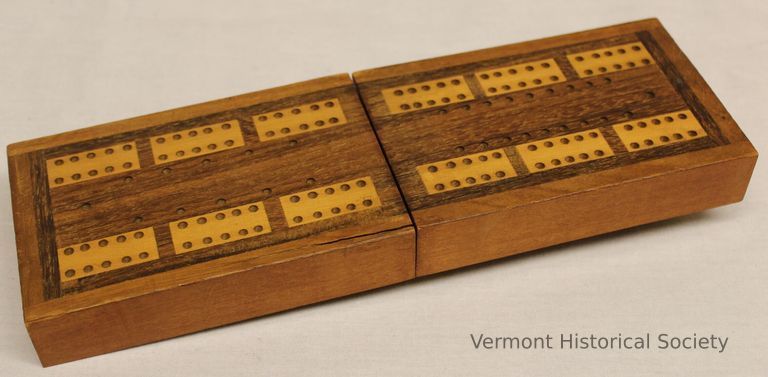
Cribbage Board
Name/Title
Cribbage Board
Lexicon
Description
Rectangular wooden cribbage board hinged at the center. When closed, the board forms a box with the cribbage board on the outside. The board consists of 12 light-colored rectangles of inlaid wood, each drilled with 2 rows of 10 holes. In the center of the board, between the 2 rows of inlay, is an oval formed from 30 drilled holes. The inside of the box, or back of the board, islined with paper printed in red and black with the symbols of standard playing card suites (heart, diamond, club, spade) in a repeating tiled pattern. There is a pointed wooden divider at one end. When closed, the box secures with a metal hook.
Acquisition
Accession
1999.23
Relationships
Related Events
World War II
Event
Related Person or Organization
Peck, Louis Provost (1918-2008)
Person or Organization
Related Places
Place
Montpelier
City
Washington County
County
Vermont
State/Province
United States of America
Country
North America
Dimensions
Dimension Description
Overall
Materials
Material
Wood, Paper, Metal
Entry/Object ID
1999.23.6
Context
Used by Louis Peck of Montpelier, Vermont, during World War II.
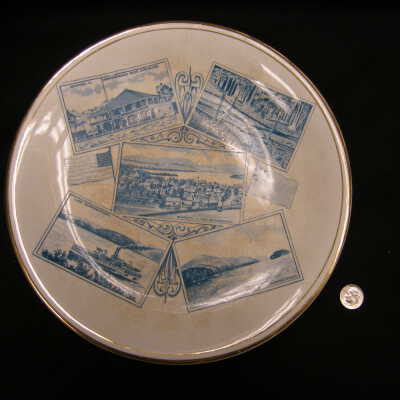
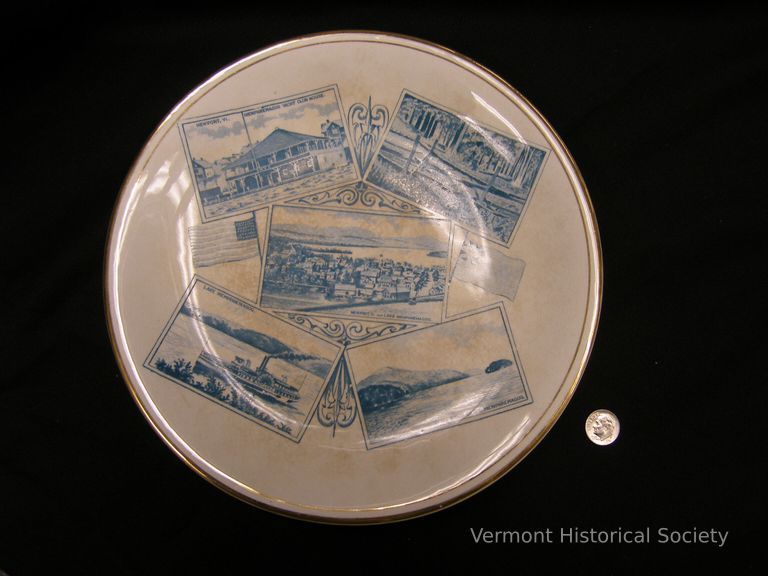
Decorative Plate
Name/Title
Decorative Plate
Lexicon
Description
Decorative plate printed in blue with five scenes framed like postcards. The scenes show the Memphremagog Yacht Club House, the boundary line between Canada and Vermont, an aerial view of Newport, Lady Lake Ferry, and Owl's Head and Round Island. The plate is marked illegibly on the bottom.
Acquisition
Accession
2005.21
Relationships
Related Person or Organization
Cleveland, Eugene R. (1911-2005)
Person or Organization
Related Places
,
Made/Created
Date made
1910-1930
Dimensions
Dimension Description
Overall
Materials
Material
Ceramic
Entry/Object ID
2005.21.95

Dodge, Bertha Sanford (1902-1995)
Name/Title
Dodge, Bertha Sanford (1902-1995)
Description
Born: March 23, 1902 in Cambridge, Massachusetts
Died: March 5, 1995 in South Burlington, Vermont
Primary Residence: Burlington
Well-known for her accomplishments as a writer and teacher of science. Was an International Institute Board Member. Member of the National Writers' Club and the Society of Technical Writers. Some of her most famous works are "Plants that Changed the World" and "Hands that Help."
Died: March 5, 1995 in South Burlington, Vermont
Primary Residence: Burlington
Well-known for her accomplishments as a writer and teacher of science. Was an International Institute Board Member. Member of the National Writers' Club and the Society of Technical Writers. Some of her most famous works are "Plants that Changed the World" and "Hands that Help."
Relationships
Related Places
Place
South Burlington
City
Chittenden County
County
Vermont
State/Province
United States of America
Country
North America
Biographical Information
Education
B.A., Radcliffe College (1920)
M.S., Massachusetts Institute of Technology (1922)
Biography
The daughter of a professor of Russian at Harvard University, she was born in Cambridge, Massachusetts on March 23, 1902. She received her B.A. from Radcliffe in 1920 and her M.S. from MIT in 1922. She married Carroll W. Dodge, who was a Botanist and Emeritus Professor at UVM, in 1925. They had two daughters, Anne and Mary.
For the majority of her life, Dodge taught high school and college science courses. She also ran a radio program for a year in the St. Louis City Hospital. Other accomplishments include her work as an International Institute Board Member from 1956 to 1959, along with her membership in the National Writers' Club and the Society of Technical Writers. Some of her works include: "Plants that Changed the World", "Hands that Help", "Potatoes and People", "Tales of Vermont Ways and People", "Story of Inscription Rock", and "Road West: Saga of the 35th Parallel", among other short stories.
Dodge spoke Spanish and German and read Portuguese and French. She traveled a great deal around Latin America and her collection of Guatemalan Indian weaving has been the subject of exhibits in several museums.
Occupation
High School science teacher
College Professor of Science
Writer
Entry/Object ID
1.1.29
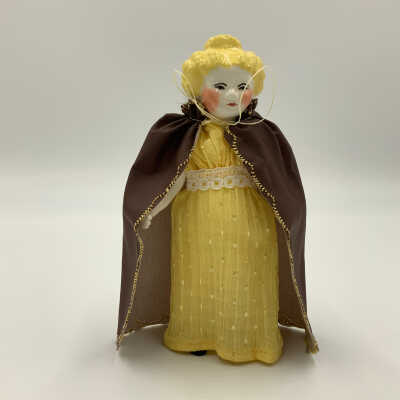

Doll
Name/Title
Doll
Lexicon
Description
Porcelain "Frozen Charlotte" doll. The doll has white skin, with molded and painted face and hair. The face has black eyes and brows, a red mouth, and large pink circles on the cheeks. The hair is yellow and molded into a bun. The feet are painted with black shoes. There is a stamp on the lower back of the doll that reads, "Fair, Charlotte, VT 1983". The doll is wearing a yellow dress and brown cloak.
Acquisition
Accession
2004.32
Relationships
Related Person or Organization
Green Mountain Doll Club
Person or Organization
Made/Created
Date made
1983
Dimensions
Dimension Description
Overall
Materials
Material
Porcelain, Nylon
Entry/Object ID
2004.32.1a-c
Context
Fair Charlotte, or Frozen Charlotte, is from a moralizing tale about a young woman who freezes to death on her way to ball.

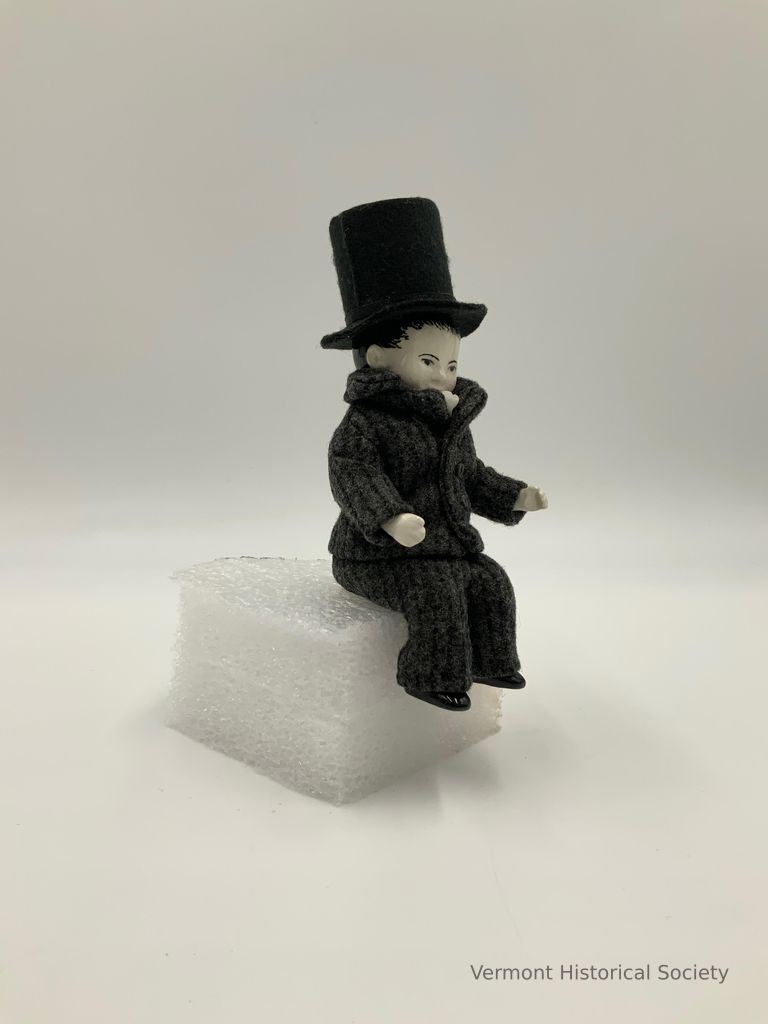
Doll
Name/Title
Doll
Lexicon
Description
Porcelain "Frozen Charlie" doll. The doll has white skin, with molded and painted face and hair. His eyes, brows, hair and shoes are painted in black. He is wearing a grey suite, white ascot, and black top hat. There is a stamp on the doll's back that reads, "Charlie, VT, 1983".
Acquisition
Accession
2004.32
Relationships
Related Person or Organization
Green Mountain Doll Club
Person or Organization
Made/Created
Date made
1983
Dimensions
Dimension Description
Overall
Materials
Material
Wool, Polyester, Porcelain
Entry/Object ID
2004.32.2a-b
Context
Frozen Charlie is adapted from a moralizing tale about a young woman who freezes to death on her way to ball. Charlie was her escort.

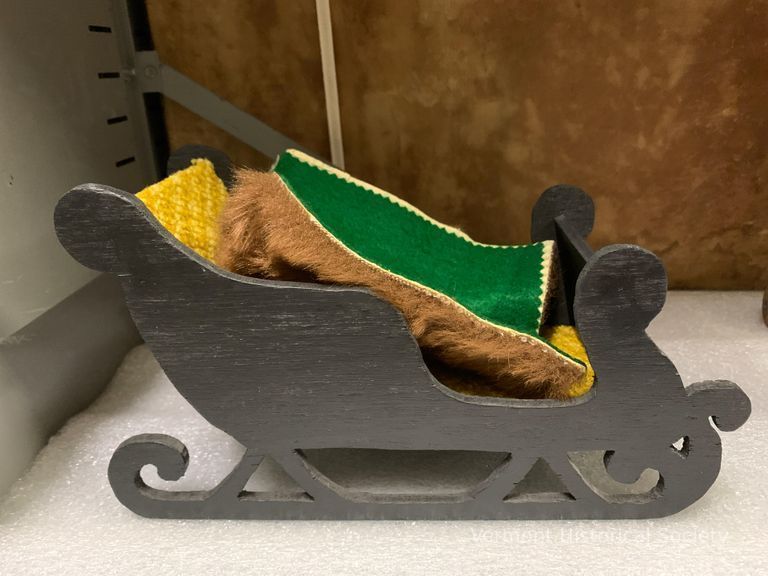
Doll Sleigh
Name/Title
Doll Sleigh
Lexicon
Description
Doll-sized toy sleigh made of black-painted plywood. The sleigh is constructed out of 5 pieces: 2 sides, the back, the front, and the bottom. The interior is covered with yellow looped pile carpeting, and there is a blanket made from green felt and faux fur.
Acquisition
Accession
2004.32
Relationships
Related Person or Organization
Green Mountain Doll Club
Person or Organization
Made/Created
Date made
1983
Dimensions
Materials
Material
Wood, Synthetic
Entry/Object ID
2004.32.3a-b
Context
Part of a set illustrating the story of Frozen Charlotte, a moralizing tale about a young woman who freezes to death on her way to ball.

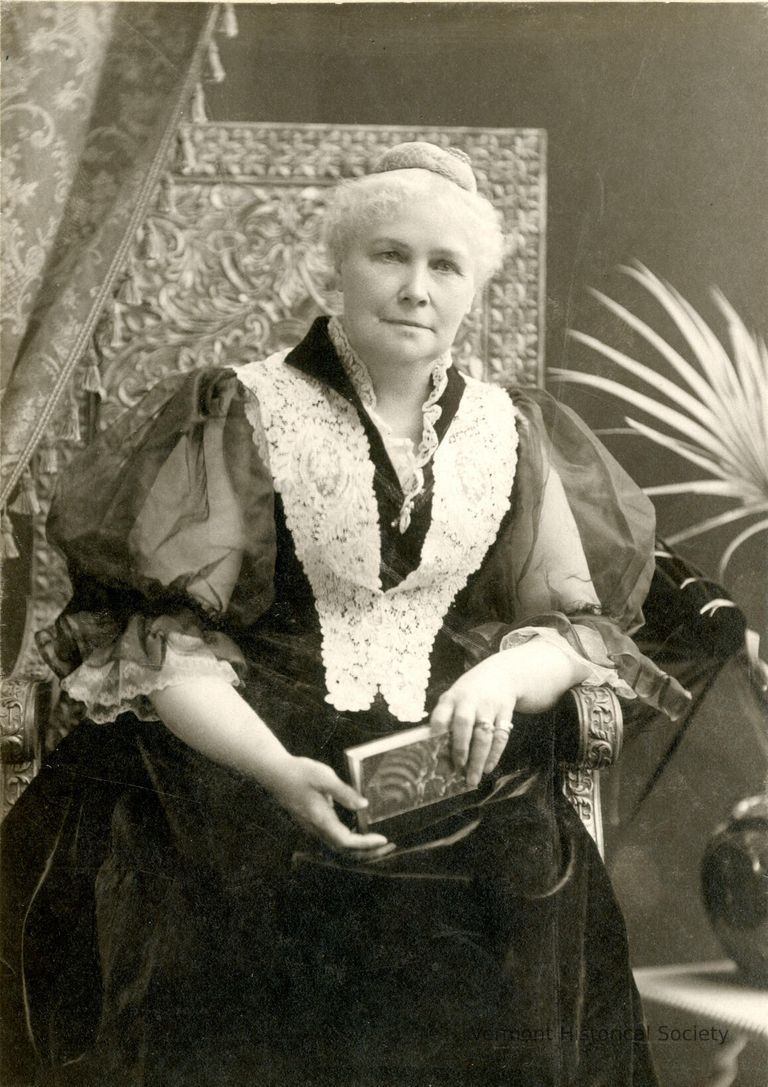
Dorr, Julia Caroline Ripley (1825-1913)
Name/Title
Dorr, Julia Caroline Ripley (1825-1913)
Description
Born: February 13, 1825 in Charleston, South Carolina
Died: January 18, 1913 in Rutland, Vermont
Primary Residence: Rutland
Vermont's unofficial poet laureate. Honored with the task of composing the "Centennial Poem" for the Vermont Centennial in 1877. Accomplished author and poet.
Died: January 18, 1913 in Rutland, Vermont
Primary Residence: Rutland
Vermont's unofficial poet laureate. Honored with the task of composing the "Centennial Poem" for the Vermont Centennial in 1877. Accomplished author and poet.
Biographical Information
Education
Middlebury Female Seminary
Troy Conference Academy
Biography
Julia Caroline Ripley Dorr was a famous Vermont author and poet, and one of the first female literary figures in Vermont. She published many novels, poems, and books on travel and advice.
Born in Charleston, South Carolina, Dorr lived with her widower father in New York City for a brief time before moving to Middlebury, Vermont, where her father was remarried. She had some schooling at the Middlebury Female Seminary and the Troy Conference Academy.
Julia Dorr was happily married to Seneca M. Dorr, a lawyer and legislator, in 1847. Together they had five children. They settled in Rutland, and lived in a home called "The Maples" on the bank of the Otter Creek.
Dorr was first published after becoming a wife and mother. Her family provided support for her writing ambitions. Her husband helped to publish her first novel, "Farmingdale", in 1854, under the pseudonym, Caroline Thomas. She had two more novels, "Lanmere" (1856) and "Sybil Huntington" (1869), published under this name. From 1873 on, she produced publications under her own name including, "Expiation" (1873), "Bride and Bridegroom" (1873), "In King's Houses" (1898), ten volumes of verse, and three travel books, among others. Her novels often "portrayed young women lifting themselves from poverty through education and persistence".
Her work appeared in such publications as, "Harper's", "Scribner's", and "The Atlantic".
Dorr was honored as the state's "unofficial poet laureate" and asked to write the Centennial Poem in 1877. The 337-line "Centennial Poem" likened Vermont to, "Woman form, majestic, strong, and fair".
Julia Dorr was an active member of the Rutland community. She was a founder of the Rutland Free Library. She was President of the Rutland Fortnightly Club for thirty years. Her children and nephew were regarded as artistically talented as well. Two of her sons, Henry Ripley and Russell R., paid her tribute at Rutland's Centennial celebration. Julia Dorr's father built (and rebuilt after a fire) the Rutland Opera House. Julia Dorr composed an ode for the reopening of the Opera House.
Julia Dorr gained the respect and friendship of many of the era's famous male literary figures including: Longfellow, Lowell, Holmes, Whittier, and Emerson.
In 1910, Dorr received an honorary Doctorate of Letters from Middlebury College. The College stated, "...you have written the peace and beauty of our northern valleys...you have sung your quiet way into the hearts of Vermont men and women."
Occupation
Writer
Poet
Entry/Object ID
1.1.31
Web Links and URLs

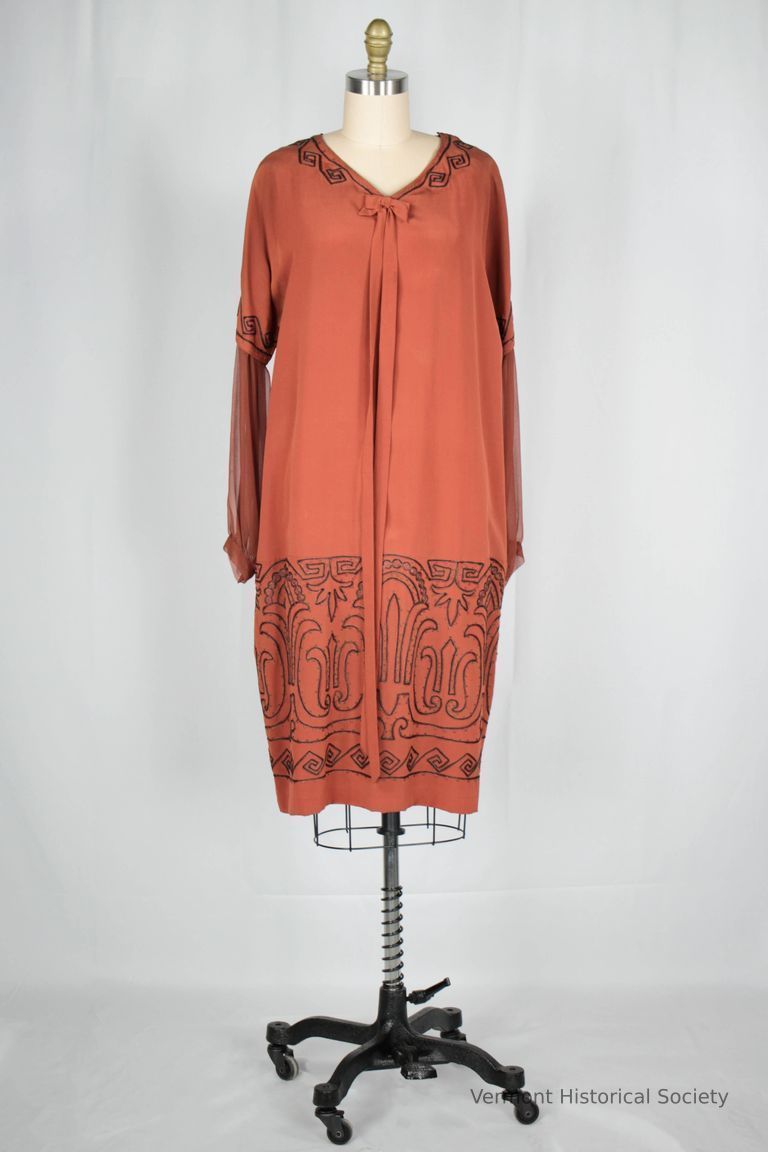
Dress
Name/Title
Dress
Lexicon
Clothing/Dress/Costume Details
Article of Clothing/Dress/Costume
Dress
Textile Details
Crepe
Fabric
Silk
Rayon
Clothing Sex
Female
Description
Rust-colored silk crepe dress with chiffon sleeves. The dress is embroidered in black chain stitches with an Egyptian revival pattern around the neckline, over-sleeve cuffs, and hem. The neckline and sleeve embroidery is a simple key style design. The design is echoed at the bottom of the hem embroidery, but the hem embroidery also includes large-format stylized palm leaves and lyres, reaching to the wearer's upper thigh. The dress is straight waisted with a V-shaped neckline. There is an attached, self-fabric bow at the center front neckline with tails that reach almost to the hem. The sleeves are constructed in two parts: the over sleeves are cut as one with the body of the dress, and the rest of the sleeves are chiffon.
Acquisition
Accession
1976.9
Made/Created
Date made
1920-1929
Entry/Object ID
1976.9.1


Farr, Shirley (1881-1955)
Name/Title
Farr, Shirley (1881-1955)
Description
Born: June 11, 1881 in Columbus, Ohio
Died: August 25, 1955 in Brandon, Vermont
Primary Residence: Brandon
Civic leader in the town of Brandon for many years. National president of the Women's Overseas Service League in Paris during WWI. National vice-president of the AAUW and a member of the Rutland branch. Gifted Branbury Beach to the state, as well as supporting scholarship monies at UVM and through AAUW.
Died: August 25, 1955 in Brandon, Vermont
Primary Residence: Brandon
Civic leader in the town of Brandon for many years. National president of the Women's Overseas Service League in Paris during WWI. National vice-president of the AAUW and a member of the Rutland branch. Gifted Branbury Beach to the state, as well as supporting scholarship monies at UVM and through AAUW.
Biographical Information
Education
Ph.B. (Bachelors of Philosophy), University of Chicago, (1904).
Biography
Shirley Farr was born to Vermont natives and spent her early years mostly in Illinois and Wisconsin. She was raised by her grandparents for several years in Ripon, WI after her mother's death. Farr earned a Ph.B. from the University of Chicago in 1904.
From 1907-1909, she taught French and history at Ripon College. After her father's death in 1913, she succeeded him as a member of the Board of Trustees at Ripon College and held this post until her death. She was a history instructor at the University of Chicago from 1914-1918. From 1929-1934, she was a counselor in the history department.
Shirley Farr traveled to France as peace was declared at the end of WWI. She worked with wounded American soldiers at a base hospital in Hiers. She had attended undergraduate school in Paris and worked as a researcher in the Paris Archives. She became involved with the newly formed organization, The Women's Overseas Service League, which provided support to needy overseas volunteers. For a time she was this organization's national president.
Farr then lived in Washington D.C. from 1921-1922 at the club house of the American Association of University Women (AAUW) and had a position as assistant editor of the "American Historical Review". She served as vice-president and committee member of the AAUW, and was a member of the Rutland Branch.
Shirley Farr is best remembered in Vermont for her contributions to the town of Brandon. In 1920, the year that women won the right to vote, Farr registered to vote in Brandon, and voted there every November thereafter. From 1942 on, she lived year-round in a family home in Brandon. She represented the town in the state legislature in 1945 and 1947. She served as a Vermont Elector during President Eisenhower's first election.
Shirley Farr served as a board member of several businesses: the Vermont Children's Aid Society, The Vermont State Symphony Orchestra, and the Brandon library.
Knowingly or unknowingly, Farr's funding of the Vermont Children's Aid Society indirectly supported Vermont's Eugenics Survey in the late 1920s.
Farr is remembered for her generous philanthropy. She gifted Branbury Beach and nearby forest lands, which are now the site of a state park. She also made it possible for many students to receive an education, contributing scholarship money to Ripon College, the University of Vermont, and the AAUW.
Occupation
Educator
Writer
Legislator
Civic Leader
Entry/Object ID
1.1.33
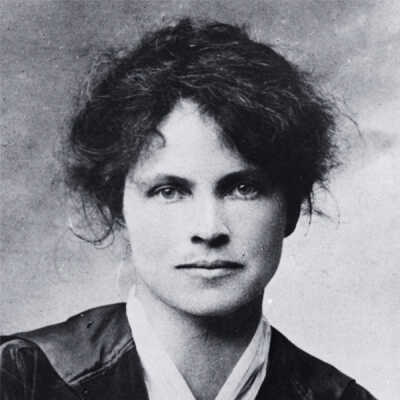
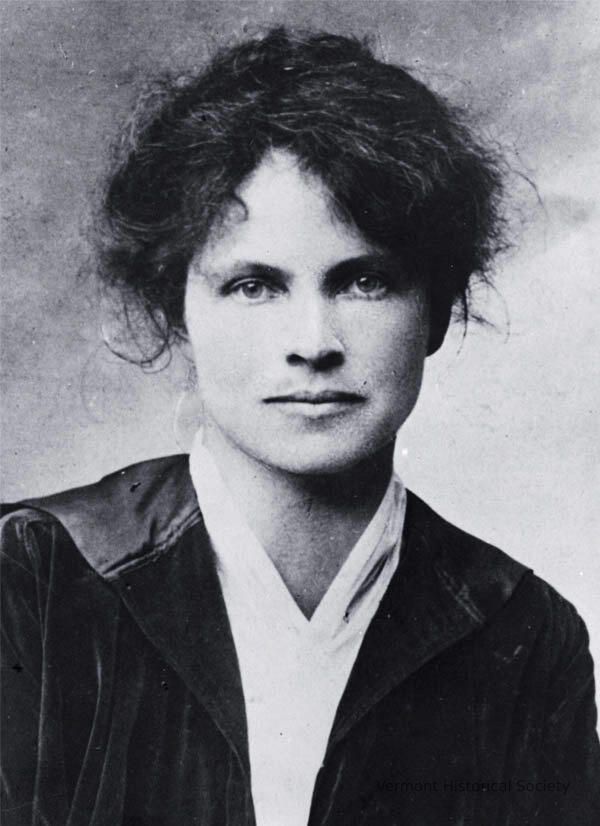
Fisher, Dorothy Canfield (1879-1958)
Name/Title
Fisher, Dorothy Canfield (1879-1958)
Description
Born: February 17, 1879 in Lawrence, Kansas
Died: November 9, 1958 in Arlington, Vermont
Primary Residence: Arlington
Author of many novels and short stories. Dedicated humanitarian during WWII, helping many children's causes in Europe through her writing and activism in the U.S. Brought the Montessori method of child rearing to America. Named by Eleanor Roosevelt as one of the ten most influential women in the United States.
Died: November 9, 1958 in Arlington, Vermont
Primary Residence: Arlington
Author of many novels and short stories. Dedicated humanitarian during WWII, helping many children's causes in Europe through her writing and activism in the U.S. Brought the Montessori method of child rearing to America. Named by Eleanor Roosevelt as one of the ten most influential women in the United States.
Biographical Information
Education
BA, Ohio State (1899)
Doctorate, French, Columbia University (1904)
Honorary Doctorates, Middlebury College (1921), University of Vermont (1922), Dartmouth College (1922)
Biography
Dorothy Canfield Fisher was born in Lawrence, Kansas to parents of Vermont descent. Her father's family had settled in Vermont shortly after the French and Indian War. As a child, Fisher was an avid learner, and traveled often with her family to Europe to study the arts. She attended a boarding school in Paris. Her father, James, became Chancellor of the University of Nebraska, and later, president of the National Education Association. When he became president of Ohio State University, the family moved again to Columbus. Fisher's family believed women should have the same educational opportunities as men. She attended Ohio State, and graduated with a bachelor's degree in 1899. She then attended graduate school in Paris, studied German in Hanover, and worked at the British Museum.
On returning from Europe, Fisher lived with her family in New York City, where her father now worked as librarian for Columbia University. Here, Fisher began writing articles for publications such as, "The Outlook", the "Times", and "Harper's Bazaar". While studying for her doctorate in French, she alternated terms in European universities with terms in New York at Columbia University. She received her PhD in French in 1904.
In 1907, Dorothy married John Fisher, a law student from New York. The couple moved to Arlington, Vermont that year to pursue careers as free-lance writers. They had two children, Sally and James.
Dorothy Canfield Fisher was the author of many novels and short stories throughout her lifetime. Some of these include: "Hillsboro People" (1915) (which is set in Arlington, VT), "The Bent Twig" (1915), several books influenced by Italian educator, Dr. Maria Montessori, including, "The Montessori Mother" (1912), three volumes of short stories influenced by her family's experiences in the French war camps and clinics of WWII including, "Home Fires in France" (1918), home and family novels including, "Her Son's Wife" (1926), and several historical children's books such as, "Paul Revere and the Minute Men" (1950).
Dorothy Canfield Fisher was a member of the first board of the Book-of-the-Month Club, where she played an important role in promoting such noted writers as Pearl Buck, Isaac Dinesen, and Richard Wright. She was also a member of the Vermont Historical Society, which she joined in 1921. Fisher is credited with bringing the Montessori Method of teaching to the United States from Europe, and being the first woman to serve on the Vermont Board of Education. Eleanor Roosevelt named Fisher one of the ten most influential women in the United States.
Fisher is remembered for her activism in war-related causes, such as her work with war blind in France. She established the Fund to Aid French Children. She helped children of refugees by providing them with summer homes. She also worked with the Children's Crusade for Children, and was recognized by several organizations for her humanitarian work. Much of her humanitarian work was done through written contributions that raised awareness in the U.S. about the war in Europe. She contributed to works such as, "The City of Man: A Declaration on World Democracy" and "America Organizes to Win the War".
Fisher was honored with many Doctor of Letters degrees, including those from Middlebury College (1921), the University of Vermont (1922), and Dartmouth College (1922). The Dorothy Canfield Fisher Book Award was established before her death in 1958.
Occupation
British Museum
Writer
Activist
Humanitarian
Entry/Object ID
1.1.35
Web Links and URLs

Giudici, Lena M. (1898-1995)
Name/Title
Giudici, Lena M. (1898-1995)
Description
Born: November 7, 1898 in Barre, Vermont
Died: January 8, 1995 in Barre, Vermont
Primary Residence: Barre
Third woman to be admitted to Vermont Bar Asscoiation (1921). First recording secretary for the Vermont Chapter of the Business and Professional Women's Club. President of the Barre branch of the Vermont Federation of Professional and Business Women's Clubs. First woman admitted to the Bar in Massachussetts (1920). Served on Board of the Office of Price Administration, an agency that monitored the prices of goods at the end of WWII.
Died: January 8, 1995 in Barre, Vermont
Primary Residence: Barre
Third woman to be admitted to Vermont Bar Asscoiation (1921). First recording secretary for the Vermont Chapter of the Business and Professional Women's Club. President of the Barre branch of the Vermont Federation of Professional and Business Women's Clubs. First woman admitted to the Bar in Massachussetts (1920). Served on Board of the Office of Price Administration, an agency that monitored the prices of goods at the end of WWII.
Biographical Information
Education
LL.B., Boston University (1920)
Biography
Lena Giudici was born in Barre, VT. She graduated from Spaulding High School in 1917 and then went on to Boston University where she studied law and accounting. She graduated from Boston University in 1920 and became the first woman admitted to the Massachussetts Bar. She then moved to Vermont in 1921 where she became the third woman admitted to the Vermont Bar.
Lena Giudici rarely practiced law, but remained a member of the Bar. She primarily did accounting work for granite firms. She served on the Board of the Office of Price Administration, which was set up to monitor prices at the end of World War II. Giudici also served as President of the Barre Branch of the Vermont Federation of Professional and Business Women's Club, and was Treasurer of the Vermont State Federation. She attended several conferences through the Federation and organized the State Federation convention that was held in Barre on May 22-23, 1929.
Occupation
Lawyer
Accountant
Entry/Object ID
1.1.116
Web Links and URLs

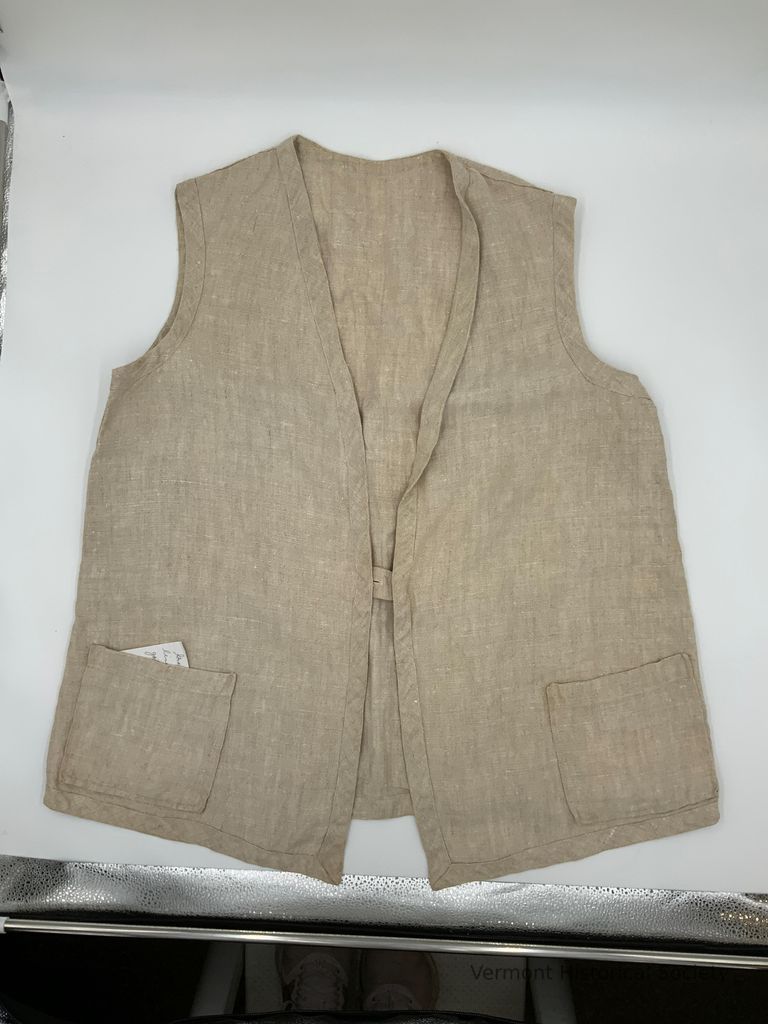
Golf Suit
Name/Title
Golf Suit
Lexicon
Clothing/Dress/Costume Details
Textile Details
Linen
Material
Clothing Sex
Female
Description
Linen golfing outfit consisting of a vest and knickers. The vest secures at the center front with an interior tab and has two patch pockets. The knickers are cut wide with a tight cuff that sits below the wearer's knees. The waist secures at either side with vertical rows of buttons.
Acquisition
Accession
2021.22
Relationships
Related Person or Organization
Kirk, Gertrude Mackie (1895-1984), Barre Country Club
Related Places
Place
Barre City
City
Washington County
County
Vermont
State/Province
United States of America
Country
North America
Made/Created
Date made
circa 1920
Entry/Object ID
2021.22.2a-b
Context
Worn by Gertrude Mackie Kirk at Barre County Club
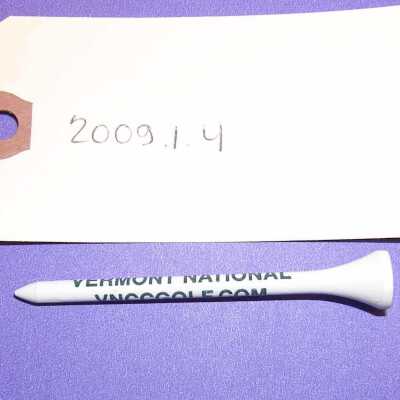
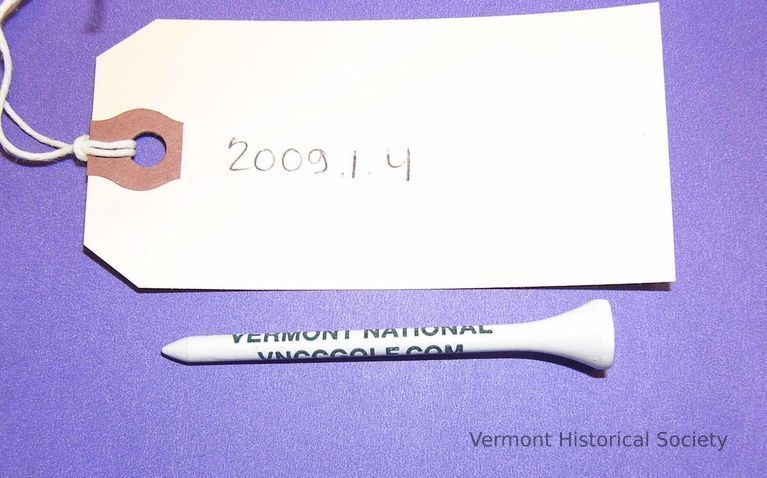
Golf Tee
Name/Title
Golf Tee
Lexicon
Description
White-painted wooden golf tee printed in black with the inscription, "VERMONT NATIONAL VNCCGOLF.COM".
Acquisition
Accession
2009.1
Relationships
Related Person or Organization
Vermont National Country Club
Person or Organization
Related Places
Place
South Burlington
City
Chittenden County
County
Vermont
State/Province
United States of America
Country
North America
Made/Created
Date made
2006
Dimensions
Dimension Description
Overall
Materials
Material
Wood
Entry/Object ID
2009.1.4
Context
Distributed as promotional material for Vermont National Country Club in South Burlington, Vermont
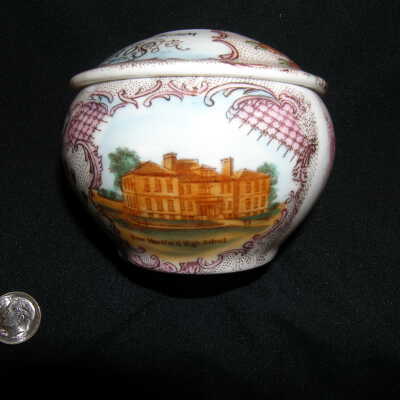
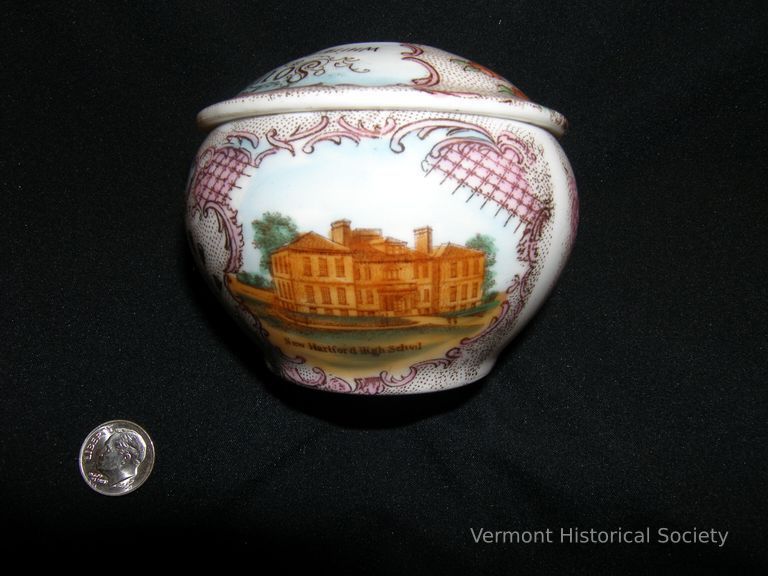
Hair Receiver
Name/Title
Hair Receiver
Lexicon
Description
Two-piece hair receiver consisting of a small pot or jar and lid. The lid has a round hole in the center. The jar is printed with three images of buildings. The images are labeled, "New Hartford High School", "Gates Building" and "the Wilder Club and Library". The lid is labeled, "Souvenir of WHITE RIVER JUNC, VT."
Use
Hair receivers were used to store hair removed from brushes and combs. The hair could be recycled by using it to stuff small bags called "rats" that were used to give body to large hairstyles.
Acquisition
Accession
2005.21
Relationships
Related Person or Organization
Cleveland, Eugene R. (1911-2005)
Person or Organization
Related Places
Place
White River Junction
Village
Hartford
Town
Windsor County
County
Vermont
State/Province
United States of America
Country
North America
Made/Created
Date made
1910-1930
Dimensions
Dimension Description
Overall
Materials
Material
Ceramic
Entry/Object ID
2005.21.163ab
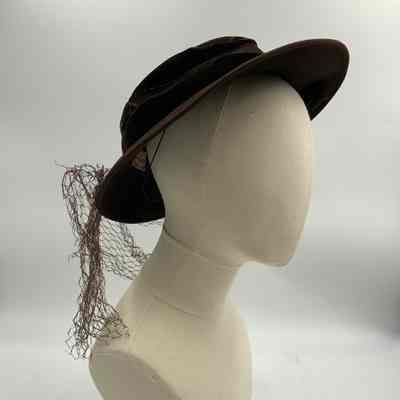
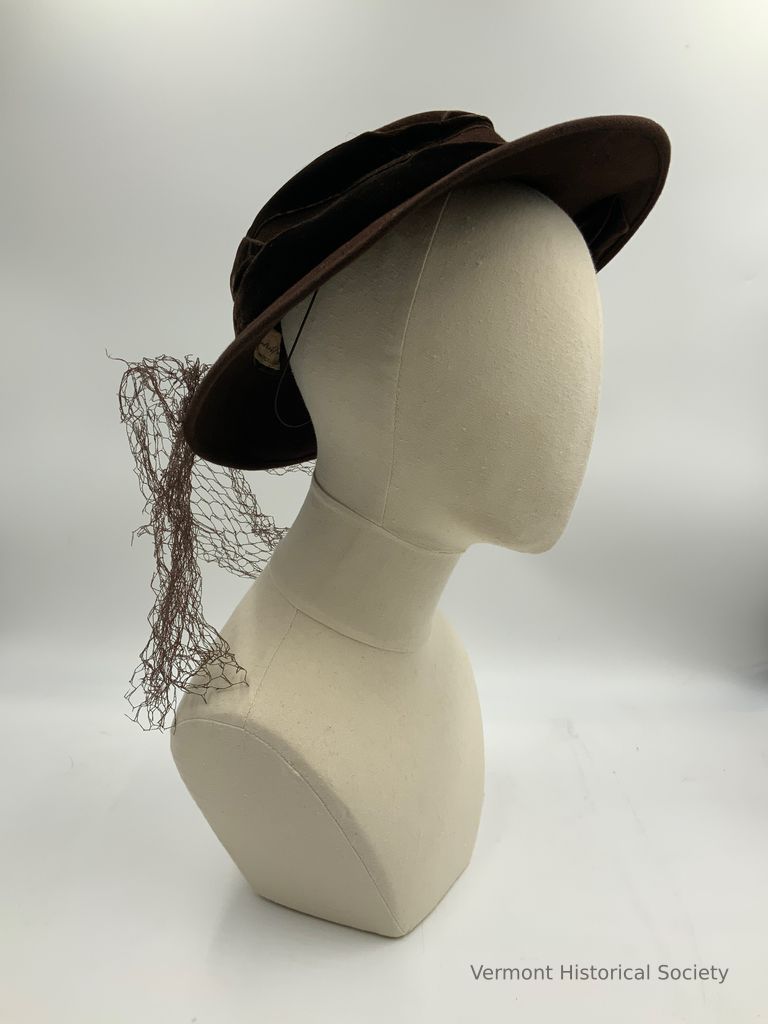
Hat
Name/Title
Hat
Lexicon
Description
Brown felt hat with a brim all the way around. It has a low crown that is decorated with a brown velvet ribbon. Remnants of brown netting are attached to the back. There is a black elastic loop attached to the interior to secure the hat to the wearer's head. A label inside reads, "Elizabeth G. Cross MONTPELIER, VT."
Acquisition
Accession
1976.9
Relationships
Related Person or Organization
Elizabeth Cross Millinery Store
Person or Organization
Related Places
Place
Montpelier
City
Washington County
County
Vermont
State/Province
United States of America
Country
North America
Materials
Material
Wool, Silk, Elastic
Entry/Object ID
1976.9.9
Context
Sold by Elizabeth Cross Millinery Store in Montpelier, Vermont
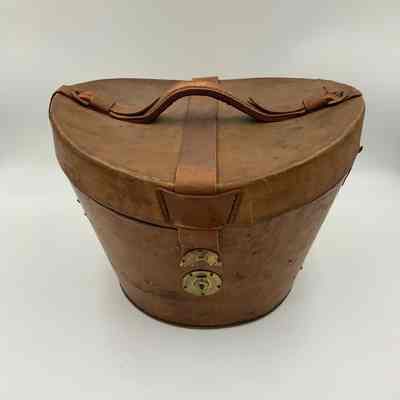
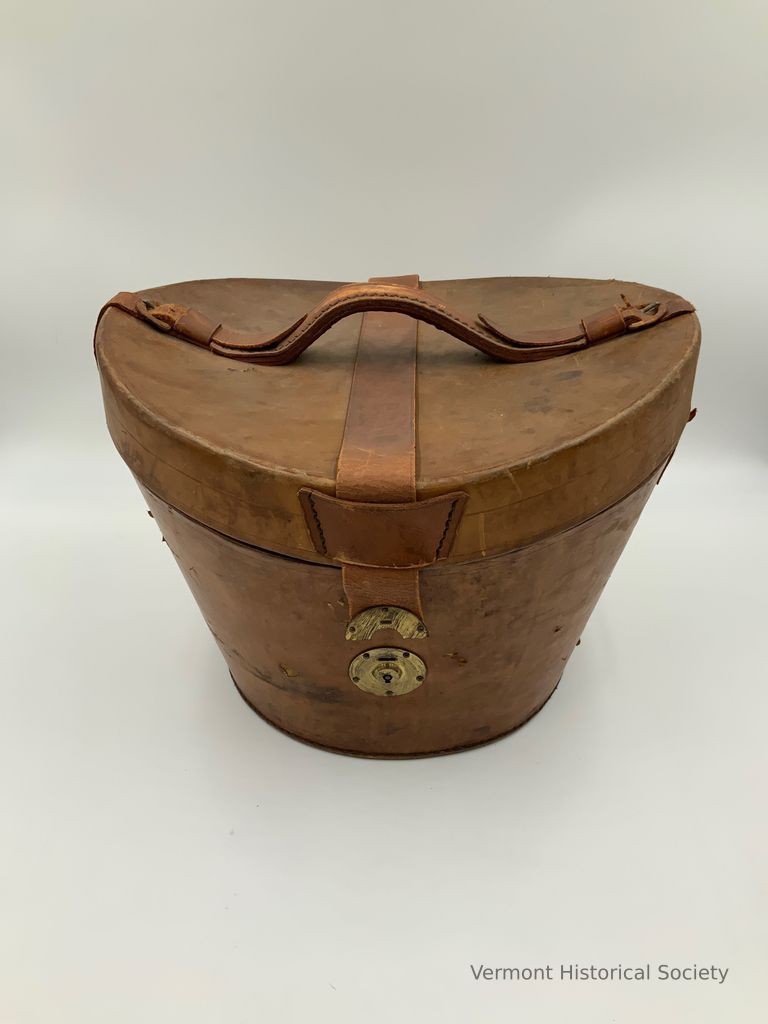
Hatbox
Name/Title
Hatbox
Lexicon
Description
Shaped leather travel case for a hat. The case has a round base, and the sides flare outward to the concave lid. A leather strap forms a handle across the width of the top. Another leather strap lays across the lid perpendicular to the handle and hangs over the front side to insert into a brass clasp.
Acquisition
Accession
1976.9
Dimensions
Dimension Description
Overall
Materials
Material
Leather, Brass
Entry/Object ID
1976.9.10


Ice Skates
Name/Title
Ice Skates
Lexicon
Description
Metal clamp-on style ice skates. The skates consist of a toe plate, heel plate, and blade. The toe plate has a quatrefoil punched out of the center. It is marked, "PECK & SNYDER'S 11 COLUMBIA CLUB." There is a metal bracket on either side of the toe plate even with the ball of the foot. Each bracket can be adjusted outward or inward with a bolt under the toe plate, making the fit wider or narrower. The heel plate is upturned at three corners--two in the back and one in the front--to clamp onto the heel of the wearer's shoe. The clamp is set and released with a lever at the center of the skate. The toe and heel plates are connected to the blade at their centers, and the toe plate has an additional hinged connection point at the front. The length is adjustable via a bolt at the center connecting the two plates. The blade is narrow, but no longer sharp.
Acquisition
Accession
1966.17
Made/Created
Manufacturer
Peck & Snyder
Materials
Material
Steel
Entry/Object ID
1966.17.15a-b
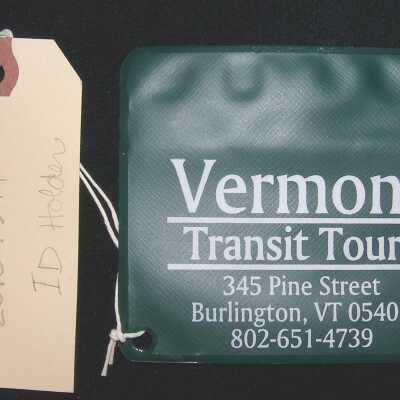
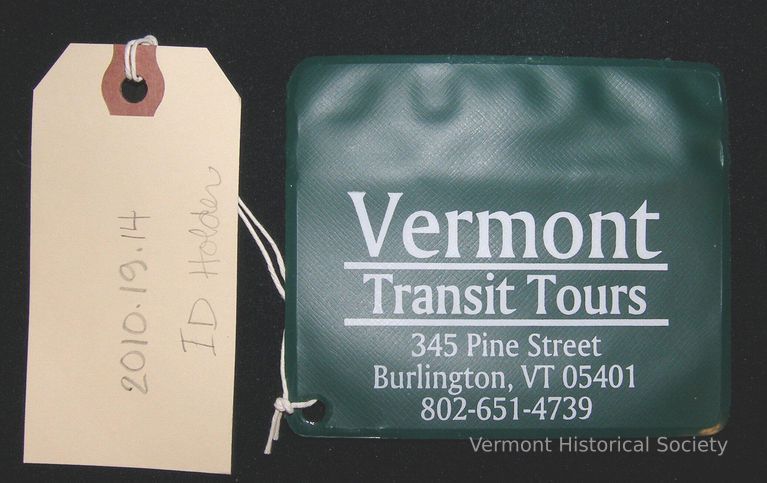
Identification Holder
Name/Title
Identification Holder
Lexicon
Description
ID tag holder, clear on one side (to view the ID) and dark green on the other side. The green side has white printing that reads: "Vermont / Transit Tours / 345 Pine Street / Burlington, VT 05401 / 802-651-4739" There is a plastic 'zipper' (like on sandwich bags) on the clear side to keep the ID securely in the holder. There is a punched, sealed hole in the lower corner to allow the holder to be worn.
Acquisition
Accession
2010.19
Relationships
Related Person or Organization
Vermont Transit Company, Inc.
Person or Organization
Related Places
Place
Burlington
City
Chittenden County
County
Vermont
State/Province
United States of America
Country
North America
Dimensions
Materials
Material
Plastic
Entry/Object ID
2010.19.14
Context
From the Vermont Historical Society Library:
On February 16, 1926, the first local bus route in Burlington, the “Country Club
Loop”, was established by William S. Appleyard, who owned an automobile dealership
on South Winooski Avenue. Calling his company the Burlington Rapid Transit Company
(BRT), he received permission from the Public Service Commission (PSC) to operate a
non-competitive (with BTC) bus route in the Hill Section of Burlington. Soon, when
BTC failed to comply with PSC orders to expand their lines, the commission granted
Appleyard permission to operate his buses in places directly in competition with the
BTC.
Over the next few years, Appleyard received permission to expand to seven
competitive yet successful bus routes in the Burlington area. His success, combined with
the devastating flood in November of 1927 (that damaged trolley tracks and collapsed the
Winooski Bridge, a main BTC route), proved to be the undoing of the BTC. In 1929,
Appleyard bought the BTC in order to acquire its routes and eliminate competition. BTC
trolleys operated until August 4, 1929, when, at 4 p.m., a crowd gathered at City Hall
Park to witness the famous and symbolic torching of Car #5, their oldest trolley. The
trolley era had ended.
Meanwhile, in 1927, Appleyard established the Vermont Transit Company
(VTC), under which he operated out-of-town buses. Over the next decade and a half,
Appleyard purchased existing bus lines throughout Vermont, connecting Burlington via
bus to the other towns and cities of Vermont (and beyond). Towns accessed by VTC
buses included Barre (1927), Rutland and Vergennes (1928), Bennington and Pittsfield,
MA (1929), Portland, ME (1932), Bellows Falls, White River Junction and Claremont,
NH (1935), Albany, NY (1936), St. Johnsbury and Littleton, NH (1937), Newport
(1938), Chester and Springfield (1939), and Concord and Manchester, NH (1941). By
1945, VTC buses were connecting Vermonters to New York City, Boston and Montreal.
In 1975, Greyhound bought Vermont Transit Company, though they continued to
operate it as the Vermont Transit Company until 2008.
As of 2010, all of Greyhound’s Vermont bus service is based out of its White
River Junction hub; service in the Burlington area is now operating out of the Burlington
airport. Due to declining ridership, bus service down the western side of Vermont has
been terminated.
On February 16, 1926, the first local bus route in Burlington, the “Country Club
Loop”, was established by William S. Appleyard, who owned an automobile dealership
on South Winooski Avenue. Calling his company the Burlington Rapid Transit Company
(BRT), he received permission from the Public Service Commission (PSC) to operate a
non-competitive (with BTC) bus route in the Hill Section of Burlington. Soon, when
BTC failed to comply with PSC orders to expand their lines, the commission granted
Appleyard permission to operate his buses in places directly in competition with the
BTC.
Over the next few years, Appleyard received permission to expand to seven
competitive yet successful bus routes in the Burlington area. His success, combined with
the devastating flood in November of 1927 (that damaged trolley tracks and collapsed the
Winooski Bridge, a main BTC route), proved to be the undoing of the BTC. In 1929,
Appleyard bought the BTC in order to acquire its routes and eliminate competition. BTC
trolleys operated until August 4, 1929, when, at 4 p.m., a crowd gathered at City Hall
Park to witness the famous and symbolic torching of Car #5, their oldest trolley. The
trolley era had ended.
Meanwhile, in 1927, Appleyard established the Vermont Transit Company
(VTC), under which he operated out-of-town buses. Over the next decade and a half,
Appleyard purchased existing bus lines throughout Vermont, connecting Burlington via
bus to the other towns and cities of Vermont (and beyond). Towns accessed by VTC
buses included Barre (1927), Rutland and Vergennes (1928), Bennington and Pittsfield,
MA (1929), Portland, ME (1932), Bellows Falls, White River Junction and Claremont,
NH (1935), Albany, NY (1936), St. Johnsbury and Littleton, NH (1937), Newport
(1938), Chester and Springfield (1939), and Concord and Manchester, NH (1941). By
1945, VTC buses were connecting Vermonters to New York City, Boston and Montreal.
In 1975, Greyhound bought Vermont Transit Company, though they continued to
operate it as the Vermont Transit Company until 2008.
As of 2010, all of Greyhound’s Vermont bus service is based out of its White
River Junction hub; service in the Burlington area is now operating out of the Burlington
airport. Due to declining ridership, bus service down the western side of Vermont has
been terminated.
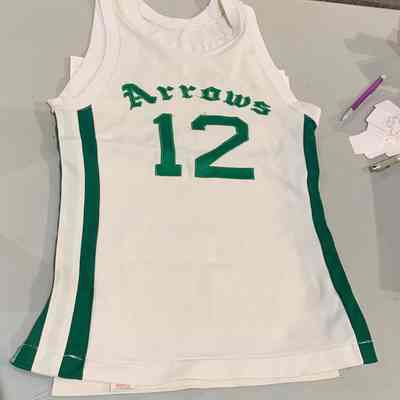
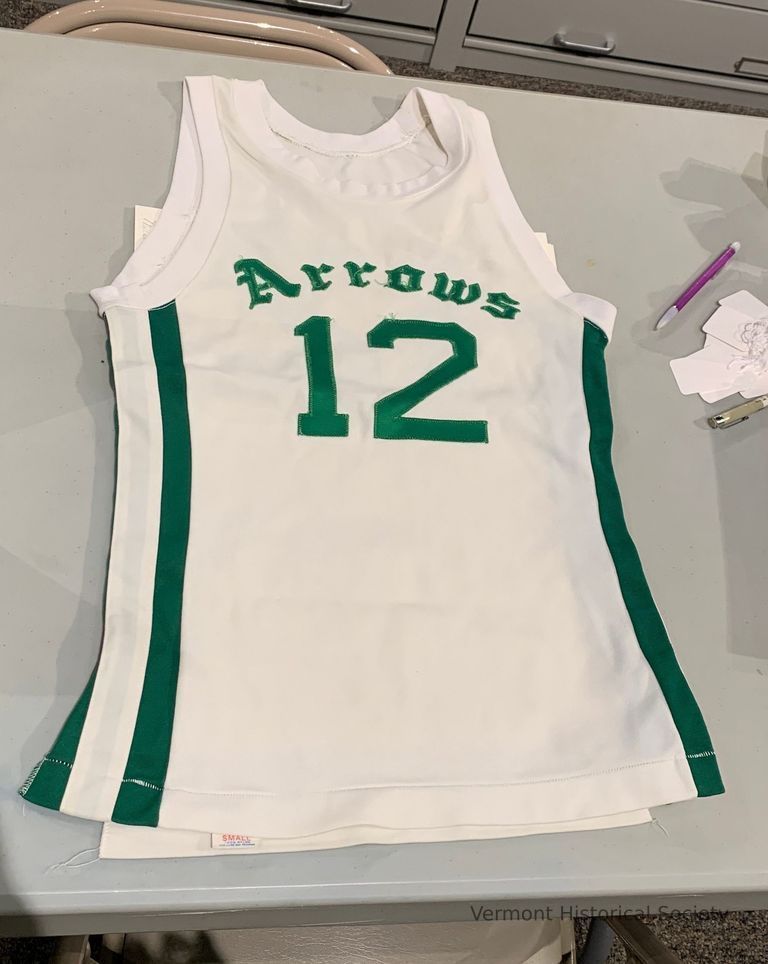
Jersey
Name/Title
Jersey
Clothing/Dress/Costume Details
Article of Clothing/Dress/Costume
Shirt
Notes
All base material of the jersey is a white nylon (this also lines the neckline and the sleeve lines). All seams and hems in white thread while securing in green thread decorations in same fabric as white but in green. Fabric is semi-stretchy for athletic wear.
Textile Details
White
Green
Color
Nylon
Clothing Sex
Male
Size
Small
Description
White and green sleeveless jersey with white background and green striping. In the center bearing inscription: "Arrows" in green fabric with green topstitching and the number "12" in same green fabric with green topstitching. Back has another "12" in same green fabric with green topstitching. Unlined interior with tag saying: "Champion (within logo blue, white and red) SMALL (in red) 100% NYLON FOR CARE SEE REVERSE (on Verso of tag) CHAMPION PRODUCTS INC ROCHESTER N.Y. MACHINE WASH TUMBLE DRY LOW TEMPS MILD DETERGENT AVOID CHLORINE BLEACH DO NOT IRON DESIGN RH 26094 MADE IN USA" all in light blue.
Worn by Daryl Wetzel Austine alumnus class of 1979 who in 1978 won the 1,000 points for the basketball team.
Worn by Daryl Wetzel Austine alumnus class of 1979 who in 1978 won the 1,000 points for the basketball team.
Acquisition
Accession
2024.16
Dimensions
Entry/Object ID
2024.16.54
Context
Austine School for the Deaf Brattleboro, VT
12 was the number of Daryl Wetzel who was a graduate of the Austine School for the Deaf in 1979 was inducted into the 1,000 points club in his junior year in Spring, 1978. (see photo in archives) He continued to play ay Gallaudet University and enjoyed a career with the AAAD (American Athletic Association for the Deaf) and with the USADB (United States American Deaf Basketball). In 2003 Wetzel was inducted as the first ever deaf male player in the New England Basketball Hall of Fame (R.I.).
12 was the number of Daryl Wetzel who was a graduate of the Austine School for the Deaf in 1979 was inducted into the 1,000 points club in his junior year in Spring, 1978. (see photo in archives) He continued to play ay Gallaudet University and enjoyed a career with the AAAD (American Athletic Association for the Deaf) and with the USADB (United States American Deaf Basketball). In 2003 Wetzel was inducted as the first ever deaf male player in the New England Basketball Hall of Fame (R.I.).
Web Links and URLs

Luse, Eleanor Merrifield (1904-1997)
Name/Title
Luse, Eleanor Merrifield (1904-1997)
Description
Born: December 31, 1904 in Chicago, Illinois
Died: November 19, 1997 in San Diego, California
Primary Residence: Burlington
Founded the Speech and Hearing Clinic at the University of Vermont in 1953, which was renamed the Eleanor M. Luse Center for Communication Disorders in 1973. Professor at the University of Vermont whose community speeches led to the establishment of speech and hearing services at all schools in Vermont.
Died: November 19, 1997 in San Diego, California
Primary Residence: Burlington
Founded the Speech and Hearing Clinic at the University of Vermont in 1953, which was renamed the Eleanor M. Luse Center for Communication Disorders in 1973. Professor at the University of Vermont whose community speeches led to the establishment of speech and hearing services at all schools in Vermont.
Biographical Information
Education
BA, MA, PhD, Northwestern University
Biography
Eleanor M. Luse founded the Speech and Hearing Clinic at the University of Vermont in 1953.
Eleanor Luse was born in Chicago, Illinois and received her Bachelor's, Master's, and Doctorate degrees from Northwestern University. She taught at Coe College in Iowa, the Boston School of Physical Education and Wells College in New York. While on sabbatical from Wells College, she received her Doctorate in voice and speech pathology.
In 1947, she came to the University of Vermont, where she was given the task of starting a program for voice and speech pathology. She founded the Speech and Hearing Clinic in 1953, which was renamed the Eleanor M. Luse Center for Communication Disorders in 1973.
Luse worked with people who had a variety of disorders, including stuttering, deafness, cleft palates and those recovering from laryngectomies. She tested her own theories on patients and found that one particularly helpful technique was to release the tension in the larynx and build breath support for vocalization.
In addition to teaching, doing research, and working with patients, Luse also spoke at clubs and schools about the need to recognize and treat speech difficulties. As a result of her awareness programs, speech and hearing services were established at all schools in Vermont.
For her efforts in voice rehabilitation, Luse received a Service Award from the American Cancer Society and was elected as a Fellow of the American Speech and Hearing Society. She also received the Gamma Phi Beta Service Award and Carnation Award, and was presented with honorary degrees from Northwestern University and the University of Vermont.
Luse retired in 1970, but didn't stop teaching at UVM until 1975. For many years after her retirement, she served as a consultant at the Center. Luse eventually moved to California to be near her sisters and passed away on November 19, 1997.
Occupation
Speech and Voice Pathologist
Entry/Object ID
1.1.120
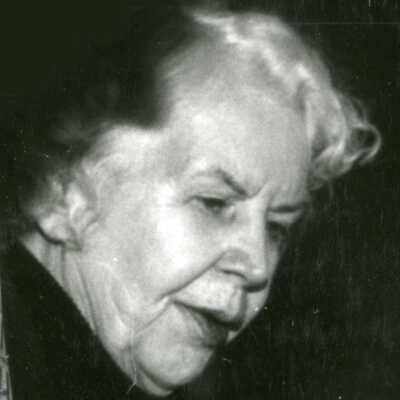
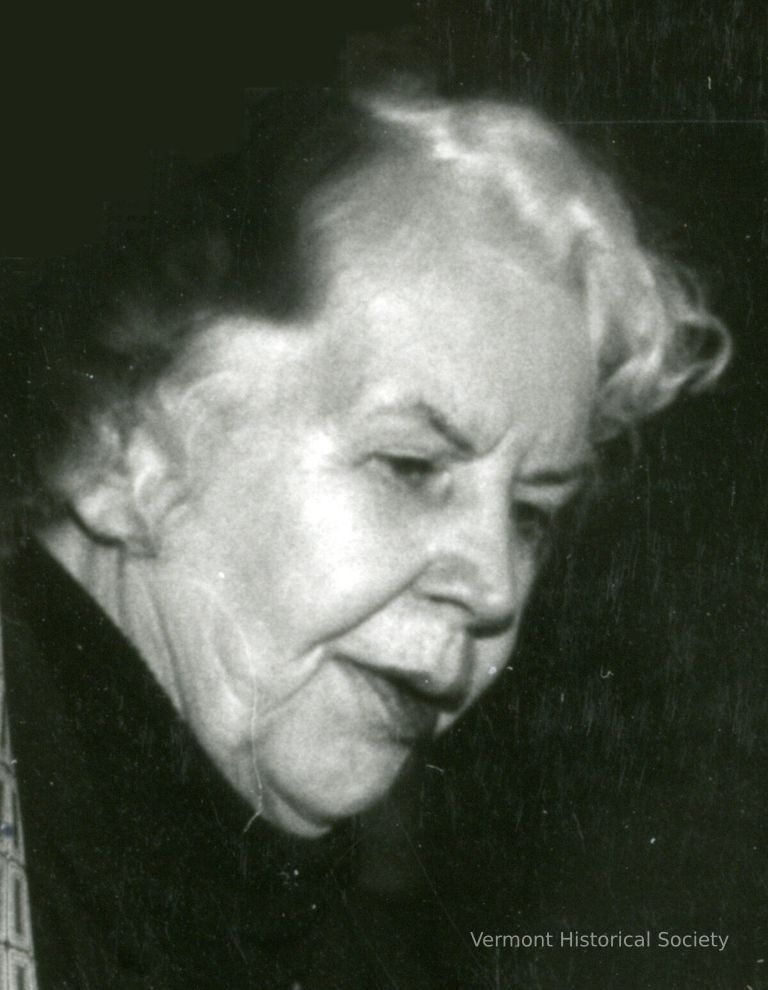
Mallory, Gertrude Robinson (1902-2002)
Name/Title
Mallory, Gertrude Robinson (1902-2002)
Description
Born: August 19, 1902 in Springfield, Massachusetts
Died: March 2, 2002 in Fairlee, Vermont
Primary Residence: Fairlee
Founder and editor of the New England Holstein Bulletin. Served in the Vermont State Legislature as both Representative (1953)and Senator(1955). Premier collector of Vermont manuscripts and histories.
Died: March 2, 2002 in Fairlee, Vermont
Primary Residence: Fairlee
Founder and editor of the New England Holstein Bulletin. Served in the Vermont State Legislature as both Representative (1953)and Senator(1955). Premier collector of Vermont manuscripts and histories.
Biographical Information
Education
Bennett Junior College, Millbrook, New York
University of Connecticut, graduate programs in genetics
Biography
Gertrude Robinson Mallary (1902-2002) was born August 19, 1902, in Springfield, Massachusetts, and attended Bennett Junior College, in Millbrook, New York. She married DeWitt Mallary September 15, 1923. After their decision to become serious farmers, she took a dairy herd management course at University of Connecticut.
With no farming background, Gertrude became a recognized authority on dairy cattle breeding. While she sought good advice and used it, she, in turn, advised many breeders throughout North America as evidenced by her voluminous correspondence.
Mrs. Mallary was active in many community, professional, and political organizations. A Republican, she served in the Vermont House of Representatives, 1953-1957, and in the Vermont Senate, 1957-58. Among other activities, she was president of the Vermont Holstein Club, secretary of the New England Holstein Breeders Association, and editor of the New England Holstein Bulletin. Mrs. Mallary was an avid collector of Vermont books and manuscripts. A bibliography of her collection, The Vermont Library of Gertrude Mallary, was published in 1989.
Occupation
Volunteer social worker
Holstein cattle breeder
Vermont state legislator
Entry/Object ID
1.1.57
Web Links and URLs
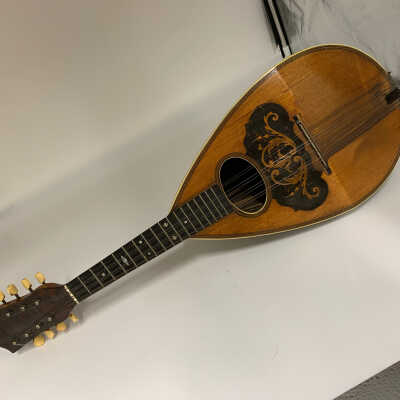
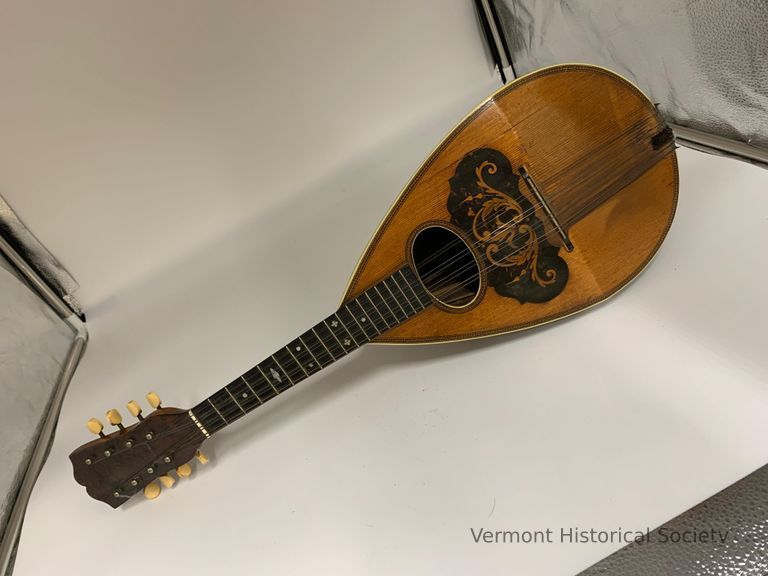
Mandolin
Name/Title
Mandolin
Lexicon
Description
Mandolin with 8 strings and decorative inlay. The instrument consists of a deep resonance box and lachryform harmonic cover over which the strings are stretched. The guard is inlaid with a decorative pattern of stylized floral scrollwork.
Acquisition
Accession
2020.13
Dimensions
Dimension Description
Overall
Materials
Material
Wood, Tortoiseshell, Metal
Entry/Object ID
2020.13.1
Context
Used by Alva Eastman, a member of the Barre, Vermont, Mandolin-Guitar Club, who regularly performed at the Barre Opera House
Web Links and URLs
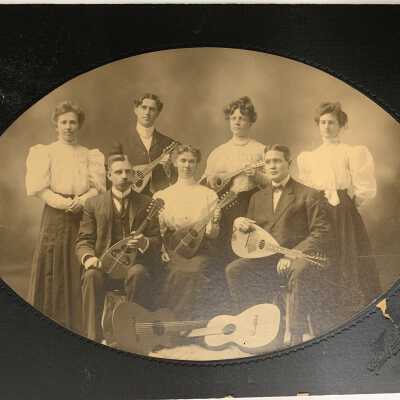
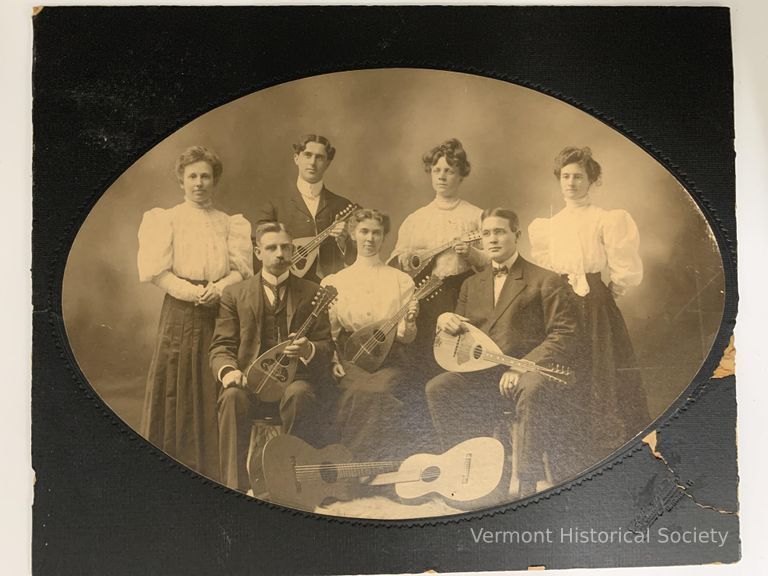
Mandolin-Guitar Club
Name/Title
Mandolin-Guitar Club
Photograph Details
Subject Person or Organization
Mandolin-Guitar Club
Lexicon
Description
Photograph showing 7 people with instruments. The image shows 4 women, each of whom are dressed in white, long-sleeved and high-collared blouses with dark-colored, gored skirts. The two central women are holding mandolins. The three men in the image are all shown wearing suits and holding mandolins. Two guitars rest on piece of fur in front of the group. The oval photograph is mounted on top of a black, paperboard mat with the impressed inscription, "C. Bau's Studio/BARRE, VT."
Inked on the back is the note: "Mandolin-Guitar Club/Ina Harrington Eastman (mother) - Dr. Steele - Mrs. Watt - and ?/Alvah W. Eastman (Father) - Mrs. Steele - Dr. Watt./Barre, Vermont 19-? (08?)"
Inked on the back is the note: "Mandolin-Guitar Club/Ina Harrington Eastman (mother) - Dr. Steele - Mrs. Watt - and ?/Alvah W. Eastman (Father) - Mrs. Steele - Dr. Watt./Barre, Vermont 19-? (08?)"
Acquisition
Accession
2020.13
Made/Created
Date made
circa 1900-circa 1910
Studio
C. Bau's Studio
Dimensions
Dimension Description
Overall
Entry/Object ID
2020.13.2
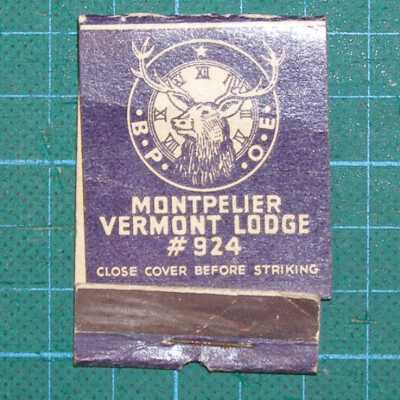
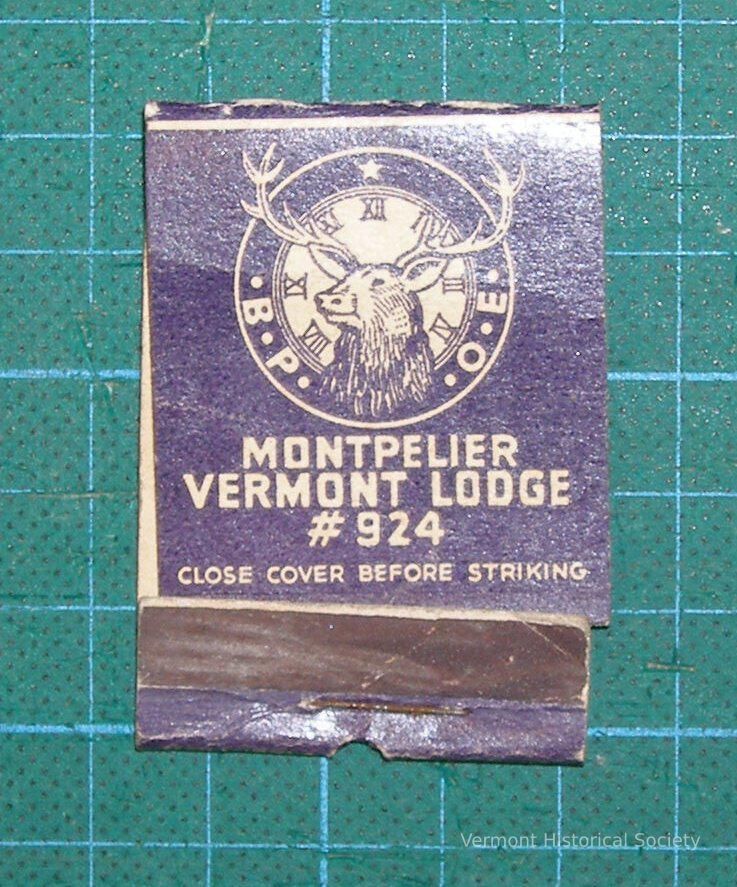
Matchbook
Name/Title
Matchbook
Lexicon
Description
Matchbook, purple with white lettering and graphics. On front cover, the Elks Club emblem and printed below, "MONTPELIER/ VERMONT LODGE/ #924" On back cover, a cartoon of an elk wrapped around a tree and below, "THAT'S FUNNY - I THOUGHT/ I KNEW EVERY ELK IN TOWN" Printed on fold at top, "B.P.O.E." Printed along bottom edge, "Lion Match Co., Made in U.S.A." Matches have been removed.
Acquisition
Accession
1991.19
Relationships
Related Person or Organization
Benevolent and Protective Order of Elks
Person or Organization
Related Places
Place
Montpelier
City
Washington County
County
Vermont
State/Province
United States of America
Country
North America
Dimensions
Materials
Material
Cardboard
Entry/Object ID
1991.19.14
Context
Produced for members of the Elk's Lodge in Montpelier, Vermont
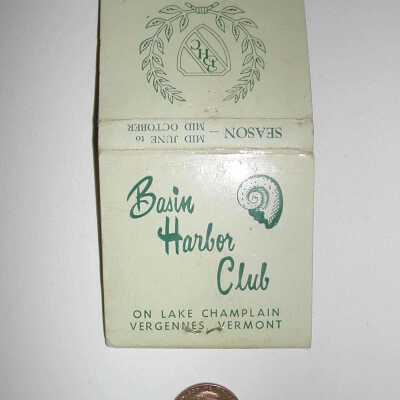
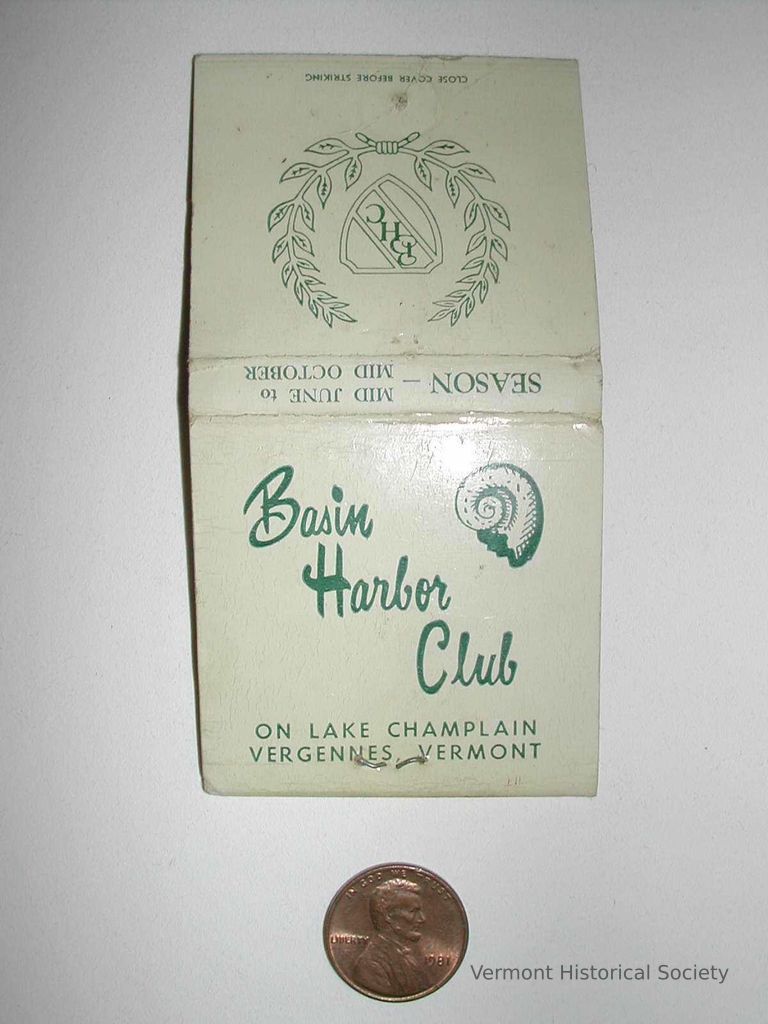
Matchbook
Name/Title
Matchbook
Lexicon
Description
This is an unused matchbook from Basin Harbor Club. On the front cover of the matchbook, there are two olive branches with a shield in the middle that reads "BHC". The outlines of the olive branches are in green. The back cover of the matchbook reads "Basin Harbor Club On Lake Champlain Vergennes, Vermont". In the upper right corner of the back cover, there is an outline of a spiral shell.
Inside the cover of the matchbook, the text is written in white on a dark green background. It reads "Basin Harbor Club On Lake Champlain P.O., Vergennes, Vermont TRinity 7-2961 For over 50 years, Vermont's most distinguished resort Accommodations for over 275 members and guests in main lodge and homestead, and 65 modern lake-side cottages All sports including private 18 hole golf course Plus active social program Famous for fine food Excellent facilities for business conferences and group meetings".
Inside the cover of the matchbook, the text is written in white on a dark green background. It reads "Basin Harbor Club On Lake Champlain P.O., Vergennes, Vermont TRinity 7-2961 For over 50 years, Vermont's most distinguished resort Accommodations for over 275 members and guests in main lodge and homestead, and 65 modern lake-side cottages All sports including private 18 hole golf course Plus active social program Famous for fine food Excellent facilities for business conferences and group meetings".
Acquisition
Accession
2004.64
Relationships
Related Person or Organization
Basin Harbor Club
Person or Organization
Related Places
Place
Vergennes
City
Addison County
County
Vermont
State/Province
United States of America
Country
North America
Made/Created
Date made
1955-1965
Dimensions
Dimension Description
Closed
Materials
Material
Paperboard
Entry/Object ID
2004.64.2
Context
Produced to advertise Basin Harbor Club in Vergennes, Vermont
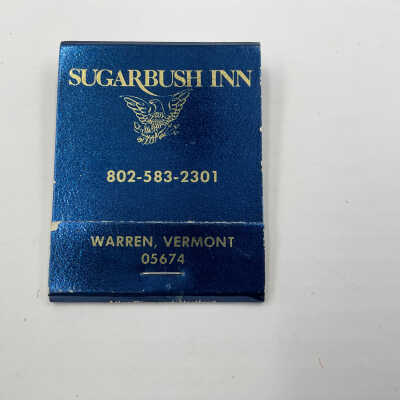
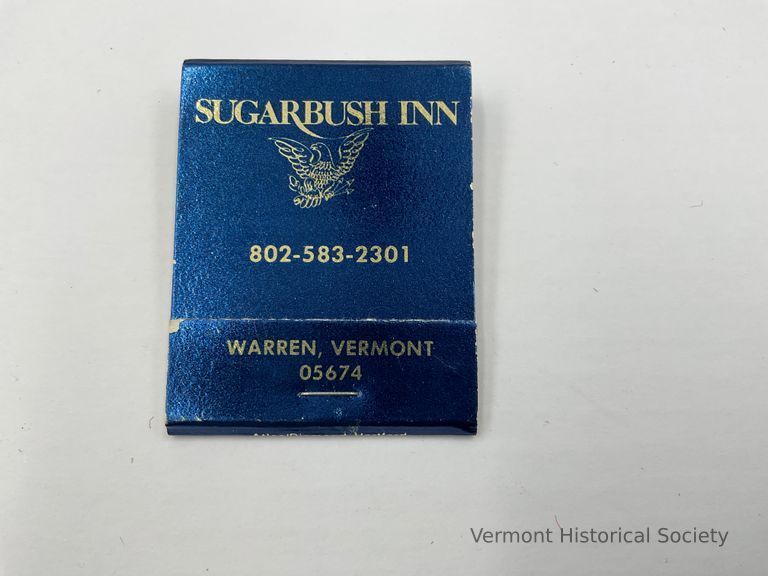
Matchbook
Name/Title
Matchbook
Lexicon
Description
A blue matchbook with gold lettering and an eagle logo on the front cover. Over the eagle is the name, "Sugarbush Inn," and under is the telephone number, 802-583-2301. At the bottom is a warning to "Be safe, Close cover before striking." On the back is an advertisement for a resort in Bermuda. The message says, "Lantana Colony Club at Somerset Bridge, Bermuda, 809-294-0141. Inside the matchbook cover are the offerings at "Club Sugarbush, excellent lodging & dining, luxury townhouses, ski touring center, 13 tennis courts, conference center, indoor/outdoor pools, 18 hole golf course. Young Family Management." The flap securing the light gray matches with blue tips lists the location, Warren, Vermont 05674. The manufacturer is listed as Atlas/Diamond, Hartford.
Acquisition
Accession
1992.10
Relationships
Related Person or Organization
Sugarbush Resort
Person or Organization
Related Places
,
Made/Created
Manufacturer
Atlas/Diamond
Dimensions
Materials
Material
Cardboard
Entry/Object ID
1992.10.24
Context
Produced as an advertisement for Sugarbush Inn in Warren, Vermont
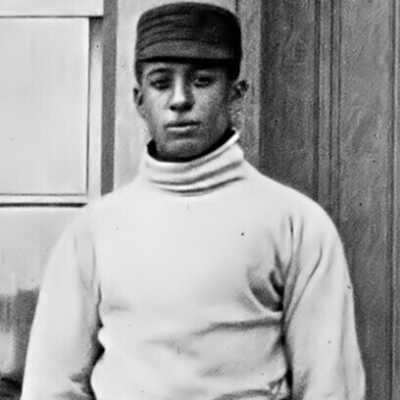
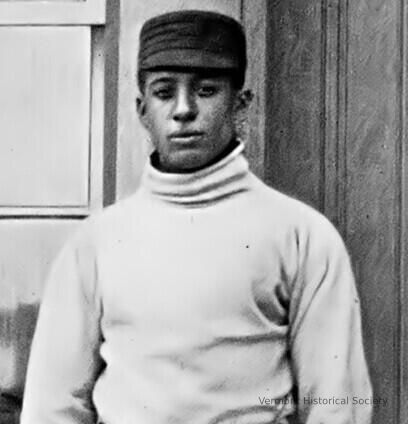
Matthews, William Clarence (1877-1928)
Name/Title
Matthews, William Clarence (1877-1928)
Description
Born: January 7, 1877 in Selma, Alabama
Died: April 9, 1928 in Washington, DC
On July 4, 1905, William Matthews started at second base for the Burlington Baseball Team of the Northern League. This assignment made him the only black player in all of professional baseball, with later historians calling him "the Jackie Robinson of his age." Matthews went on to a successful law career, eventually serving as an assistant U.S. Attorney General in the Coolidge administration.
Died: April 9, 1928 in Washington, DC
On July 4, 1905, William Matthews started at second base for the Burlington Baseball Team of the Northern League. This assignment made him the only black player in all of professional baseball, with later historians calling him "the Jackie Robinson of his age." Matthews went on to a successful law career, eventually serving as an assistant U.S. Attorney General in the Coolidge administration.
Biographical Information
Education
Tuskegee Institute
Philips Andover Academy
Harvard
Boston University Law School
Biography
William Clarence Matthews was born in Selma, Alabama and attended Tuskegee Institute under the direction of Booker T. Washington. Washington help Matthews gain admittance to Philips Andover Academy, where he was the only black student, and later Harvard University. At all three schools Matthews showed great skill at baseball, ultimately starting at short stop all four years at Harvard.
The summer after graduating Harvard, William Matthews was hired by the Burlington Baseball Club to be their starting second baseman in the Northern League. On July 4, 1905, he stepped onto the diamond at the old Burlington Athletic Field and broke the color barrier in professional baseball. He played the entire season and endured racism from fans and other players alike. When playing some teams, his manager had to move him to the outfield so that he wouldn't be intentionally spiked by white players sliding into second base. Players of southern background refused to take the field against him. During that summer, a rumor started that he would be hired to play for Boston's National League team, the Boston Beaneaters. This quickly ended when a number of southern teams stated they would refuse to play if he was hired.
That fall, Matthews left professional baseball to enroll at Boston University School of Law. He coached high school teams in Boston to put himself through school and ultimately passed the bar exam in 1908.
William Matthews served as the U.S. Attorney for Boston and the legal advisor to Marcus Garvey. When Calvin Coolidge ran for his first full-term as president, Matthews worked enthusiastically on his campaign. He was appointed an assistant attorney general and tried a number of high-profile cases before dying tragically of a perforated ulcer in 1928 at only 51 years old.
Occupation
Professional Baseball Player
Attorney
Entry/Object ID
1.2.23
Web Links and URLs
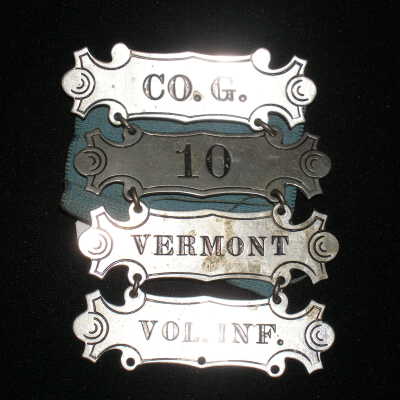
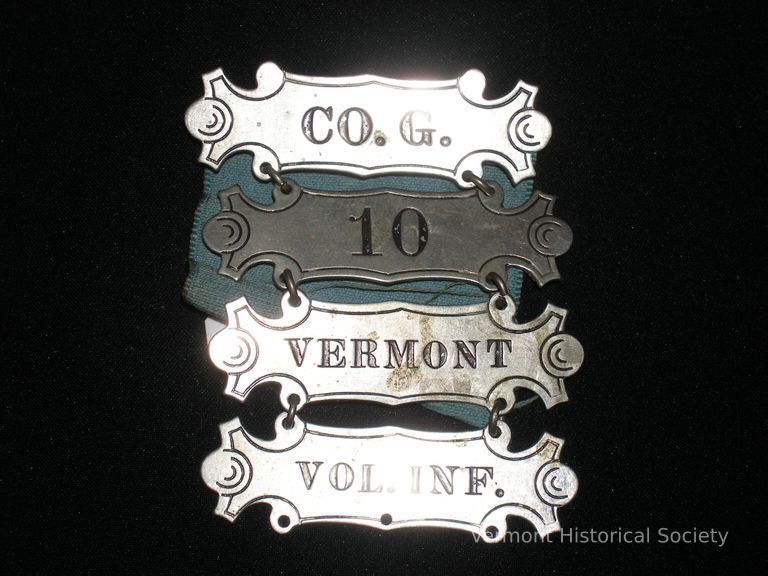
Membership Badge
Name/Title
Membership Badge
Lexicon
Description
Portion of a membership medal consisting of 4 metal plates attached at both ends with eye rings. The plates read, "CO. G / 10 / VERMONT / VOL. INF." from top to bottom.
Acquisition
Accession
1994.53
Relationships
Related Events
Civil War
Event
Related Person or Organization
Hall, Edwin C. (1845-1913), Grand Army of the Republic
Related Places
Place
Brookfield
Town
Orange County
County
Vermont
State/Province
United States of America
Country
North America
Dimensions
Dimension Description
Overall
Materials
Material
Metal, Silk
Entry/Object ID
1994.53.34
Context
Owned by Edwin C. Hall as a member of the Grand Army of the Republic (GAR), a fraternal club for veterans of the Union Army.
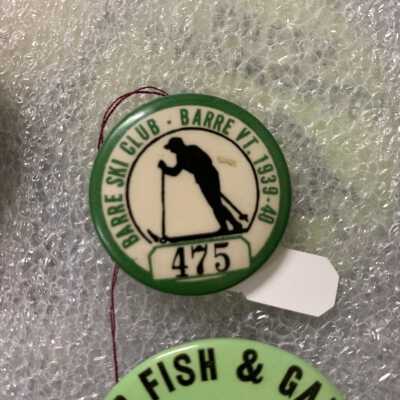
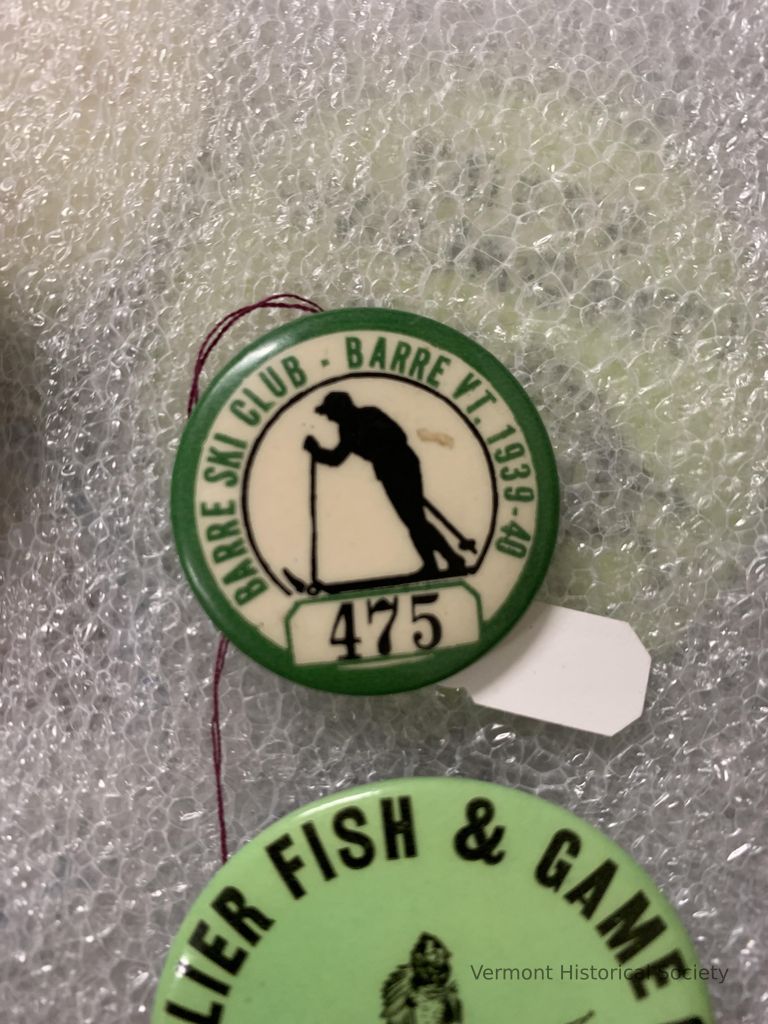
Membership Button
Name/Title
Membership Button
Description
Green and cream pin with a black silhouette of a skier in the center and the number 475 in a box at the bottom. Around the edge in green lettering are the words, "Barre Ski Club, Barre, Vt., 1939-40".
Acquisition
Accession
1992.87
Relationships
Related Person or Organization
Barre Ski Club
Person or Organization
Related Places
Place
Barre City
City
Washington County
County
Vermont
State/Province
United States of America
Country
North America
Made/Created
Date made
1939
Dimensions
Materials
Material
Metal
Entry/Object ID
1992.87.19
Context
Worn by either a member of the Barre Ski Club or show admission to The Skyline, operated by the ski club.
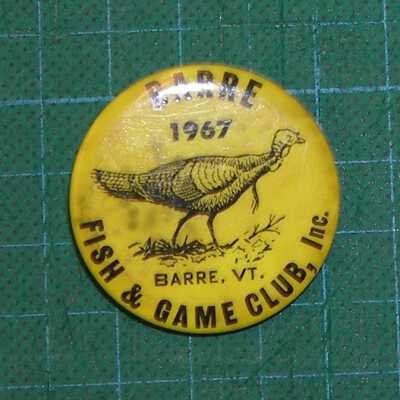
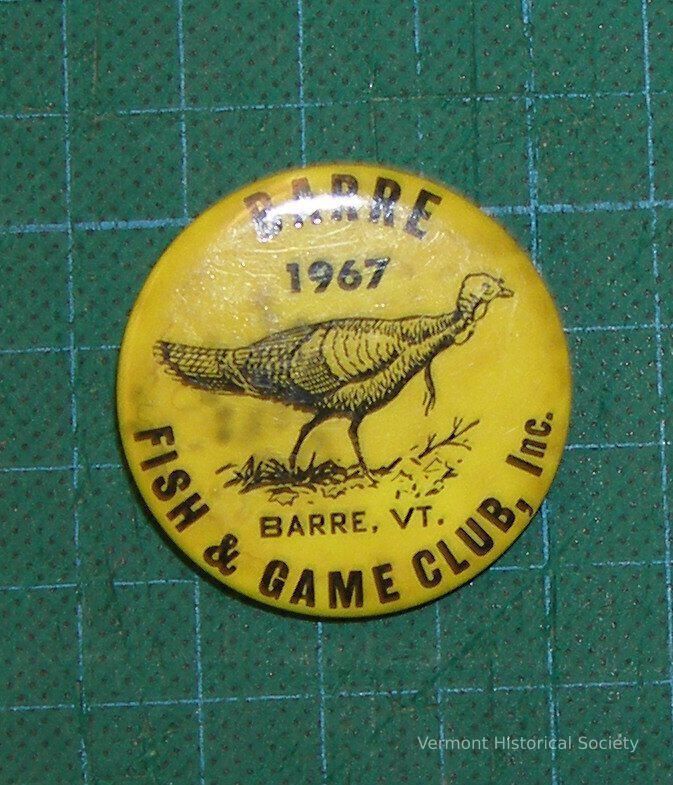
Membership Button
Name/Title
Membership Button
Lexicon
Description
Round yellow button printed in black with an image of a turkey and the inscription, "BARRE FISH & GAME CLUB, Inc." around the edge. The date 1967 is above the turkey, and the words, "BARRE, VT." are below the turkey. There is a pin on the reverse.
Acquisition
Accession
2011.68
Relationships
Related Person or Organization
Barre Fish & Game Club, Inc.
Person or Organization
Related Places
Place
Barre City
City
Washington County
County
Vermont
State/Province
United States of America
Country
North America
Made/Created
Date made
1967
Manufacturer
Russell Badge Manufacturing Company
Dimensions
Dimension Description
Overall
Materials
Material
Metal
Entry/Object ID
2011.68.10
Context
Worn by a member of the Barre Fish & Game Club, founded in 1919.

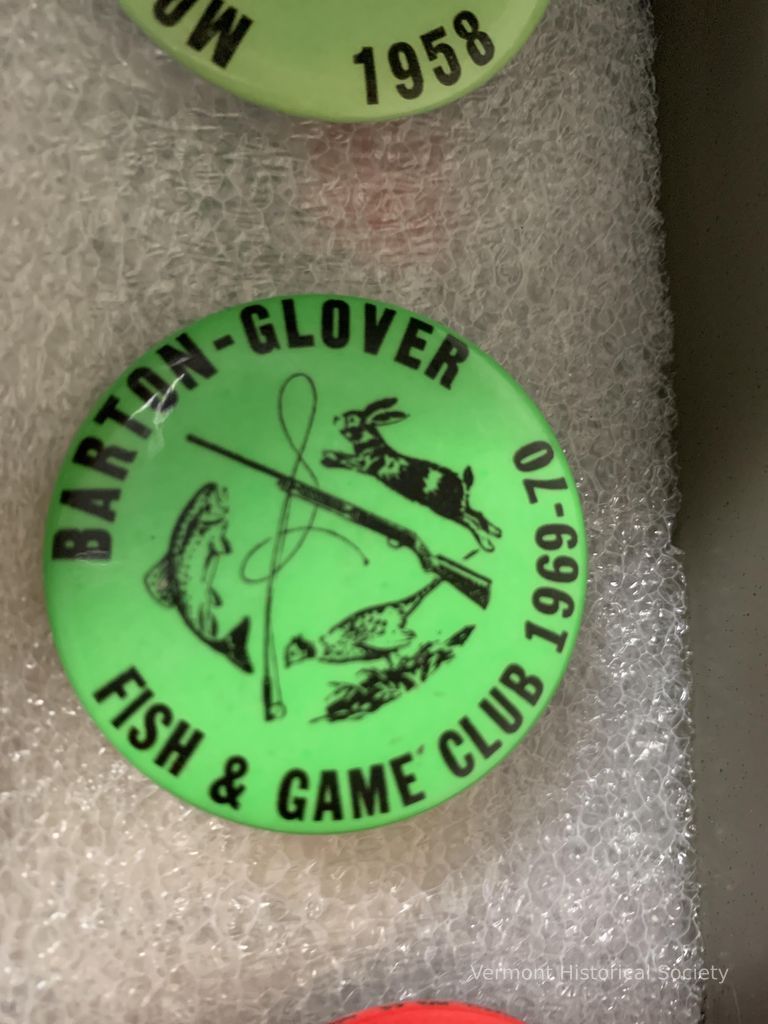
Membership Button
Name/Title
Membership Button
Description
Green pin with black lettering and pictures of a fish, rabbit, grouse, fishing rod and rifle. Around the outside are the word, "Barton-Glover Fish & Game Club 1969-70."
Acquisition
Accession
1992.87
Relationships
Related Person or Organization
Barton-Glover Fish & Game Club
Person or Organization
Related Places
,
Made/Created
Date made
1969
Dimensions
Materials
Material
Metal
Entry/Object ID
1992.87.20
Context
Worn by a member of the Barton-Glover Fish & Game Club
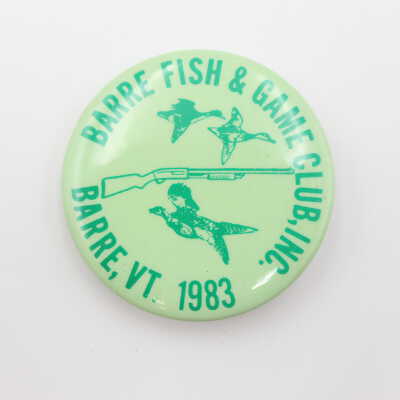
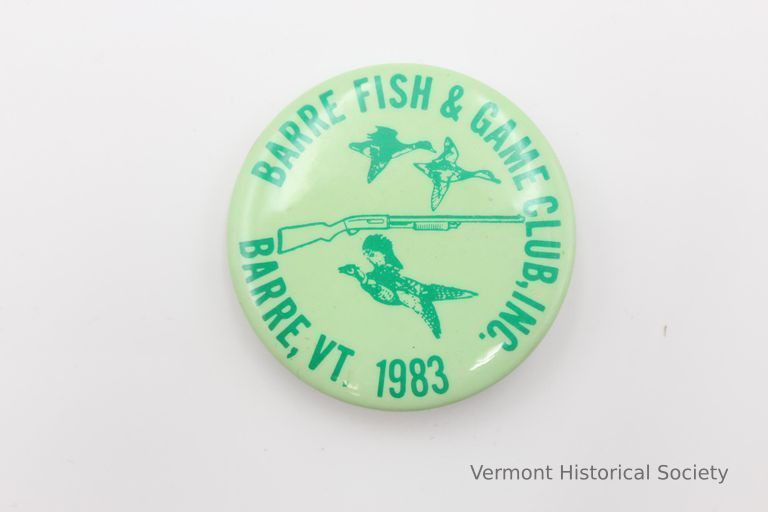
Membership Button
Name/Title
Membership Button
Lexicon
Description
Round, light green metal button with dark green printing. The inscription "BARRE FISH & GAME CLUB, INC./BARRE, VT. 1983" circles around the edge with an illustration of three ducks in flight and a hunting rifle.
Acquisition
Accession
2020.8
Relationships
Related Person or Organization
Barre Fish & Game Club, Inc.
Person or Organization
Related Places
Place
Barre City
City
Washington County
County
Vermont
State/Province
United States of America
Country
North America
Made/Created
Date made
1983
Materials
Material
Metal
Entry/Object ID
2020.8.5
Context
Worn by a member of the Barre Fish & Game Club of Barre, Vermont
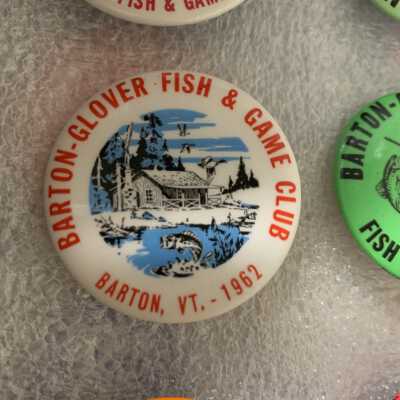
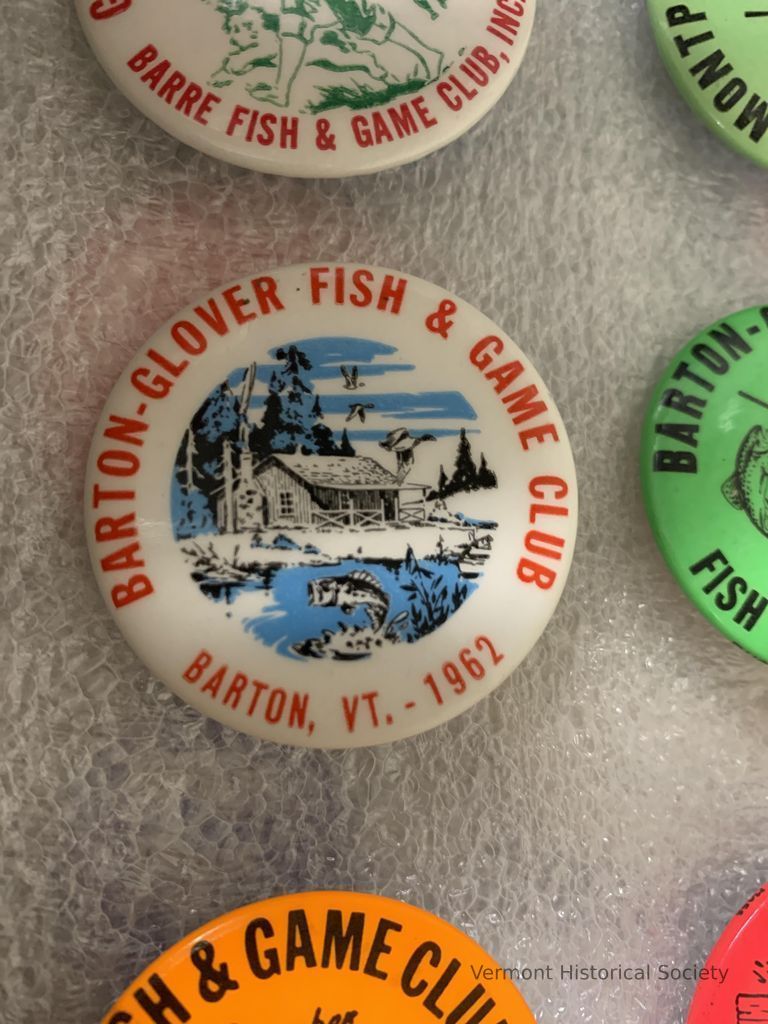
Membership Button
Name/Title
Membership Button
Description
A white pin with the blue and black image of a cabin in the woods on a pond with a fish jumping and geese flying overhead. Around the edge in red letters are the words, "Barton-Glover fish & Game Club, Barton, Vt. 1962."
Acquisition
Accession
1992.87
Relationships
Related Person or Organization
Barton-Glover Fish & Game Club
Person or Organization
Related Places
,
Dimensions
Materials
Material
Metal
Entry/Object ID
1992.87.21
Context
Worn by a member of the Barton-Glover Fish & Game Club
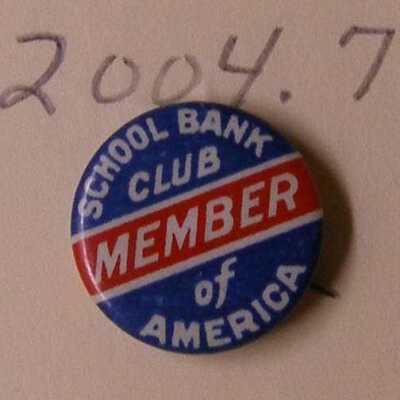
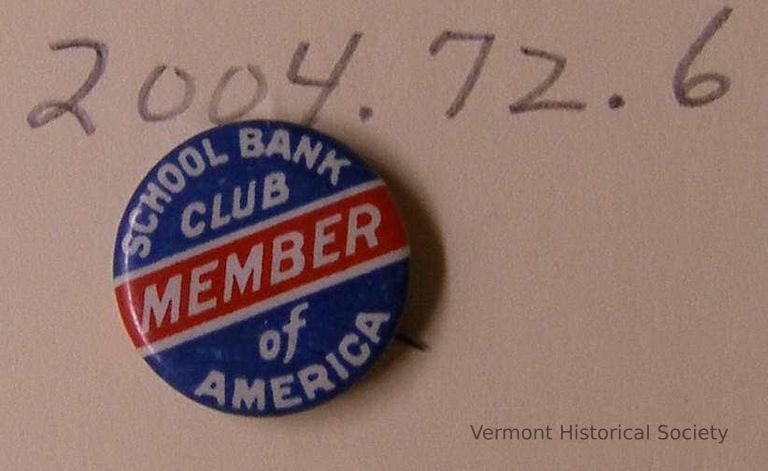
Membership Button
Name/Title
Membership Button
Lexicon
Description
Small blue pin: "School Bank Club of America" in white lettering and "MEMBER" printed across center on a red band. Maker information printed on paper insert in back: "The Whitehead & Hoag Co./ Buttons/ Badges/ Novelties/ and Signs/ Newark, N.J." Pin attached to back.
Acquisition
Accession
2004.72
Relationships
Related Person or Organization
School Bank Club of America
Person or Organization
Made/Created
Manufacturer
The Whitehead & Hoag Co.
Dimensions
Materials
Material
Metal, Paper
Entry/Object ID
2004.72.6
Context
No information was found about this organization or about which Vermont school was associated with this pin. It came from the estate of A. Fern Souther (1907-2004), who was born in Orleans, VT, grew up in Lowell, VT, was an elementary school teacher in Burlington, VT.


Membership Button
Name/Title
Membership Button
Lexicon
Description
Round green metal button with the inscription, "BARRE FISH & GAME CLUB, INC. BARRE, VERMONT" around the edge. The center is printed with a long gun crossing a fishing rod. In the spaces between (clockwise from top) are "Member 1955"; an image of a dog carrying a bird in its mount; an image of a deer with small antlers; an image of a man in a boat catching a large fish.
Acquisition
Accession
2013.27
Relationships
Related Person or Organization
Barre Fish & Game Club, Inc.
Person or Organization
Related Places
Place
Barre City
City
Washington County
County
Vermont
State/Province
United States of America
Country
North America
Made/Created
Date made
1955
Manufacturer
Universal Badge Company
Dimensions
Dimension Description
Overall
Materials
Material
Metal, Plastic
Entry/Object ID
2013.27.1
Context
The Barre Fish & Game Club, Inc. was founded in 1919 to promote recreational hunting, shooting, fishing, and wildlife conservation.
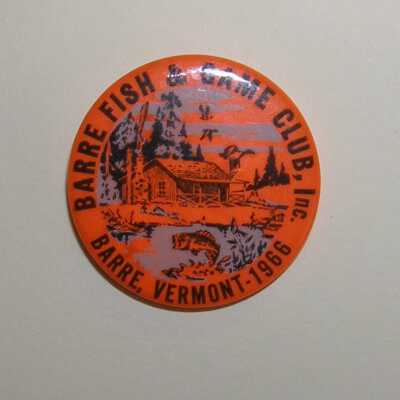
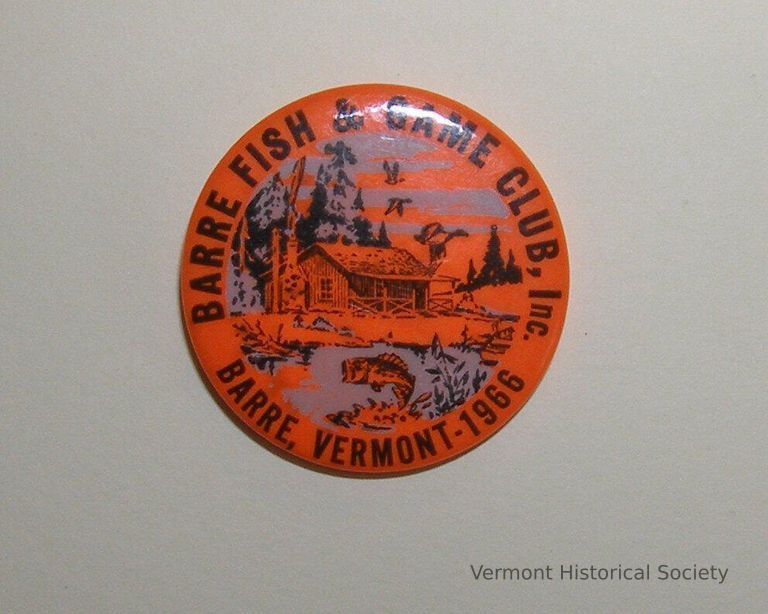
Membership Button
Name/Title
Membership Button
Lexicon
Description
Round orange metal button with the black inscription, "BARRE FISH & GAME CLUB, Inc. BARRE, VERMONT-1966" around the edge. The center is printed in black and grey with an illustration of a cabin beside a pond. Three geese are flying above the cabin and a fish is jumping from the pond.
Acquisition
Accession
2013.27
Relationships
Related Person or Organization
Barre Fish & Game Club, Inc.
Person or Organization
Related Places
Place
Barre City
City
Washington County
County
Vermont
State/Province
United States of America
Country
North America
Made/Created
Date made
1966
Manufacturer
Russell Badge Manufacturing Company
Dimensions
Dimension Description
Overall
Materials
Material
Plastic, Metal
Entry/Object ID
2013.27.3
Context
The Barre Fish & Game Club, Inc. was founded in 1919 to promote recreational hunting, shooting, fishing, and wildlife conservation.
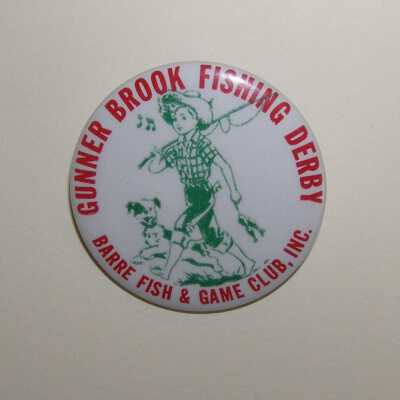
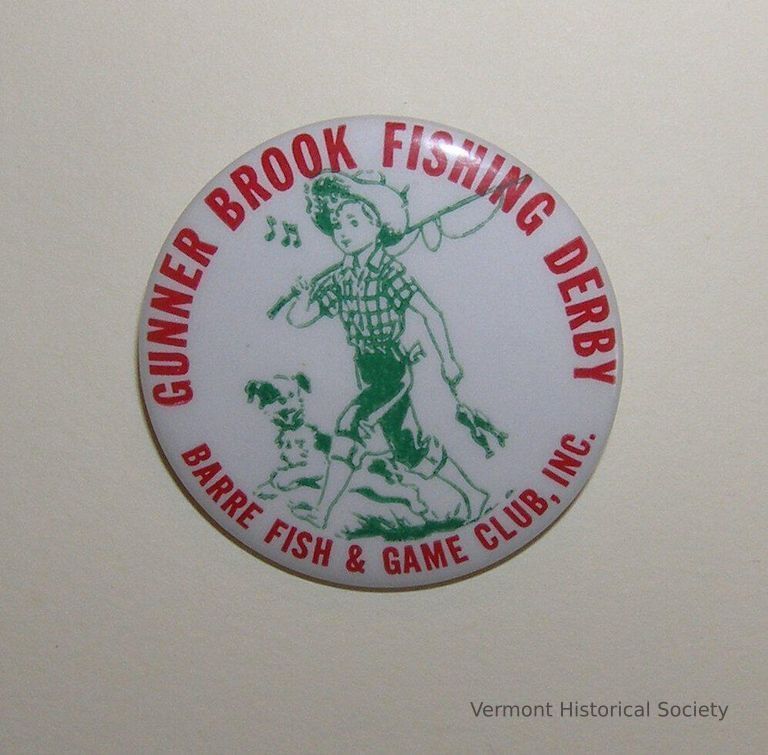
Membership Button
Name/Title
Membership Button
Lexicon
Description
Round white metal button with the red inscription, "GUNNER BROOK FISHING DERBY BARRE FISH & GAME CLUB, INC." around the edge. The center is printed in green with an image of a young boy and a puppy. The boy is wearing rolled up pants, a plaid collard shirt, and a straw hat. He is holding a fishing rod in one hand and string of fish in the other.
Use
by someone in donor's family
Acquisition
Accession
2013.27
Relationships
Related Person or Organization
Barre Fish & Game Club, Inc.
Person or Organization
Related Places
Place
Barre City
City
Washington County
County
Vermont
State/Province
United States of America
Country
North America
Made/Created
Date made
1950-1960
Dimensions
Dimension Description
Overall
Materials
Material
Plastic, Metal
Entry/Object ID
2013.27.4
Context
The Gunner Brook Fishing Derby was a fishing competition for children sponsored by the Barre Fish and Game Club.
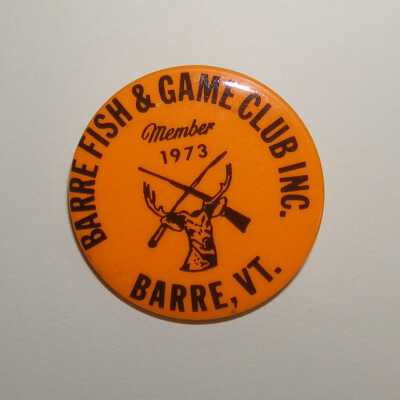
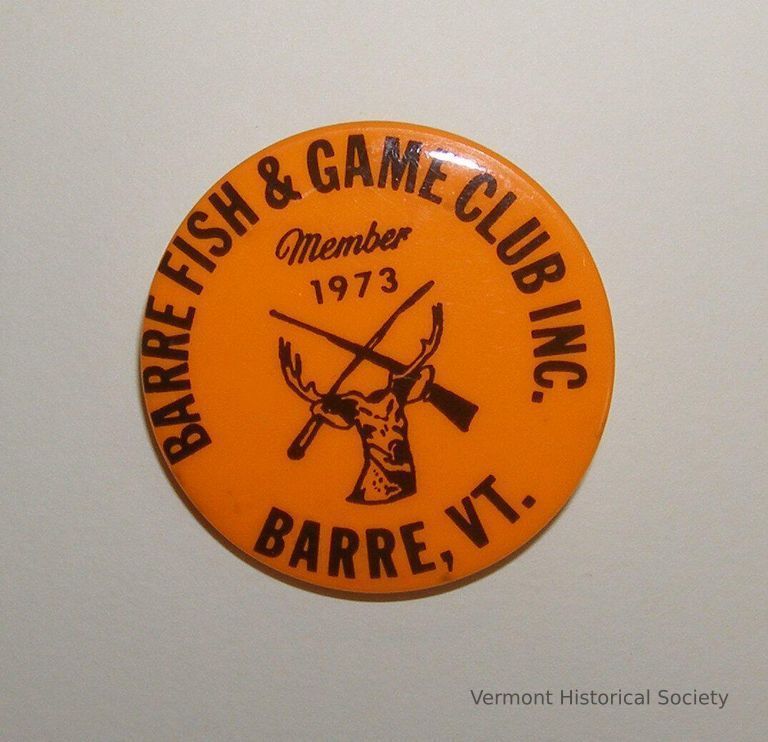
Membership Button
Name/Title
Membership Button
Lexicon
Description
Round orange metal button with the black inscription, "BARRE FISH & GAME CLUB INC. BARRE, VT." around the edge. The center is printed with an image of a stag's head in front of crossed long gun and fishing rod and the words, "Member 1973".
Acquisition
Accession
2013.27
Relationships
Related Person or Organization
Barre Fish & Game Club, Inc.
Person or Organization
Related Places
Place
Barre City
City
Washington County
County
Vermont
State/Province
United States of America
Country
North America
Made/Created
Date made
1973
Dimensions
Materials
Material
Plastic, Metal
Entry/Object ID
2013.27.5
Context
The Barre Fish & Game Club, Inc. was founded in 1919 to promote recreational hunting, shooting, fishing, and wildlife conservation.
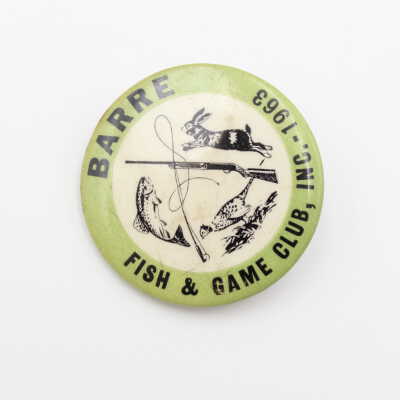
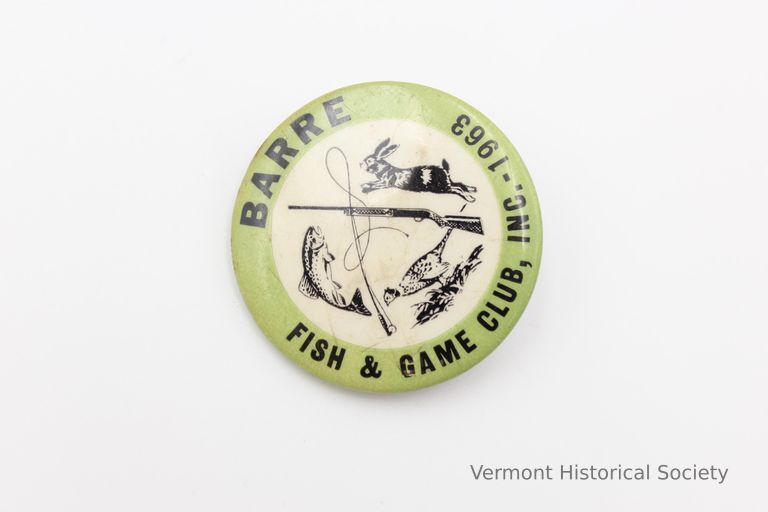
Membership Button
Name/Title
Membership Button
Lexicon
Description
Round metal button with green border that bears the inscription "BARRE / FISH & GAME CLUB, INC. - 1963" around the edge, and images of a fishing rod, a rifle, a quail, a rabbit, and a fish in the center.
Acquisition
Accession
2020.8
Relationships
Related Person or Organization
Barre Fish & Game Club, Inc.
Person or Organization
Related Places
Place
Barre City
City
Washington County
County
Vermont
State/Province
United States of America
Country
North America
Made/Created
Date made
1963
Materials
Material
Metal
Entry/Object ID
2020.8.7
Context
Worn by a member of the Barre Fish & Game Club of Barre, Vermont
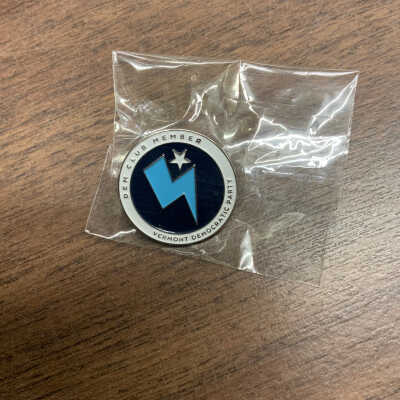
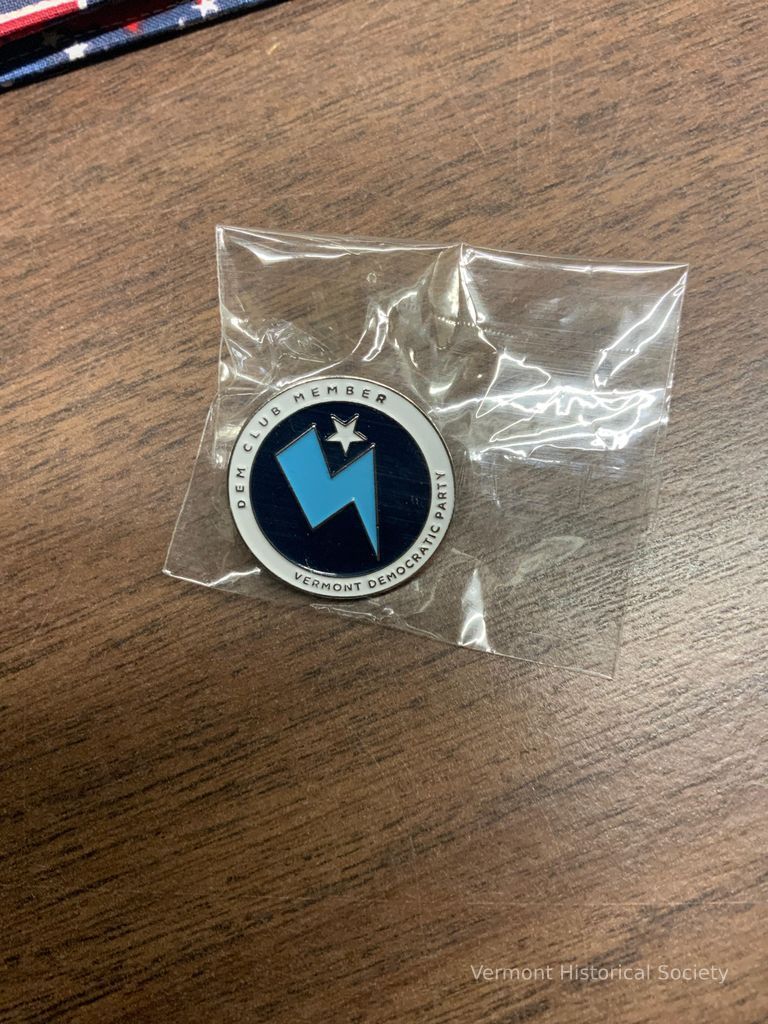
Membership Pin
Name/Title
Membership Pin
Lexicon
Description
Round, enameled pin with an image of a light-blue lightning bolt and white star on a blue ground. The inscription, "DEM CLUB MEMBER / VERMONT DEMOCRATIC PARTY", is molded into a narrow, white border.
Acquisition
Accession
2021.3
Relationships
Related Person or Organization
Vermont Democratic Party
Person or Organization
Made/Created
Date made
2020
Materials
Material
Metal, Enamel
Entry/Object ID
2021.3.6
Context
Given to members of the Vermont Democratic Party's monthly giving program, the DEM Club.
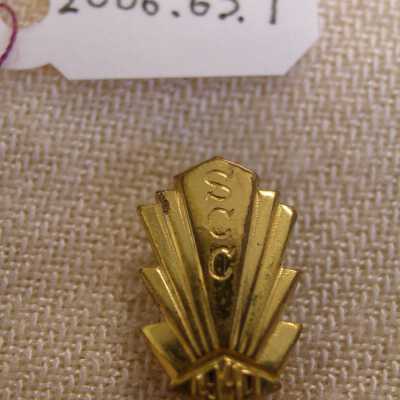

Membership Pin
Name/Title
Membership Pin
Lexicon
Description
Gold plated lapel pin in an art deco fan shape with the initials "SCC" vertically in the center. At the very bottom is the date 1940 within a diamond shape.
Acquisition
Accession
2006.65
Relationships
Related Person or Organization
Spaulding High School
Person or Organization
Related Places
Place
Barre City
City
Washington County
County
Vermont
State/Province
United States of America
Country
North America
Made/Created
Date made
1940
Dimensions
Dimension Description
Overall
Materials
Material
Gold
Entry/Object ID
2006.65.1
Context
Owned by Ado P. Tomat to indicate his membership in the Spaulding Commercial Club at Spaulding High School in Barre, Vermont, 1940
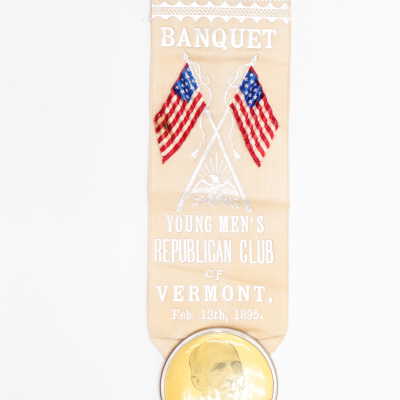
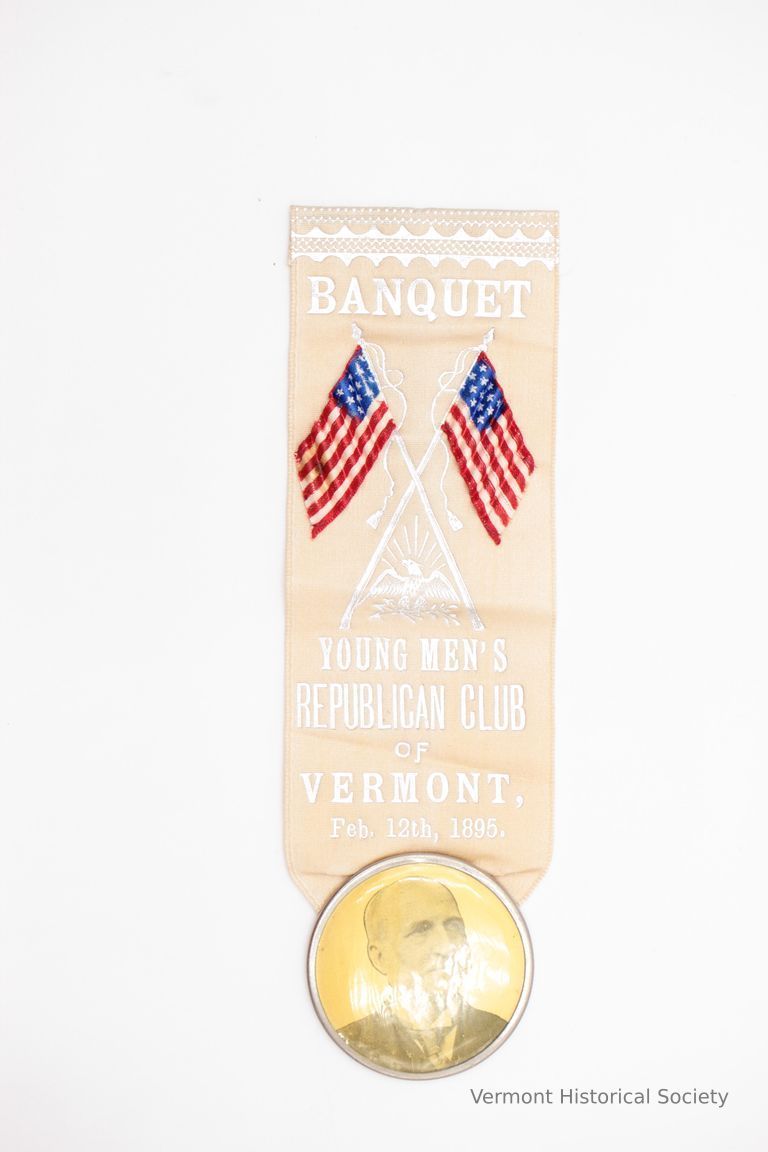
Membership Ribbon
Name/Title
Membership Ribbon
Lexicon
Description
Cream-colored satin-woven ribbon printed in silver with the inscription, "BANQUET / YOUNG MEN'S REPUBLICAN CLUB OF VERMONT, Feb. 12th, 1895." A design of two flag poles crossing over a spread eagle is printed at the center. Two small ribbons woven to look like small United States flags are appliqued onto the ribbon attached to the flag poles. They are appliqued with permanent wrinkles to look like they're waving in the wind. The top edge of the ribbon is folded down over a long stickpin. Attached to the bottom of the ribbon is a round medallion printed with a photograph of a bald man with sideburns (Chauncey M. Depew).
Acquisition
Accession
1962.12
Relationships
Related Person or Organization
Young Men's Republican Club of Vermont, Depew, Chauncey Mitchell (1834-1928)
Related Places
Place
St. Albans City
City
Franklin County
County
Vermont
State/Province
United States of America
Country
North America
Made/Created
Date made
1895
Manufacturer
The Whitehead & Hoag Co.
Materials
Material
Silk, Metal
Entry/Object ID
1962.12.1
Context
Worn to a member of the Young Men's Republican Club of Vermont's banquet. Chauncey Depew was the guest orator.
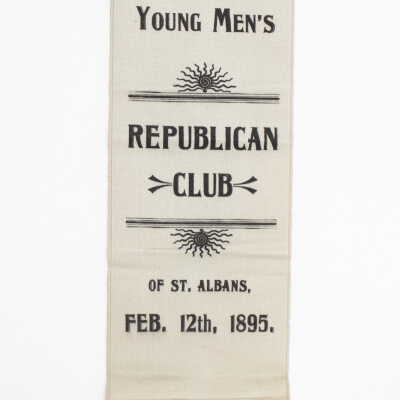
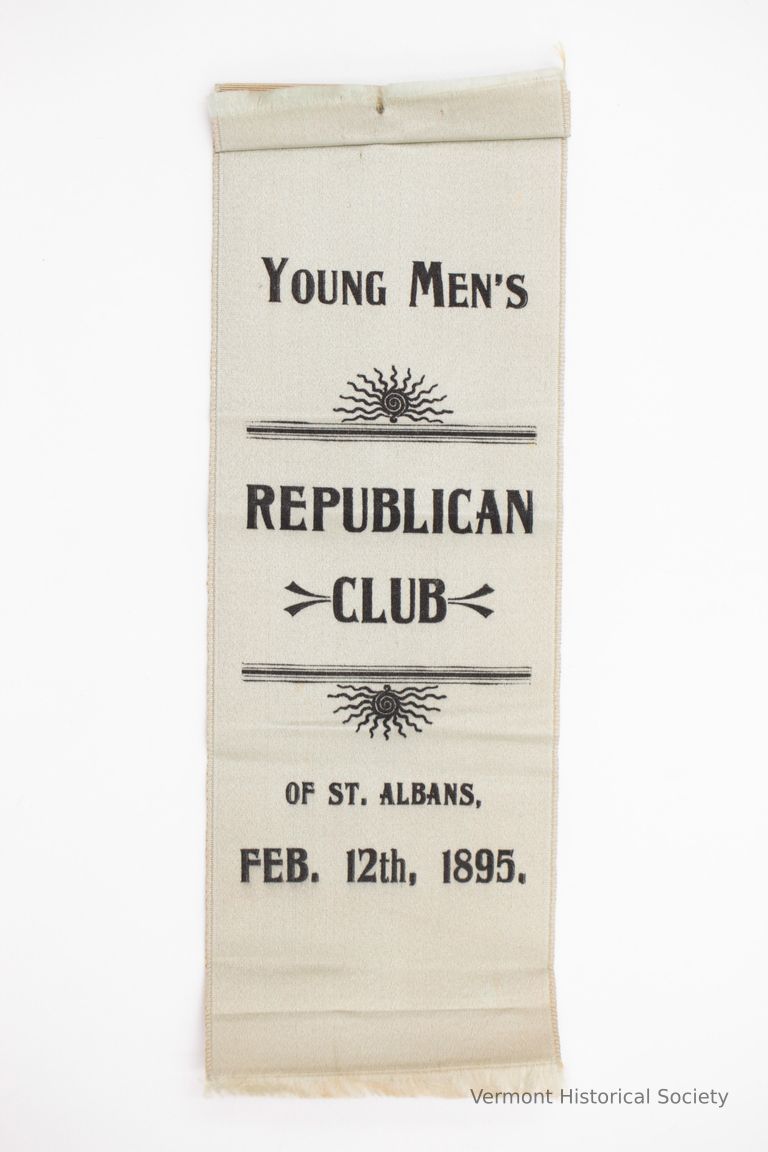
Membership Ribbon
Name/Title
Membership Ribbon
Lexicon
Description
Grey, satin-woven silk ribbon printed in black with the inscription, "Young Men's REPUBLICAN CLUB OF ST. ALBANS, FEB. 12th, 1895".
Acquisition
Accession
1962.12
Relationships
Related Person or Organization
Young Men's Republican Club of Vermont
Person or Organization
Related Places
Place
St. Albans City
City
Franklin County
County
Vermont
State/Province
United States of America
Country
North America
Made/Created
Date made
1895
Manufacturer
The Whitehead & Hoag Co.
Entry/Object ID
1962.12.2
Context
Worn by a member of the St. Alban's chapter of the Young Men's Republican Club of Vermont's to the 1895 banquet. Chauncey Depew was the guest orator.
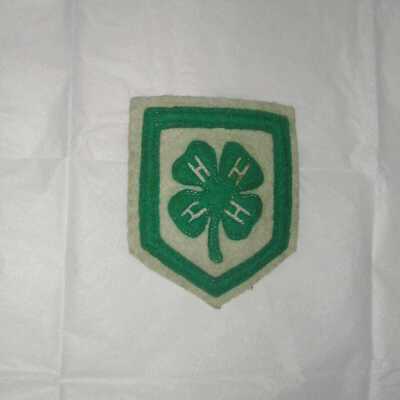
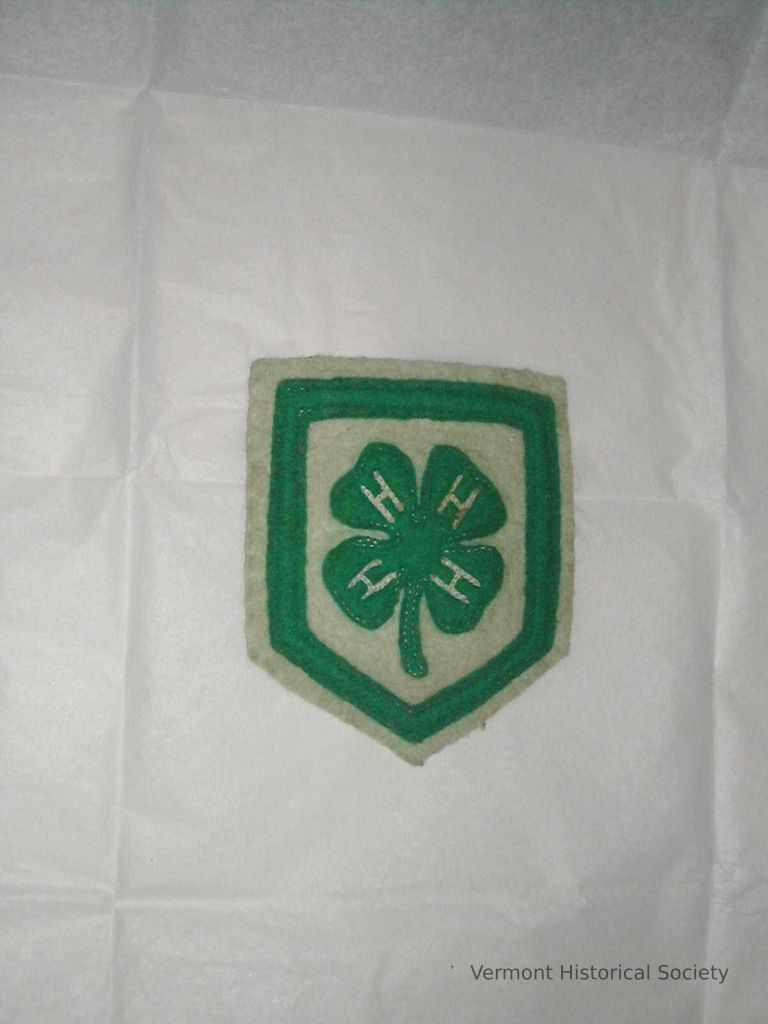
Merit Badge
Name/Title
Merit Badge
Lexicon
Description
Shield-shaped patch of white felt appliqued with green felt in a four-leaved clover design. The clover has the letter H in every petal (the logo for 4-H club).
Acquisition
Accession
1992.72
Relationships
Related Person or Organization
McCorison, Marcus A. (1926-2013)
Person or Organization
Related Places
Place
Camp Waubanong
Camp
Brattleboro
Town
Windham County
County
Vermont
State/Province
United States of America
Country
North America
Made/Created
Date made
circa 1935
Dimensions
Dimension Description
Overall
Materials
Material
Wool
Entry/Object ID
1992.72.3
Context
Awarded to Marcus A. McCorison at Camp Waupanong in Brattleboro, Vermont

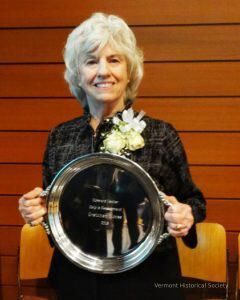
Morse, Gretchen (b. 1943)
Name/Title
Morse, Gretchen (b. 1943)
Description
Born: November 17, 1943 in Hyannis, Massachusetts
Primary Residence: Charlotte
Served as Secretary of the Vermont Agency of Human Services under Governor Madeleine Kunin. Representative to Vermont Legislature 1977-1985. Executive Director of the United Way of Chittenden County.
Primary Residence: Charlotte
Served as Secretary of the Vermont Agency of Human Services under Governor Madeleine Kunin. Representative to Vermont Legislature 1977-1985. Executive Director of the United Way of Chittenden County.
Biographical Information
Education
AA, Colby Junior College (1963)
BS, University of Vermont (1975)
Biography
Gretchen Morse served as Secretary of the Vermont Agency of Human Services under Governor Madeleine Kunin.
Morse was born in Hyannis, Massachusetts and graduated from Colby Junior College in 1963. She gained administrative experience with the Polaroid Corp in Cambridge, Massachusetts and the Museum of Science in Boston. After moving to Vermont in 1971, she received her B.S. in Human Development from the University of Vermont (1975). She served four terms in the Vermont State Legislature as a Representative from 1977-1985. Morse was Chair of the Health and Welfare Committee (1983-1985) and Chair of the Education Committee (1981-1983). In 1985, she was appointed the Secretary of the Vermont Agency of Human Services by Governor Madeleine Kunin. This agency oversees mental health, social welfare, public health, corrections, and rehabilitation services. Morse was the only Cabinet secretary to remain on board throughout all of Governor Kunin's three term administration. In 1991, she became the Executive Director of the United Way of Chittenden County.
Morse has been a member of the Vermont Commission on Women, the Governor's Commission on Children and Youth, the Juvenile Justice Delinquency Prevention Advisory Group and the National Council of State Human Services Administrators. She serves on the Board of Directors of the Lake Champlain Regional Chamber of Commerce, the Board of Vermont Health Foundation, the Wake Robin Board of Directors and is a member of the Burlington Rotary Club. Morse received the Distinguished Service Award from the University of Vermont College of Education and Social Services in 1983.
Occupation
Politician
Executive
Entry/Object ID
1.1.125
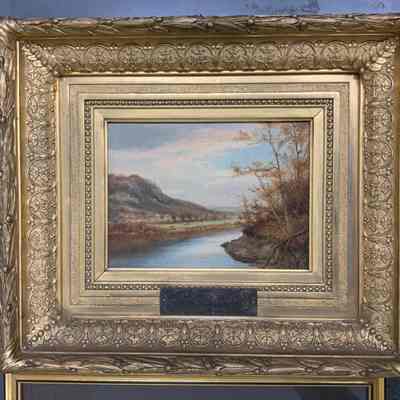
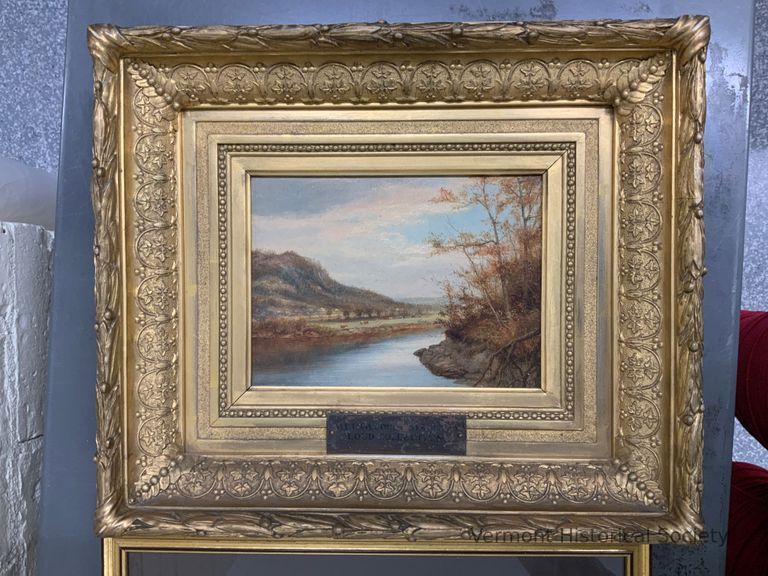
Mount Tom
Name/Title
Mount Tom
Type of Painting
Lexicon
Description
Oil on canvas painting of Mount Tom by Charles Franklin Pierce. The painting features a blue sky with wisps of darkened clouds that lighten as they pass over the peak towards the river. The landscape shows a fall scene, with scattered orange and brown leaves on the trees and a pale green field on the far bank of the river. The painting is set into a carved gilt gesso frame.
Acquisition
Accession
2024.6
Relationships
Related Person or Organization
Pierce, Charles Franklin (1844-1920)
Person or Organization
Artwork Details
Medium
Oil on Canvas
Subject
Mount Tom
Made/Created
Artist Information
Charles Franklin Pierce
Artist
Dimensions
Entry/Object ID
2024.6.3
Context
Charles Franklin Pierce was born on April 26th, 1844 in Sharon, New Hampshire to John A. and Phila W. Pierce. He was the third of six children who were raised in the nearby rural community of Peterborough. His early years were spent working on the family farm where the pastoral environment and a multitude of livestock made a deep impression on the future artist. Many of the works of art he would create later on in his life would stem from his familiarity with the farming way of life in the mid 1800s. Cows were one of his favorite subjects.
In the early 1860s his creative energies started to emerge and the drudgery of farm work was certainly no outlet for them, so in 1864 he decided to move to Boston to attend art school. Over the next few years he developed his skills at school and in the latter 1860s took his sketchbooks and went to England, Scotland and Wales to sketch the countryside there. This was his first of two prolonged stays in Europe during his lifetime and he honed his craft through his acute attention to detail.
The Early 1870s found Pierce back in Boston where he was a leader in the Boston Art Club and as the country celebrated the centennial of its founding, Pierce married his first wife Luena Wilder of Peterborough who was also an artist of note. They both returned to Europe in the late 1870s and sketched and painted and toured for over a year. They continued to paint both European and New England scenes in a Boston studio and at an estate in Peterborough and after 30 years of marriage Luena died in 1906.
Pierce continued to paint and draw and in 1912, he married Sarah Katherine Plimpton of Massachusetts. They lived on his estate in Peterborough and in Brookline Massachusetts where he died in 1920 on March 5th. In his studio upon his death were found numerous unfinished canvases, which attest to his liveliness right up to his final breath at the age of 67.
In the early 1860s his creative energies started to emerge and the drudgery of farm work was certainly no outlet for them, so in 1864 he decided to move to Boston to attend art school. Over the next few years he developed his skills at school and in the latter 1860s took his sketchbooks and went to England, Scotland and Wales to sketch the countryside there. This was his first of two prolonged stays in Europe during his lifetime and he honed his craft through his acute attention to detail.
The Early 1870s found Pierce back in Boston where he was a leader in the Boston Art Club and as the country celebrated the centennial of its founding, Pierce married his first wife Luena Wilder of Peterborough who was also an artist of note. They both returned to Europe in the late 1870s and sketched and painted and toured for over a year. They continued to paint both European and New England scenes in a Boston studio and at an estate in Peterborough and after 30 years of marriage Luena died in 1906.
Pierce continued to paint and draw and in 1912, he married Sarah Katherine Plimpton of Massachusetts. They lived on his estate in Peterborough and in Brookline Massachusetts where he died in 1920 on March 5th. In his studio upon his death were found numerous unfinished canvases, which attest to his liveliness right up to his final breath at the age of 67.
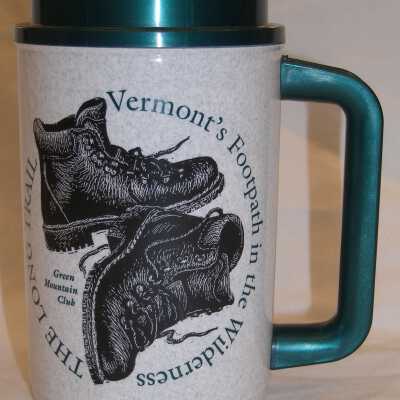
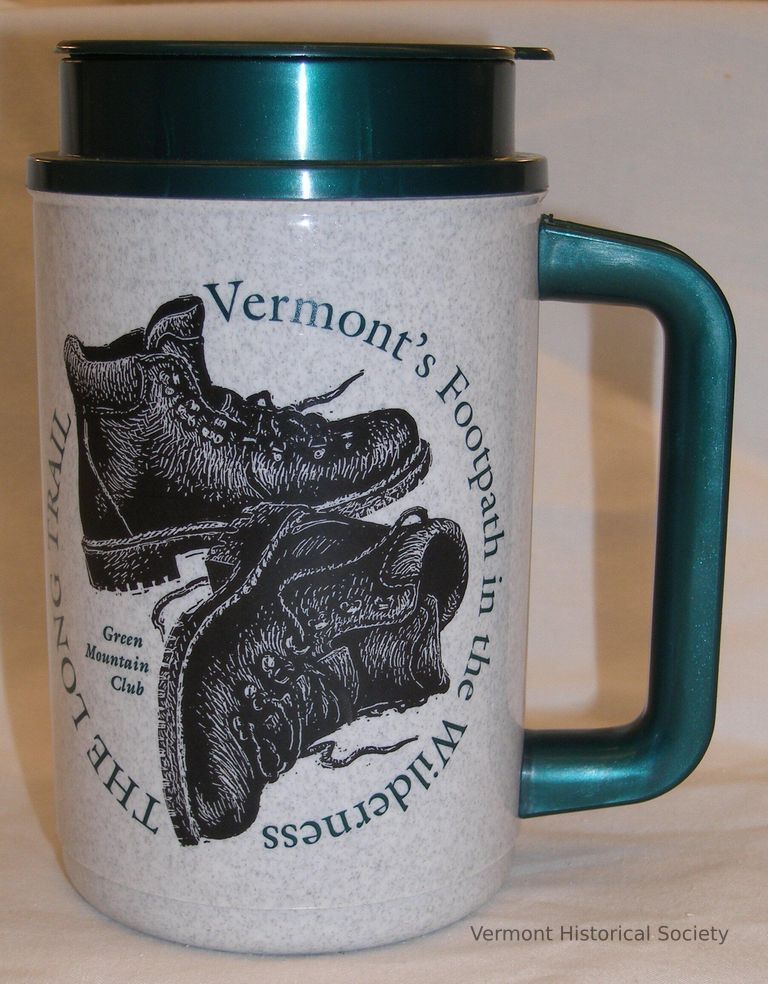
Mug
Name/Title
Mug
Lexicon
Description
A cylindrical, insulated travel mug with a cover that snaps on. Gray mug with dark green top, lid/cover and handle. Two sides of the mug have the following images: side 1) pair of hiking boots with writing surrounding "THE LONG TRAIL Vermont's Footpath in the Wilderness" with a much smaller "Green Mountain Club" side 2) "The Green Mountain Club/ Founder and Protector of the Long Trail Since 1910" / "Vermont's Long Trail---445 Miles of/ Backcountry Adventures!/ (a vertical map showing the trail thru VT.)/ The Green Mountain Club/ Route 100. Waterbury Center, Vt. 05677.(802)244-7037"
gray/dark green/black
gray/dark green/black
Acquisition
Accession
2001.5
Relationships
Related Person or Organization
Green Mountain Club
Person or Organization
Related Places
Place
Long Trail
* Untyped Place
Vermont
State/Province
United States of America
Country
North America
Made/Created
Date made
1999
Manufacturer
Whirley
Materials
Material
Plastic
Entry/Object ID
2001.5.1a-b

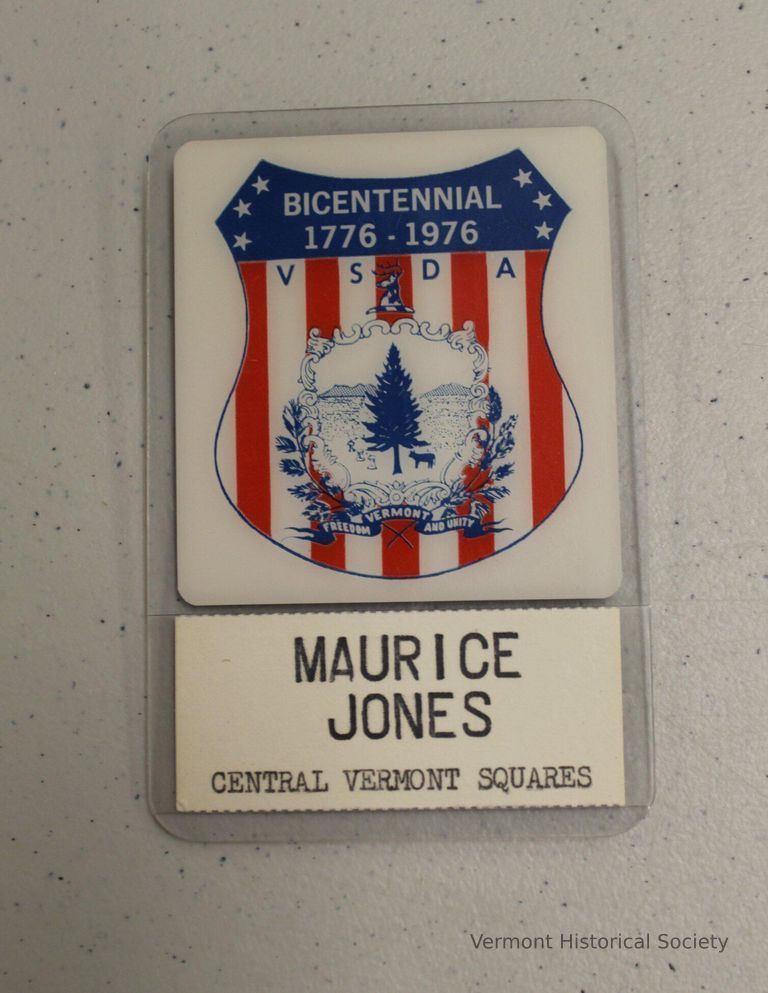
Nametag
Name/Title
Nametag
Lexicon
Description
Nametag encased in plastic holder. The nametag is in two parts: a piece bearing a logo, and a smaller piece with perforated edges printed with the name, "MAURICE JONES" and the group, "CENTRAL VERMONT SQUARE". The logo, printed onto the top portion, is in the shape of a shield that is blue at the top and red-and-white striped on the bottom. The Vermont state seal is printed onto the striped portion of the shield, and the inscription, "BICENTENNIAL 1776 - 1976 V S D A" is at the top. There is a safety pin back at the center top on the reverse, and the maker's label, "Wester Plastic Products / 1701 Magnolia Avenue P.O. Box 1429 / Long Beach, Calif. 90801 (213) 435-4881 / Patent No. 2.364.870."
Acquisition
Accession
2016.17
Relationships
Related Events
US Bicentennial Celebration
Event
Related Person or Organization
Jones, Maurice Taylor (1922-2016), Central Vermont Squares, Inc., Vermont Square Dancing Association
Related Places
Place
Montpelier
City
Washington County
County
Vermont
State/Province
United States of America
Country
North America
Made/Created
Date made
1976
Manufacturer
Western Plastic Products
Dimensions
Dimension Description
Overall
Materials
Material
Plastic, Metal, Paper
Entry/Object ID
2016.17.5
Context
Worn by Maurice Jones while attending a square dance in celebration of the 200th anniversary of the American Revolutionary War.
About Maurice T. Jones from his obituary in the Times Argus (link at https://www.timesargus.com/obituaries/maurice-t-jones/article_740cc173-1a2a-5fd2-a555-9e1865a30b3f.html
"BARRE TOWN — Maurice Taylor Jones, 93, of Osborne Road, died Tuesday, Jan. 19, 2016, at the Central Vermont Medical Center in Berlin with his family at his side. He was admitted Friday, Jan. 15. He was very independent and had remained comfortable in his home until that time.
Born May 25, 1922, in Northfield Falls, he was the son of Ward and Ella (Calef) Jones. He attended Lincoln Elementary School in Barre and graduated from Spaulding High School in 1940.
On Sept. 25, 1949, he married the love of his life, Jean Newton, of Moretown, in the Barre Congregational Church. Following their marriage they made their home in St. Johnsbury, West Burke, Montpelier and, since 1957, at their present residence where they joined the “Jones Compound.” Jean died Aug. 9, 2013.
In 1946, he began employment with the New England Telegraph and Telephone Company in Bellows Falls as a lineman. He moved to St. Johnsbury and worked as central office repairman and remained with the company, retiring as district manager in the Montpelier office in 1981.
Maurice enjoyed gardening, especially raising asparagus, blueberries, raspberries and apples, both cross-country and downhill skiing, fishing, square dancing, and was very instrumental in building the home that he and Jean lived in. He was also interested in genealogy and the history of Northfield. One of the maps that he worked on is in the library.
As a veteran of World War II, he served as a radio and advanced radar technician in the Army Air Corps in Boca Raton, Florida, Wisconsin, and Illinois from 1943 to 1946. He was discharged as a sergeant.
His memberships included the Barre Congregational Church, Barre American Legion Post #10, the Telephone Pioneers of America and the “251” Club.
Maurice is survived by three nieces: Nancy Audet and her husband, Alonzo, of Milan, Ohio, Jody Jones, of Newark, Delaware, and Elizabeth Jones, of Burlington; and his nephew, Christopher Jones and his wife, Stephanie, of Granville, Vermont; and numerous other nieces and nephews.
Besides his parents and his wife, Jean, he was predeceased by his brother, Loren Jones, and his sister, Lorene Jones Armstrong."
About Maurice T. Jones from his obituary in the Times Argus (link at https://www.timesargus.com/obituaries/maurice-t-jones/article_740cc173-1a2a-5fd2-a555-9e1865a30b3f.html
"BARRE TOWN — Maurice Taylor Jones, 93, of Osborne Road, died Tuesday, Jan. 19, 2016, at the Central Vermont Medical Center in Berlin with his family at his side. He was admitted Friday, Jan. 15. He was very independent and had remained comfortable in his home until that time.
Born May 25, 1922, in Northfield Falls, he was the son of Ward and Ella (Calef) Jones. He attended Lincoln Elementary School in Barre and graduated from Spaulding High School in 1940.
On Sept. 25, 1949, he married the love of his life, Jean Newton, of Moretown, in the Barre Congregational Church. Following their marriage they made their home in St. Johnsbury, West Burke, Montpelier and, since 1957, at their present residence where they joined the “Jones Compound.” Jean died Aug. 9, 2013.
In 1946, he began employment with the New England Telegraph and Telephone Company in Bellows Falls as a lineman. He moved to St. Johnsbury and worked as central office repairman and remained with the company, retiring as district manager in the Montpelier office in 1981.
Maurice enjoyed gardening, especially raising asparagus, blueberries, raspberries and apples, both cross-country and downhill skiing, fishing, square dancing, and was very instrumental in building the home that he and Jean lived in. He was also interested in genealogy and the history of Northfield. One of the maps that he worked on is in the library.
As a veteran of World War II, he served as a radio and advanced radar technician in the Army Air Corps in Boca Raton, Florida, Wisconsin, and Illinois from 1943 to 1946. He was discharged as a sergeant.
His memberships included the Barre Congregational Church, Barre American Legion Post #10, the Telephone Pioneers of America and the “251” Club.
Maurice is survived by three nieces: Nancy Audet and her husband, Alonzo, of Milan, Ohio, Jody Jones, of Newark, Delaware, and Elizabeth Jones, of Burlington; and his nephew, Christopher Jones and his wife, Stephanie, of Granville, Vermont; and numerous other nieces and nephews.
Besides his parents and his wife, Jean, he was predeceased by his brother, Loren Jones, and his sister, Lorene Jones Armstrong."
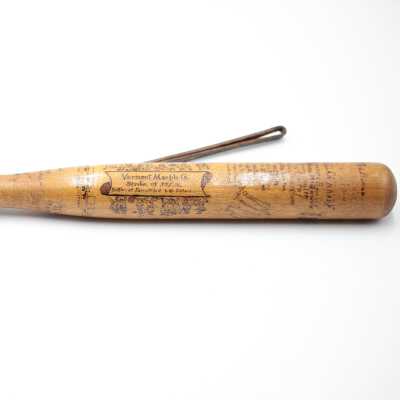
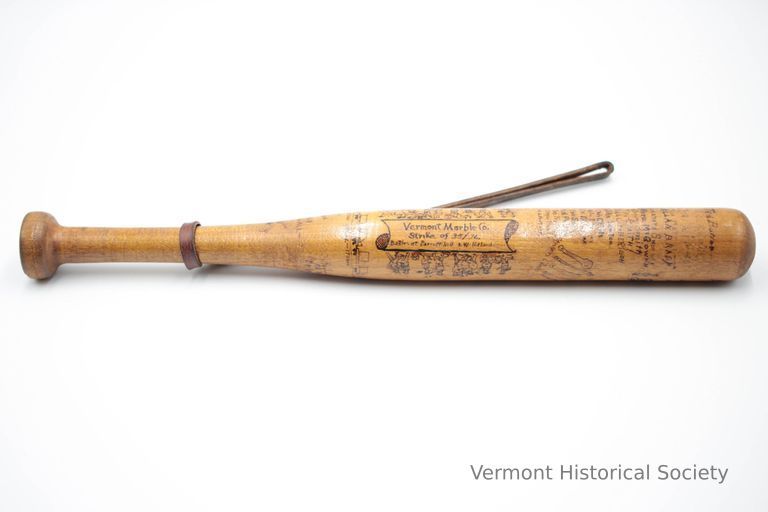
Nightstick
Interpretative Labels
Label
Watchman’s Club, 1935-1936
Harry L. Hall (1878-1956)
West Rutland, Vermont
Burned wood
Gift of William Hall, #2018.19
The lengthy and violent Vermont Marble strike of 1935 and 1936 gained national attention and, though the strikers gained no concessions, led to federal labor legislation. Harry Hall served as a night watchman at the West Rutland facility during the time of the strike. He vividly documented the strike on his “billy club” with a woodburning tool. Imagery shows bridges dynamited, strikers beaten, trains derailed, and the leader of the company and strikers depicted as a pig and rat respectively. A summary of the strike can be found near the handle of the club and reads, “power lines blasted, RR track blasted, bridge blasted, windows stoned, property damaged, street fights, heads cracked, a good time had by all.”
Name/Title
Nightstick
Lexicon
Description
Wooden nightstick decoratively burnt with scenes from the 1935-36 strike at the Vermont Marble Company. Decorations include the initials "HLH", and the label "Vermont Marble Co./Strike of 35/36/Battles at Barrett Hill N. W. Rutland" inside a scroll with scenes of rioting and violence above and beneath. The club shows trains and bridges being dynamited, participants from various factions beating each other, illustrations of the types of clubs used, a man mourning at a large headstone, a detailed drawing a muscular man beating an elderly man, a pig with a man's head, and a man smoking a pipe and looking through a hand-held telescope. There is a list of names of the participants of the strike from both sides, and a summary of events: "power lines blasted/RR track blasted/bridge blasted/windows stoned/property damaged/street fights/heads cracked/a good time had by all".
There is a leather strap around the stick.
There is a leather strap around the stick.
Acquisition
Accession
2018.19
Relationships
Related Person or Organization
Vermont Marble Company, Hall, Harry L. (1878-1956)
Related Places
Place
Proctor
Town
Rutland County
County
Vermont
State/Province
United States of America
Country
North America
Made/Created
Date made
1935-1936
Manufacturer
Hall, Harry L. (1878-1956)
Dimensions
Dimension Description
Overall
Materials
Material
Wood, Leather
Entry/Object ID
2018.19
Context
Owned and embellished by Harry L. Hall (1878-1956), night watchman for Vermont Marble Company during the 1935-1936 strike. He decorated the nightstick with events from the strike.

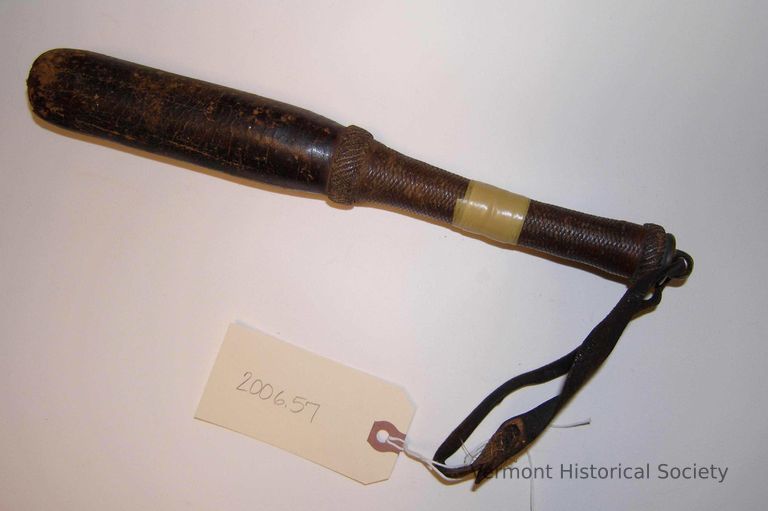
Nightstick
Interpretative Labels
Label
The club was owned by Suel Taylor Howard of Danby. He enlisted in December 1863 during the Civil War. Howard served as a Private with Company E of the U.S. Sharpshooters until July 1968.
Name/Title
Nightstick
Lexicon
Description
Nightstick, or billy club. The club is made of turned wood covered in leather. The weapon side of the club is wider than the handle side, and the leather covering the handle side is braided. The end has a brass fitting to which a leather strap is attached. There is a mend of brown tape on the handle.
Acquisition
Accession
2006.57
Relationships
Related Events
Civil War
Event
Related Person or Organization
Howard, Suel Taylor (1829-1899)
Person or Organization
Related Places
Place
Andover
Town
Windsor County
County
Vermont
State/Province
United States of America
Country
North America
Made/Created
Date made
1862
Dimensions
Dimension Description
Overall
Materials
Material
Leather, Brass, Wood
Entry/Object ID
2006.57
Context
Used during the Civil War by Suel Taylor Howard of Andover, Vermont
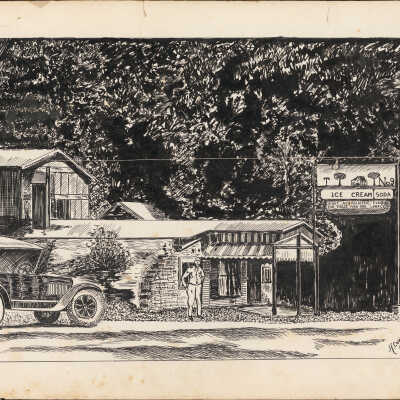
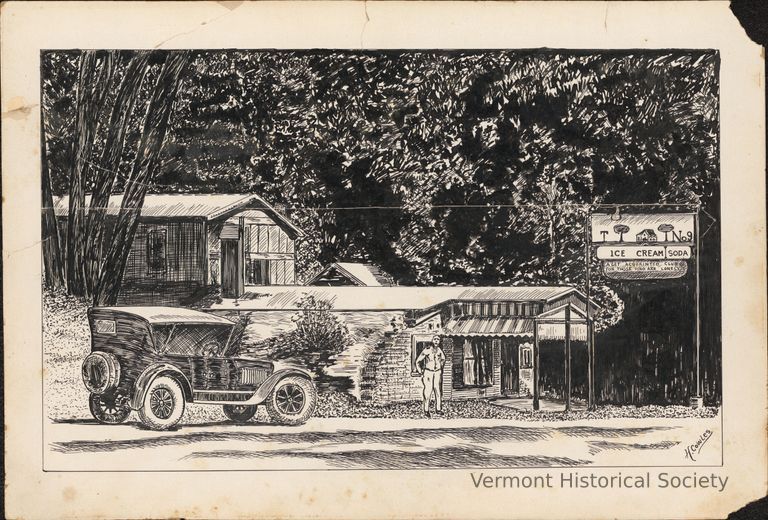
No. 9 Lonely Hearts Club
Name/Title
No. 9 Lonely Hearts Club
Lexicon
Description
Pin and ink drawing showing a man standing in front of a commercial building near a car. The car is a Model T. The building appears to be built into a hillside with a brick or stone facade. There is an awning extending from the center front over a door and window. A sign by the building shows a house between two trees above the inscription, "ICE CREAM SODA / A GET ACQUAINTED CLUB FOR THOSE WHO ARE LONELY". There is another building behind and above the first, the front door of which appears to open onto the roof of the first building. Another peaked roof is visible behind the first building. The background is covered by thick foliage. The drawing is signed in the lower right corner, "H. Cowles".
Acquisition
Accession
1984.11
Relationships
Related Person or Organization
Smith, Dana H. (1858-1936)
Person or Organization
Artwork Details
Medium
Ink
Subject
Shows Dug Out #9 in South Barre, Vermont, owned by Dug Out Dan (Dana H. Smith)
Made/Created
Artist Information
Cowles, H.
Artist
Date made
Sep 1922
Dimensions
Dimension Description
Overall
Entry/Object ID
1984.11.8
Type of Drawing
Web Links and URLs

Olzendam, Lilian Herrick (1868-1958)
Name/Title
Olzendam, Lilian Herrick (1868-1958)
Description
Born: November 7, 1868 in Woodstock, Vermont
Death: July 22, 1958 in Tacoma, Washington
Primary Residence: Woodstock, Vermont and New York, New York
An advocate of woman suffrage, Lilian H. Olzendam was most notable for leading Vermont’s campaign to ratify the 19th Amendment. In addition to gaining support from legislators, prominent state and national politicians, and newspaper editors throughout the state, she organized the “March of 400” women to the Vermont State House to urge anti-suffrage governor, Percival W. Clement, to call a special session of the legislature.
Death: July 22, 1958 in Tacoma, Washington
Primary Residence: Woodstock, Vermont and New York, New York
An advocate of woman suffrage, Lilian H. Olzendam was most notable for leading Vermont’s campaign to ratify the 19th Amendment. In addition to gaining support from legislators, prominent state and national politicians, and newspaper editors throughout the state, she organized the “March of 400” women to the Vermont State House to urge anti-suffrage governor, Percival W. Clement, to call a special session of the legislature.
Biographical Information
Biography
Lilian Herrick Marble was the twelfth and youngest child of Elizabeth Woodard and Liberty Bates Marble, a successful mill owner in Woodstock. Lilian graduated from Woodstock High School, studied music in Boston, and became an accomplished pianist. She taught music before her marriage to clothing manufacturer Louis Herman Olzendam, a graduate of Massachusetts Institute of Technology. At the turn of the century, the couple moved to New York City, where Louis worked in the textile business, and the couple raised two children, Roderic M. and Therese E. Olzendam.
In the mid-1910s Lilian and her daughter Therese became involved in the woman suffrage movement. Therese, who had learned typesetting and press operation in Woodstock, became circulation manager at The Suffragist, the newspaper of the National Woman’s Party in Washington, D.C. Returning to Woodstock in mid-1917, Lilian became an officer of the Vermont Equal Suffrage Association (VESA) and president of the Woodstock Suffrage Club in 1918. The National American Woman Suffrage Association (NAWSA) hired her as an organizer for Vermont, and she attended the association’s conference in St. Louis in 1919 to report on the state’s progress.
The same year VESA leaders appointed Olzendam to lead the campaign to ratify the 19th Amendment. She successfully gathered petitions from women and enough pledges from Vermont legislators to support suffrage and a special legislative session to ratify the amendment, which would make Vermont the “Perfect 36” or final state needed for ratification. In the process, she took a historic auto tour with Marion Stone Pelley to visit every newspaper editor and as many politicians as she could locate to sign a petition urging Governor Percival W. Clement to call legislators into session. When he continued to resist, Olzendam organized a mass protest of suffragists at the State House to speak with him. Traveling through snow and sleet, women in the “March of 400,” otherwise known as the “Green Mountain Girls,” participated in the state’s largest political protest to date. Despite this effort and the intervention of national Republican leaders, Clement refused, claiming that ratification required a statewide referendum as per the Vermont Constitution. After Tennessee became the final ratifying state and women had voted in the 1920 election, Vermont legislators finally approved the amendment in 1921.
In September 1920, Olzendam helped organize the League of Women Voters of Vermont and was elected its first chair. That fall she also campaigned for the Republican Party, attended the state convention, and was elected a Presidential elector. In the 1921 legislative session, she advanced women’s reforms and wrote a special report for newly elected Governor James Hartness on conditions for women at Windsor Prison, urging their removal from the institution. Noted for her prominence as a woman in Vermont politics, Olzendam retreated from public life in the summer of 1921.
During this period, Olzendam was separated from her husband and lived in Woodstock and Burlington. In 1924, she wrote a musical score for “Song of Vermont,” published in Boston with lyrics originally written as a poem by Justice Wendell Phillips Stafford. During the 1930s, Olzendam spent winters in New York City, where she boarded at the American Woman’s Club. She returned to Woodstock regularly to visit her large family and purchased her own residence in the 1940s. Her daughter, Therese, worked for the advertising firm, J. Walter Thompson Co., in New York City until 1951, and her son, Roderic, a writer in his
youth, settled in Tacoma, Washington, where Lilian died at the age of 89 in 1958.
Occupation
Musician, Suffragist
Entry/Object ID
1.1.149
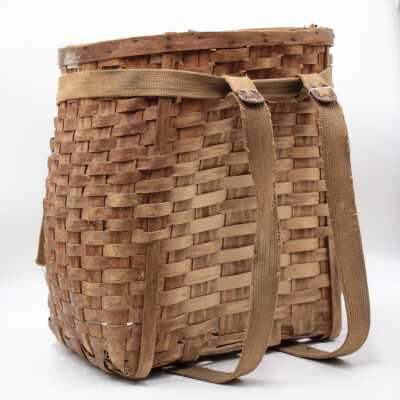
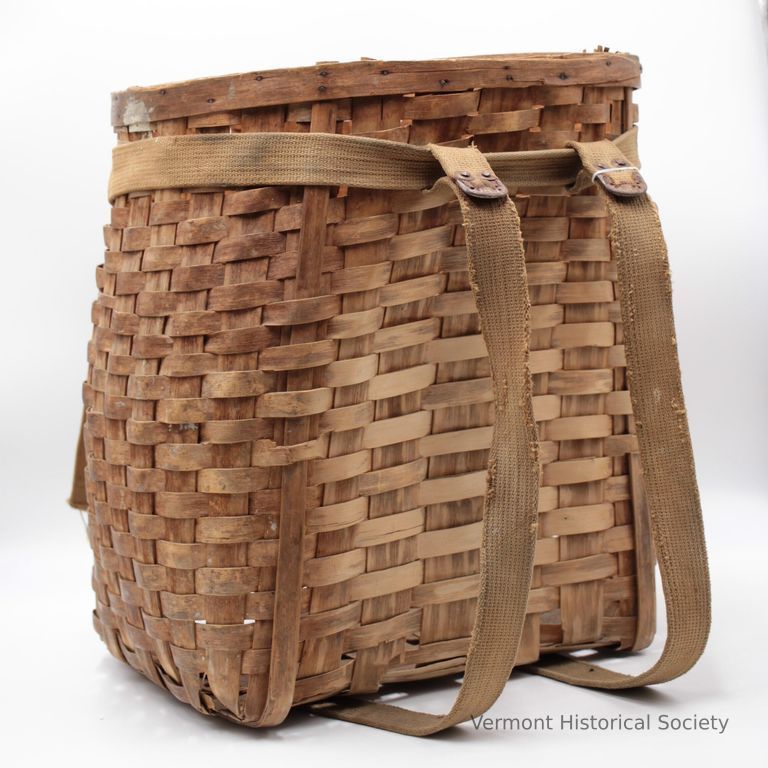
Pack Basket
Name/Title
Pack Basket
Lexicon
Description
Large basket with webbing straps for carrying on a person's back. The basket is a rounded rectangle shape with one side concave. Khaki webbing is wrapped around the top of the basket and hung with two long straps that stretch from front to back around the bottom of the pack in order to be worn over a person's shoulders, like a backpack. The straps are adjustable at the front of the pack via metal buckles.
Acquisition
Accession
1987.18
Relationships
Related Person or Organization
Mould, Fred, Green Mountain Club
Dimensions
Dimension Description
Overall
Materials
Material
Ash Splint, Cotton
Entry/Object ID
1987.18.1
Context
Used by Fred Mould, a founding member of the Sterling Section of the Green Mountain Club.

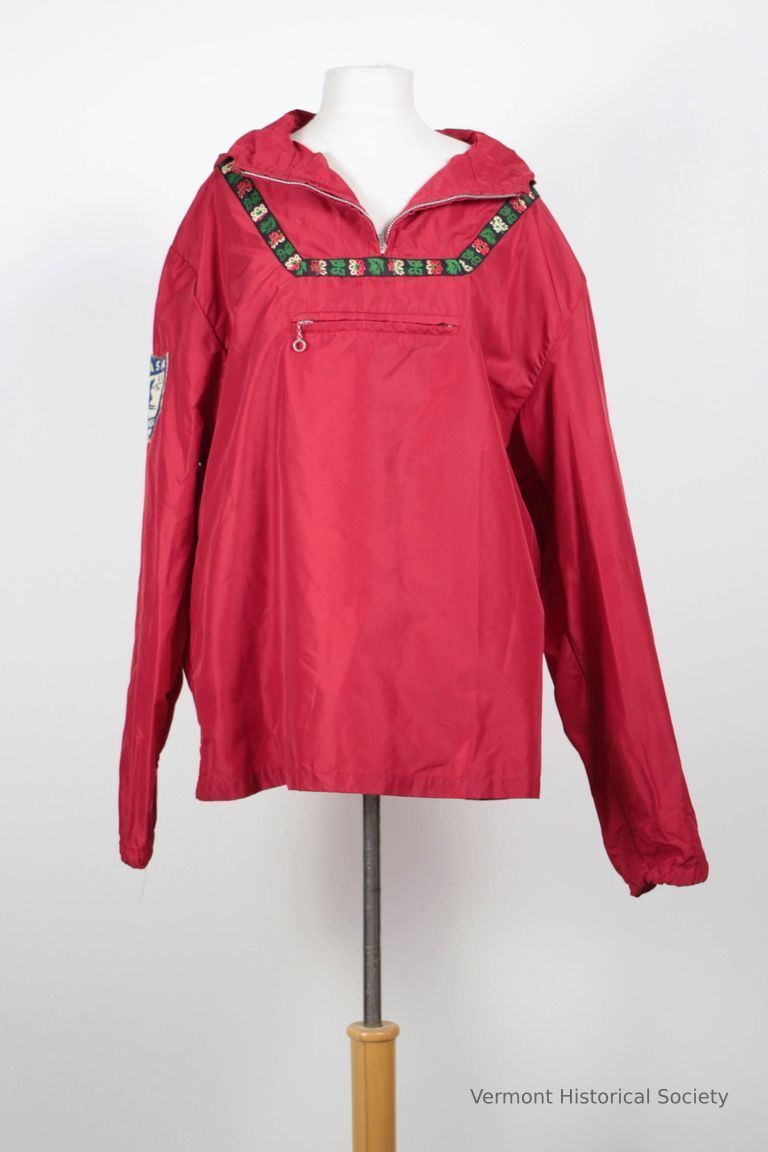
Parka
Name/Title
Parka
Lexicon
Clothing/Dress/Costume Details
Article of Clothing/Dress/Costume
Coat
Textile Details
Nylon
Material
Clothing Sex
Unisex
Description
Red nylon ski parka with red, green, white floral tape trim on front and back, near the neck. The neckline zips open to mid-chest, creating a high collar when closed. There is an attached hood. There is a small, zippered pouch on the center front at the bustline. The right sleeve bears a shield-shaped patch with an image of a skier and the inscription, "USEASA 1955 JUNIOR". The cuffs of the sleeves encase elastic. The bottom of the coat is hemmed, but does not encase elastic. A tag at the neck reads, "Lot 1488".
Acquisition
Accession
1994.30
Relationships
Related Person or Organization
Burlington High School, United States Eastern Amateur Ski Association
Related Places
Place
Burlington
City
Chittenden County
County
Vermont
State/Province
United States of America
Country
North America
Made/Created
Date made
1955
Dimensions
Dimension Description
Overall
Entry/Object ID
1994.30.2
Context
Worn by Elizabeth Nuquist Raby as a member of the Burlington High School Ski Club, 1955.
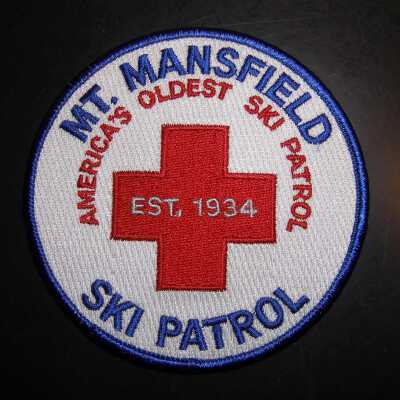
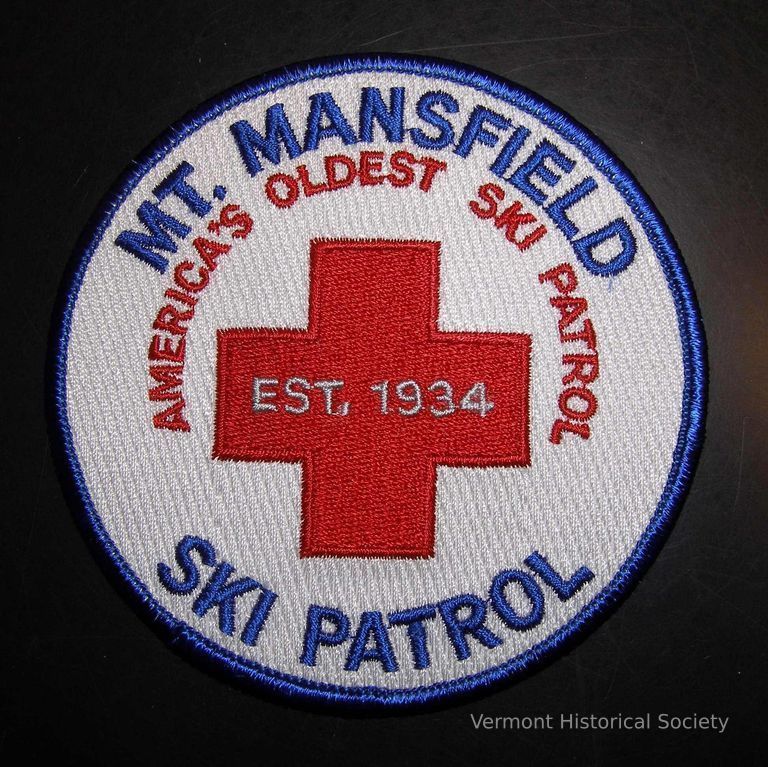
Patch
Name/Title
Patch
Lexicon
Description
"Mt. Mansfield Ski Patrol / America's Oldest Ski Patrol" patch. Round red, white and blue embroidered. Large red cross in center imprinted: "EST. 1934" See Worksheet file for history
Acquisition
Accession
2008.77
Relationships
Related Person or Organization
Mount Mansfield Ski Patrol
Person or Organization
Related Places
Place
Mount Mansfield
Mountain
Underhill
Town
Chittenden County
County
Vermont
State/Province
United States of America
Country
North America
Made/Created
Date made
2007
Dimensions
Materials
Material
Nylon
Entry/Object ID
2008.77
Context
From the Vermont Historical Society library introduction to documents on the Mt. Mansfield Ski Patrol:
"One of the first organized ski patrols in the nation, the Mount Mansfield Ski
Patrol was organized in 1934 through the auspices of the Mount Mansfield Ski Club. The
Club formed a committee to establish a patrol to cover the mountains and hills
surrounding Stowe, Vermont. The driving force behind the formation of the patrol was
Roland Palmedo, president of the Amateur Ski Club of New York. In 1935 the patrol
instituted a rule that all members must pass the Red Cross first aid course. After a skiing
fatality in 1936, the committee felt it needed to strengthen the rescue system and chose a
ski patrol director, Al Gottlieb, to coordinate the effort. One of his innovations was
building a series of nearly 40 caches of toboggans and first aid supplies on the mountains.
In 1938 Stowe hosted the U. S. National Downhill and Slalom races where the Ski Patrol
demonstrated its professionalism. As a result, the Mount Mansfield Ski Patrol was used
as the model for the National Ski Patrol."
"One of the first organized ski patrols in the nation, the Mount Mansfield Ski
Patrol was organized in 1934 through the auspices of the Mount Mansfield Ski Club. The
Club formed a committee to establish a patrol to cover the mountains and hills
surrounding Stowe, Vermont. The driving force behind the formation of the patrol was
Roland Palmedo, president of the Amateur Ski Club of New York. In 1935 the patrol
instituted a rule that all members must pass the Red Cross first aid course. After a skiing
fatality in 1936, the committee felt it needed to strengthen the rescue system and chose a
ski patrol director, Al Gottlieb, to coordinate the effort. One of his innovations was
building a series of nearly 40 caches of toboggans and first aid supplies on the mountains.
In 1938 Stowe hosted the U. S. National Downhill and Slalom races where the Ski Patrol
demonstrated its professionalism. As a result, the Mount Mansfield Ski Patrol was used
as the model for the National Ski Patrol."
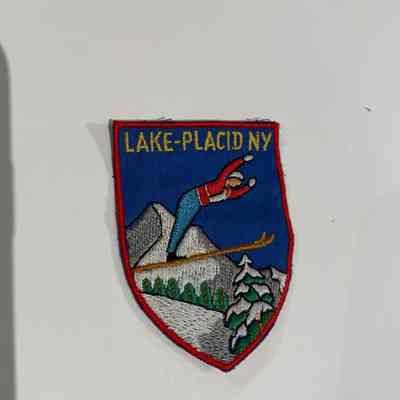
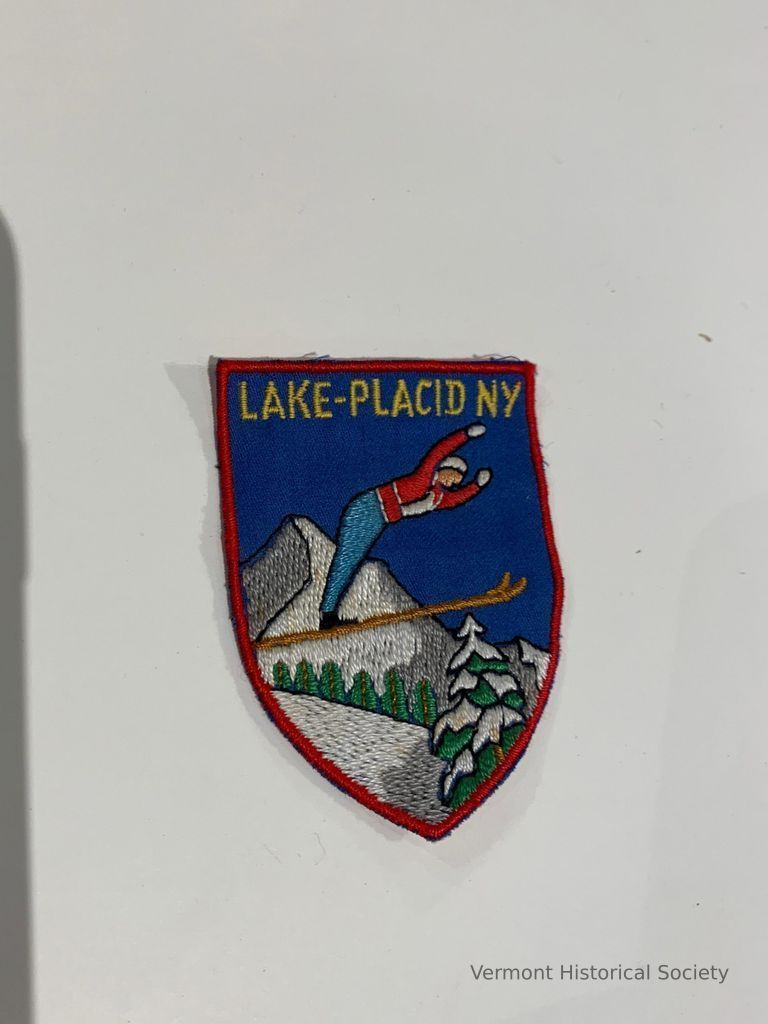
Patch
Name/Title
Patch
Clothing/Dress/Costume Details
Notes
Edging with bright red topstitching thread, perfectly preserved as if new. Entire shield filled with image of competitive ski jumper in bright colorful threads, each shape outlined with thin black lines in thread. All stitching is crisp and tight.
Textile Details
Blue
White
Gray
Green
Yellow
Beige
Black
Color
a lot
Sewing Stitch Count
Description
Shield shaped patch with bright red top-stitched edging. Depicting white mountains with gray crags and gray shadows along the slopes in front of a dark royal blue sky and outlining in black lines is one large green conifer with snowy branches and yellow twisted-thread trunks. A line of similar confer trees follow up and winding to the left on the mountainside. Also depicting a ski jumper with black outlining in jump in profile, above the frontal confirmation (delineating height of jump). Jumper wears a red sweater with a white vest, cap, and gloves; turquoise pants; brown (most likely wooden) skis; and black ski boots. Bearing inscription: "LAKE-PLACID NY" in yellow on top.
Given to Herbert Holbrook Austine School alumnus class of 1947 who was a class A award winning ski jumper.
Given to Herbert Holbrook Austine School alumnus class of 1947 who was a class A award winning ski jumper.
Acquisition
Accession
2024.16
Dimensions
Entry/Object ID
2024.16.43
Context
Austine School for the Deaf Brattleboro, VT
Earned by by Herbert P. Holbrook who was a class A ski jumper and olympic cross-country skier. He was an alumnus of the Austine School for the Deaf, and admitted to the AAAD (American Athletic Association for the Deaf) in 1964, when he also made the New York Times News twice that year. He competed in Berchtesgaden (West Germany) in the 60's and in the Meribel Olympics in France in 1979.
Earned by by Herbert P. Holbrook who was a class A ski jumper and olympic cross-country skier. He was an alumnus of the Austine School for the Deaf, and admitted to the AAAD (American Athletic Association for the Deaf) in 1964, when he also made the New York Times News twice that year. He competed in Berchtesgaden (West Germany) in the 60's and in the Meribel Olympics in France in 1979.
Web Links and URLs
- Records of Cross-country Skiing in Olympics-Deaflympics
- Clip of New York Times-January, 1964
- Clip of New York Times-February, 1964
- Records of Various Ski Events in Lake Placid February 1968-Adirondack Times
- History of Olympic Jumping Hill/Lake Placid Ski Club
- Samples of Other Ski Club Patches-Almost identical to this one

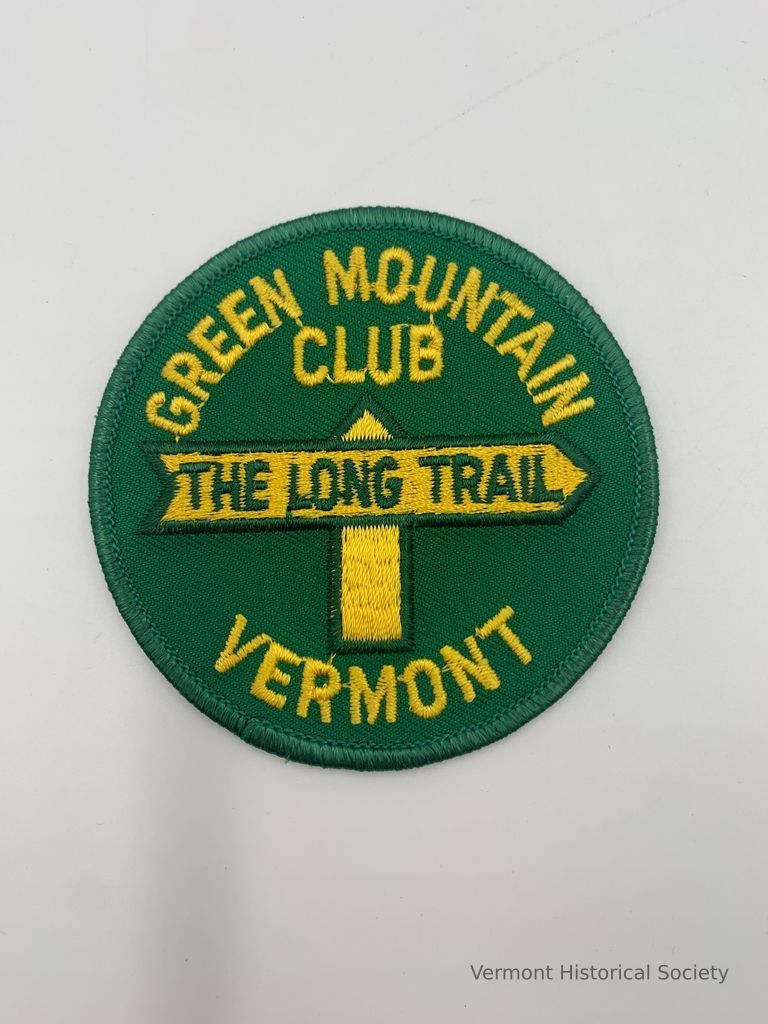
Patch
Name/Title
Patch
Lexicon
Description
Round green patch embroidered in yellow with the words, "GREEN MOUNTAIN CLUB VERMONT" and a wayfinding sign that reads, "THE LONG TRAIL".
Acquisition
Accession
2007.26
Relationships
Related Person or Organization
Green Mountain Boys State
Person or Organization
Related Places
Place
Long Trail
* Untyped Place
Vermont
State/Province
United States of America
Country
North America
Entry/Object ID
2007.26
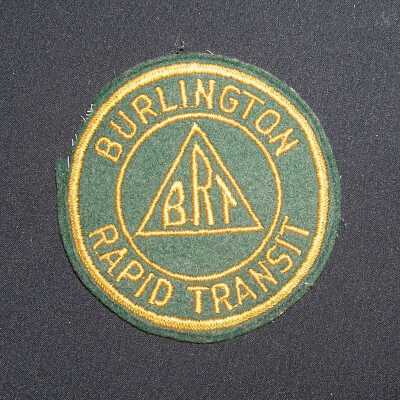
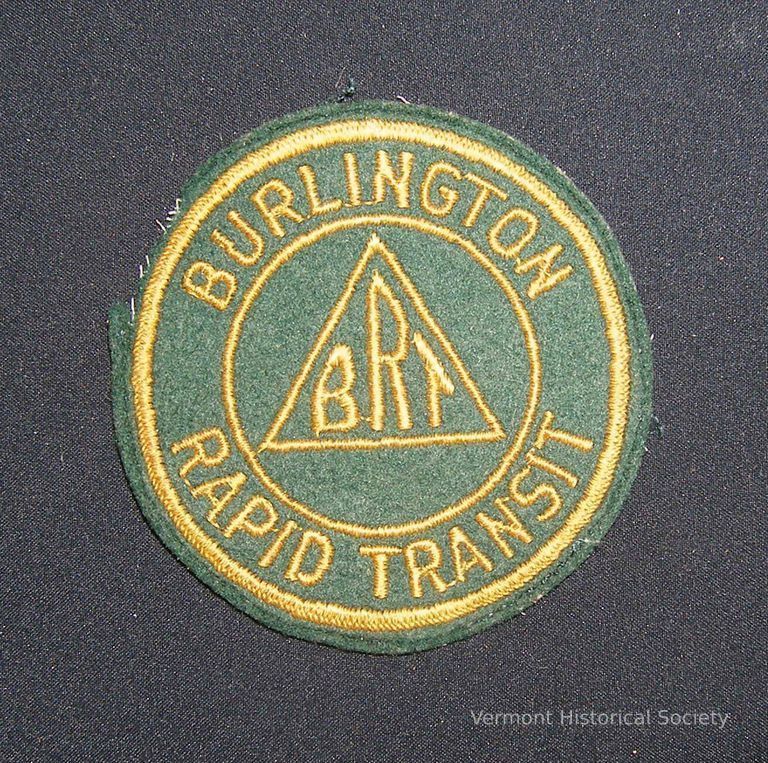
Patch
Name/Title
Patch
Description
Circular green patch with gold lettering "BURLINGTON RAPID TRANSIT BRT" Attached to bus driver's uniform.
Acquisition
Accession
2010.19
Relationships
Related Person or Organization
Burlington Rapid Transit
Person or Organization
Related Places
Place
Burlington
City
Chittenden County
County
Vermont
State/Province
United States of America
Country
North America
Dimensions
Materials
Material
Cotton
Entry/Object ID
2010.19.19
Context
From the Vermont Historical Society Library:
"On February 16, 1926, the first local bus route in Burlington, the “Country Club
Loop”, was established by William S. Appleyard, who owned an automobile dealership
on South Winooski Avenue. Calling his company the Burlington Rapid Transit Company
(BRT), he received permission from the Public Service Commission (PSC) to operate a
non-competitive (with BTC) bus route in the Hill Section of Burlington. Soon, when
BTC failed to comply with PSC orders to expand their lines, the commission granted
Appleyard permission to operate his buses in places directly in competition with the
BTC.(Burlington Trolley Co.)
Over the next few years, Appleyard received permission to expand to seven
competitive yet successful bus routes in the Burlington area. His success, combined with
the devastating flood in November of 1927 (that damaged trolley tracks and collapsed the
Winooski Bridge, a main BTC route), proved to be the undoing of the BTC. In 1929,
Appleyard bought the BTC in order to acquire its routes and eliminate competition. BTC
trolleys operated until August 4, 1929, when, at 4 p.m., a crowd gathered at City Hall
Park to witness the famous and symbolic torching of Car #5, their oldest trolley. The
trolley era had ended.
Meanwhile, in 1927, Appleyard established the Vermont Transit Company
(VTC), under which he operated out-of-town buses. Over the next decade and a half,
Appleyard purchased existing bus lines throughout Vermont, connecting Burlington via
bus to the other towns and cities of Vermont (and beyond). Towns accessed by VTC
buses included Barre (1927), Rutland and Vergennes (1928), Bennington and Pittsfield,
MA (1929), Portland, ME (1932), Bellows Falls, White River Junction and Claremont,
NH (1935), Albany, NY (1936), St. Johnsbury and Littleton, NH (1937), Newport
(1938), Chester and Springfield (1939), and Concord and Manchester, NH (1941). By
1945, VTC buses were connecting Vermonters to New York City, Boston and Montreal.
...In 1973, Burlington Rapid Transit’s name was changed to BRT, Inc., which
became a real estate investment business. The local bus service BRT provided was
undertaken by the Chittenden County Transportation Authority, though BRT maintained
ownership of the bus station and leased it to the VTC. The CCTA continues to operate
the local bus service today (2010). "
"On February 16, 1926, the first local bus route in Burlington, the “Country Club
Loop”, was established by William S. Appleyard, who owned an automobile dealership
on South Winooski Avenue. Calling his company the Burlington Rapid Transit Company
(BRT), he received permission from the Public Service Commission (PSC) to operate a
non-competitive (with BTC) bus route in the Hill Section of Burlington. Soon, when
BTC failed to comply with PSC orders to expand their lines, the commission granted
Appleyard permission to operate his buses in places directly in competition with the
BTC.(Burlington Trolley Co.)
Over the next few years, Appleyard received permission to expand to seven
competitive yet successful bus routes in the Burlington area. His success, combined with
the devastating flood in November of 1927 (that damaged trolley tracks and collapsed the
Winooski Bridge, a main BTC route), proved to be the undoing of the BTC. In 1929,
Appleyard bought the BTC in order to acquire its routes and eliminate competition. BTC
trolleys operated until August 4, 1929, when, at 4 p.m., a crowd gathered at City Hall
Park to witness the famous and symbolic torching of Car #5, their oldest trolley. The
trolley era had ended.
Meanwhile, in 1927, Appleyard established the Vermont Transit Company
(VTC), under which he operated out-of-town buses. Over the next decade and a half,
Appleyard purchased existing bus lines throughout Vermont, connecting Burlington via
bus to the other towns and cities of Vermont (and beyond). Towns accessed by VTC
buses included Barre (1927), Rutland and Vergennes (1928), Bennington and Pittsfield,
MA (1929), Portland, ME (1932), Bellows Falls, White River Junction and Claremont,
NH (1935), Albany, NY (1936), St. Johnsbury and Littleton, NH (1937), Newport
(1938), Chester and Springfield (1939), and Concord and Manchester, NH (1941). By
1945, VTC buses were connecting Vermonters to New York City, Boston and Montreal.
...In 1973, Burlington Rapid Transit’s name was changed to BRT, Inc., which
became a real estate investment business. The local bus service BRT provided was
undertaken by the Chittenden County Transportation Authority, though BRT maintained
ownership of the bus station and leased it to the VTC. The CCTA continues to operate
the local bus service today (2010). "
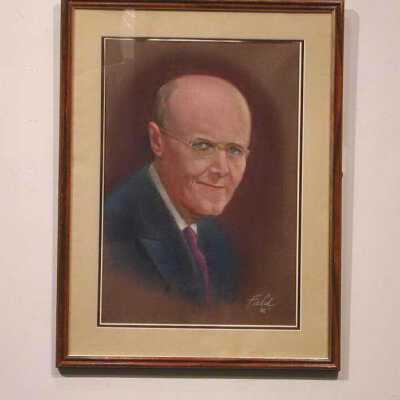

Paul P. Harris
Name/Title
Paul P. Harris
Lexicon
Description
Pastel portrait showing a partially-bald white man from the shoulders up. His body is facing the right, but his face is turned toward the viewer. He is wearing wire-rimmed eyeglasses, and a 20th-century style suit consisting of a white shirt, purple tie, and blue jack. The background is brown. The portrait is framed in a narrow wooden frame with a beige mate.
Acquisition
Accession
1987.42
Relationships
Related Person or Organization
Valley Rotary Club, Rotary International
Artwork Details
Subject Person
Harris, Paul P. (1868-1947)
Made/Created
Artist Information
Field, Sam
Artist
Date made
1986
Dimensions
Entry/Object ID
1987.42.1
Type of Drawing
Context
Depicts Paul Harris, founder of Rotary. The portrait was presented to the Valley Rotary Club by the artist, Sam Field.

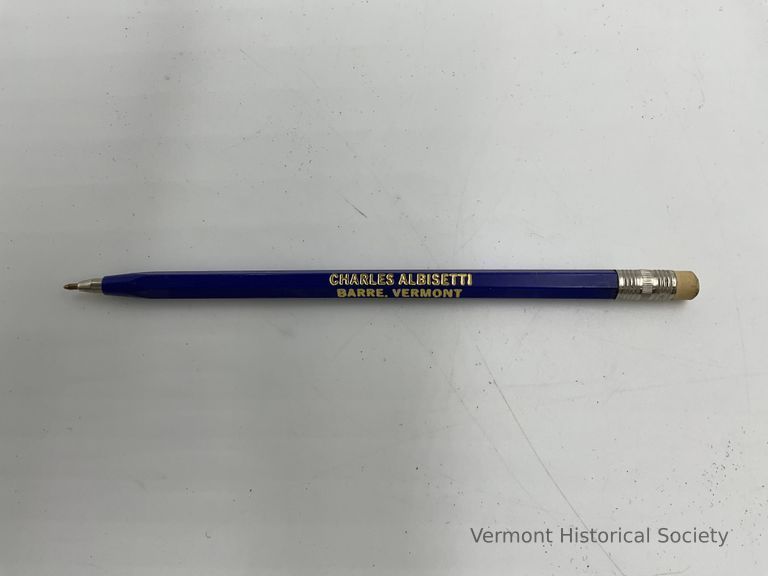
Pen
Name/Title
Pen
Description
Blue ballpoint pen with ink eraser and a name printed in gold in the side of the pen -- Charles Albisetti, Barre, Vermont.
Use
Advertise/promote a business in Barre.
Relationships
Related Person or Organization
Shirley Campbell Prushko
Charles Albisetti
Related Places
Place
Barre City
City
Washington County
County
Vermont
State/Province
United States of America
Country
North America
Dimensions
Materials
Material
Plastic, Metal, Rubber, Sand
Entry/Object ID
2012.68.5
Context
From the Vermont Historical Society finding aid for documents at https://vermonthistory.org/documents/findaid/AlbisettiFamily.pdf
"The Albisetti family emigrated from Northern Italy in the late 19th century. ... . John Battista Albisetti, sometimes known simply as “Battista Albisetti,” worked in the granite industry, initially as a carver for Harrison Granite Company, and then as salesman for Wells-Lamson and Jones Brothers Companies.
The Albisettis’ son, Charles Albisetti, was born on June 25, 1904. He attended grade school in Barre, Vermont, and graduated from Spaulding High School in 1924. Charles Albisetti also received training as an auto-electrician through the correspondence course with the Chicago Engineering Works Review. On June 30, 1934, Charles Albisetti married Irene May Davis. During the Second World War the couple moved to Maine and volunteered for the United States Civil Service, working within Maine’s Public Housing Authority. After returning to Barre, Vt., Charles Albisetti founded Albisetti City Electric Company and managed the business. He also served as chair of the Kiwanis Club of Barre, Vt., and facilitated events and support programs for the town’s underprivileged children through committee work. Charles Albisetti and Irene Albisetti also travelled to Italy in the mid-1950s. They established the Irene M. Davis Albisetti and Charles S. Albisetti Scholarship Fund in Health Sciences and Technology at Harvard University in 1988. Charles Albisetti passed away on August 23, 1998."
"The Albisetti family emigrated from Northern Italy in the late 19th century. ... . John Battista Albisetti, sometimes known simply as “Battista Albisetti,” worked in the granite industry, initially as a carver for Harrison Granite Company, and then as salesman for Wells-Lamson and Jones Brothers Companies.
The Albisettis’ son, Charles Albisetti, was born on June 25, 1904. He attended grade school in Barre, Vermont, and graduated from Spaulding High School in 1924. Charles Albisetti also received training as an auto-electrician through the correspondence course with the Chicago Engineering Works Review. On June 30, 1934, Charles Albisetti married Irene May Davis. During the Second World War the couple moved to Maine and volunteered for the United States Civil Service, working within Maine’s Public Housing Authority. After returning to Barre, Vt., Charles Albisetti founded Albisetti City Electric Company and managed the business. He also served as chair of the Kiwanis Club of Barre, Vt., and facilitated events and support programs for the town’s underprivileged children through committee work. Charles Albisetti and Irene Albisetti also travelled to Italy in the mid-1950s. They established the Irene M. Davis Albisetti and Charles S. Albisetti Scholarship Fund in Health Sciences and Technology at Harvard University in 1988. Charles Albisetti passed away on August 23, 1998."
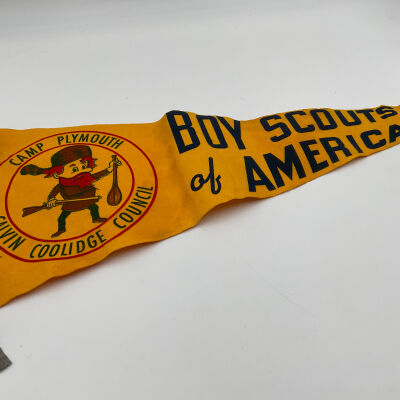
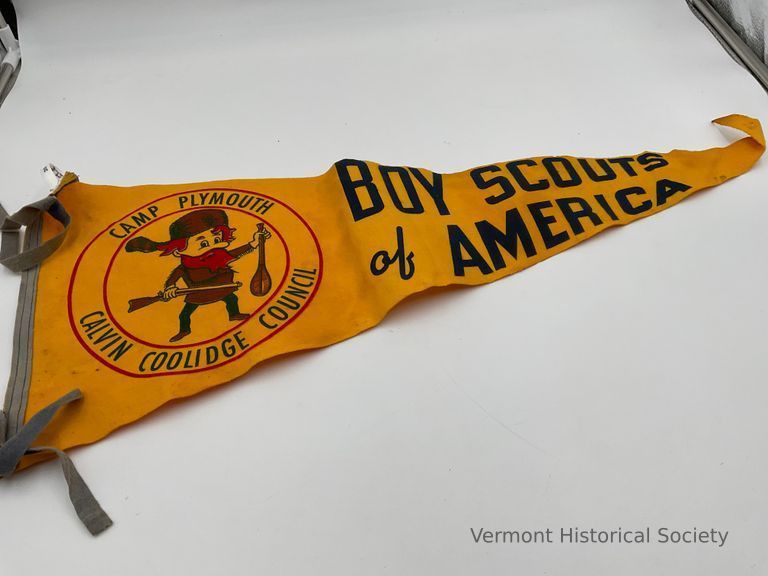
Pennant
Name/Title
Pennant
Lexicon
Description
Yellow felt Boy Scout pennant that includes a circular logo for Camp Plymouth, Calvin Coolidge Council with the image of a Davy Crockett-like figure holding a musket and a paddle. The words "Boy Scouts of American" is printed in large blue letters.
Acquisition
Accession
2006.73
Relationships
Related Person or Organization
Phipard, Charles Willard (1916-2002), Boy Scouts of America
Dimensions
Materials
Material
Felt
Entry/Object ID
2006.73.12
Context
Excerpts below from Vermont Historical Society Library summary of documents.
"Charles Willard Phipard was born Aug. 5, 1916, in New York City, the son of Dr.
Willard Phipard and Hazel (Dealing) Phipard.
Charles and his sister Helen spent many summers of their youth with their great-aunt and great-uncle, Cora Gero Munsell and Dr. Chauncy Munsell in South Royalton, Vermont.
Charles Phipard received his elementary education at Poly Prep Day School in
Brooklyn, N.Y., the school attended by his father and grandfather. He attended Wesleyan
University and Upsala College, graduating with degrees in business and economics. He
was a member of the Delta Upsilon national fraternity and served in the U.S. Army Air
Force during World War II; most of his time was spend in Canada as a weather observer.
After his discharge he returned home to Long Island and worked in the
experimental department of Sperry Gyroscope. In 1956 he moved to Royalton, Vermont,
to be near his sister and purchased a farm on Waterman Road where he raised chickens.
Charles Phipard was a charter member of the Heartland Lions Club, where he
served as treasurer for many years. He was active as a Boy Scout leader, a member of the
Sons of the American Revolution, and for many years was State Commissioner and
Treasurer for Babe Ruth Baseball. He died August 7, 2002. "
"Charles Willard Phipard was born Aug. 5, 1916, in New York City, the son of Dr.
Willard Phipard and Hazel (Dealing) Phipard.
Charles and his sister Helen spent many summers of their youth with their great-aunt and great-uncle, Cora Gero Munsell and Dr. Chauncy Munsell in South Royalton, Vermont.
Charles Phipard received his elementary education at Poly Prep Day School in
Brooklyn, N.Y., the school attended by his father and grandfather. He attended Wesleyan
University and Upsala College, graduating with degrees in business and economics. He
was a member of the Delta Upsilon national fraternity and served in the U.S. Army Air
Force during World War II; most of his time was spend in Canada as a weather observer.
After his discharge he returned home to Long Island and worked in the
experimental department of Sperry Gyroscope. In 1956 he moved to Royalton, Vermont,
to be near his sister and purchased a farm on Waterman Road where he raised chickens.
Charles Phipard was a charter member of the Heartland Lions Club, where he
served as treasurer for many years. He was active as a Boy Scout leader, a member of the
Sons of the American Revolution, and for many years was State Commissioner and
Treasurer for Babe Ruth Baseball. He died August 7, 2002. "

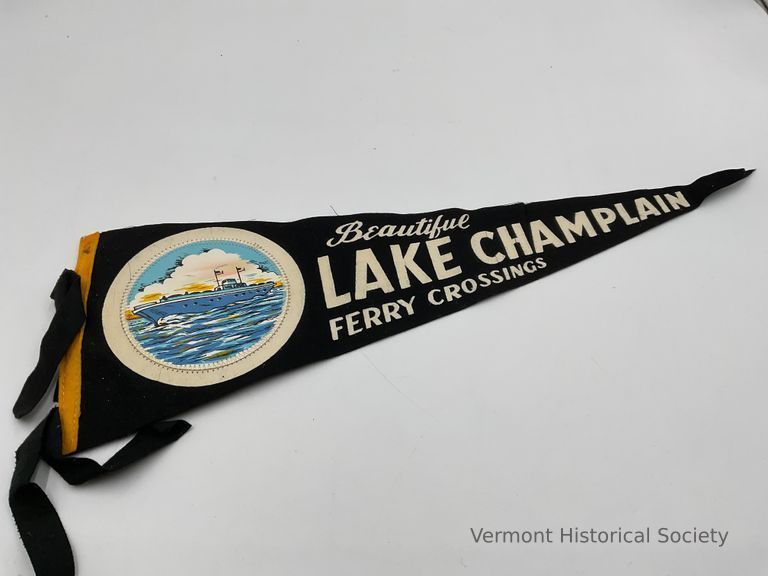
Pennant
Name/Title
Pennant
Lexicon
Description
Black felt pennant with a circular white patch featuring the image of a ferry. Next to the image are these words printed in white: "Beautiful Lake Champlain Ferry Crossings."
Acquisition
Accession
2006.73
Relationships
Related Person or Organization
Phipard, Charles Willard (1916-2002)
Person or Organization
Dimensions
Materials
Material
Felt
Entry/Object ID
2006.73.10
Context
Excerpts below from Vermont Historical Society Library summary of documents.
"Charles Willard Phipard was born Aug. 5, 1916, in New York City, the son of Dr.
Willard Phipard and Hazel (Dealing) Phipard.
Charles and his sister Helen spent many summers of their youth with their great-aunt and great-uncle, Cora Gero Munsell and Dr. Chauncy Munsell in South Royalton, Vermont.
Charles Phipard received his elementary education at Poly Prep Day School in
Brooklyn, N.Y., the school attended by his father and grandfather. He attended Wesleyan
University and Upsala College, graduating with degrees in business and economics. He
was a member of the Delta Upsilon national fraternity and served in the U.S. Army Air
Force during World War II; most of his time was spend in Canada as a weather observer.
After his discharge he returned home to Long Island and worked in the
experimental department of Sperry Gyroscope. In 1956 he moved to Royalton, Vermont,
to be near his sister and purchased a farm on Waterman Road where he raised chickens.
Charles Phipard was a charter member of the Heartland Lions Club, where he
served as treasurer for many years. He was active as a Boy Scout leader, a member of the
Sons of the American Revolution, and for many years was State Commissioner and
Treasurer for Babe Ruth Baseball. He died August 7, 2002. "
"Charles Willard Phipard was born Aug. 5, 1916, in New York City, the son of Dr.
Willard Phipard and Hazel (Dealing) Phipard.
Charles and his sister Helen spent many summers of their youth with their great-aunt and great-uncle, Cora Gero Munsell and Dr. Chauncy Munsell in South Royalton, Vermont.
Charles Phipard received his elementary education at Poly Prep Day School in
Brooklyn, N.Y., the school attended by his father and grandfather. He attended Wesleyan
University and Upsala College, graduating with degrees in business and economics. He
was a member of the Delta Upsilon national fraternity and served in the U.S. Army Air
Force during World War II; most of his time was spend in Canada as a weather observer.
After his discharge he returned home to Long Island and worked in the
experimental department of Sperry Gyroscope. In 1956 he moved to Royalton, Vermont,
to be near his sister and purchased a farm on Waterman Road where he raised chickens.
Charles Phipard was a charter member of the Heartland Lions Club, where he
served as treasurer for many years. He was active as a Boy Scout leader, a member of the
Sons of the American Revolution, and for many years was State Commissioner and
Treasurer for Babe Ruth Baseball. He died August 7, 2002. "

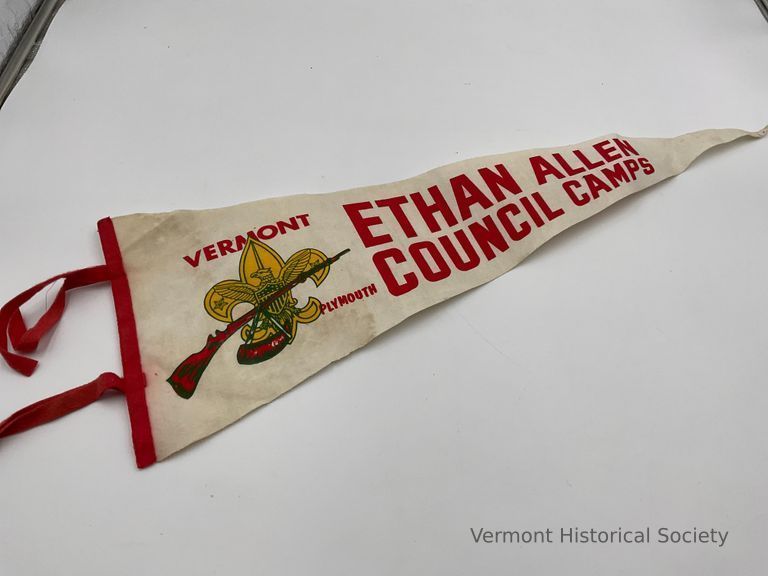
Pennant
Name/Title
Pennant
Lexicon
Description
Red and white, felt Boy Scout pennant. The pennant has a Boy Scout insignia that includes a musket and powder horn. Printed in red letters on the white background are the words, "Vermont, Plymouth, Ethan Allen Council Camps."
Acquisition
Accession
2006.73
Relationships
Related Person or Organization
Phipard, Charles Willard (1916-2002), Boy Scouts of America
Dimensions
Materials
Material
Felt
Entry/Object ID
2006.73.11
Context
Excerpts below from Vermont Historical Society Library summary of documents.
"Charles Willard Phipard was born Aug. 5, 1916, in New York City, the son of Dr.
Willard Phipard and Hazel (Dealing) Phipard.
Charles and his sister Helen spent many summers of their youth with their great-aunt and great-uncle, Cora Gero Munsell and Dr. Chauncy Munsell in South Royalton, Vermont.
Charles Phipard received his elementary education at Poly Prep Day School in
Brooklyn, N.Y., the school attended by his father and grandfather. He attended Wesleyan
University and Upsala College, graduating with degrees in business and economics. He
was a member of the Delta Upsilon national fraternity and served in the U.S. Army Air
Force during World War II; most of his time was spend in Canada as a weather observer.
After his discharge he returned home to Long Island and worked in the
experimental department of Sperry Gyroscope. In 1956 he moved to Royalton, Vermont,
to be near his sister and purchased a farm on Waterman Road where he raised chickens.
Charles Phipard was a charter member of the Heartland Lions Club, where he
served as treasurer for many years. He was active as a Boy Scout leader, a member of the
Sons of the American Revolution, and for many years was State Commissioner and
Treasurer for Babe Ruth Baseball. He died August 7, 2002. "
"Charles Willard Phipard was born Aug. 5, 1916, in New York City, the son of Dr.
Willard Phipard and Hazel (Dealing) Phipard.
Charles and his sister Helen spent many summers of their youth with their great-aunt and great-uncle, Cora Gero Munsell and Dr. Chauncy Munsell in South Royalton, Vermont.
Charles Phipard received his elementary education at Poly Prep Day School in
Brooklyn, N.Y., the school attended by his father and grandfather. He attended Wesleyan
University and Upsala College, graduating with degrees in business and economics. He
was a member of the Delta Upsilon national fraternity and served in the U.S. Army Air
Force during World War II; most of his time was spend in Canada as a weather observer.
After his discharge he returned home to Long Island and worked in the
experimental department of Sperry Gyroscope. In 1956 he moved to Royalton, Vermont,
to be near his sister and purchased a farm on Waterman Road where he raised chickens.
Charles Phipard was a charter member of the Heartland Lions Club, where he
served as treasurer for many years. He was active as a Boy Scout leader, a member of the
Sons of the American Revolution, and for many years was State Commissioner and
Treasurer for Babe Ruth Baseball. He died August 7, 2002. "

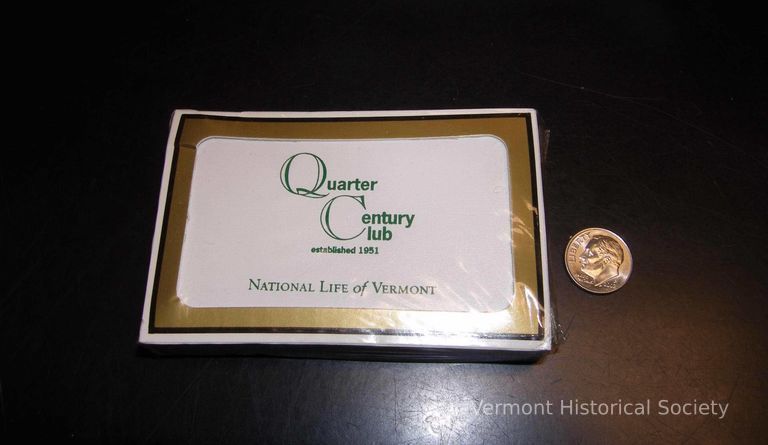
Playing Cards
Name/Title
Playing Cards
Lexicon
Description
Unopened box of playing cards wrapped in clear cellophane. The box is printed with a black-and-gold border and the green inscription, "Quarter Century Club establish 1951 / National Life of Vermont". The back of the box is printed gold with the card suit symbols printed in black in each corner.
Acquisition
Accession
2005.57
Relationships
Related Person or Organization
The National Life Group
Person or Organization
Related Places
Place
Montpelier
City
Washington County
County
Vermont
State/Province
United States of America
Country
North America
Made/Created
Date made
1980-1990
Manufacturer
Gemaco
Dimensions
Dimension Description
Overall
Materials
Material
Paperboard, Plastic
Entry/Object ID
2005.57.2

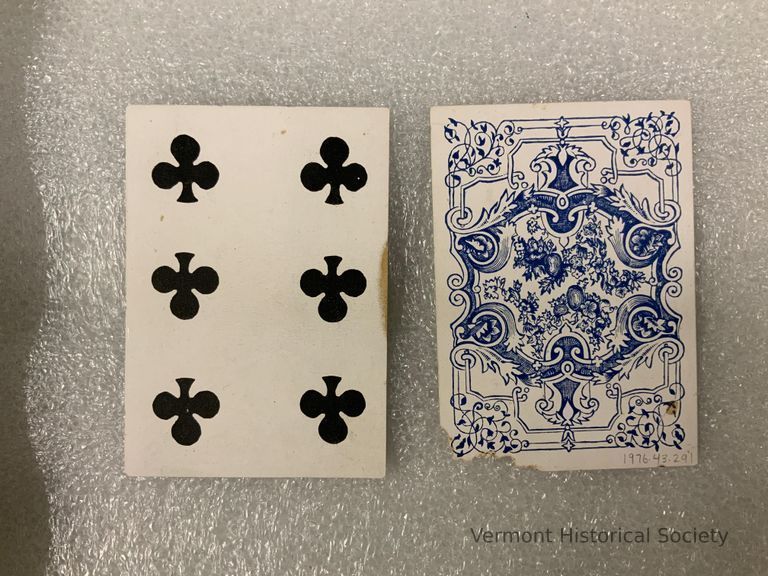
Playing Cards
Name/Title
Playing Cards
Lexicon
Description
Two playing cards from the same deck, a 6 of clubs and a 4 of clubs. The reverse of each card is printed in blue with a rococo design of fruit within a cartouche with architectural elements surrounding it.
Acquisition
Accession
1976.43
Dimensions
Dimension Description
Overall (each)
Materials
Material
Paper
Entry/Object ID
1976.43.291
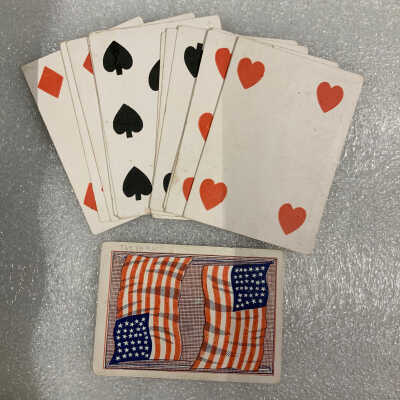

Playing Cards
Name/Title
Playing Cards
Lexicon
Description
Fifteen playing cards from the same deck. The reverse side of the cards is printed in red and blue with a design of two United States flags oriented opposite each other. The cards are 5 of clubs; 8 of clubs; 4-5 of diamonds; 7 of diamonds; 2 of hearts; 4 of hearts; 6-8 of hearts; 2-5 of spades; 8 of spades.
Acquisition
Accession
1976.43
Dimensions
Dimension Description
Overall
Materials
Material
Paper
Entry/Object ID
1976.43.292
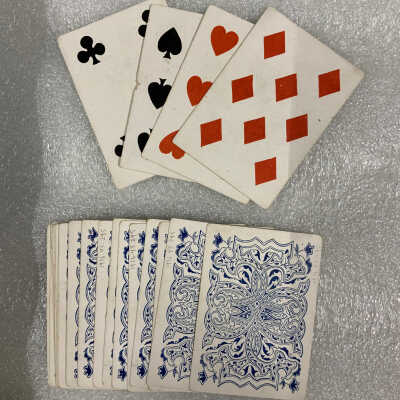

Playing Cards
Name/Title
Playing Cards
Lexicon
Description
Set of 22 playing cards from the same deck. The reverse of each card is printed in blue with a rococo design of intertwined ribbons and vines. The cards include 4-5 and 7-8 of diamonds; 4-8 of hearts; 2, 4, and 6-8 of spades; 2-8 of clubs.
Acquisition
Accession
1976.43
Dimensions
Dimension Description
Overall
Materials
Material
Paper
Entry/Object ID
1976.43.295

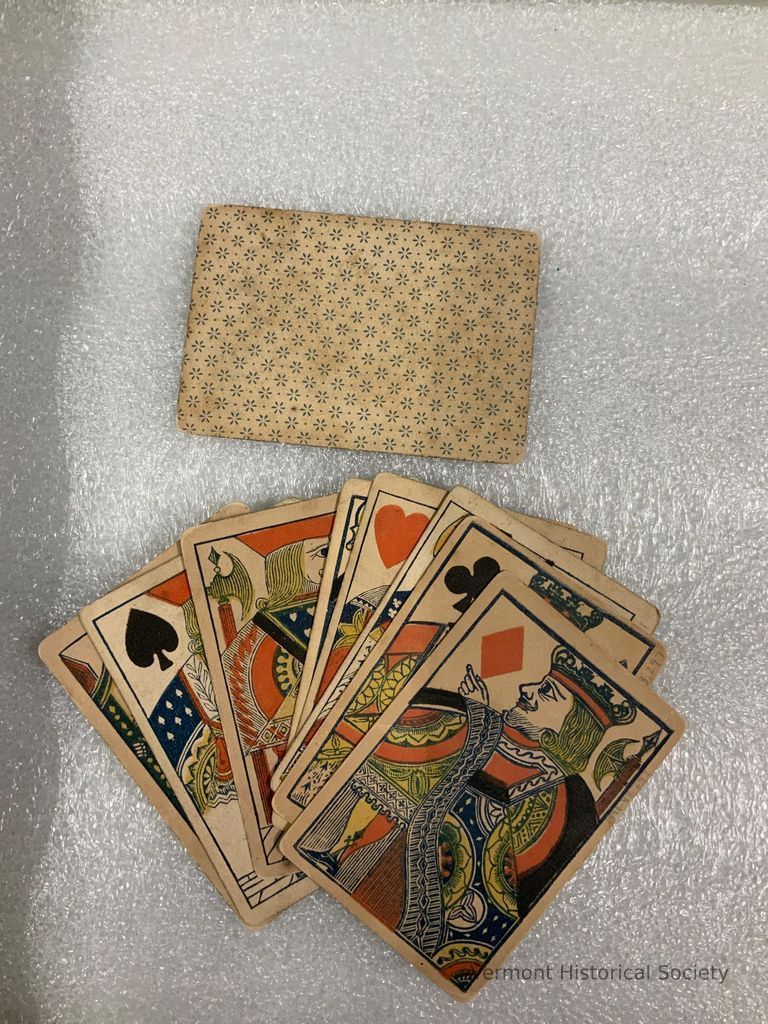
Playing Cards
Name/Title
Playing Cards
Lexicon
Description
9 playing cards from the same deck. The reverse of each card is printed in blue with a small repeating pattern of flowers. The cards are all face cards pritned in black, yellow, blue, and red, and consist of jack, queen, and king of diamonds; jack and queen of hearts; jack and king of spades; queen and king of clubs.
Acquisition
Accession
1976.43
Dimensions
Dimension Description
Overall (each)
Materials
Material
Paper
Entry/Object ID
1976.43.297

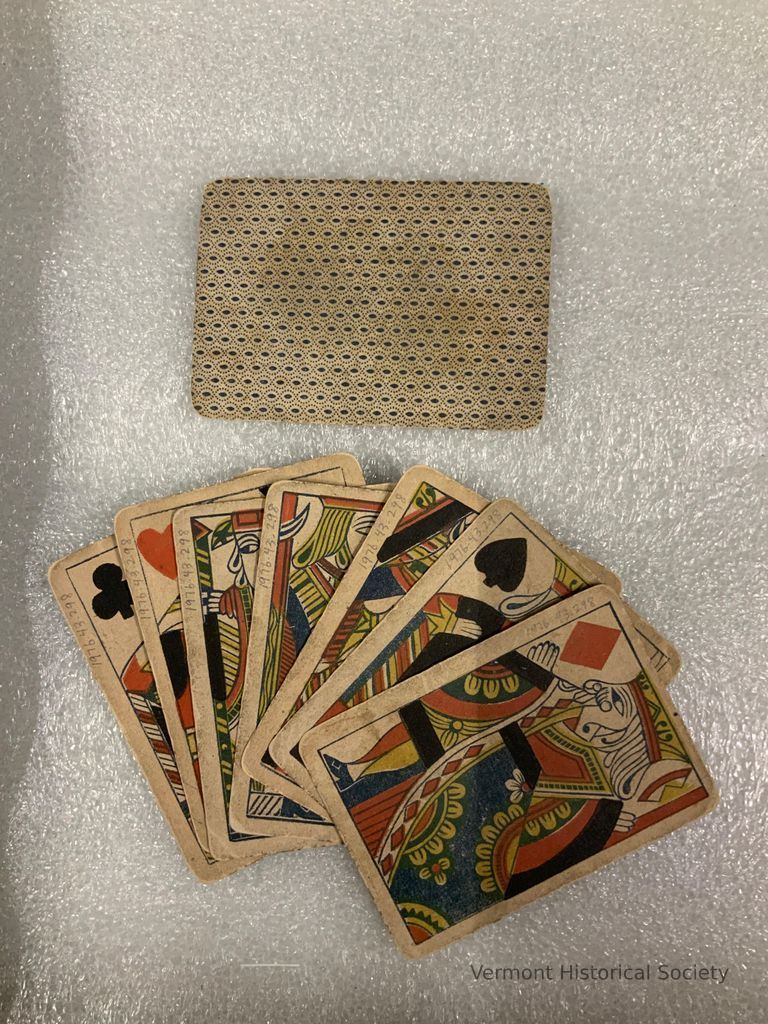
Playing Cards
Name/Title
Playing Cards
Lexicon
Description
8 playing cards from the same deck. The reverse is printed in blue with a repeated diaper pattern. The cards consist of jack and king of diamonds; jack, queen, and king of hearts; king of spades; jack and king of clubs.
Acquisition
Accession
1976.43
Dimensions
Dimension Description
Overall (each)
Materials
Material
Paper
Entry/Object ID
1976.43.298

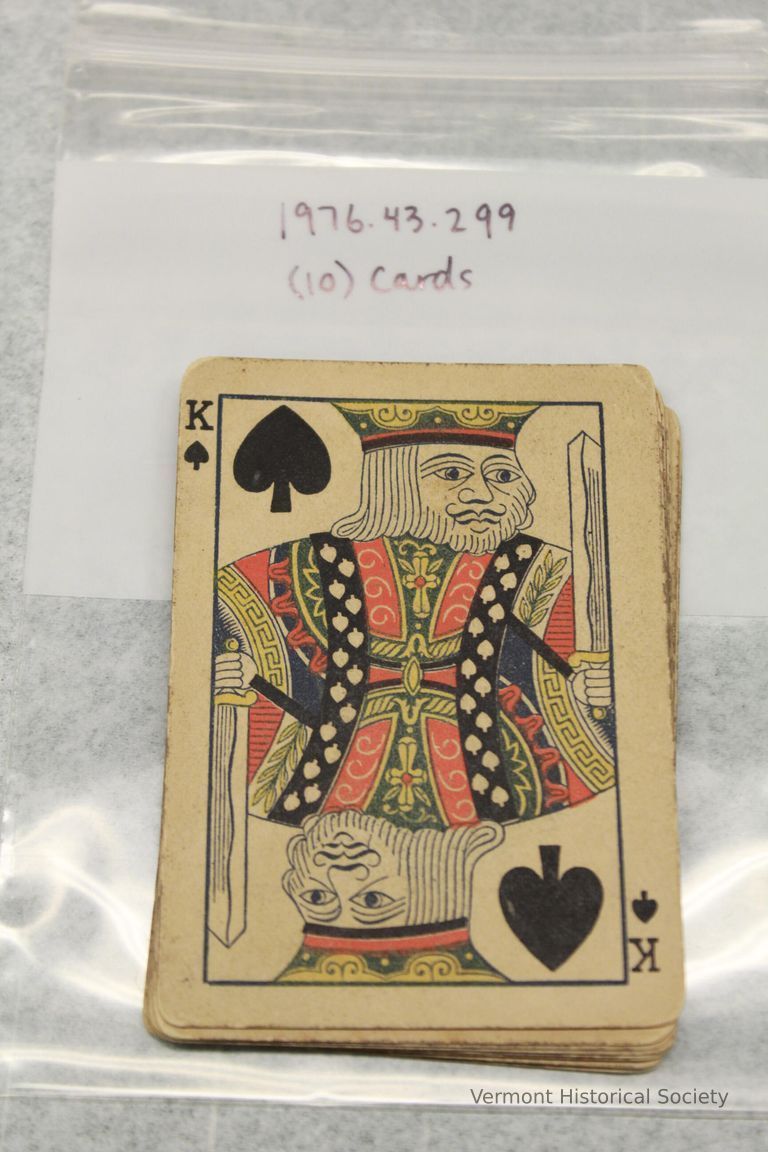
Playing Cards
Name/Title
Playing Cards
Lexicon
Description
10 playing cards from the same deck. The reverse is printed in brown with a repeating diamond pattern. The cards consist of jack and queen of diamonds; jack, queen, and king of hearts; jack, king, and queen of spades; jack and queen of clubs.
Acquisition
Accession
1976.43
Dimensions
Dimension Description
Overall (each)
Materials
Material
Paper
Entry/Object ID
1976.43.299

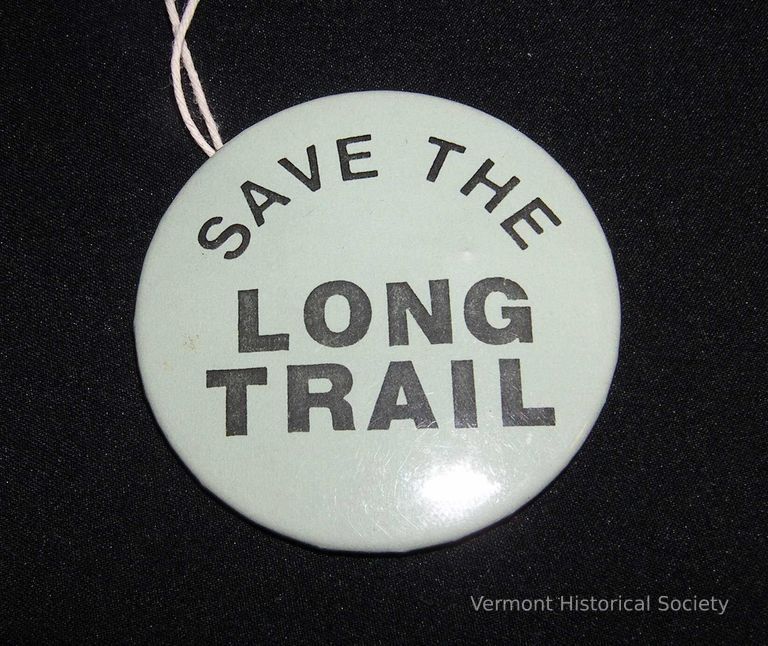
Political Button
Name/Title
Political Button
Lexicon
Description
"Save the Long Trail" pin. Black printing on pale green paper - mounted on a pin back.
Acquisition
Accession
2009.14
Relationships
Related Person or Organization
Green Mountain Club
Person or Organization
Related Places
Place
Long Trail
* Untyped Place
Vermont
State/Province
United States of America
Country
North America
Made/Created
Date made
2000-2009
Manufacturer
Badge-a-Minit
Dimensions
Entry/Object ID
2009.14.2
Context
No information was found to explain the purpose of this pin. However, the following excerpt from the Green Mountain Club's website (https://www.greenmountainclub.org/conservation/protecting-long-trail/)
explains the ongoing efforts to protect the trail from one end of the state to the other.
"Since the 1980s, the Green Mountain Club has sought to secure a permanent route for the Long Trail. While in the early years, the club could rely on simple handshake agreements with landowners, a few threats of trail closure and development near the trail inspired the club to kick off its Long Trail Protection Campaign.
The Long Trail Protection Campaign has resulted in the conservation of more than 25,000 acres of Vermont forest land through which the Long Trail and its side trails cross. The club has protected more than 78 miles of the Long Trail and continues to strive to conserve the remaining 6.5 miles of the trail (Note: much of the trail was conserved before this campaign thanks to the national forest and state lands). With only a few miles left unprotected, the club continues to work with willing landowners to provide the public with long term certainty that the trail will never close.
The club’s Long Trail Protection Campaign has always relied exclusively on willing landowner sales and easements. The club has partnered with the state of Vermont to transfer many of the lands it has conserved into the state forest system."
explains the ongoing efforts to protect the trail from one end of the state to the other.
"Since the 1980s, the Green Mountain Club has sought to secure a permanent route for the Long Trail. While in the early years, the club could rely on simple handshake agreements with landowners, a few threats of trail closure and development near the trail inspired the club to kick off its Long Trail Protection Campaign.
The Long Trail Protection Campaign has resulted in the conservation of more than 25,000 acres of Vermont forest land through which the Long Trail and its side trails cross. The club has protected more than 78 miles of the Long Trail and continues to strive to conserve the remaining 6.5 miles of the trail (Note: much of the trail was conserved before this campaign thanks to the national forest and state lands). With only a few miles left unprotected, the club continues to work with willing landowners to provide the public with long term certainty that the trail will never close.
The club’s Long Trail Protection Campaign has always relied exclusively on willing landowner sales and easements. The club has partnered with the state of Vermont to transfer many of the lands it has conserved into the state forest system."
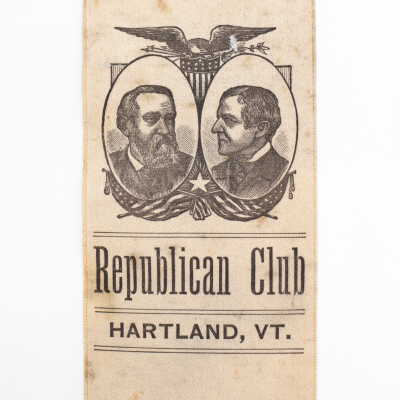
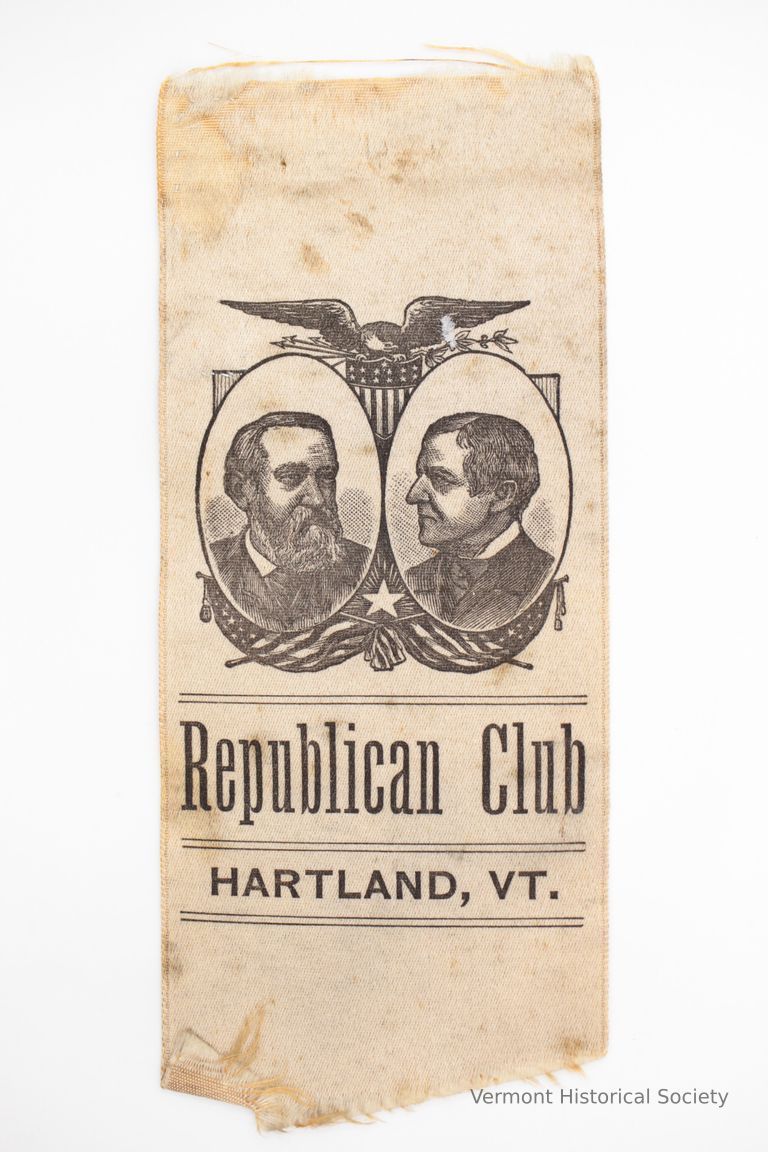
Political Ribbon
Name/Title
Political Ribbon
Lexicon
Description
Ivory satin-woven silk ribbon printed in black with two bust portraits of men in oval frames. The man on the left has a beard, and the man on the right is cleanshaven. Above the frames is a spread eagle on a shield, and below the frames are a star and two crossed United States flags. Beneath the image is the inscription, "Republican Club HARTLAND, VT."
Acquisition
Accession
1957.25
Relationships
Related Person or Organization
Young Men's Republican Club of Vermont
Person or Organization
Related Places
Place
Hartland
Town
Windsor County
County
Vermont
State/Province
United States of America
Country
North America
Woven Textile Details
Weave Type
Satin Weave
Dimensions
Dimension Description
Overall
Materials
Material
Silk
Entry/Object ID
1957.25.76e
Context
Likely owned by Harold G. Rugg of Hartland, Vermont

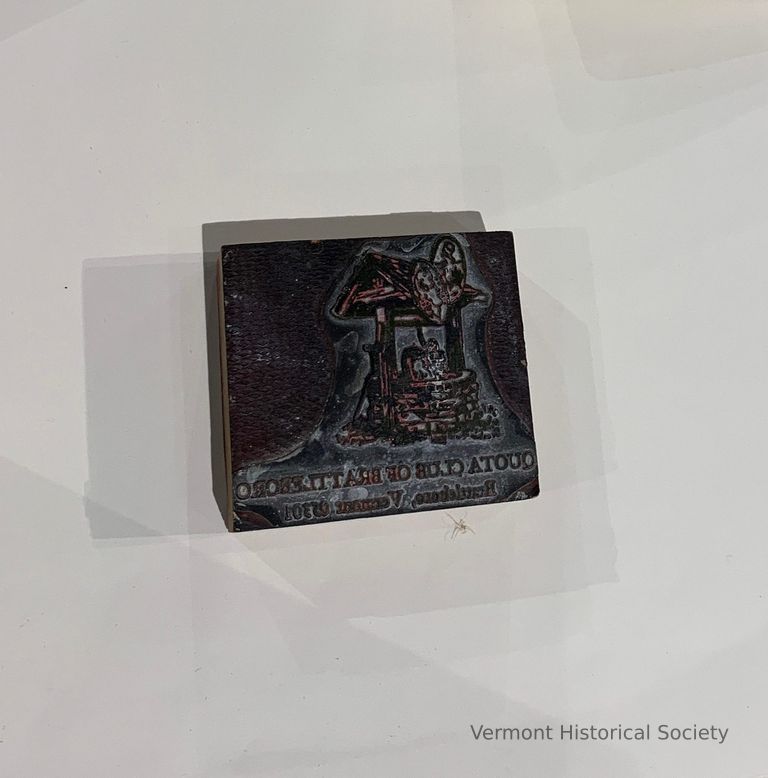
Printing Block
Name/Title
Printing Block
Lexicon
Description
Small square printing block depicting a small well. On the bottom is inscription in small backwards lettering "QUOTA CLUB OF BRATTLEBORO Brattleboro, Vermont 05301"
Depicting and describing the "Quota Club" also known as "Quota International," which was (until 2020) a network designed to empower specifically women, children, and the deaf community to ensure end of poverty and hunger within those communities.
Depicting and describing the "Quota Club" also known as "Quota International," which was (until 2020) a network designed to empower specifically women, children, and the deaf community to ensure end of poverty and hunger within those communities.
Use
Created by a student during printing classes held at the Austine School for the Deaf.
Acquisition
Accession
2024.16
Dimensions
Materials
Material Notes
Metal is the material of the block itself while ink would have been applied for the act of printing.
Material
Metal, Ink
Entry/Object ID
2024.16.7
Context
Austine School for the Deaf Brattleboro, VT
Web Links and URLs
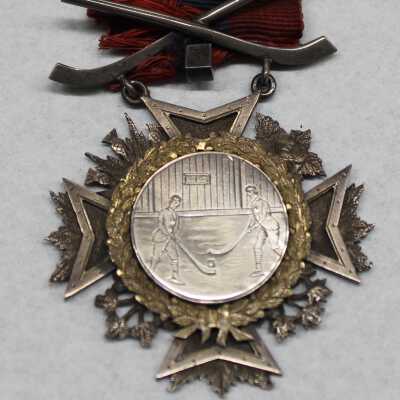
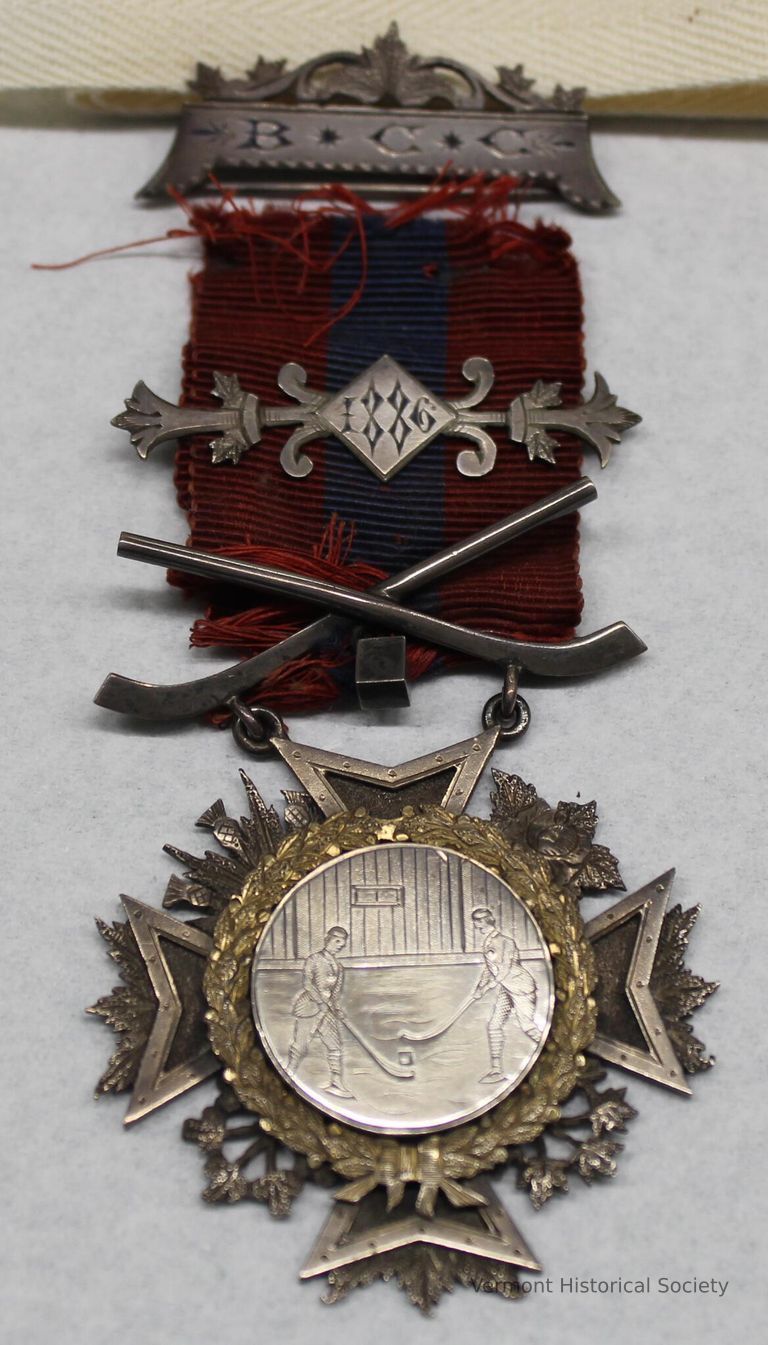
Prize Medal
Interpretative Labels
Label
Prize Medal, 1886
Metal, silk
In memory of J. Brooks Buxton, 2018.18.2ab
In 1886, the Vermont Coasting Club hosted a Winter Carnival in Burlington that boasted an attendance of 40,000. One of the highlights of the weekend--which also featured tobogganing, parades, concerts, ice yachting, and trotting races--was an exhibition hockey game between two clubs. The visiting team was the Montreal Crystals, a club team, and they faced a group of local Vermonters sponsored by a hotel called the Van Ness House. They played two ten-minute games and the Vermont team lost badly both times, but it was enough to go down in history as the first international hockey game played in America. It was also the beginning of a long tradition of hockey in Vermont.
Name/Title
Prize Medal
Lexicon
Description
Ornate gold and silver metal hanging from a red and blue blue ribbon secured by a metal pin. The pin at the top is rectangular with decorative leaves and scrollwork at the top. It is engraved with the letters BCC. The ribbon hangs from the pin by looping around a narrow bar at the bottom. The center of the ribbon is decorated with a bar pin with the inscription, "1886", at the center. A pair of crossed hockey sticks is at the bottom of the ribbon and small square puck, holding the medal. The medal is engraved at the center with a scene of two men playing hockey indoors. Each man is wearing a plaid, knee-length suit and a short bowler hat. The engraving is encircled with a gold laurel wreath and sits above an iron cross. Between each point of the cross are carved thistles, shamrocks, maple leaves, and oak leaves.
Acquisition
Accession
2018.18
Relationships
Related Person or Organization
Burlington Coasting Club
Person or Organization
Related Places
,
Made/Created
Date made
1886
Dimensions
Dimension Description
Overall
Materials
Material
Silver, Gold, Fabric, Metal
Entry/Object ID
2018.18.2a-b
Context
Medal presented to the winning team of the 1886 Vermont Winter Carnival Hockey Tournament. The initials at the top, BCC, stand for Burlington Coasting Club, and the medal was won by the Montreal Amateur Athletic Association.
Web Links and URLs
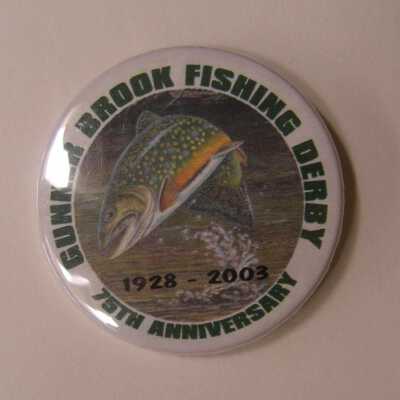
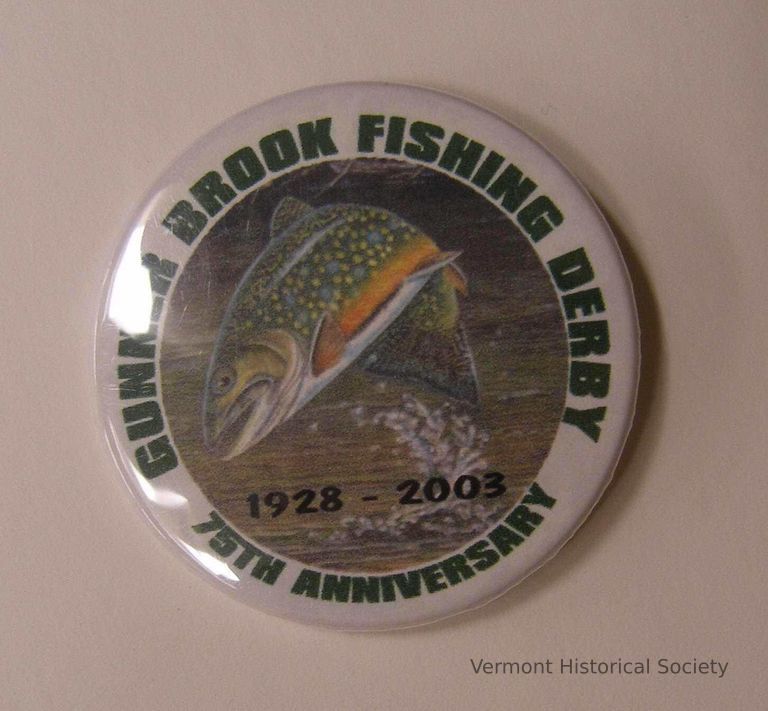
Promotional Button
Name/Title
Promotional Button
Lexicon
Description
Round white button with an image of a jumping trout in the center. The words, "GUNNER BROOK FISHING DERBY 75TH ANNIVERSARY" are printed around the edge and the dates "1928-2003" are printed beneath the fish. The back of the button is signed, "Best Wishes! Susan Winter" in sharpie. There is a hinged pin on the back.
Acquisition
Accession
2008.56
Relationships
Related Places
Place
Barre City
City
Washington County
County
Vermont
State/Province
United States of America
Country
North America
Made/Created
Date made
2003
Manufacturer
Winter, Susan
Dimensions
Dimension Description
Overall
Materials
Material
Metal
Entry/Object ID
2008.56.18
Context
The Gunner Brook Fishing Derby for children is sponsored by the Barre Fish and Game Club. The club was founded in 1919.
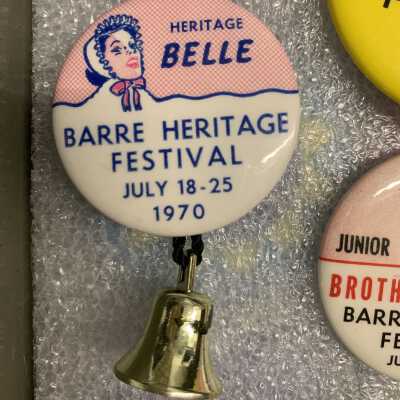

Promotional Button
Name/Title
Promotional Button
Description
A pink, white and blue pin with the image of a woman in a bonnet on the top left and the words "heritage belle." Below in blue lettering are the words, "Barre Heritage Festival, July 18-25, 1970."
Acquisition
Accession
2003.89
Relationships
Related Events
Barre Heritage Festival
Event
Related Places
Place
Barre City
City
Washington County
County
Vermont
State/Province
United States of America
Country
North America
Dimensions
Materials
Material
Metal
Entry/Object ID
2003.89.14
Context
The donor, Ruth R. Smith of Barre, was active in Republican politics and in many communities organizations.
Her obituary from https://www.hookerwhitcomb.com/obituary/4000351
Ruth R. Smith, 91, of Camp Street, passed away peacefully on Saturday, November 5, 2016, at home with her family at her bedside.
Born on December 27, 1924 in Northampton, MA, she was the daughter of the late Ralph Ernest and Maria W. Reynolds.
Ruth graduated from Northampton High School in Northampton, MA with the class of 1942. She received a Bachelor of Science degree from the University of Massachusetts in Amherst, MA in 1946 and continued her graduate studies in the field of economics at Mount Holyoke College in South Hadley, MA.
On October 11, 1947, she married Donald Ladd Smith of Barre Town, VT in Northampton, MA. He died on March 7, 2001. After their marriage, the couple moved to Vermont.
Ruth worked in the office of Cook, Watkins, and Patch before working as a reporter for the Montpelier Argus and Burlington Free Press for several years. In 1969, and she and her husband bought Windy Wood Orchard which she continued to operate until 2004. Ruth was also a licensed Casualty Insurance Agent and a Welcome Wagon Hostess for several years.
In addition to raising her family and working, Ruth was a member and former chair of the Barre Town School Board for 7 years, and Chair of the Barre Town Bicentennial Committee. She was also very involved in politics, she was a member of Washington County Republican Committee, former chair and secretary of the Barre Town Republican Committee, and a member of the Vermont House of Representatives from 1987-1994 representing Barre Town. Ruth served as Secretary of the Vermont State Republican Committee for 4 years, Chair of the Republican Mental Health Task Force for 6 years, Treasurer of the Vermont Federation of Republican Women, and as past President of the Vermont Legislative Women’s Auxiliary. She was an Incorporator and former member of the Board of Trustees of the Austine School for Deaf in Brattleboro, former member of the Vermont Federal Bank Advisory Board and a former member and co-chair of the Barre Granite Museum Study Committee.
In 1984, Ruth received a Greater Barre Community Service award, she was also presented with an Outstanding Legislator of the Year Award from the Sportsmen’s Alliance for Vermont’s Environment in 1988, and in 1996 she was awarded the Barre Town Citizenship and Service Award.
Ruth was the founding member and President of the ABH Extension Homemakers Club, as well as President of the Washington County Extension Homemakers. She was a Girl Scout troop leader and went on to serve as District Chairman and Officer of the Board of the Vermont Girl Scout Council. Ruth was a former officer of the Cobble Hill Grange and a member of the State and National Granges. She also served as Treasurer, Vice-President and eventually President of Altrusa International of Barre from 1995-1997. In 1948, Ruth joined the Barre Congregational Church and served in the roles of clerk and treasurer.
In her spare time, she enjoyed playing Contract Bridge, reading and travel.
She is survived by her son, Donald Reynolds Smith of Barre; her daughter Rebecca Ruth Smith Miracle of East Montpelier; and her granddaughters Brittany Jane and Halen Elizabeth Miracle of East Montpelier.
Besides her parents and husband, she is predeceased by her sisters Ernestine Moore and Marilyn Gray.
Her obituary from https://www.hookerwhitcomb.com/obituary/4000351
Ruth R. Smith, 91, of Camp Street, passed away peacefully on Saturday, November 5, 2016, at home with her family at her bedside.
Born on December 27, 1924 in Northampton, MA, she was the daughter of the late Ralph Ernest and Maria W. Reynolds.
Ruth graduated from Northampton High School in Northampton, MA with the class of 1942. She received a Bachelor of Science degree from the University of Massachusetts in Amherst, MA in 1946 and continued her graduate studies in the field of economics at Mount Holyoke College in South Hadley, MA.
On October 11, 1947, she married Donald Ladd Smith of Barre Town, VT in Northampton, MA. He died on March 7, 2001. After their marriage, the couple moved to Vermont.
Ruth worked in the office of Cook, Watkins, and Patch before working as a reporter for the Montpelier Argus and Burlington Free Press for several years. In 1969, and she and her husband bought Windy Wood Orchard which she continued to operate until 2004. Ruth was also a licensed Casualty Insurance Agent and a Welcome Wagon Hostess for several years.
In addition to raising her family and working, Ruth was a member and former chair of the Barre Town School Board for 7 years, and Chair of the Barre Town Bicentennial Committee. She was also very involved in politics, she was a member of Washington County Republican Committee, former chair and secretary of the Barre Town Republican Committee, and a member of the Vermont House of Representatives from 1987-1994 representing Barre Town. Ruth served as Secretary of the Vermont State Republican Committee for 4 years, Chair of the Republican Mental Health Task Force for 6 years, Treasurer of the Vermont Federation of Republican Women, and as past President of the Vermont Legislative Women’s Auxiliary. She was an Incorporator and former member of the Board of Trustees of the Austine School for Deaf in Brattleboro, former member of the Vermont Federal Bank Advisory Board and a former member and co-chair of the Barre Granite Museum Study Committee.
In 1984, Ruth received a Greater Barre Community Service award, she was also presented with an Outstanding Legislator of the Year Award from the Sportsmen’s Alliance for Vermont’s Environment in 1988, and in 1996 she was awarded the Barre Town Citizenship and Service Award.
Ruth was the founding member and President of the ABH Extension Homemakers Club, as well as President of the Washington County Extension Homemakers. She was a Girl Scout troop leader and went on to serve as District Chairman and Officer of the Board of the Vermont Girl Scout Council. Ruth was a former officer of the Cobble Hill Grange and a member of the State and National Granges. She also served as Treasurer, Vice-President and eventually President of Altrusa International of Barre from 1995-1997. In 1948, Ruth joined the Barre Congregational Church and served in the roles of clerk and treasurer.
In her spare time, she enjoyed playing Contract Bridge, reading and travel.
She is survived by her son, Donald Reynolds Smith of Barre; her daughter Rebecca Ruth Smith Miracle of East Montpelier; and her granddaughters Brittany Jane and Halen Elizabeth Miracle of East Montpelier.
Besides her parents and husband, she is predeceased by her sisters Ernestine Moore and Marilyn Gray.

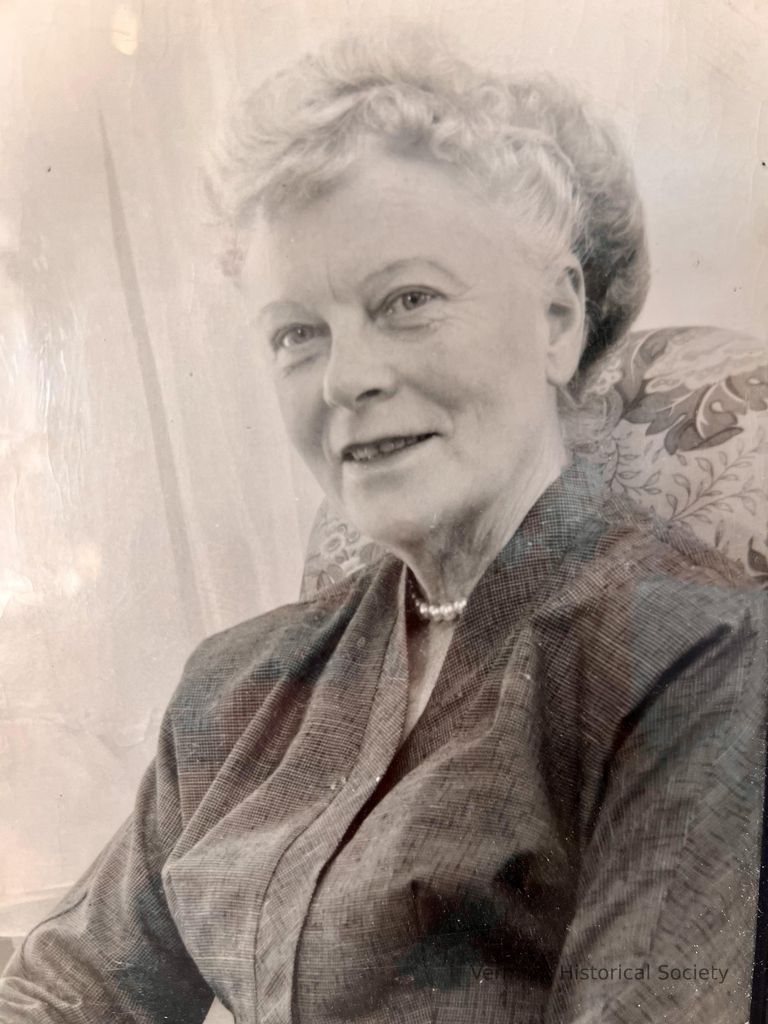
Quimby, Hortense Adelaide (1893-1967)
Name/Title
Quimby, Hortense Adelaide (1893-1967)
Description
Born: February 5, 1890 in West Stewartstown, NH
Died: January 10, 1967 in St. Johnsbury, VT
Primary Residence: Averill, Vermont
Pioneering resort owner, conservationist, and environmental resource proponent.
Died: January 10, 1967 in St. Johnsbury, VT
Primary Residence: Averill, Vermont
Pioneering resort owner, conservationist, and environmental resource proponent.
Biographical Information
Education
Teaching Certificate, Plymouth State Normal School (1909)
Biography
Born to Charles and Rose Quimby of West Stewartstown, New Hampshire, Hortense Quimby grew up spending the summers at her father's growing camp complex on the shores of Little Leach Pond (now called Forest Lake) in the unincorporated town of Averill, Vermont. After obtaining the property in 1894, Charles Quimby had a vision for a "Maine Style" hunting and fishing retreat for well-to-do gentlemen. He spent much of the early years stocking various types of game fish throughout the area lakes and ponds as well as developing primitive tent platforms and cabins for the clientele. Through this early exposure, Hortense became an early advocate for sport fishing in the northern Vermont woods.
Hortense Quimby attended the State Normal School at Plymouth, New Hampshire, and graduated with a teaching certificate. She relocated to New Jersey where she lodged with relatives and taught school for about ten years. Her father died unexpectedly in late 1919 and Hortense moved back to the Northcountry to take over management of her family's Cold Spring Camp. However, her vision for the camp went beyond a rustic hunting and fishing retreat on five leased acres. She wanted a camp that would be noted throughout the U.S. as a family fun resort with fishing, sports, games, and camaraderie for all ages.
In the winter of 1927 she served as a hostess on a Raymond Whitcomb tour of South Africa. The cruise also included stops in numerous islands, African ports, London, Naples, and Paris. She was quoted as crediting this experience as foundational to the development of her own resort. She expanded the original small camp to over 900 privately held acres, installing trails for horseback riding and hiking. She replaced the tents with private cabins and a main lodge and employed many local families in what we would now call a farm-to-table experience. By 1934, the resort hosted over 1,000 guests including Governor George Aiken and his guest Gov. Alfred Landon, the 1936 Republican presidential nominee, and actor Henry Fonda, and his children Peter and Jane. One of Hortense's often-quoted mottos was, "Roughing it with comfort."
Hortense Quimby was also a fish culturist, and was know throughout the state for her lobbying during the legislative session on behalf of measures beneficial to fishing in the state. In 1923 she created the first commercial fish hatchery in Vermont on a tributary of Big Averill Lake, raising Lake Trout, Salmon, and Brook Trout. Later, this fish "station" became a public-private partnership with the State of Vermont. In addition to stocking lakes and ponds, Hortense also lobbied for scientifically based bag limits to make sure fish thrived for future generations of anglers.
Hortense Quimby served as an informal ambassador for the State of Vermont, exhibiting at sports shows throughout the United States in the off-season and enticing visitors of all stripes to experience Vermont. Once enrolled in camp, most families returned year-after-year and generation-upon-generation.
Never marrying, Hortense Quimby managed and grew the Cold Spring Club from a very small operation into one of Vermont's premier summer resorts on her own. After falling ill in 1965 she sold the club to a group of regular guests who operated the camp as Quimby Country, Inc., named in her honor. Hortense Quimby died in 1967, yet the camp she developed for over half-a-century is still in operation today.
Occupation
Resort Owner
Teacher
Entry/Object ID
1.1.153
Web Links and URLs
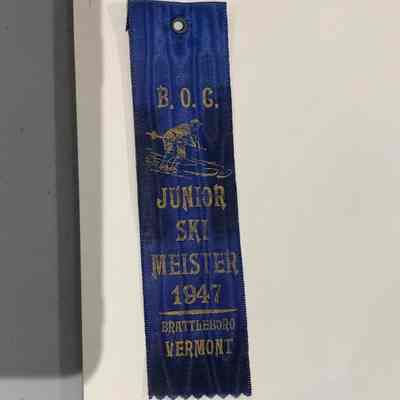
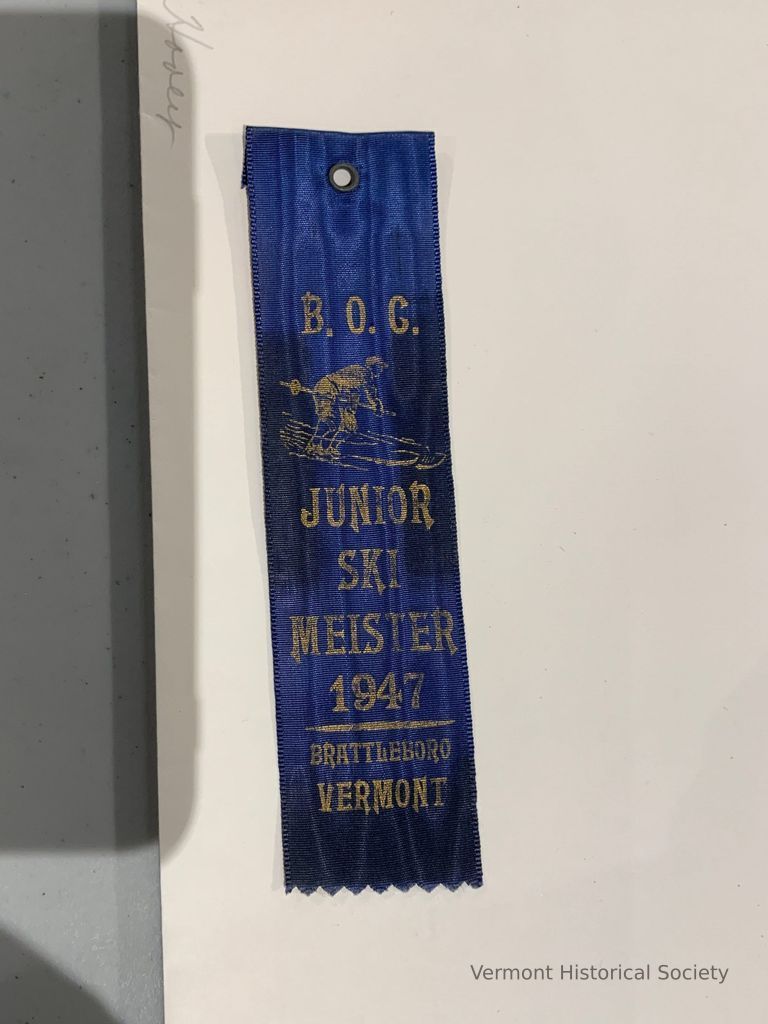
Ribbon Medal
Name/Title
Ribbon Medal
Description
Small dark Royal blue ribbon with inscription and outlined image of downhill skier in gold. Inscription: "B.O.C. JUNIOR SKI MEISTER 1947 BRATTLEBORO VERMONT." Includes snap where would have been fastened. Back small card reads: "Name: Herbie Holbrook, Class: 13-15, Award: 1st HODGES BADGE CO., BOSTON" with the details filled out in black script.
Given to Herbert Holbrook Austine School alumnus class of 1947 who was a class A award winning ski jumper.
Given to Herbert Holbrook Austine School alumnus class of 1947 who was a class A award winning ski jumper.
Acquisition
Accession
2024.16
Textile Details
Notes
Very very small textile made of sturdy dark royal blue ribbon with a silky sheen into the weaving.
Dimensions
Materials
Material Notes
The ribbon refers to the largest piece of material in the whole object which is the ribbon itself. This is secured to a small cardboard card in the back using a type of snap-like metal fastening (that is too tarnished at present to identify exact material of metal). The card is made of a thin cardboard-like material in order to be written on by a type of pen or ink writing.
Material
Ribbon, Metal, Cardboard
Entry/Object ID
2024.16.35
Context
Austine School for the Deaf Brattleboro, VT
Presented on the occasion of winning a competition from the Brattleboro Outing Club regarding ski jumping in 1947 (the year of his graduation from the Austine School for the Deaf) to Herbert P. Holbrook who was a class A ski jumper and olympic cross-country skier. He was an alumnus of the Austine School for the Deaf, and admitted to the AAAD (American Athletic Association for the Deaf) in 1964, when he also made the New York Times News twice that year. He competed in Berchtesgaden (West Germany) in the 60's and in the Meribel Olympics in France in 1979.
Presented on the occasion of winning a competition from the Brattleboro Outing Club regarding ski jumping in 1947 (the year of his graduation from the Austine School for the Deaf) to Herbert P. Holbrook who was a class A ski jumper and olympic cross-country skier. He was an alumnus of the Austine School for the Deaf, and admitted to the AAAD (American Athletic Association for the Deaf) in 1964, when he also made the New York Times News twice that year. He competed in Berchtesgaden (West Germany) in the 60's and in the Meribel Olympics in France in 1979.
Web Links and URLs
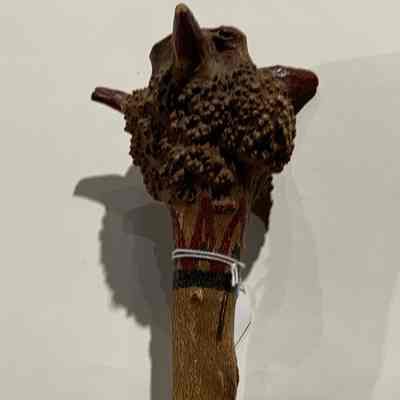
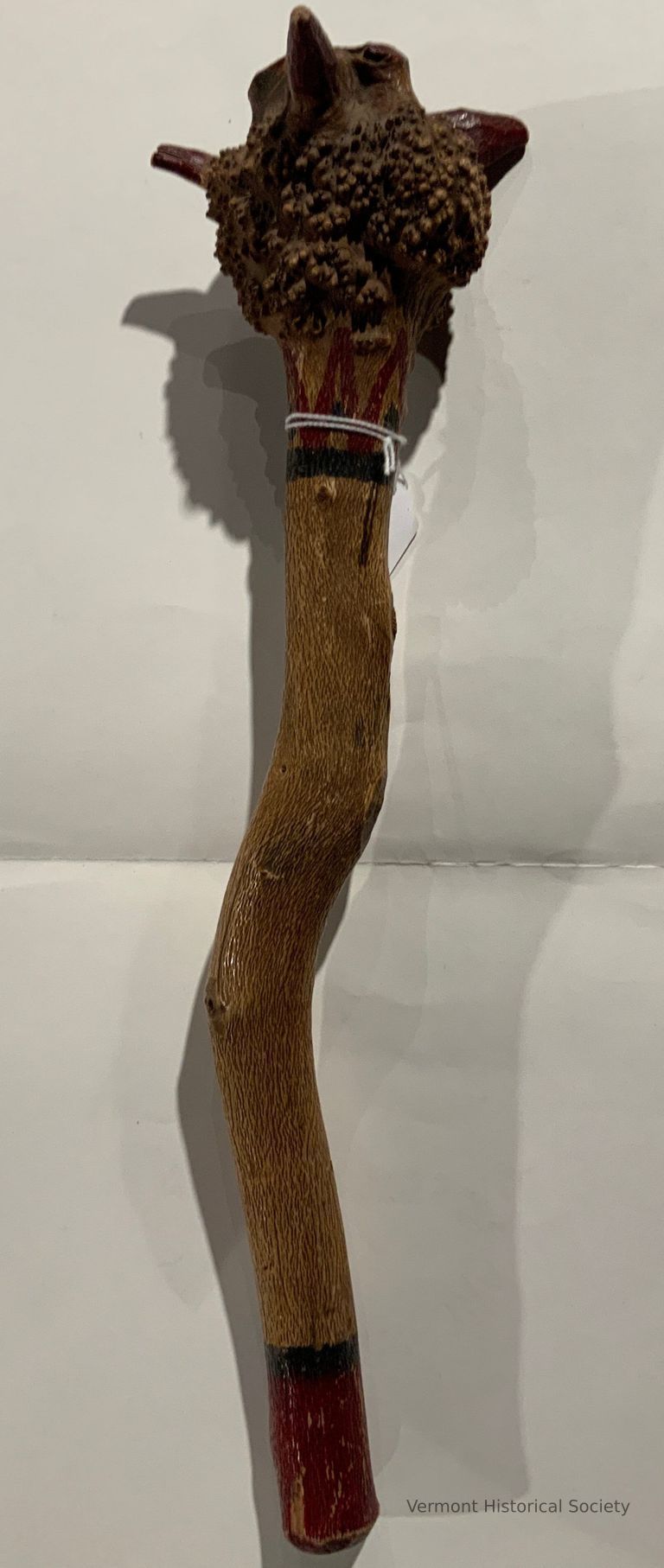
Root Club
Name/Title
Root Club
Lexicon
Description
Club crafted from natural root ball
Acquisition
Source (if not Accessioned)
Abenaki Cultural Conservancy
Made/Created
Date made
circa 1870
Materials
Material
Wood
Entry/Object ID
L2024.3.49

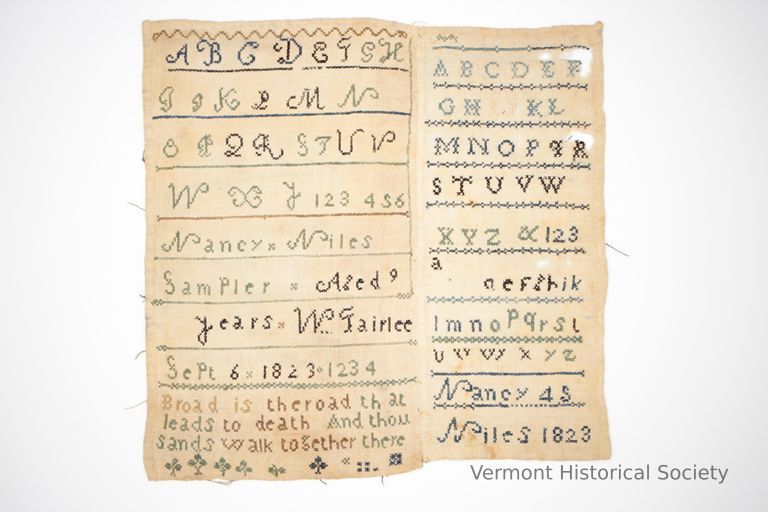
Sampler
Name/Title
Sampler
Lexicon
Description
Two alphabet samplers stitched together. The first sample has a capital alphabet in fancy script follow by the numbers 1-6 then the inscription, "Nancy Niles Sampler Aged 9 years W. Fairlee Sept 6 1823 1234 Broad is the road that leads to death and thou sands walk together there". Along the bottom are several variations of the suite of clubs. The second sampler has two alphabets--capital marking stitches and lower-case marking stitches--followed by the inscription, "Nancy 4s Niles 1823". Both samplers are stitched in light blue, dark blue, and brown threads.
Acquisition
Accession
1957.25
Relationships
Related Person or Organization
Niles, Nancy (1814-1888)
Person or Organization
Made/Created
Date made
1823
Manufacturer
Niles, Nancy (1814-1888)
Dimensions
Materials
Material
Linen, Silk, Cotton
Entry/Object ID
1957.25.39
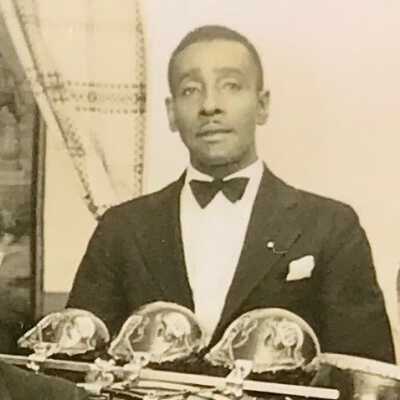
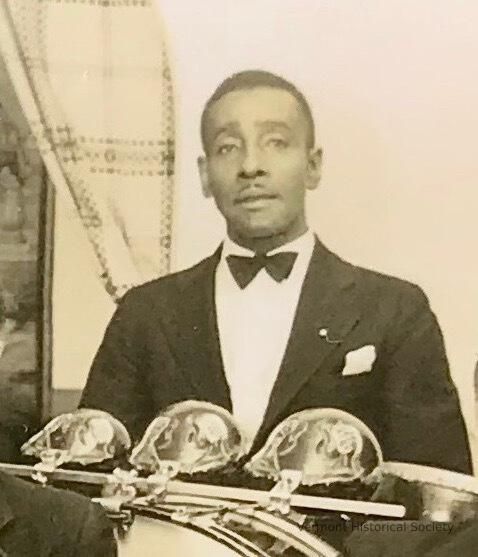
Satchell, Leroy Elmer (1888-1962)
Name/Title
Satchell, Leroy Elmer (1888-1962)
Also Known As
Roy Satchell
Description
Born: Feb. 3, 1888 in Elizabethtown, New York
Died: Jul. 9, 1962 in St. Albans, Vermont
Local musician in St. Albans, Vermont, who played with Sterling Weed's Imperial Orchestra in the 1920s and 1930s making that group the first integrated dance band in New England.
Died: Jul. 9, 1962 in St. Albans, Vermont
Local musician in St. Albans, Vermont, who played with Sterling Weed's Imperial Orchestra in the 1920s and 1930s making that group the first integrated dance band in New England.
Biographical Information
Biography
Leroy Satchell was born in Elizabethtown, New York, to William Satchell and Sophronia Davis. William formerly enslaved in North Carolina and joined the Union Army in 1864 serving as a cook until the war's end. He and his wife moved north to New York, later moving their young family to St. Albans, Vermont.
Leroy lived amongst a thriving Black community in St. Albans where he tried his hand at many jobs throughout his life. He was a laborer and a boot black; he operated a car wash station and served as a chauffeur. His prowess as a boxer and the leading hitter for the local baseball team was noted regularly in the papers. Despite his athletic success, Leroy's true passion and calling was as a musician.
Leroy was a gifted drummer and percussionist. He performed with the St. Albans Brigade Band and played timpani for the St. Albans Symphony Orchestra. He played regularly at dances, glee club events, winter pageants and ceremonies. He made his living at the time by accompanying silent films with a small orchestra at two of St. Albans silent movie theaters, the Bellevue and Empire Theatre. It was here that he met Ora, Lorenzo, and Sterling Weed, the leaders of Weeds Imperial Orchestra, a jazz band of some note.
As a member of Weeds Imperial Orchestra, he traveled around Northern New England, Southern Quebec, and up and down the East Coast playing music for thousands at local dances and events. As with many musicians, he supplemented his evening work by giving drum lessons during the day to young up-and-coming percussionists. After an automobile accident in 1930 left him unable to play or travel for a number of months, he brought in a young protege named Robert Williams to substitute for him so that Weeds Imperial Orchestra could fulfill it's performance schedule. Robert Williams, a young Black man with whose family Leroy had boarded in his younger days, was a student of Leroy's. Eventually the two men would trade dates with the group back and forth until the band stopped playing in the 1950s with the onset and popularity of "cowboy music".
In his later years, Sterling Weed recalled Leroy as an "artist on the drums whose playing was distinctive and very musical." Leroy died on July 9th, 1962, but his student, Robert Williams, went on to play with Weeds Imperial Orchestra after it regrouped in the 1970s and 1980s.
Entry/Object ID
1.2.30
Web Links and URLs
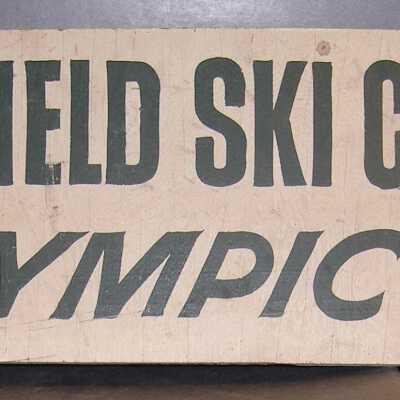

Sign
Interpretative Labels
Label
The Mount Mansfield Ski Club (originally the Stowe Ski Club) was incorporated in 1934. Its ski program trained and mentored thousands of young skiers, many of whom became Olympic team members and medalists. This sign incorporates the distinctive "Stowe" logo created in the 1950s by artist Sasha Mauer, and now utilized by the town and many businesses in the area. The "S" in Stowe is a swoosh made from the tracks of a skier.
Name/Title
Sign
Lexicon
Description
Rectangular plywood sign painted white with the green inscription, "MT. MANSFIELD SKI CLUB / Stow VERMONT / POST OLYMPIC RACES".
Acquisition
Accession
2008.79
Relationships
Related Person or Organization
Mount Mansfield Ski Club
Person or Organization
Related Places
Place
Stowe
Town
Lamoille County
County
Vermont
State/Province
United States of America
Country
North America
Made/Created
Date made
circa 1980
Dimensions
Dimension Description
Overall
Materials
Material
Wood
Entry/Object ID
2008.79

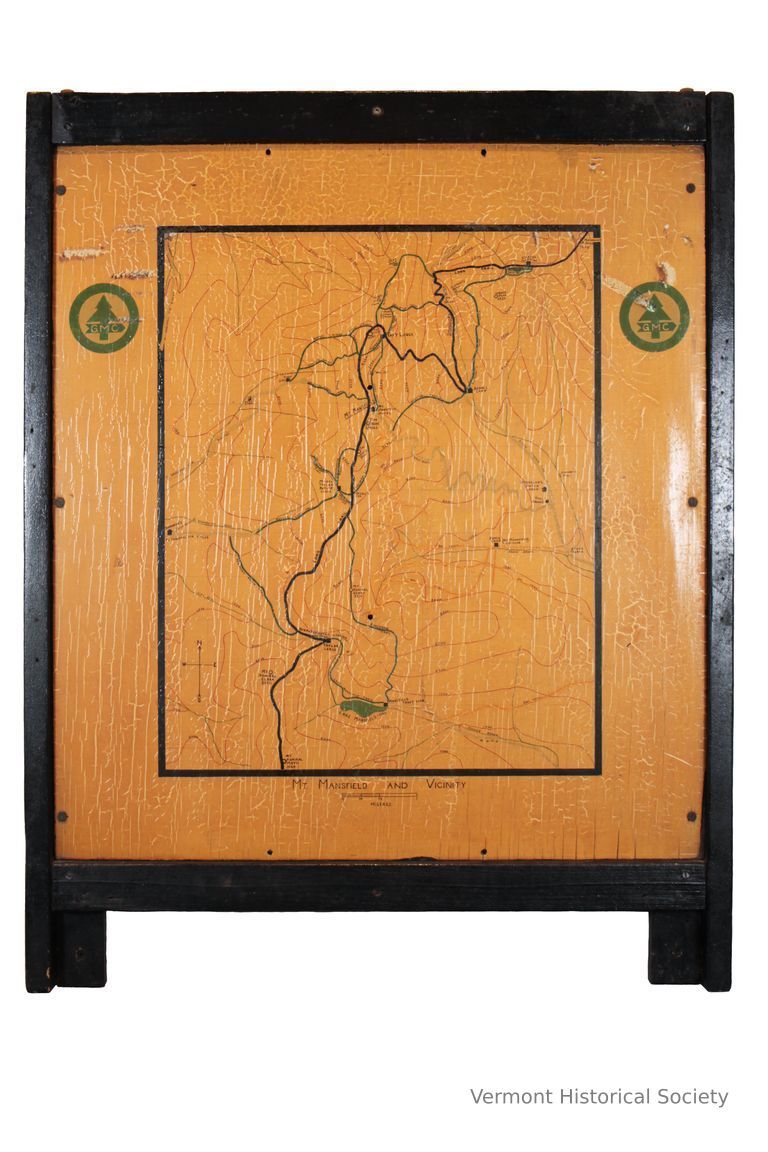
Sign
Interpretative Labels
Label
Trail Map, 1940
Elton Ray Beal (1897-1971)
Burlington, Vermont
Paint on board
Gift of Merlin Lloyd Acomb, #1989.1.2
An employee of UVM’s engineering school, Elton Beal spent free time as a volunteer with the Green Mountain Club. Though posted trail maps are common at all trail heads today, this type of information was not as readily available in the early years of the Long Trail. This hand-painted sign shows much of the Mount Mansfield section with lodges and side trails noted.
Name/Title
Sign
Lexicon
Description
Yellow sign framed in black and printed with an elevation map of Mt. Mansfield with the Long Trail and other trails marked. Taft Lodge and other lodges are also marked. The Green Mountain Club logo--a pine tree in a circle with GMC--is shown twice. A small title under the map reads "MT. Mansfield and Vicinity" The scale for this map is 1/2mile = 1 1/2". Written on the back is the inscription, "This map painted c. 1940 by Elton Ray Beal (1897-1971) of 77 Pomeroy St.., Burlington, VT. He was employed by the Engineering Dept. of the University of Vermont, and was an active member of the GMC."
Acquisition
Accession
1989.1
Relationships
Related Person or Organization
Green Mountain Club
Person or Organization
Related Places
,
Made/Created
Date made
1940-1950
Dimensions
Dimension Description
Overall
Materials
Material
Wood, Paint
Entry/Object ID
1989.1.2
Context
Made by the Green Mountain Club to show trails and lodges in Mount Mansfield, including the Long Trail.
Web Links and URLs
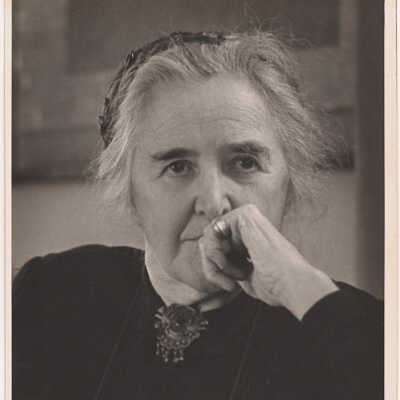
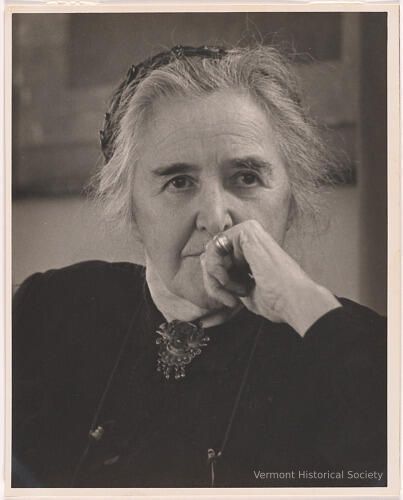
Sipprell, Clara Estelle (1885-1975)
Name/Title
Sipprell, Clara Estelle (1885-1975)
Description
Born: October 31, 1885 in Tillsonburg, Ontario
Died: December 27, 1975 in Manchester, Vermont
Primary Residence: Manchester
Best known for her work in photography during the pictorialist movement. Recipient of numerous awards and published works and set-up exhibitions in the United States and Europe. Cityscape, "New York - Old and New" was one of the first photographs obtained by the Museum of Modern Art in the 1930s.
Died: December 27, 1975 in Manchester, Vermont
Primary Residence: Manchester
Best known for her work in photography during the pictorialist movement. Recipient of numerous awards and published works and set-up exhibitions in the United States and Europe. Cityscape, "New York - Old and New" was one of the first photographs obtained by the Museum of Modern Art in the 1930s.
Biographical Information
Biography
Clara E. Sipprell is best known for her work as a portrait photographer during the pictorialist movement. She proved to be one of the leading practitioners in the United States of this aesthetic art form, which involved creating photographs with a soft focus, giving them the visage of a painting. She received numerous awards in exhibitions and published works in United States and European magazines. Sipprell often took photographs of prominent people in the arts and government, in addition to the many individuals she encountered in her worldly travels to Yugoslavia, Russia, Italy, Mexico, and Sweden. Some of her most famous subjects were the members of Stanislavsky's Moscow Art Theatre, King Gustav of Sweden, Albert Einstein, Robert Frost, Edwin Markham, and Pearl Buck.
Born in Tilsenburg, Ontario in 1885, Sipprell moved with her mother at the age of ten to Buffalo, New York where her brother Francis James Sipprell owned a portrait studio. It was here where she began her life's work, leaving school at the age of sixteen to devote all of her time to the studio,eventually becoming a partner in the business. During this period, artificial lighting was growing in popularity among photographers, including her brother. However, many sources indicate that Sipprell developed her own standards as she continued using natural light, never cropping her photographs, or retouching her negatives. She used a large 8" by 10" camera, usually with a soft-focus lens. Unlike many modern photographers who take hundreds of photographs and then choose the best, Sipprell "stalked" her subjects, studied them and then shot only when she really felt she had caught the "moment of light."
Sipprell won numerous prizes through the Buffalo Camera Club at a time when women were forbidden to have membership.
At the age of thirty, in 1915, Sipprell moved to New York City with Jessica Beers and opened her own photographic studio in Greenwich Village. She also became the contract photographer for the Ethical Culture School, where Beers worked as a principal. She gained considerable technical knowledge during her time in New York City through contact with leading photographers in the city. She joined the Pictorial Photographers of America, the Royal Photographic Society of Great Britain, and the Arts Club of Washington.
The 1920s and 1930s were a period of high acclaim for Sipprell, as she received many prizes from various exhibitions at home and abroad for not only her portraits, but also her still-lifes and landscapes. Her cityscape, "New York - Old and New" was one of the first photographs obtained by the Museum of Modern Art in the 1930s.
Throughout her stay in New York City, Sipprell spent her summers in Vermont. Her connection with Thetford began in 1917 when she took a series of photographs for Camp Hamoum, a girls' overnight camp located on Thetford Hill. Two years later, she illustrated the Camp's catalog. She maintained a studio in Thetford for seventeen years.
The Thetford phase of Sipprell's career was probably her most productive. During those years she participated in nearly a hundred exhibitions and illustrated many magazine articles.
In 1954, Sipprell moved her studio to Manchester, Vermont and lived with Phyllis Fenner, a writer, librarian, and anthologist of children's books. It was here that Sipprell died at the age of 89 in 1975. Her ashes are buried in Manchester.
In 1974 Sipprell received the Vermont Governor's Award for Excellence in the Arts. Recent solo exhibits of her work were at the Albright-Knox gallery in Buffalo, New York, the Vermont Historical Society in 1988, the Amon Carter Museum in Forth Worth, Texas in 1990, and at the Thetford Historical Society in 1993. Two books about her work have appeared: her own "Moment of Light" (1966) and Mary K. McCabe's "Clara Sipprell, Pictorial Photographer" (1990).
Occupation
Photographer
Entry/Object ID
1.1.81
Web Links and URLs
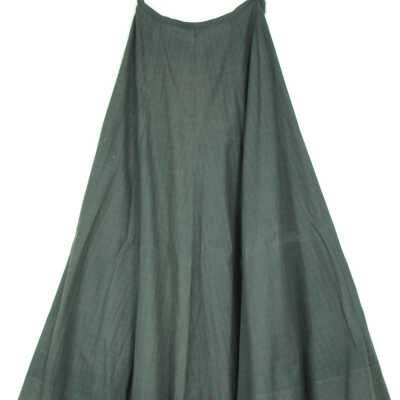
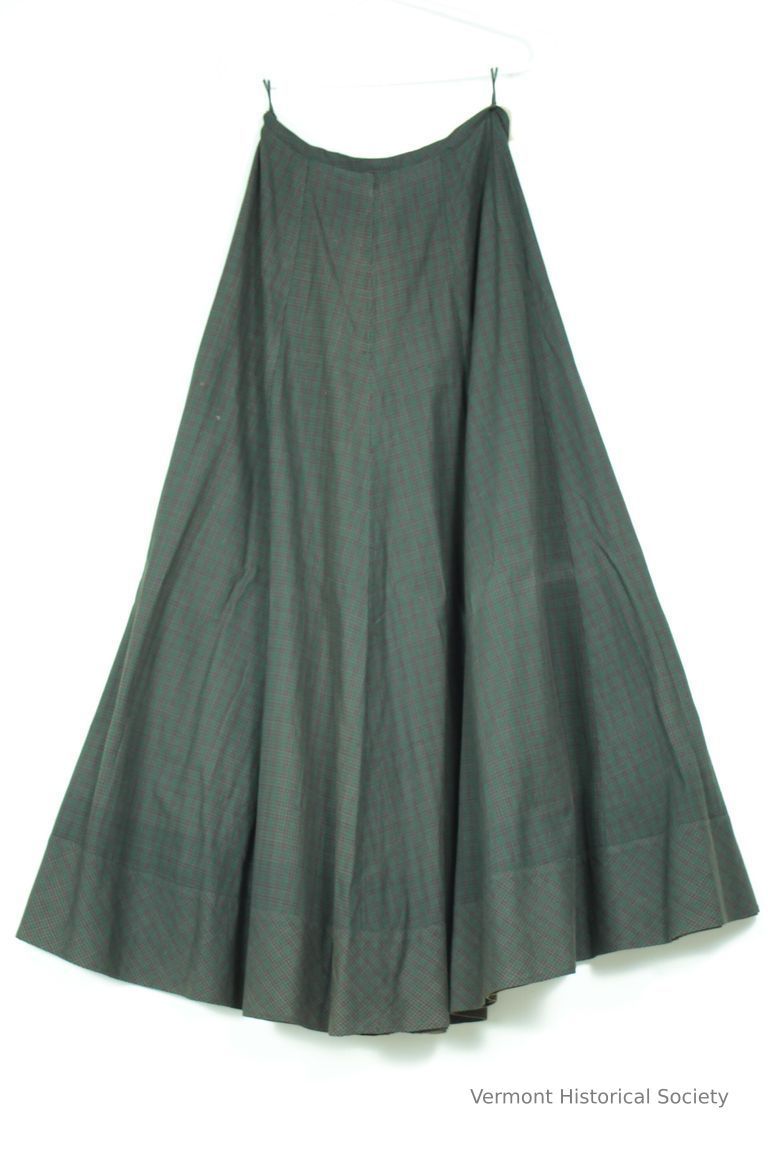
Skirt
Name/Title
Skirt
Lexicon
Clothing/Dress/Costume Details
Article of Clothing/Dress/Costume
Skirt
Textile Details
Wool
Material
Clothing Sex
Female
Description
Green plaid wool gored skirt.
Acquisition
Accession
2014.60
Relationships
Related Person or Organization
Smith, Ethel Carswell (1875-1958)
Person or Organization
Related Places
Place
Barre City
City
Washington County
County
Vermont
State/Province
United States of America
Country
North America
Made/Created
Date made
circa 1900
Entry/Object ID
2014.60.1282
Context
Worn by Ethel C. Smith of Barre, Vermont. She was born in Scotland in 1875 and came to the United States in 1888. She married Donald Smith in 1899 and they had two sons. She was a charter member of the Barre Flower Club.
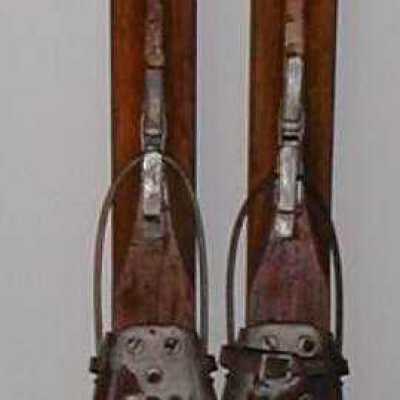

Snow Skis
Interpretative Labels
Label
Skis, circa 1909
Owned by James P. Taylor (1872-1949)
Saxtons River, Vermont
Gift of Clarence P. Cowles, #1954.2
Proponent of the Long Trail and founder of the Green Mountain Club, James P. Taylor was a true cheerleader for Vermont outdoor recreation. As early as 1909 he used these skis to lead tours of southern Vermont backcountry.
Name/Title
Snow Skis
Lexicon
Description
Long wooden skis. The skis are heavily varnished, and have metal attachments at the center for shoes. The attachments have adjustable lengths, and leather straps across the top.
Acquisition
Accession
1954.2
Relationships
Related Person or Organization
Taylor, James P.
Person or Organization
Related Places
Place
Saxtons River
Village
Rockingham
Town
Windham County
County
Vermont
State/Province
United States of America
Country
North America
Made/Created
Date made
circa 1910
Dimensions
Dimension Description
Overall
Materials
Material
Wood
Entry/Object ID
1954.2a-b
Context
Owned by James P. Taylor, who started organized skiing in 1909 at Saxton's River, VT.
Web Links and URLs
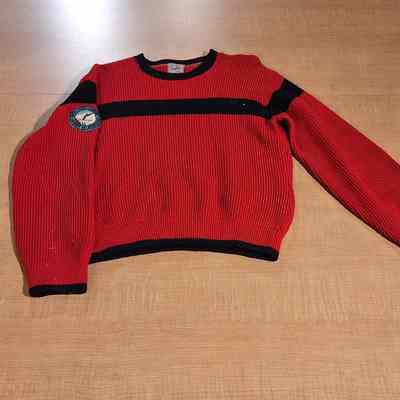

Sweater
Name/Title
Sweater
Lexicon
Clothing/Dress/Costume Details
Article of Clothing/Dress/Costume
Sweater
Textile Details
Red
Black
Color
Knit
Description
Red and black knit wool sweater. The crew neck sweater is red with a ribbed stitch pattern. The collar, cuffs, and waist have a short black border and there is a thicker black stripe across the chest and sleeves. The sweater has a patch sewn onto the right arm just below the black stripe that is blue with a ski jumper in a red snowsuit. Around the image are the words "UNITED STATES EASTERN AMATEUR SKI ASSOCIATION" in black lettering.
The sweater has a label that reads "The Kandahar by Bert Charon N.Y. 100% all virgin wool" sewn into the back of the neck.
This sweater was worn by Herbert Holbrook during ski jump practices and competitions.
The sweater has a label that reads "The Kandahar by Bert Charon N.Y. 100% all virgin wool" sewn into the back of the neck.
This sweater was worn by Herbert Holbrook during ski jump practices and competitions.
Acquisition
Accession
2024.16
Dimensions
Entry/Object ID
2024.16.46
Context
Austine School for the Deaf Brattleboro, VT
Worn by Herbert P. Holbrook who was a class A ski jumper and olympic cross-country skier. He was an alumnus of the Austine School for the Deaf, and admitted to the AAAD (American Athletic Association for the Deaf) in 1964, when he also made the New York Times News twice that year. He competed in Berchtesgaden (West Germany) in the 60's and in the Meribel Olympics in France in 1979. The sweater refers to the United States Eastern Amateur Ski Association, an Olympic skiing organization established 1922 by Doctor Raymond S. Elmer (Vermonter) in Saranac Lake, NY. (Likely earned by Holbrook when he was funneled from the Brattleboro Outing Club into the association)
Worn by Herbert P. Holbrook who was a class A ski jumper and olympic cross-country skier. He was an alumnus of the Austine School for the Deaf, and admitted to the AAAD (American Athletic Association for the Deaf) in 1964, when he also made the New York Times News twice that year. He competed in Berchtesgaden (West Germany) in the 60's and in the Meribel Olympics in France in 1979. The sweater refers to the United States Eastern Amateur Ski Association, an Olympic skiing organization established 1922 by Doctor Raymond S. Elmer (Vermonter) in Saranac Lake, NY. (Likely earned by Holbrook when he was funneled from the Brattleboro Outing Club into the association)
Web Links and URLs


T-Shirt
Name/Title
T-Shirt
Lexicon
Clothing/Dress/Costume Details
Article of Clothing/Dress/Costume
Shirt
Textile Details
Jersey
Fabric
Cotton
Material
Clothing Sex
Unisex
Size
Large
Description
Yellow t-shirt printed in green with the words, "GREEN MOUNTAIN CLUB / THE LONG TRAIL / VERMONT". The words, "The Long Trail," are within a silhouette of a directional sign.
Acquisition
Accession
1976.37
Relationships
Related Person or Organization
Green Mountain Club
Person or Organization
Related Places
Place
Long Trail
* Untyped Place
Vermont
State/Province
United States of America
Country
North America
Made/Created
Date made
1976
Manufacturer
B. V. D.
Entry/Object ID
1976.37.2

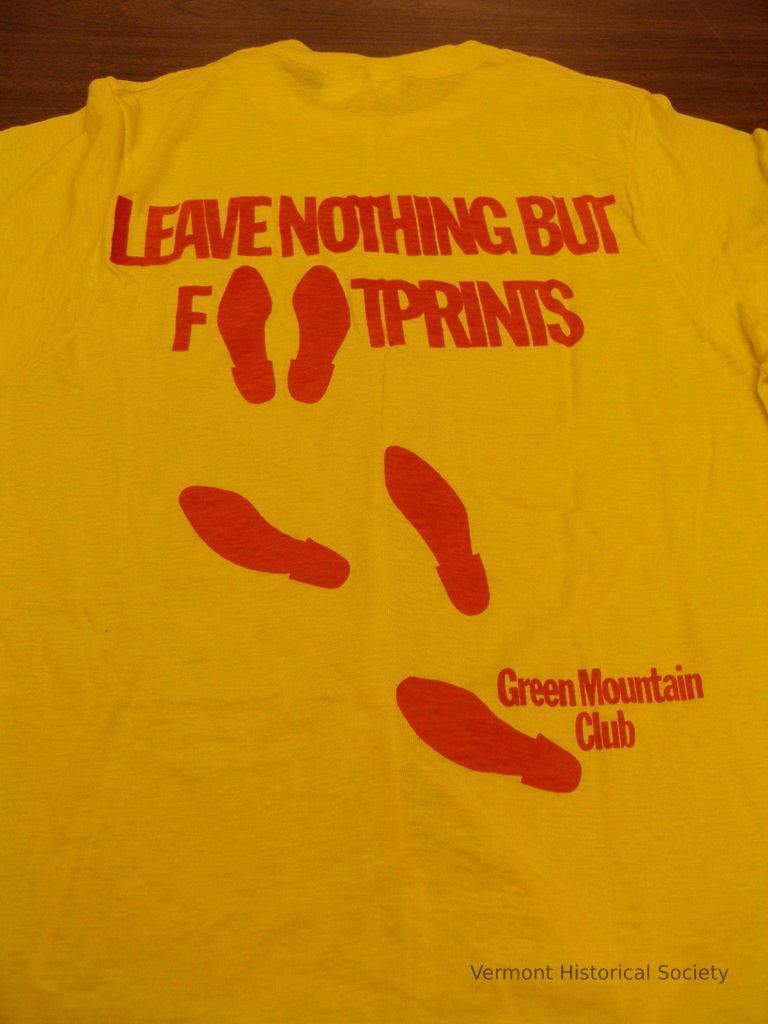
T-Shirt
Name/Title
T-Shirt
Lexicon
Clothing/Dress/Costume Details
Article of Clothing/Dress/Costume
Shirt
Textile Details
Jersey
Fabric
Cotton
Material
Clothing Sex
Unisex
Size
Medium
Description
Yellow cotton t-shirt printed on the back in red with the words, "LEAVE NOTHING BUT FOOTPRINTS / Green Mountain Club". There are footprints up the shirt and forming the two Os within the word footprints.
Acquisition
Accession
1976.37
Relationships
Related Person or Organization
Green Mountain Club
Person or Organization
Related Places
Place
Long Trail
* Untyped Place
Vermont
State/Province
United States of America
Country
North America
Made/Created
Date made
1976
Manufacturer
B. V. D.
Entry/Object ID
1976.37.3

Taylor, Elizabeth (1856-1932)
Name/Title
Taylor, Elizabeth (1856-1932)
Description
Born: January 8, 1856 in Columbus, Ohio
Died: March 8, 1932 in Rochester, Vermont
Discovered and recorded two unknown insects, one of which was given her nane Pseudosiana Taylori. First Caucasian woman to accompany the Hudson Bay Fur Company on a fur-gathering expedition down Canada's MacKenzie River to its delta.First English-speaking woman to traverse Norway's Hardanger Vidda, the upland summer pastures, throughout its greatest length and over its highest ridges.
Died: March 8, 1932 in Rochester, Vermont
Discovered and recorded two unknown insects, one of which was given her nane Pseudosiana Taylori. First Caucasian woman to accompany the Hudson Bay Fur Company on a fur-gathering expedition down Canada's MacKenzie River to its delta.First English-speaking woman to traverse Norway's Hardanger Vidda, the upland summer pastures, throughout its greatest length and over its highest ridges.
Biographical Information
Biography
Elizabeth Taylor, artist, writer, botanist and explorer, was born in Columbus, Ohio on January 8, 1856. The fifth daughter of Chloe (Langford) and James J. Taylor, American Consul in Winnepeg (1870-1893), experienced her first trip at the age of six months when the family moved to St. Paul, Minnesota, her father's home state. Taylor was raised with education and adventure. Accompanying her father on frequent business trips throughout Canada, Minnesota and Washington, Taylor developed a love for nature and the great outdoors.
Taylor attended art school, first in New York and later in Paris, and continued private endeavors in Venice, Florence and other locations. During her father's twenty-year tenure as consul to Manitoba, she traveled (often alone) under the protection of the Catholic Church and experienced the wild grandeur and the then untouched beauty of the Canadian Northwest.
Taylor attended the last great Sun Dance allowed to be given by the Indian tribes of Canada and was the first white/Caucasian/non-native woman to accompany the Hudson Bay Fur Company on a fur-gathering expedition down the MacKenzie River to its delta " the land of the Eskimo. Later trips took her to Alaska and in 1893 she toured Norway on ponyback, "traversing Hardanger Vidda, the upland summer pastures, throughout its greatest length and over its highest ridges."
In 1895 while headed to Iceland to study Eider Duck farms, Taylor's boat stopped at Thorshavn, capital city and principal port of the Danish Faroe Islands. After one look at this desolate spot with its little sod-roofed wooden houses, Taylor knew she would return. Five years later, in May of 1900, Taylor returned to the islands for an almost six-year stay, "always curious about nature and mankind, feeling that no hardships were too great if she could catch an elusive fish, get a glimpse of a certain rare flower or watch the great whale hunts." Taylor would next return to these same islands in early 1914, and was effectively "marooned" throughout World War I, performing relief work among an almost starving people who expected at any time to fall under the German army. She studied plant and bird life and immersed herself in the folklore, superstitions, customs and dances of the Faroes. As an amateur botanist, she was the first to discover and record two unknown insects, one of which was given her name, Pseudosiana Taylori.
Taylor wrote of her amazing and oftentimes harrowing experiences, submitting her stories to British and American newspapers and magazines. However, "writing did not come easy to Mistela (as the Faroe Islanders called her) -- one short article would take months of study and of concentrated and conscientious labor."
In July 1919, at the age of sixty-three Taylor said goodbye to her beloved Faroe Islands for the last time. Five years later found her in Rochester, having visited Vermont in 1888 and again, in 1908 when she had spent part of a summer in Dorset. In 1909 she had been in Windham and Bennington giving club talks about her Faroe Island adventures. For the following two summers she was a summer boarder at the small Rochester North Hollow farm of Mrs. Blanche Dunham Hubbard, doing a little painting and writing two articles for the Atlantic Monthly. But it wasn't until many years later in 1924 that Taylor returned permanently to North Hollow and built a rather primitive two-room cabin on the Hubbard property. Her love of flowers resulted in beautiful flower and rock gardens at Wake Robin Cabin, where today many of those flowers still return each Spring.
Taylor died on Tuesday, March 8, 1932 at 6:00 in the evening.
Occupation
Explorer
Artist
Journalist
Botanist
Entry/Object ID
1.1.141
Web Links and URLs
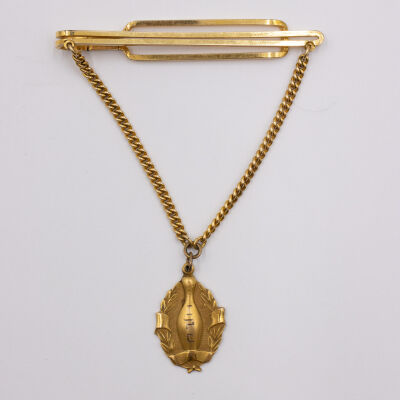
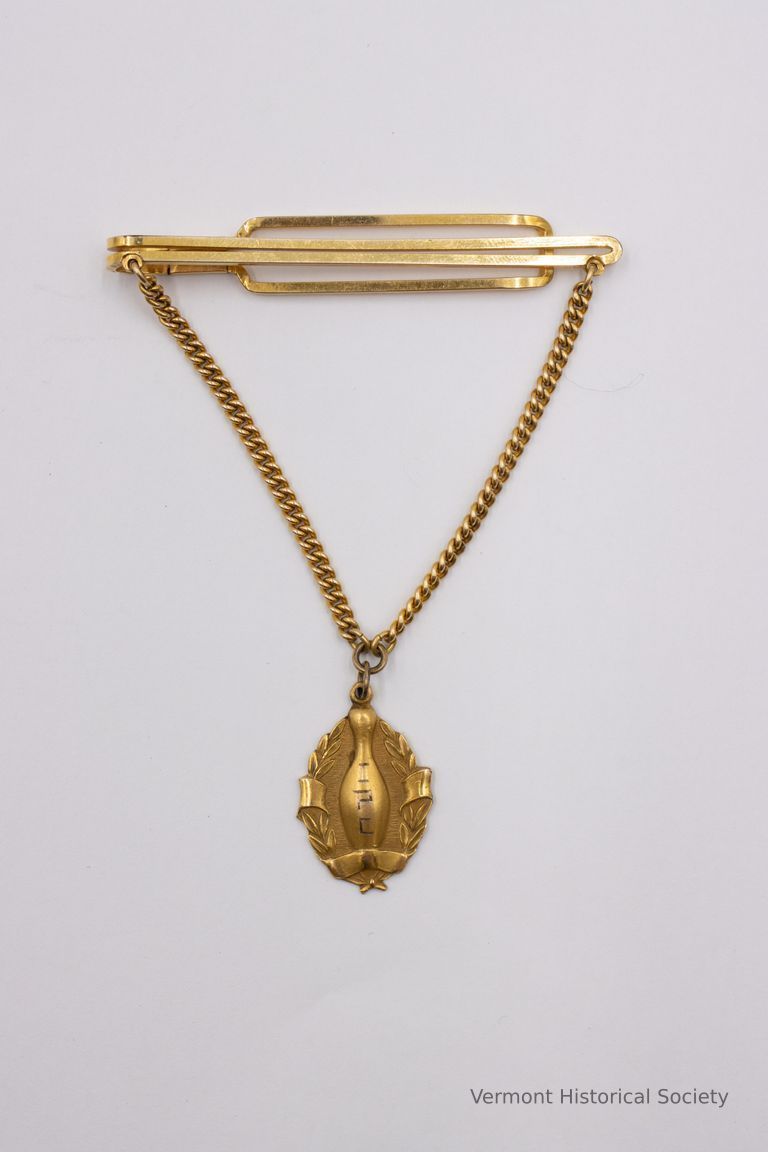
Tie Clip
Name/Title
Tie Clip
Lexicon
Description
Brass tie clip with an oval medallion. The medallion hangs from the clip at the center of two lengths of chain. The medallion has a bowling pin engraved with the letters "IPC"; the border is a laurel wreath.
Acquisition
Accession
2022.59
Materials
Material
Brass
Entry/Object ID
2022.59.2
Context
Owned by Renato Ferrari of Barre, VT, as a member of the Italian Pleasure Club
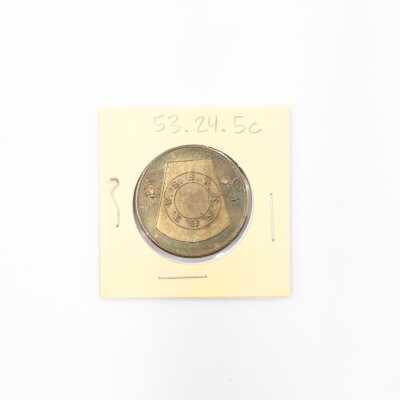
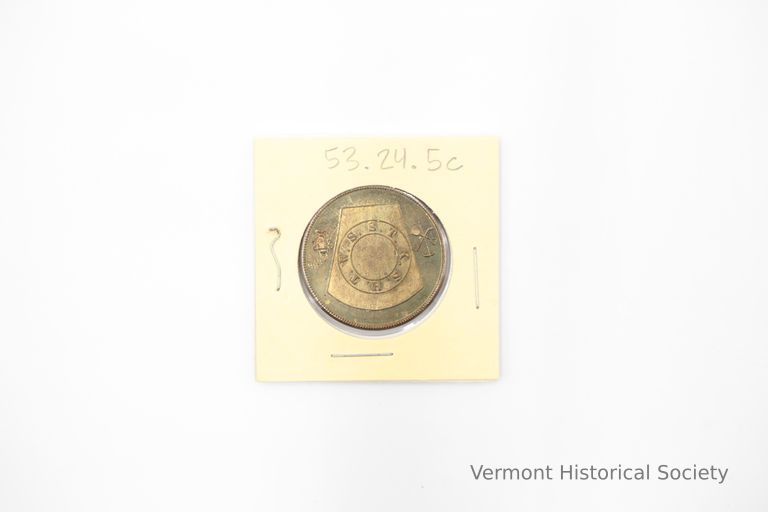
Token
Name/Title
Token
Lexicon
Description
Brass token with masonic imagery on one side and an inscription on the other. One side has a wedge (possibly representing a fez hat) with circle on the inside bearing the inscription, "H T W S S T K S". Flanking the shape are a set of masonry tools and an urn. The other side has the inscription "ONE PENNY" in the center, "SKITCHEWAUG CHAPTER NO. 25 R. A. M. / SPRINGFIELD, VT." around the outer edge, and "CHARTERED JUNE 13, 1873" inside of the first.
Use
Could be used as proof of membership in the order, souvenirs, or for gambling within the club.
Acquisition
Accession
1953.24
Relationships
Related Person or Organization
Freemasons
Person or Organization
Related Places
Place
White River Junction
Village
Hartford
Town
Windsor County
County
Vermont
State/Province
United States of America
Country
North America
Made/Created
Time Period
19th Century
Dimensions
Dimension Description
Overall
Materials
Material
Brass
Entry/Object ID
1953.24.5c
Context
Produced by the Cascadnac Chapter of the Masons in White River Junction, Vermont

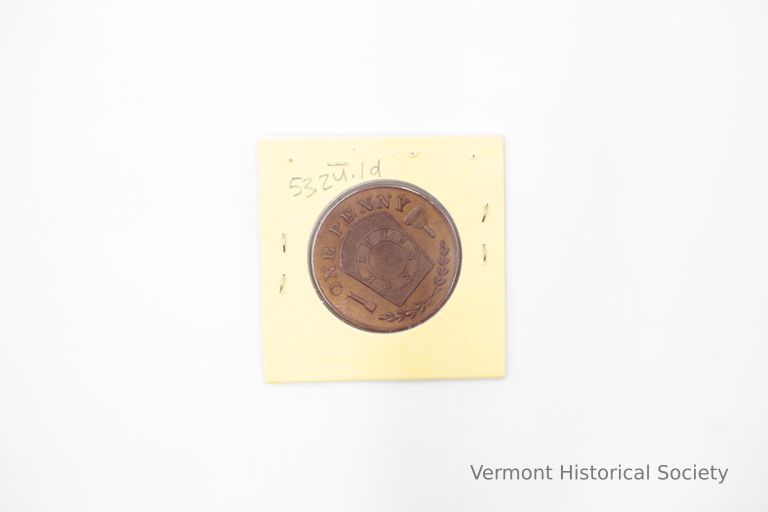
Token
Name/Title
Token
Lexicon
Description
Copper token with the words "ONE PENNY" on the obverse with an olive branch at the bottom, a tablet with a circle of initials "H T W S S T K S" in the center, a chisel, and a funnel. On the other side of the token are the words, "Cleveland Chapter No. 20 R.A.M. Newport, Vt.”
Use
Could be used as proof of membership in the order, souvenirs, or for gambling within the club.
Acquisition
Accession
1953.24
Relationships
Related Person or Organization
Freemasons
Person or Organization
Related Places
Place
Newport
City
Orleans County
County
Vermont
State/Province
United States of America
Country
North America
Made/Created
Time Period
19th Century
Dimensions
Dimension Description
Overall Notes:
Materials
Material
Copper
Entry/Object ID
1953.24.1d
Context
Produced for the Cleveland Chapter of the Freemasons in Newport, Vermont.
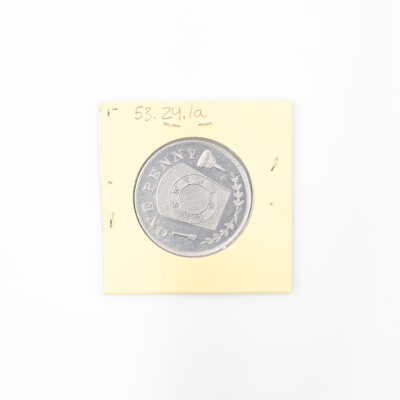
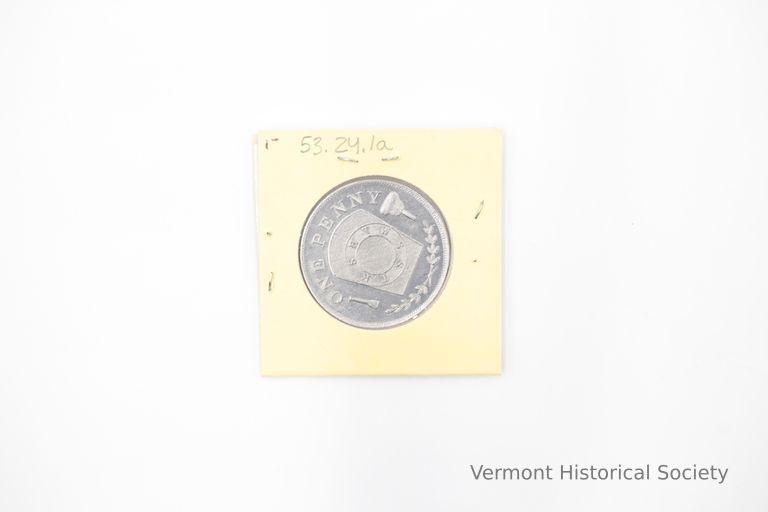
Token
Name/Title
Token
Lexicon
Description
Silver-toned metal token with the words "ONE PENNY" on the obverse with an olive branch at the bottom, a tablet with a circle of initials "H T W S S T K S" in the center, a chisel, and a funnel. On the other side of the token are the words, "Cleveland Chapter No. 20 R.A.M. Newport, Vt.”
Use
Could be used as proof of membership in the order, souvenirs, or for gambling within the club.
Acquisition
Accession
1953.24
Relationships
Related Person or Organization
Freemasons
Person or Organization
Related Places
Place
Newport
City
Orleans County
County
Vermont
State/Province
United States of America
Country
North America
Made/Created
Time Period
19th Century
Dimensions
Dimension Description
Overall Notes:
Materials
Material
Aluminum
Entry/Object ID
1953.24.1a
Context
Produced for the Cleveland Chapter of the Freemasons in Newport, Vermont.

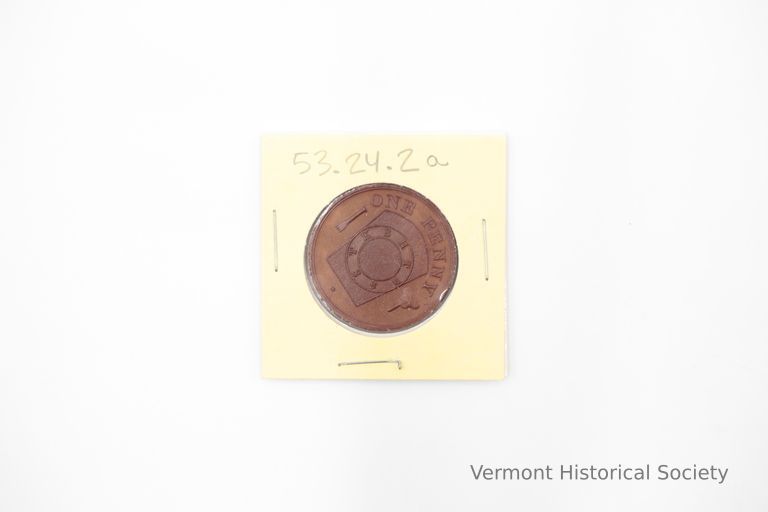
Token
Name/Title
Token
Lexicon
Description
Copper token the words "ONE PENNY" on the obverse with an olive branch at the bottom, a tablet with a circle of initials "H T W S S T K S" in the center, a chisel, and a funnel. On the other side of the coins are the words, "Cleveland Chapter No. 20 R.A.M. Newport, Vt.
Use
Could be used as proof of membership in the order, souvenirs, or for gambling within the club.
Acquisition
Accession
1953.24
Relationships
Related Person or Organization
Freemasons
Person or Organization
Related Places
Place
Newport
City
Orleans County
County
Vermont
State/Province
United States of America
Country
North America
Made/Created
Time Period
19th Century
Dimensions
Dimension Description
Overall
Materials
Material
Copper
Entry/Object ID
1953.24.2a
Context
Produced for the Cleveland Chapter of the Freemasons in Newport, Vermont.


Token
Name/Title
Token
Lexicon
Description
Silver coin with masonic imagery on one side and an inscription on the other. One side has a wedge (possibly representing a fez hat) with circle on the inside bearing the inscription, "H T W S S T K S", though it is unclear which letter is first. Flanking the shape are a chisel and a funnel or plunger. The other side has the inscription "ONE PENNY" in the center, "CACADNAC CHAPTER NO. 27 R. A. M. / WHITE RIVER JUNCTION, VT." around the outer edge, and "CHARTERED JUNE 14 1895" inside of the first.
Use
Could be used as proof of membership in the order, souvenirs, or for gambling within the club.
Acquisition
Accession
1953.24
Relationships
Related Person or Organization
Freemasons
Person or Organization
Made/Created
Time Period
19th Century
Dimensions
Dimension Description
Overall
Materials
Material
Aluminum
Entry/Object ID
1953.24.3
Context
Produced by the Cascadnac Chapter of the Masons in White River Junction, Vermont


Token
Name/Title
Token
Lexicon
Description
Copper coin with masonic imagery on one side and an inscription on the other. One side has a wedge (possibly representing a fez hat) with circle on the inside bearing the inscription, "H T W S S T K S", though it is unclear which letter is first. Flanking the shape are a chisel and a funnel or plunger. The other side has the inscription "ONE PENNY" in the center, "CACADNAC CHAPTER NO. 27 R. A. M. / WHITE RIVER JUNCTION, VT." around the outer edge, and "CHARTERED JUNE 14 1895" inside of the first.
A Masonic coin or token. Obverse side has two lines of text around the outside. First is "Cascadnac Chapter No. 27, R.A.M. White River Junction, Vt.", second line is "Chartered June 14, 1895". R.A.M. could stand for Royal Ark Mariners or Royal Arch Masonry. Reverse side shows Masonic emblem with initials in a circle and working tools.
A Masonic coin or token. Obverse side has two lines of text around the outside. First is "Cascadnac Chapter No. 27, R.A.M. White River Junction, Vt.", second line is "Chartered June 14, 1895". R.A.M. could stand for Royal Ark Mariners or Royal Arch Masonry. Reverse side shows Masonic emblem with initials in a circle and working tools.
Use
Could be used as proof of membership in the order, souvenirs, or for gambling within the club.
Acquisition
Accession
1953.24
Relationships
Related Person or Organization
Freemasons, Rugg, Harold Goddard (1883-1957)
Related Places
Place
White River Junction
Village
Hartford
Town
Windsor County
County
Vermont
State/Province
United States of America
Country
North America
Made/Created
Time Period
19th Century
Dimensions
Dimension Description
Overall Notes:
Materials
Material
Copper
Entry/Object ID
1953.24.4
Context
Produced by the Cascadnac Chapter of the Masons in White River Junction, Vermont
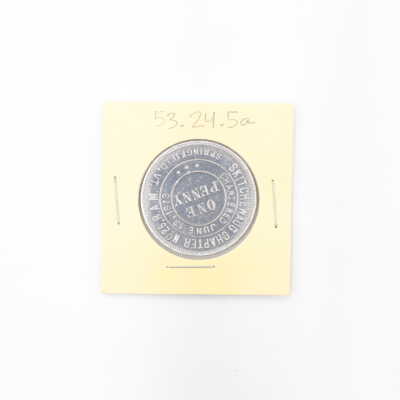
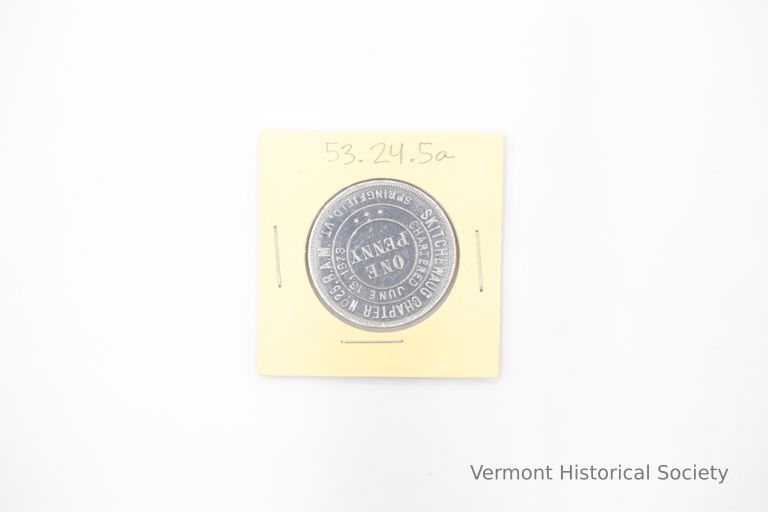
Token
Name/Title
Token
Lexicon
Description
Aluminum token with masonic imagery on one side and an inscription on the other. One side has a wedge (possibly representing a fez hat) with circle on the inside bearing the inscription, "H T W S S T K S". Flanking the shape are a set of masonry tools and an urn. The other side has the inscription "ONE PENNY" in the center, "SKITCHEWAUG CHAPTER NO. 25 R. A. M. / SPRINGFIELD, VT." around the outer edge, and "CHARTERED JUNE 13, 1873" inside of the first.
Use
Could be used as proof of membership in the order, souvenirs, or for gambling within the club.
Acquisition
Accession
1953.24
Relationships
Related Person or Organization
Freemasons
Person or Organization
Related Places
Place
White River Junction
Village
Hartford
Town
Windsor County
County
Vermont
State/Province
United States of America
Country
North America
Made/Created
Time Period
19th Century
Dimensions
Dimension Description
Overall
Materials
Material
Metal
Entry/Object ID
1953.24.5a
Context
Produced by the Cascadnac Chapter of the Masons in White River Junction, Vermont
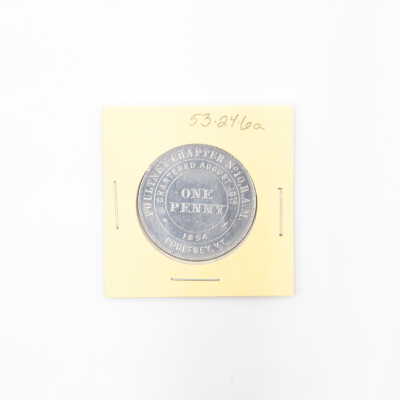
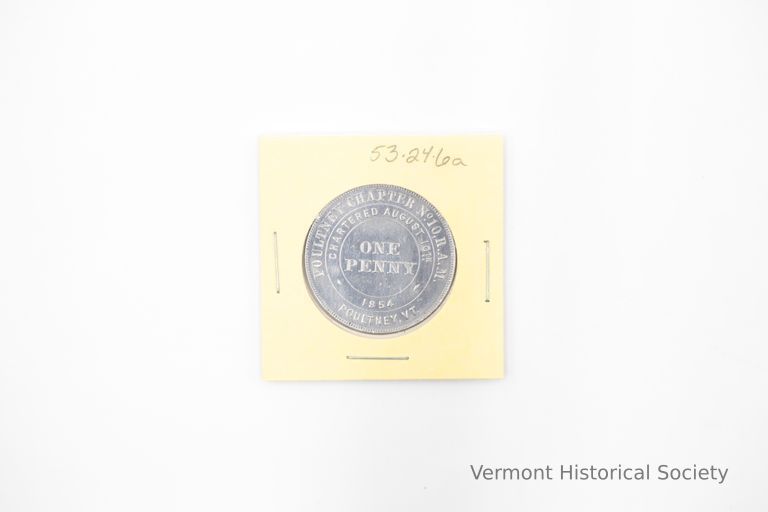
Token
Name/Title
Token
Lexicon
Description
Silver coin with masonic imagery on one side and an inscription on the other. One side has a wedge (possibly representing a fez hat) with circle on the inside bearing the inscription, "H T W S S T K S". Flanking the shape are a chisel and a hammer. The other side has the inscription "ONE PENNY" in the center, "POULTNEY CHAPTER NO. 10 R. A. M. / POULTNEY, VT." around the outer edge, and "CHARTERED AUGUST 10TH 1854" inside of the first.
Use
Could be used as proof of membership in the order, souvenirs, or for gambling within the club.
Acquisition
Accession
1953.24
Relationships
Related Person or Organization
Freemasons
Person or Organization
Related Places
Place
Poultney
Town
Rutland County
County
Vermont
State/Province
United States of America
Country
North America
Made/Created
Time Period
19th Century
Dimensions
Dimension Description
Overall
Materials
Material
Aluminum
Entry/Object ID
1953.24.6a
Context
Produced for the Poultney Chapter of the Masons in Poultney, Vermont
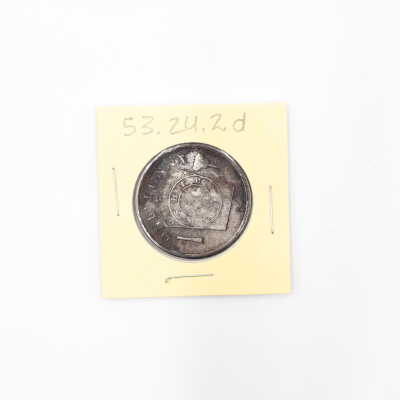
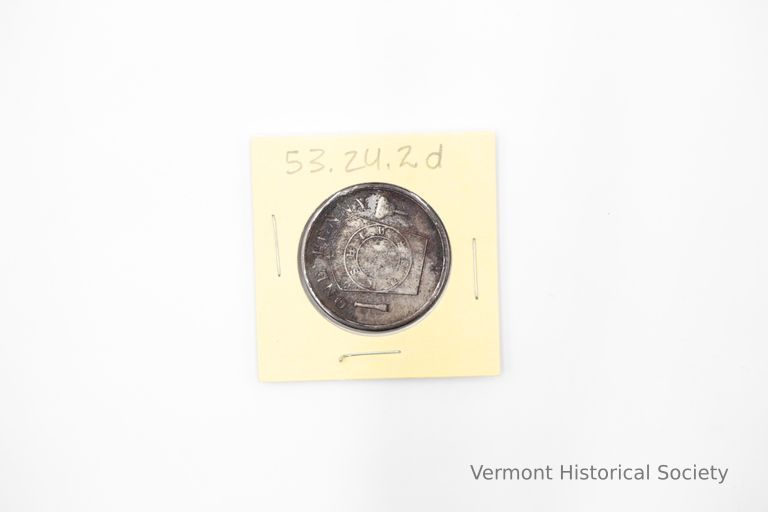
Token
Name/Title
Token
Lexicon
Description
Aluminum token the words "ONE PENNY" on the obverse with an olive branch at the bottom, a tablet with a circle of initials "H T W S S T K S" in the center, a chisel, and a funnel. On the other side of the coins are the words, "Cleveland Chapter No. 20 R.A.M. Newport, Vt."
Use
Could be used as proof of membership in the order, souvenirs, or for gambling within the club.
Acquisition
Accession
1953.24
Relationships
Related Person or Organization
Freemasons
Person or Organization
Related Places
Place
Newport
City
Orleans County
County
Vermont
State/Province
United States of America
Country
North America
Made/Created
Time Period
19th Century
Dimensions
Dimension Description
Overall
Materials
Material
Silver
Entry/Object ID
1953.24.2d
Context
Produced for the Cleveland Chapter of the Freemasons in Newport, Vermont.

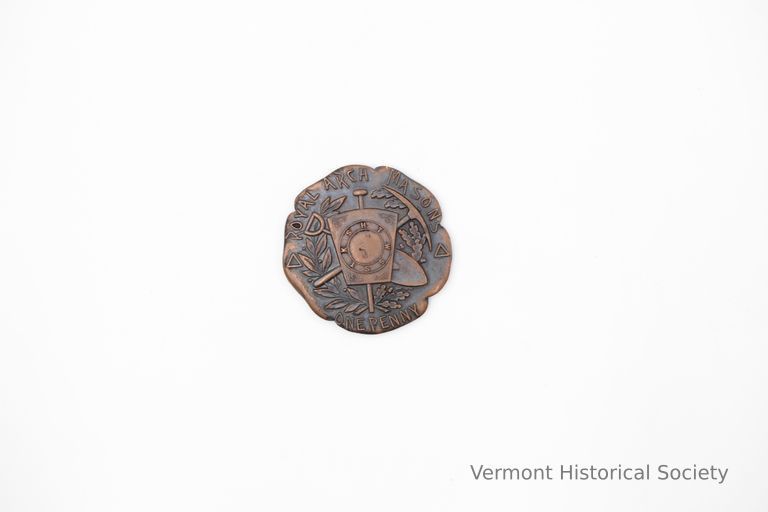
Token
Name/Title
Token
Lexicon
Description
Copper masonic penny. While still round, the penny is shaped into a five-petaled flower. One side has a tablet with the label, "H T W S S T K S", in front of a shovel, pickaxe, laurel leaves, and oak leaves. The inscription ROYAL ARCH MASONS / ONE PENNY" and two triangles ring the edge. The other side bears the inscription, "DAVENPORT CHAPTER / No. 17 / R. A. M. / RUTLAND, VT."
Use
Could be used as proof of membership in the order, souvenirs, or for gambling within the club.
Acquisition
Accession
1958.1
Relationships
Related Person or Organization
Freemasons
Person or Organization
Related Places
Place
Rutland
City
Rutland County
County
Vermont
State/Province
United States of America
Country
North America
Made/Created
Dimensions
Dimension Description
Overall
Materials
Material
Copper
Entry/Object ID
1958.1.1564
Context
Produced by the Davenport Chapter of the Masons in Rutland, Vermont
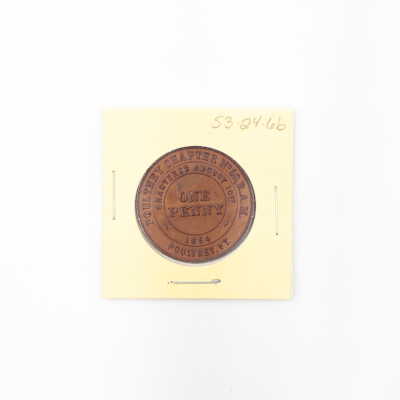
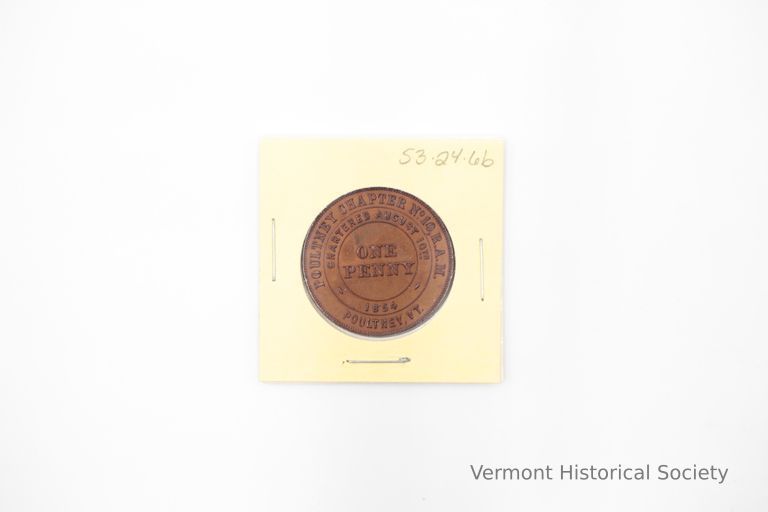
Token
Name/Title
Token
Lexicon
Description
Copper coin with masonic imagery on one side and an inscription on the other. One side has a wedge (possibly representing a fez hat) with circle on the inside bearing the inscription, "H T W S S T K S". Flanking the shape are a chisel and a hammer. The other side has the inscription "ONE PENNY" in the center, "POULTNEY CHAPTER NO. 10 R. A. M. / POULTNEY, VT." around the outer edge, and "CHARTERED AUGUST 10TH 1854" inside of the first.
Use
Could be used as proof of membership in the order, souvenirs, or for gambling within the club.
Acquisition
Accession
1953.24
Relationships
Related Person or Organization
Freemasons
Person or Organization
Related Places
Place
Poultney
Town
Rutland County
County
Vermont
State/Province
United States of America
Country
North America
Made/Created
Time Period
19th Century
Dimensions
Materials
Material
Copper
Entry/Object ID
1953.24.6b
Context
Produced for the Poultney Chapter of the Masons in Poultney, Vermont
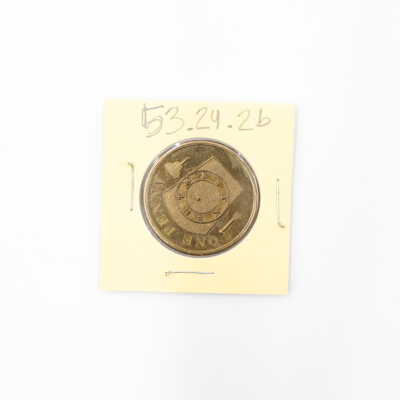
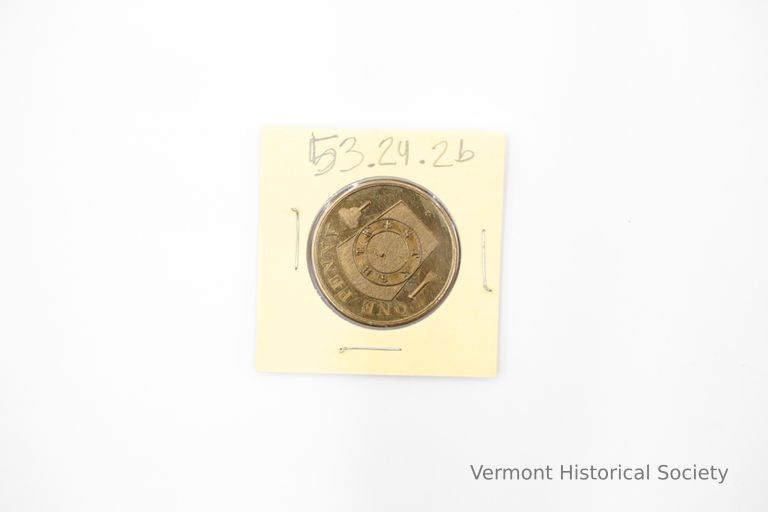
Token
Name/Title
Token
Lexicon
Description
Bronze token the words "ONE PENNY" on the obverse with an olive branch at the bottom, a tablet with a circle of initials "H T W S S T K S" in the center, a chisel, and a funnel. On the other side of the coins are the words, "Cleveland Chapter No. 20 R.A.M. Newport, Vt.
Use
Could be used as proof of membership in the order, souvenirs, or for gambling within the club.
Acquisition
Accession
1953.24
Relationships
Related Person or Organization
Freemasons
Person or Organization
Related Places
Place
Newport
City
Orleans County
County
Vermont
State/Province
United States of America
Country
North America
Made/Created
Time Period
19th Century
Dimensions
Dimension Description
Overall
Materials
Material
Bronze
Entry/Object ID
1953.24.2b
Context
Produced for the Cleveland Chapter of the Freemasons in Newport, Vermont.

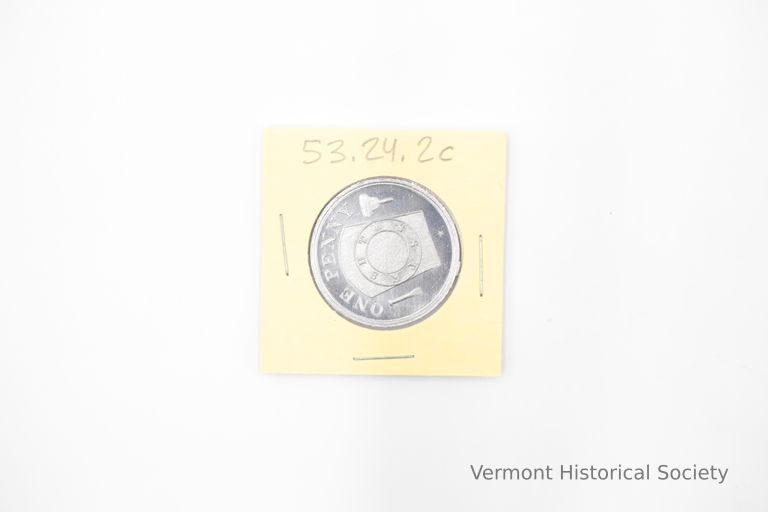
Token
Name/Title
Token
Lexicon
Description
Aluminum token the words "ONE PENNY" on the obverse with an olive branch at the bottom, a tablet with a circle of initials "H T W S S T K S" in the center, a chisel, and a funnel. On the other side of the coins are the words, "Cleveland Chapter No. 20 R.A.M. Newport, Vt."
Use
Could be used as proof of membership in the order, souvenirs, or for gambling within the club.
Acquisition
Accession
1953.24
Relationships
Related Person or Organization
Freemasons
Person or Organization
Related Places
Place
Newport
City
Orleans County
County
Vermont
State/Province
United States of America
Country
North America
Made/Created
Time Period
19th Century
Dimensions
Dimension Description
Overall
Materials
Material
Aluminum
Entry/Object ID
1953.24.2c
Context
Produced for the Cleveland Chapter of the Freemasons in Newport, Vermont.
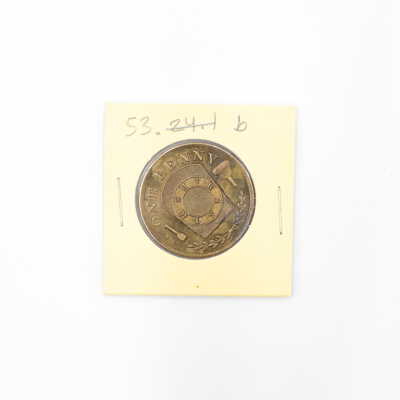
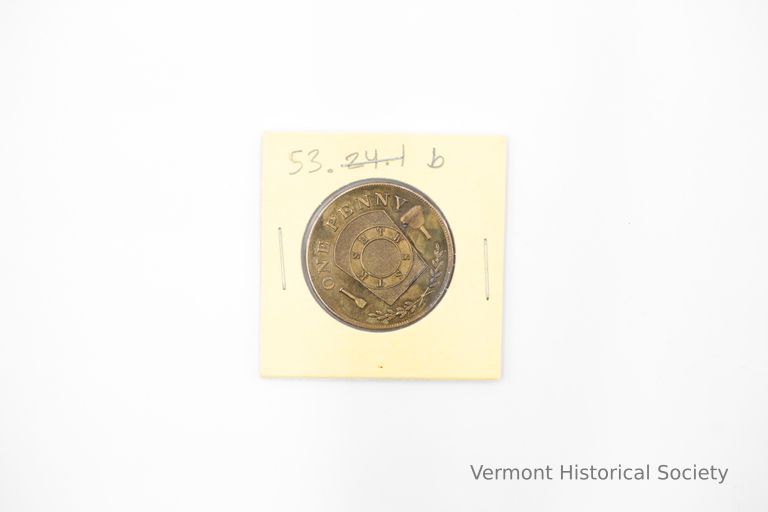
Token
Name/Title
Token
Lexicon
Description
Gold-toned metal token with the words "ONE PENNY" on the obverse with an olive branch at the bottom, a tablet with a circle of initials "H T W S S T K S" in the center, a chisel, and a funnel. On the other side of the token are the words, "Cleveland Chapter No. 20 R.A.M. Newport, Vt.”
Use
Could be used as proof of membership in the order, souvenirs, or for gambling within the club.
Acquisition
Accession
1953.24
Relationships
Related Person or Organization
Freemasons
Person or Organization
Related Places
Place
Newport
City
Orleans County
County
Vermont
State/Province
United States of America
Country
North America
Made/Created
Time Period
19th Century
Dimensions
Dimension Description
Overall Notes:
Materials
Material
Bronze
Entry/Object ID
1953.24.1b
Context
Produced for the Cleveland Chapter of the Freemasons in Newport, Vermont.


Token
Name/Title
Token
Lexicon
Description
Copper token with masonic imagery on one side and an inscription on the other. One side has a wedge (possibly representing a fez hat) with circle on the inside bearing the inscription, "H T W S S T K S". Flanking the shape are a set of masonry tools and an urn. The other side has the inscription "ONE PENNY" in the center, "SKITCHEWAUG CHAPTER NO. 25 R. A. M. / SPRINGFIELD, VT." around the outer edge, and "CHARTERED JUNE 13, 1873" inside of the first.
Use
Could be used as proof of membership in the order, souvenirs, or for gambling within the club.
Acquisition
Accession
1953.24
Relationships
Related Person or Organization
Freemasons
Person or Organization
Related Places
Place
White River Junction
Village
Hartford
Town
Windsor County
County
Vermont
State/Province
United States of America
Country
North America
Made/Created
Time Period
19th Century
Dimensions
Dimension Description
Overall
Materials
Material
Metal
Entry/Object ID
1953.24.5b
Context
Produced by the Cascadnac Chapter of the Masons in White River Junction, Vermont
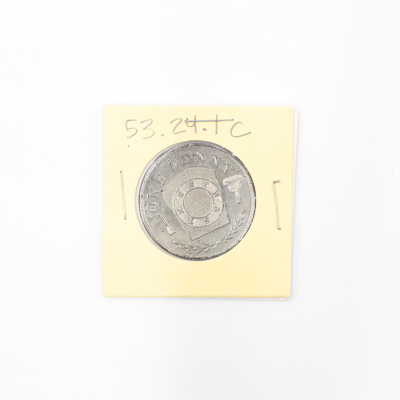
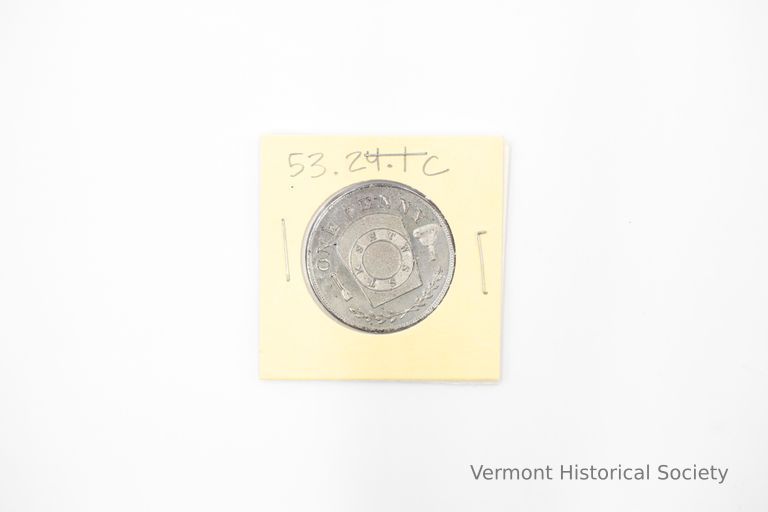
Token
Name/Title
Token
Lexicon
Description
Silver-toned metal token with the words "ONE PENNY" on the obverse with an olive branch at the bottom, a tablet with a circle of initials "H T W S S T K S" in the center, a chisel, and a funnel. On the other side of the token are the words, "Cleveland Chapter No. 20 R.A.M. Newport, Vt.”
Use
Could be used as proof of membership in the order, souvenirs, or for gambling within the club.
Acquisition
Accession
1953.24
Relationships
Related Person or Organization
Freemasons
Person or Organization
Related Places
Place
Newport
City
Orleans County
County
Vermont
State/Province
United States of America
Country
North America
Made/Created
Time Period
19th Century
Dimensions
Dimension Description
Overall Notes:
Materials
Material
Aluminum
Entry/Object ID
1953.24.1c
Context
Produced for the Cleveland Chapter of the Freemasons in Newport, Vermont.
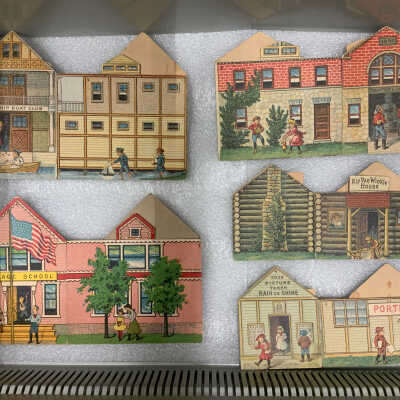
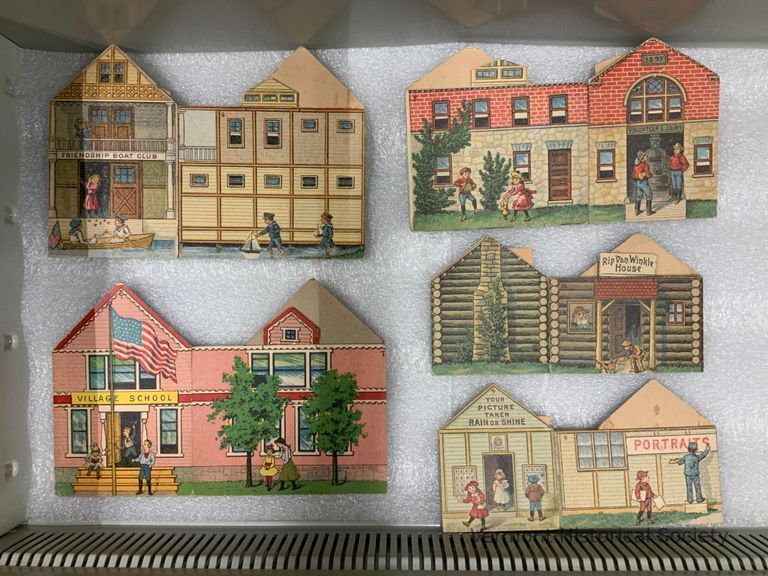
Toy Village
Name/Title
Toy Village
Lexicon
Description
Cardboard toy village held within a wooden box. The box has a paper label on one side that says, "5 LBS. PEPPERMINT & WINTERGREEN CREAM WAFERS". The interior of the lid has the handwritten label, "[illeg] 1914, March 10, Hillside Farm". The set consists of 12 buildings, 12 roofs, 5 trees, 3 boats, 2 fences, a clock tower, 6 people, and 3 miscellaneous accessories.
Each building is made from four pieces of paperboard attached at the ends (interior) with woven tape, creating a box that can be laid down flat. Each has a corresponding roof that attaches with slits to notches on the buildings. (The notches are disguised as dormer winders and signs. The buildings are a log cabin labeled "Rip Van Winkle House"; a portrait studio; a wheelwright and blacksmith shop labeled "J. SMITH HORSESHOER"; a firehouse with the date 1897; a boat club; a large schoolhouse; 7 residential houses.
Each building is made from four pieces of paperboard attached at the ends (interior) with woven tape, creating a box that can be laid down flat. Each has a corresponding roof that attaches with slits to notches on the buildings. (The notches are disguised as dormer winders and signs. The buildings are a log cabin labeled "Rip Van Winkle House"; a portrait studio; a wheelwright and blacksmith shop labeled "J. SMITH HORSESHOER"; a firehouse with the date 1897; a boat club; a large schoolhouse; 7 residential houses.
Acquisition
Accession
1963.62
Materials
Material
Paperboard, Wood
Entry/Object ID
1963.62.5a-jj

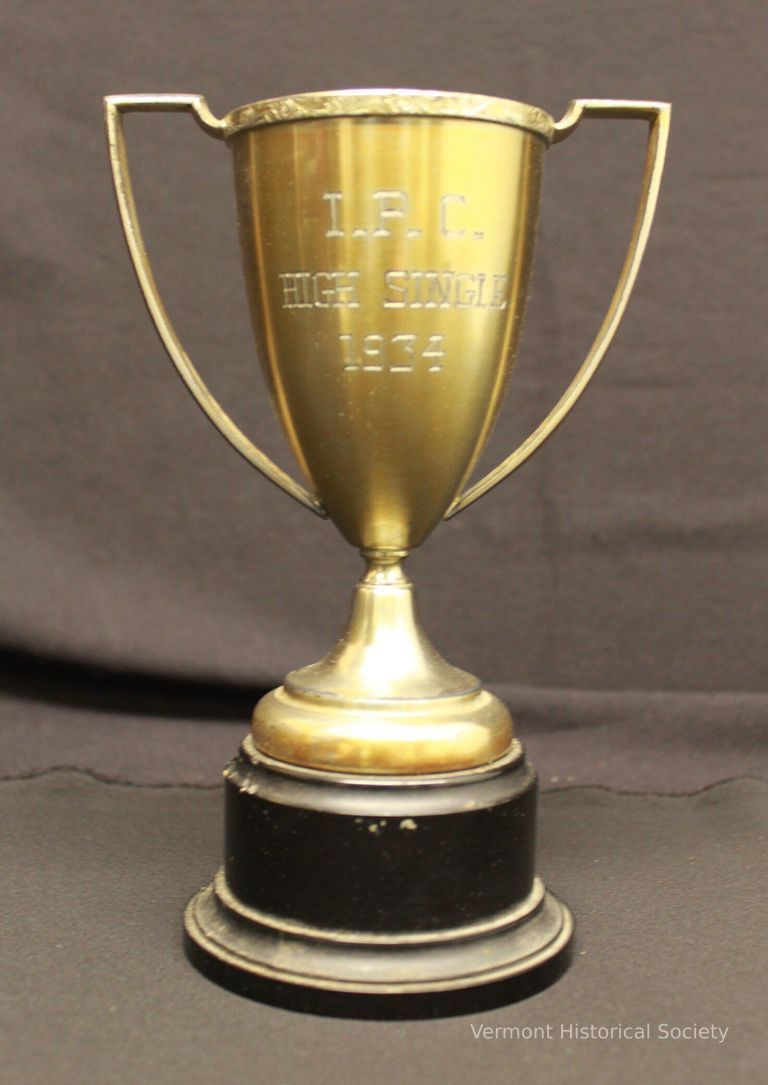
Trophy
Name/Title
Trophy
Lexicon
Description
Metal trophy consisting of a double-handled loving cup on a round wooden pedestal. One side of the cup is engraved with the inscription, "I.P.C. HIGH SINGLE 1934". The cup attaches to the base with a bolt accessible from the bottom of the base, which is hollowed out. surrounding the bolt hole is the maker's mark, "Bechard Trophies Trade Mark Made in U.S.A."
Acquisition
Accession
2016.42
Ethnography
Relationships
Related Person or Organization
Italian Pleasure Club
Person or Organization
Related Places
Place
Barre City
City
Washington County
County
Vermont
State/Province
United States of America
Country
North America
Made/Created
Date made
1934
Manufacturer
Bechard Trophies
Dimensions
Dimension Description
Overall
Materials
Material
Metal, Plastic
Entry/Object ID
2016.42.1
Context
The Italian Pleasure Club (IPC) was a cultural and social group for Italians that was in existence between 1908 and 1941 in Barre, Vermont.

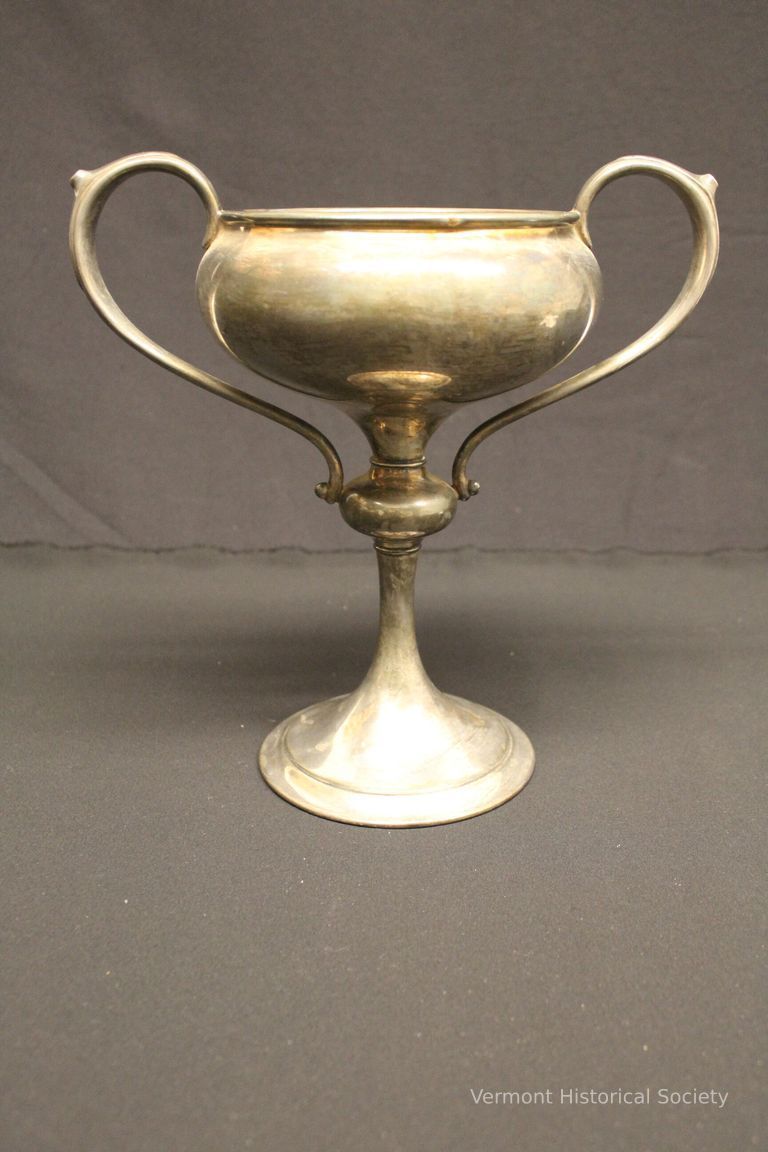
Trophy
Name/Title
Trophy
Lexicon
Description
Trophy in the shape of a two-handled cup (loving cup) with a long stem and flaring base. The bowl of the cup is engraved with the inscription, "BGC / LOWEST GROSS SCORE IN / WEEKLY TOURNAMENT / 1914 - GEORGE FRASER". The bottom of the base is labeled, "Made & Guarenteed by / WILCOX SILVER PLATE CO" and "474".
Acquisition
Accession
1994.54
Relationships
Related Person or Organization
Brandon Golf Club
Person or Organization
Related Places
Place
Brandon
Town
Rutland County
County
Vermont
State/Province
United States of America
Country
North America
Made/Created
Date made
1914
Manufacturer
Wilcox Silverplate Co.
Dimensions
Dimension Description
Overall
Materials
Material
Silverplate
Entry/Object ID
1994.54.27
Context
Awarded to George Fraser by Brandon Golf Club in Brandon, Vermont.

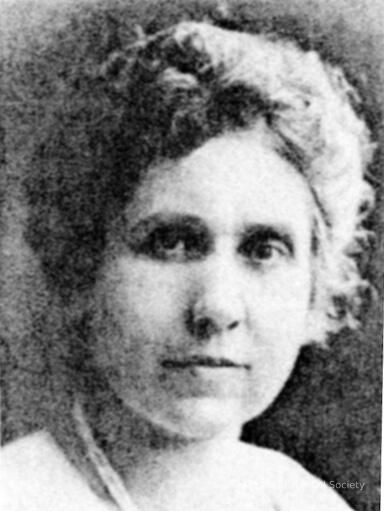
Tuttle, Bernice (1880-1973)
Name/Title
Tuttle, Bernice (1880-1973)
Description
Born: March 24, 1880 in Rutland, Vermont
Died: October 9, 1973 in Rutland, Vermont
Primary Residence: Rutland
Had a long and prominent career in leadership positions for a variety of civic organizations. Founded the Rutland Woman's Club and the Vermont Children's Aid Society. President of the family business, the Tuttle Company, printers and publishers.
Died: October 9, 1973 in Rutland, Vermont
Primary Residence: Rutland
Had a long and prominent career in leadership positions for a variety of civic organizations. Founded the Rutland Woman's Club and the Vermont Children's Aid Society. President of the family business, the Tuttle Company, printers and publishers.
Biographical Information
Education
Smith College (1902)
Biography
Berenice R. Tuttle devoted much of her life to community service and to running the family business, Tuttle Publishing.
Born into the prominent Tuttle family of Rutland, she worked for the family's printing and publishing business as a young woman. She graduated from Smith College in 1902, having spent her summers working in the company's editorial department. After graduation, she worked for the company and for two years in the editorial department at the American Society of Mechanical Engineers in New York.
In 1935, at the age of fifty-five, she became president of the Tuttle Company, when it was one of the largest publishers of genealogies in the country. Tuttle Publishing is still in business today.
Beyond her family's business, Tuttle's two major interests in life were welfare work and women's clubs. One of the founders of the Rutland Woman's Club, she became president of the club from 1914-1916 and was president of the Vermont Federation of Woman's Clubs in 1931-1933. In addition, she served as one of the directors of the National Federation of Woman's Clubs and served as Vermont's parliamentarian.
Tuttle's interest in child welfare led to her appointment as chair for Vermont's "Children's Year" in 1917. She helped organize the Vermont Conference of Social Work, served as president, and founded the Vermont Children's Aid Society. Tuttle's extensive civic involvement also included membership in the League of Women Voters, the American Association of University Women, and the Rutland Playground Association. She served on the Rutland school board for sixteen years, was the first commissioner of Girl Scouts in Rutland, founded the Zonta Club (a service organization for women), and served as director of the Vermont Tuberculosis Society and secretary of the Ladies' Hospital Aid Society.
With a colonial ancestry, Tuttle was also regent of the Ann Story Chapter of the Daughters of the American Revolution, a member of the Vermont Society of Colonial Dames, and secretary of the Daughters of Colonial Wars.
She contributed articles to various journals and magazines and became a member of the Vermont Writers' League. Tuttle was listed in Who's Who of New England Women and Who's Who of American Women. In 1920, Tuttle served as Secretary of the Republican State Convention and as an alternate to the Republican National Convention, which chose Warren G. Harding as presidential nominee and Calvin Coolidge as vice-presidential nominee.
Tuttle also was involved with the Rutland Baptist Church, where she taught Sunday School, the Sunset House, a home for the elderly, and the Mid-Vermont Artists' Association. Devoted to making Vermont a better place, Berenice Tuttle was described in the Vermonter magazine in 1933 as "vigorous in administration, buoyant, irrepressible, adored."
Occupation
Executive
Editor
Entry/Object ID
1.1.92

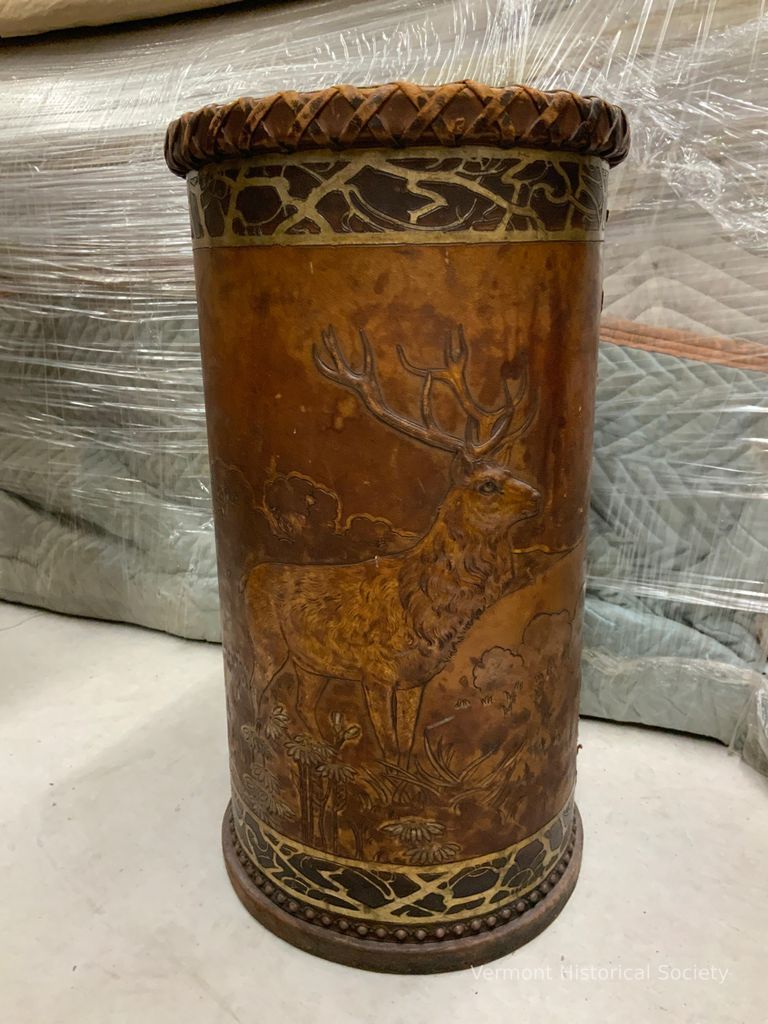
Umbrella Stand
Name/Title
Umbrella Stand
Lexicon
Description
Leather umbrella stand decorated with tooled stag design & gilt trim. The stand is cylindrical.
Acquisition
Accession
1971.30
Relationships
Related Person or Organization
Ethan Allen Club
Person or Organization
Related Places
Place
Burlington
City
Chittenden County
County
Vermont
State/Province
United States of America
Country
North America
Materials
Material
Leather
Entry/Object ID
1971.30.3
Context
Used in the Ethan Allen Club in Burlington, Vermont.


Vacuum Cleaner
Name/Title
Vacuum Cleaner
Lexicon
Description
Hand-powered vacuum cleaner consisting of a metal pole with a large crank wheel at the top and small gear wheel at the bottom. There are two tube attachments (threaded like a hose spigot) at the center.
Use
Operated by two people: one who cranked the wheel to generate suction, and one who held the cleaning wand.
Acquisition
Accession
1947.12
Made/Created
Artist Information
Agan, Frank W. (1868-1934)
Artist
Date made
1910
Entry/Object ID
1947.12
Context
Made in Ludlow, Vermont
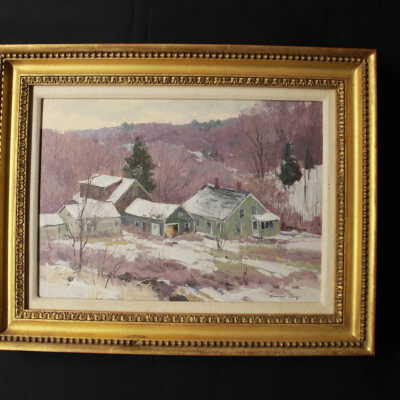
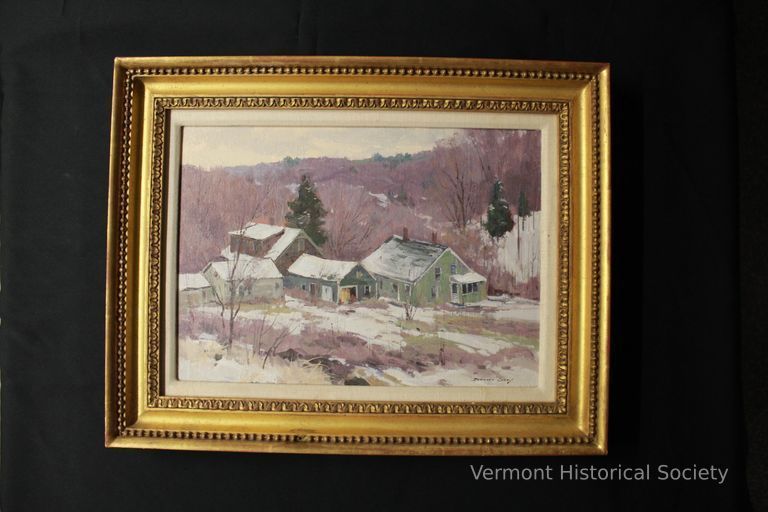
Vermont Winter
Name/Title
Vermont Winter
Lexicon
Description
Oil on canvas painting of a Vermont hill village on a gray winter day. Central to the painting is a cluster of three dwellings surrounded by hills, trees, brush and snow. Signed by artist Bernard Corey in lower left corner. Gallery label on back of work from Atlantic Gallery gives the title as "Vermont Winter."
Acquisition
Accession
2017.19
Artwork Details
Medium
Oil
Made/Created
Artist Information
Corey, Bernard (1914-2000)
Artist
Date made
1970-1980
Dimensions
Entry/Object ID
2017.19.1
Context
Bernard Corey (1914-2000) is a 20th-century American Impressionist painter. While Corey is identified with the historic Gloucester-Rockport Art Colony, he worked in many locations throughout New England and was associated with the Salmagundi Club in New York City, the Hudson Valley Art Association, the Providence Water Color Club, the Guild of Boston Artists, Allied Artists of America, as well as the Rockport Art Association.
A self-trained artist, Corey worked as a house painter as a young man, his landscape painting remaining a hobby. Then, in the early 1960s, he decided to dedicate himself to art and lived for some time in Rockport, honing his skills in the company of other artists. Throughout his life, Corey was admired by other artists for his dedication to painting on location, for long hours, in all kinds of weather. He went so far as to attach an easel to the dashboard of his car so that he could paint in rain, sleet or snow.
A self-trained artist, Corey worked as a house painter as a young man, his landscape painting remaining a hobby. Then, in the early 1960s, he decided to dedicate himself to art and lived for some time in Rockport, honing his skills in the company of other artists. Throughout his life, Corey was admired by other artists for his dedication to painting on location, for long hours, in all kinds of weather. He went so far as to attach an easel to the dashboard of his car so that he could paint in rain, sleet or snow.
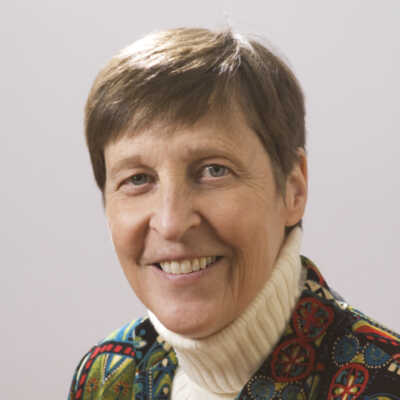
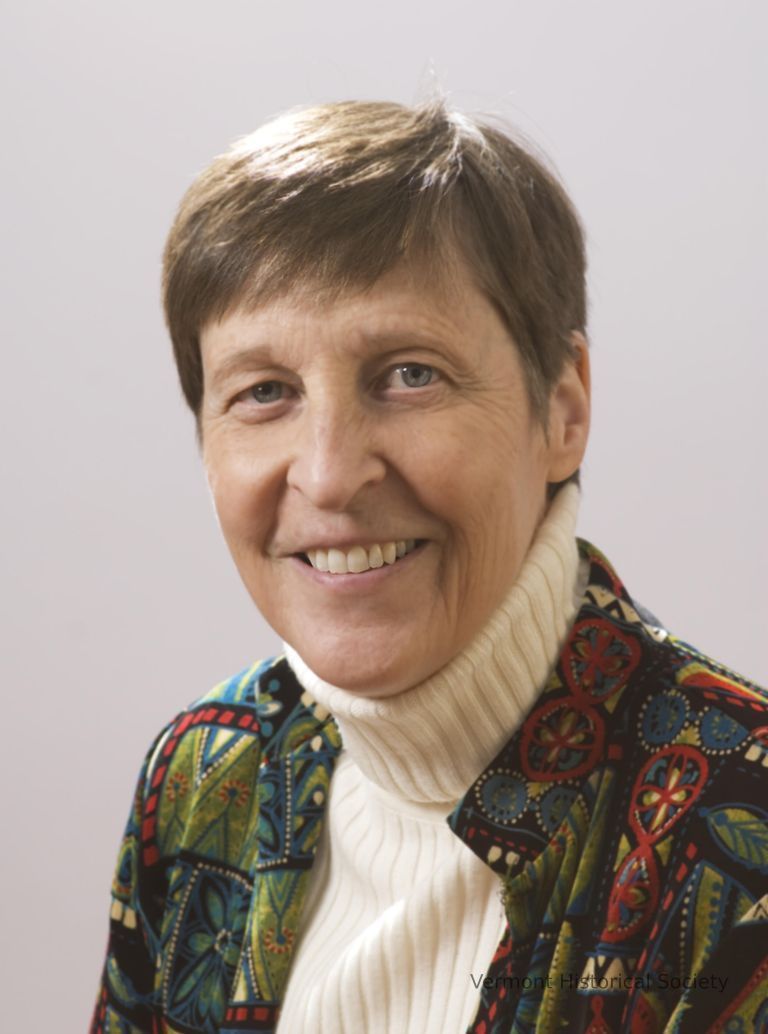
Walker, Gwyneth Van Anden (b. 1947)
Name/Title
Walker, Gwyneth Van Anden (b. 1947)
Description
Born: March 22, 1947 in New York
Primary Residence: Braintree
World renown composer of instrumental and choral music. Works have been described as energetic and often humorous; often translates the words and sounds of poetry into music. Recognized with the Vermont Arts Council Lifetime Achievement Award in 2000.
Primary Residence: Braintree
World renown composer of instrumental and choral music. Works have been described as energetic and often humorous; often translates the words and sounds of poetry into music. Recognized with the Vermont Arts Council Lifetime Achievement Award in 2000.
Biographical Information
Education
B.A., M.M. and D.M.A. degrees in Music Composition from Brown University and the Hartt School for Music
Biography
Gwyneth Van Anden Walker, originally from New Canaan, Connecticut, is an eleventh-generation Quaker. She holds B.A., M.M. and D.M.A. degrees in Music Composition from Brown University and the Hartt School of Music. Walker taught for fourteen years at Hartt, the Hartford Conservatory and Oberlin College before she decided to compose music full-time in Braintree, Vermont.
Walker recalls falling in love with music at the age of two, when her older sister began to take piano lessons. By the first grade, she had taught herself to put notes on a staff, and had begun composing her first pieces of music. Today, her instrumental and choral publications include more than one hundred and sixty commissioned works. She writes for solo instruments, chamber ensembles, full orchestras and bands. Adept at translating the words and sounds of poetry to music, she has composed works based upon texts ranging from the Bible to E. E. Cummings to traditional folk songs and ballads. Walker composes during the day and manages the business end of making music at night. In 2000, the Vermont Arts Council recognized Walker with its Lifetime Achievement Award.
During 2005 and 2006, Walker traveled across the United States working with a variety of musicians as they premiered and recorded her works. The areas of focus were choral, chamber and orchestral music. She also worked on a project that created orchestral accompaniments for a number of choral and vocal works in her catalog of pieces. The "Songs for Women's Voices," "I Thank You God," "I Will Be Earth" and the song cycle, "No Ordinary Woman!" have all been orchestrated and were performed twice at Carnegie Hall during the 2005-6 season.
Walker is currently working on several choral works: New England Journey (musical settings of the poetry of New England Poets for the Worcester, Mastersingers), A Heart in Hiding: The Passionate Love Poems of Emily Dickinson (for the Thomas Circle Singers - Washington, DC) and Songs to the Lord of Peace (on texts by Thomas Merton for the Fairfield University Glee Club - Fairfield, CT). The year 2007 is Walker's "60th Celebration Year".
Occupation
Teacher
Composer
Entry/Object ID
1.1.94
Web Links and URLs


Wallet
Name/Title
Wallet
Lexicon
Description
Small, rectangular leather wallet stamped with the word "BELIEVE" and an image of a water dinosaur [Champ]. The wallet has an interior pouch accessed by a zipper along two sides. The back has 4 slots for holding cards. The slots are made from red leather.
Acquisition
Accession
2022.20
Relationships
Related Person or Organization
Champ
Person or Organization
Related Places
Place
Lake Champlain
Lake
Burlington
City
Chittenden County
County
Vermont
State/Province
United States of America
Country
North America
Made/Created
Date made
2021
Manufacturer
Coach New York
Materials
Material
Leather
Entry/Object ID
2022.20.1
Context
Produced by Coach New York as part of their Coach Cryptid Club line. It shows an illustration of Champ, the sea monster of Lake Champlain.

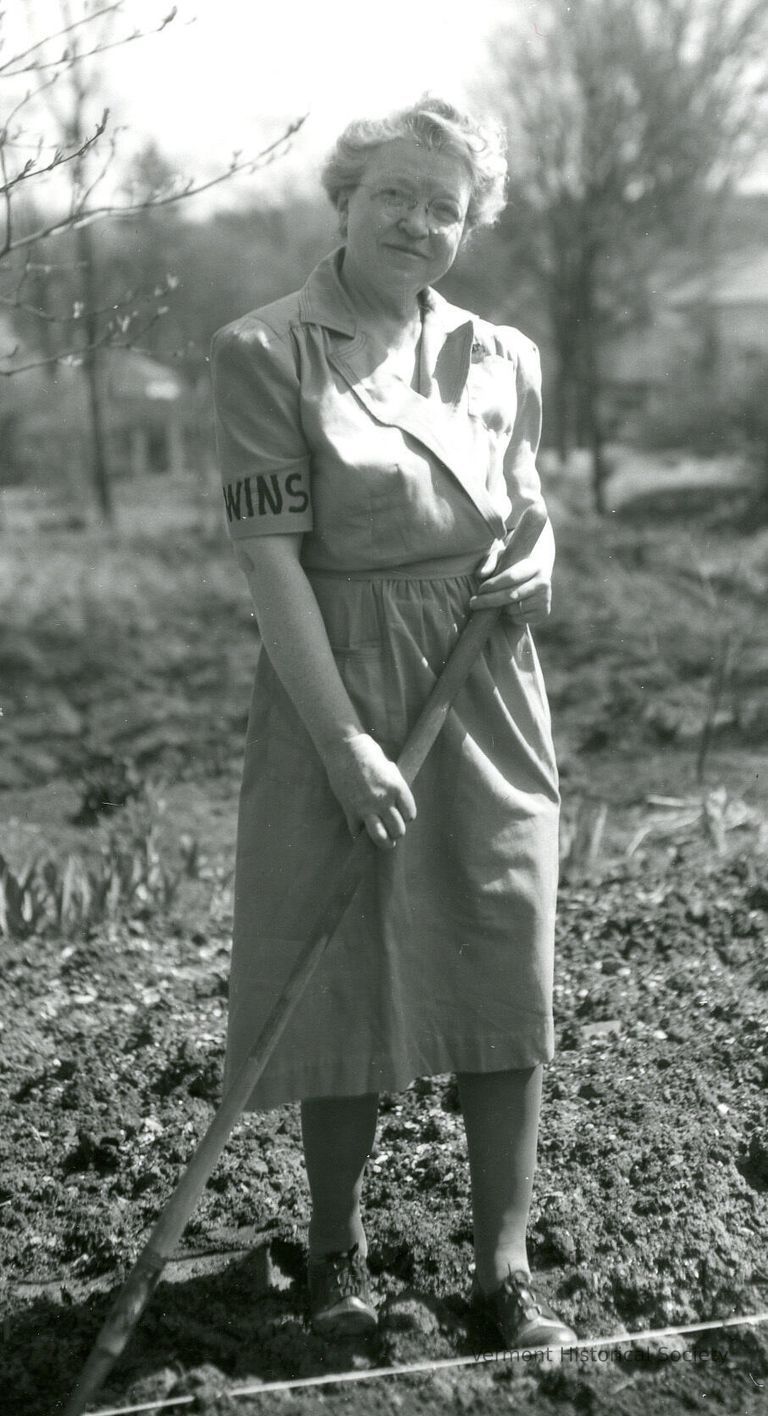
Wills, Hazel McLeod (1886-1969)
Name/Title
Wills, Hazel McLeod (1886-1969)
Description
Born: October 29, 1886 in Goldsboro, North Carolina
Died: June 19, 1969 in Bennington, Vermont
Primary Residence: Bennington
Held leadership positions in many Vermont organizations and colleges, including Bennington College and the University of Vermont. Served in the Vermont Senate for one term. President of the Vermont Chapter of the American Association of University Women from 1937-1941 and 1953-1955. Wife of Vermont State Governor William Wills (1941-1945).
Died: June 19, 1969 in Bennington, Vermont
Primary Residence: Bennington
Held leadership positions in many Vermont organizations and colleges, including Bennington College and the University of Vermont. Served in the Vermont Senate for one term. President of the Vermont Chapter of the American Association of University Women from 1937-1941 and 1953-1955. Wife of Vermont State Governor William Wills (1941-1945).
Biographical Information
Education
BA, Middlebury College (1909)
MA, Middlebury College (1942)
Biography
Hazel McLeod Wills was born in Goldsboro, North Carolina in 1886. She moved to Vermont when she was two years old. After attending Bennington High School, she went to Middlebury College where she was a 1909 Phi Beta Kappa graduate. She received an honorary M.A. degree from Middlebury in 1942. She supported the founding of Bennington College and served as a trustee to the school from 1946 to 1953. Wills was also a trustee at the University of Vermont for several years and was also awarded an honorary PhD from UVM.
Hazel McLeod married William Wills in 1914. William Wills served as Governor of Vermont from 1941 to 1945. Together, they had one daughter, Annie Wills Pike. Wills was involved in numerous organizations including the United Counseling Service Board of Directors, the Vermont Association for the Crippled, the Vermont Council on World Affairs, the Vermont Historical Society, the Elizabeth Lund Home, and the Eastern Star. She also served as a director of Station WRY in Schenectady, New York. From 1937 to 1941 and from 1953 to 1955, Wills served as the state president of the American Association of University Women. William Wills died in 1946, but Hazel remained active in Republican Politics and the Republican Women's Club in Bennington County. In 1960, she was persuaded to run for the Vermont Senate, and she served one term. Wills also enjoyed writing and was the author of "Bill Wills & Co.", along with a weekly column in the Bennington Banner. At her death in 1969, the AAUW chapter of Vermont was given money to establish a scholarship in her name.
Occupation
Philanthropist
Director
Politician
Entry/Object ID
1.1.143

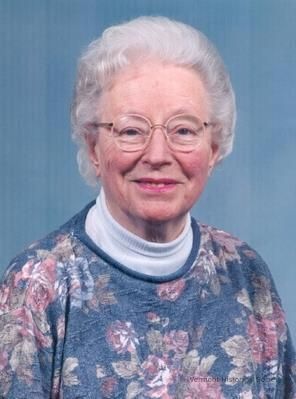
Wolf, Marguerite Hurrey (1914-2017)
Name/Title
Wolf, Marguerite Hurrey (1914-2017)
Description
Born: April 23, 1914 in Montclair, New Jersey
Died: April 6, 2017 in Shelburne, Vermont
Primary Residence: South Burlington
Celebrated Vermont author of over 200 articles and numerous books, such as: "I'll Take the Back Road," "Sheep's in the Meadow, Raccoons in the Corn," "Vermont is Always with You," and "How to be a Doctor's Wife Without Really Dying." Wrote the popular column, "Isn't Pushing 90 Exercise Enough?"
Died: April 6, 2017 in Shelburne, Vermont
Primary Residence: South Burlington
Celebrated Vermont author of over 200 articles and numerous books, such as: "I'll Take the Back Road," "Sheep's in the Meadow, Raccoons in the Corn," "Vermont is Always with You," and "How to be a Doctor's Wife Without Really Dying." Wrote the popular column, "Isn't Pushing 90 Exercise Enough?"
Biographical Information
Education
BA, Mount Holyoke (1936)
Bank Street College of Education (1937)
Biography
Marguerite (Maggie) Hurrey Wolf was born in Montclair, New Jersey. She graduated from Mount Holyoke College and then did a year of post-graduate work at the Bank Street College of Education in New York City. She taught for five years at the Flank Street Nursery School and for two years at the nursery school at Sarah Lawrence College.
She married George Wolf, a medical student at Cornell in 1939. Together, they had two daughters, Patty and Debbie. In 1948, they bought a small farm in Jericho Center, Vermont and became summer residents.
When George became Dean of the College of Medicine at the University of Vermont, they purchased a house in South Burlington. In the attic of that house, they found a collection of historic letters and newspapers. All the letters were written to or by John Fay, whose father John, was the first American killed in the Battle of Bennington. John Jr. married Susannah (Sukey), and it was her story that started Wolf on her writing career.
After seeing Wolf's story in the April 1958 issue of the Vermont Historical Society's News and Notes, Dorothy Canfield Fisher wrote to Wolf, encouraging and praising her. Since then, Wolf had more than 200 articles published in magazines such as Yankee, Vermont Life, Saturday Evening Post, Parents, Resident and Staff Physician, Early American Life, and others.
Two of her books, "I'll Take the Back Road," and "Sheep's in the Meadow, Raccoons in the Corn" were chosen for Christian Herald's Family Book Club Selections. Her other books include: "How to be a Doctor's Wife Without Really Dying," "Vermont is Always With You," "Seasoned in Vermont," "At Home in Vermont," "Postmark Vermont," and "Window on Vermont."
She was a guest columnist for Elders' Advocate, a publication of the Champlain Valley Agency on Aging and wrote the popular column, "Isn't Pushing 90 Exercise Enough?"
Occupation
Teacher
Author
Entry/Object ID
1.1.144